Rafting the Lower Rogue River — September 10-14, 2022
Over the summer, I’ve been guiding for the Rogue Rafting Company, doing day trips on the Nugget-Powerhouse section of the Rogue near Gold Hill, Oregon. Recently, I had a chance to do a multi-day trip down the Wild and Scenic section of the lower Rogue, rowing the support raft for a drift boat fishing trip.
I’d run the Wild and Scenic section in guide school, rowing about 2/3 of it. Still, having responsibility for my own boat on a commercial trip was a bit daunting.
Before the trip
I got confirmation that I’d be doing this trip the day before we left, so I had some packing to do. Most of my gear was pretty familiar between guiding day trips and guide school, but there were a few new additions. I replaced my NRS dry bag with a big Watershed Colorado bag. Honestly, this was a bit oversized for the gear I was bringing on this trip, but that extra space could accommodate a summer-weight sleeping bag (for a non-lodge trip) or more warm clothing (for a lodge trip later in the fall). I also brought along a RiverMaps Guide to the Rogue River. This combines topo maps of the corridor along the river with descriptions of camps, lodges, and (most importantly) rapids on facing pages. Finally, I got a coiled lanyard to attach my iPhone to the PFD, so I would be less likely to drop it in the river.
Since we only had a couple of drift boats on this trip and would be staying at lodges, I was running a small, 14’ raft rather than one of the bigger boats that are typically used as gear boats (I caught a bit of grief for this from some other companies’ guides out on the river). We got the boat and all the gear set up the evening before.
Day One
The Rum Creek Fire has been burning up near the top of the Wild and Scenic section of the Rogue since mid-August. Despite the proximity, the river was still open to those with existing permits. However, there were some restrictions on getting there. We had to meet a Bureau of Land Management pilot car at 5:30 am, which meant a very early start to the day. I was up about 3 o’clock to get breakfast and head over to the boathouse. We finished loading the gear and got on the road to the meeting point.
After a long, slow drive from the meeting point to the Grave Creek Boat Ramp, we got the boats in the water. Not only did we have a long way to go that day, but we also faced a deadline to get downriver below the fire by mid-morning. This meant I had to rig a new-to-me boat for my first multi-day trip in the dark. I did a decent job of getting everything secured. We headed downriver around 7 am.
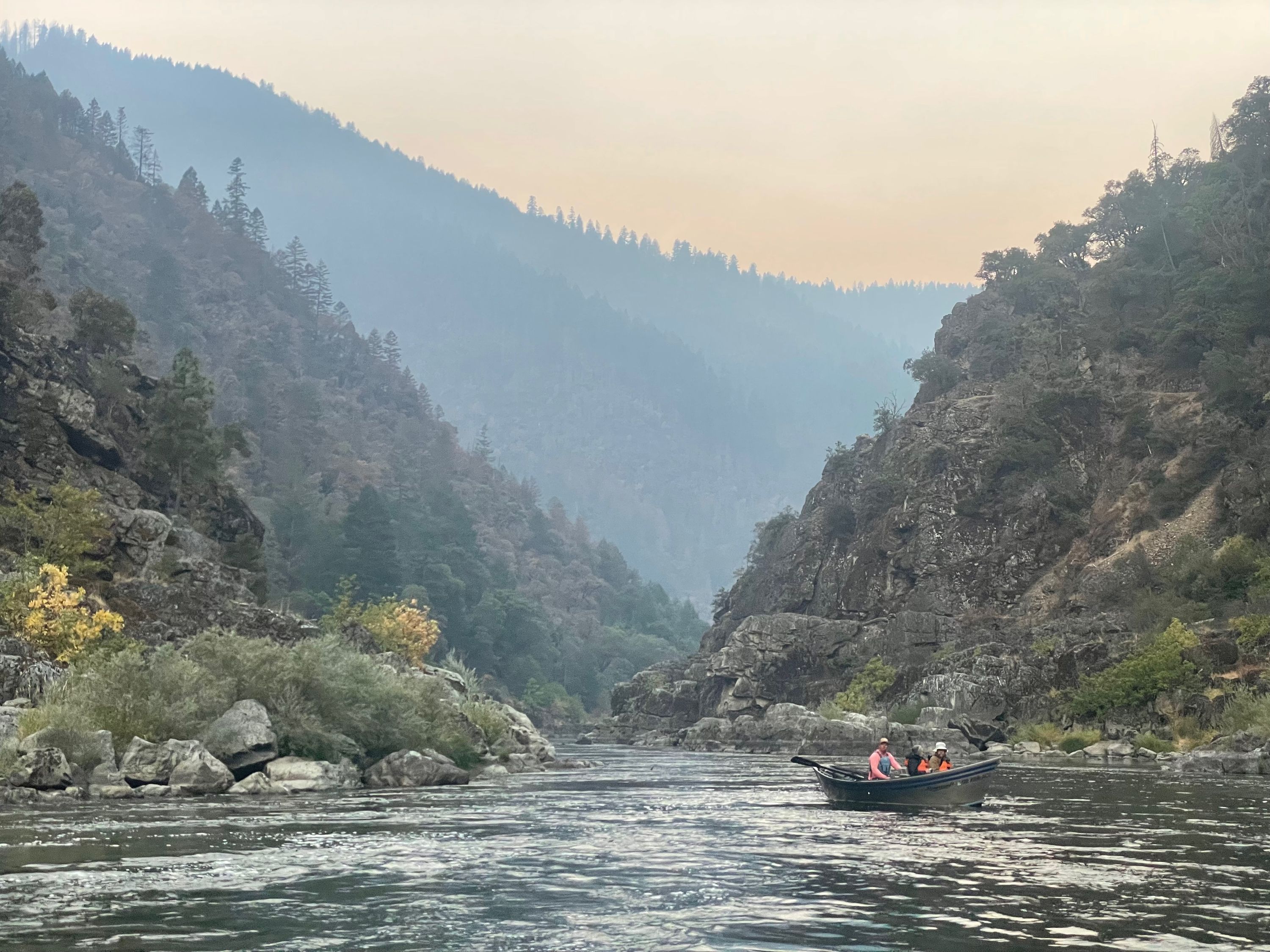 Soon after getting on the water
Soon after getting on the water
After a few smaller rapids, Rainie Falls is the first big obstacle below the boat ramp. The falls themselves are a Class V drop, but there’s a dynamited bypass channel to the right known as the fish ladder. While easier than the big drop, the fish ladder has its own challenges. We lined the drift boats down the narrow, rocky channel without anyone aboard. I rode the raft down, but rather than using the oars, I sat up in the bow and used a paddle to control the boat.
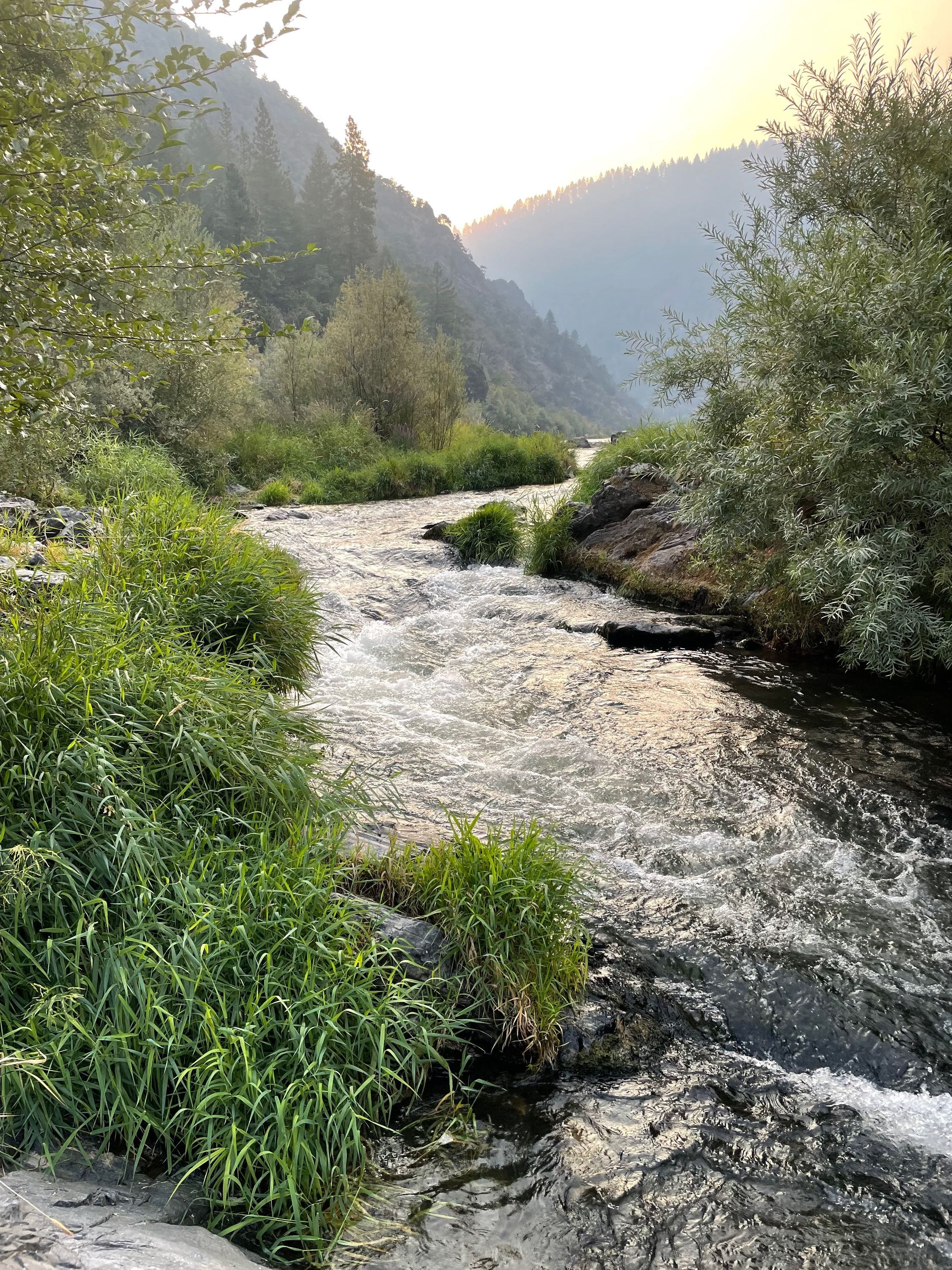 Entrance to the fish ladder
Entrance to the fish ladder
Having safely navigated the fish ladder, we proceeded downstream. We easily made Rum Creek by our mid-morning deadline. From there, we stopped to fish in some spots as we proceeded downriver. There are a couple of Class III rapids in this stretch, including Tyee, Wildcat, and Slim Pickins.
Something that quickly became obvious was that the drift boats were following a much more technical line through these rapids, zigzagging to avoid banging into rocks. In the raft, I couldn’t have made some of the moves that they were making, but I’ve got a lot more leeway when it comes to bumping or sliding over rocks. The upshot was that I really had to read my own water, relying less on what the boat in front of me was doing than if this were an all-raft trip.
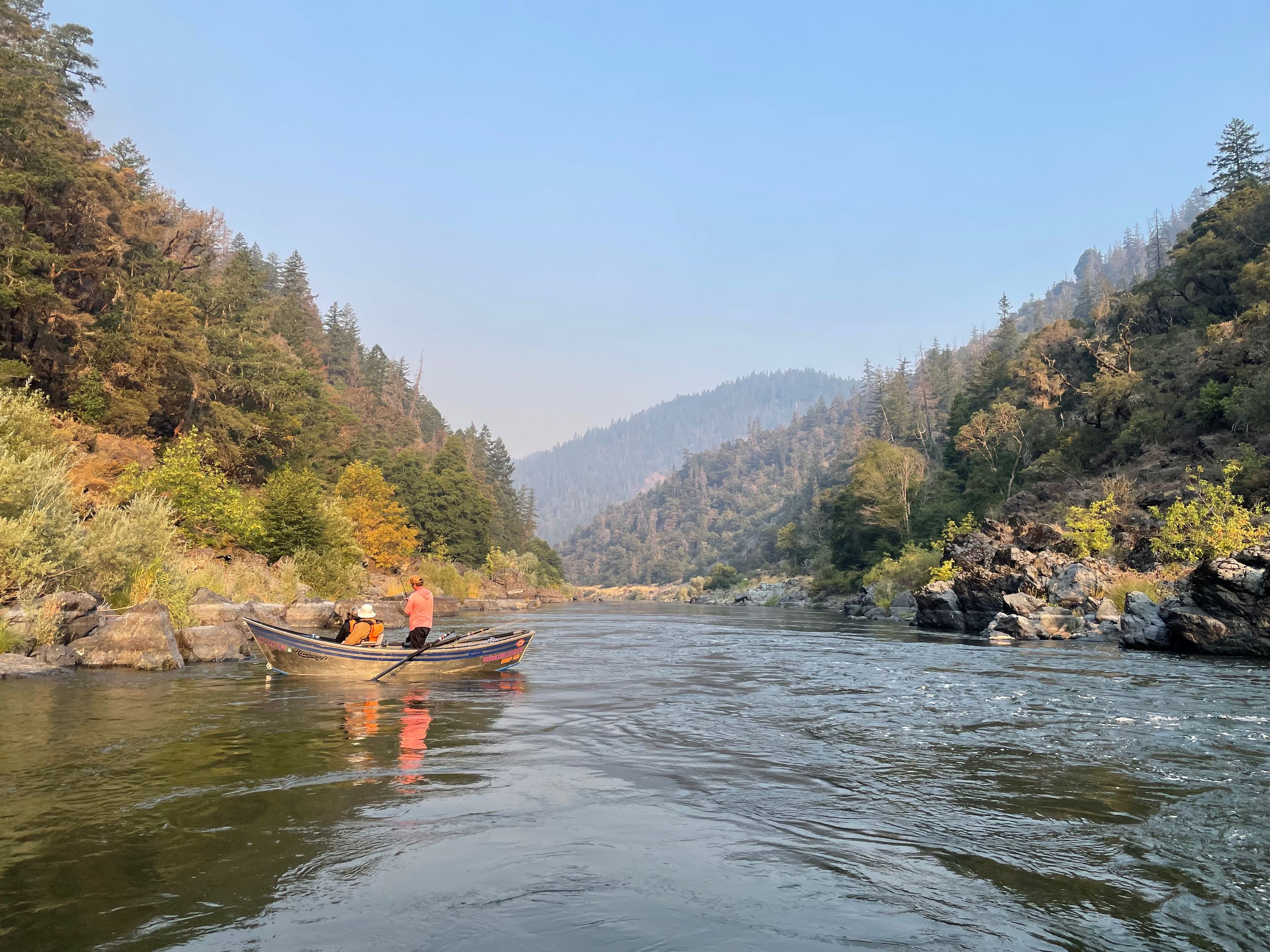 Fishing between the rapids
Fishing between the rapids
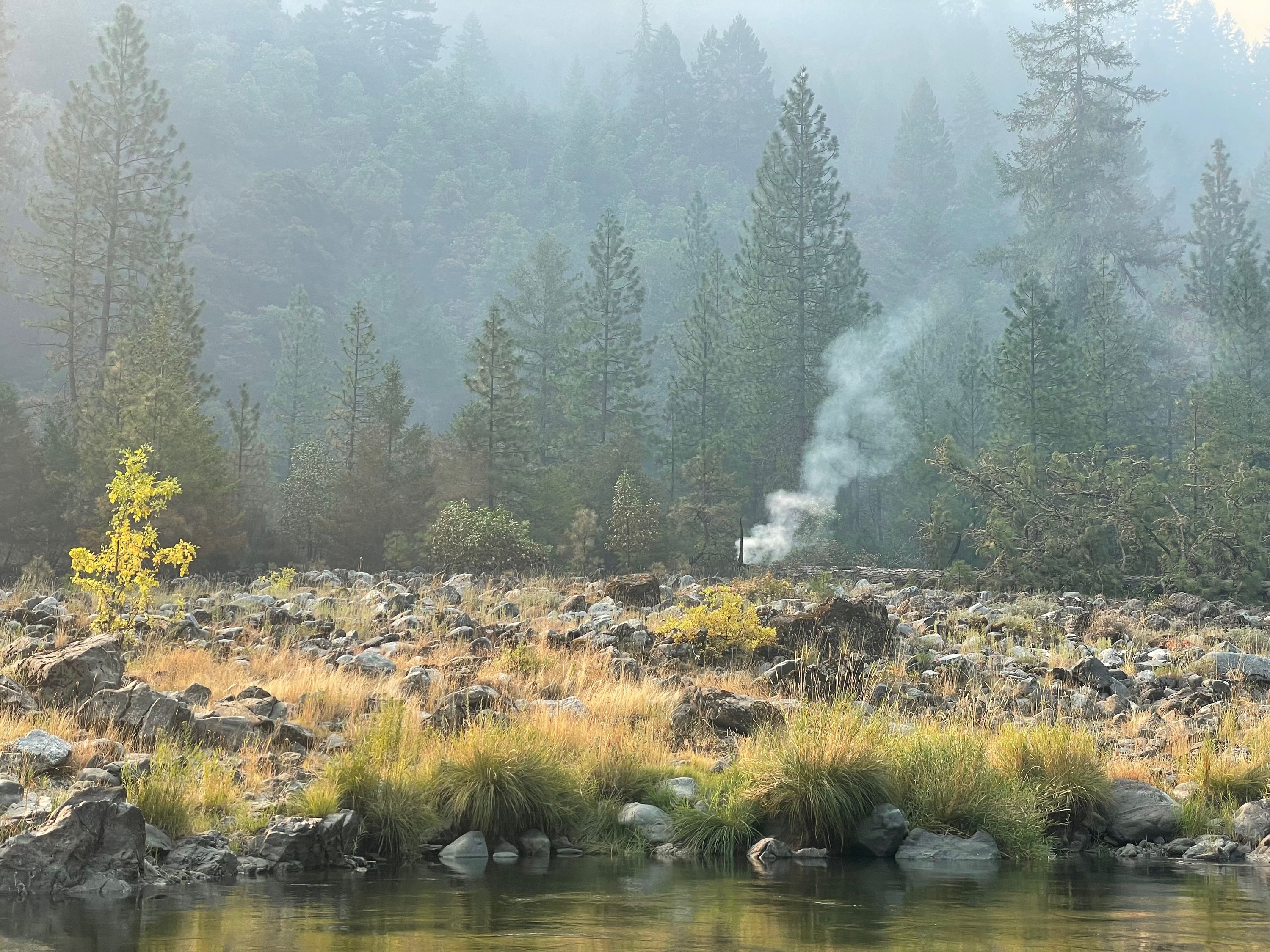 A hot spot still smoking from the Rum Creek Fire
A hot spot still smoking from the Rum Creek Fire
Next up was Black Bar Rapid. I remembered this one from guide school a bit better than the others, probably because we’d stopped to scout it then. It ran pretty much the way I remembered it. We continued onward, stopping for lunch just after the Horseshoe.
After lunch, I rerigged the boat a bit to make it easier to get at the food without moving as much other stuff. We continued downriver, stopping to fish along the way. This stretch has many long, flat pools between rapids, and the rapids are generally mellower. Even the one Class III rapid, Kelsey Falls, is pretty tame.
 Entering Kelsey Falls
Entering Kelsey Falls
In another context, sitting around in a raft while other people fish might be considered boring, but between the spectacular scenery, wildlife, and great weather, I was happy to sit there and take it in. Given that we had 20 miles of river to do that day, I didn’t begrudge the break from rowing either.
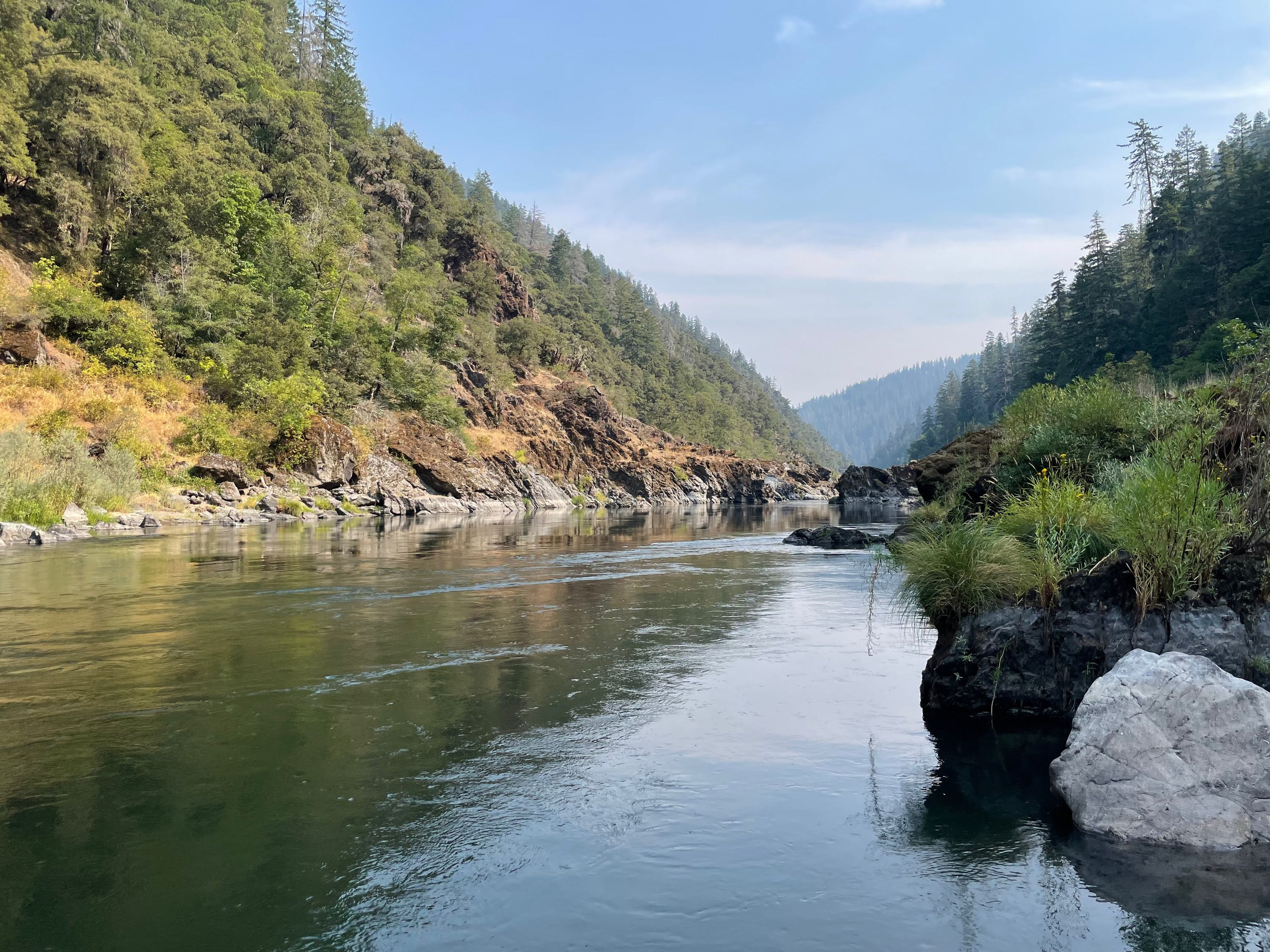 Between Kelsey Falls and Battle Bar
Between Kelsey Falls and Battle Bar
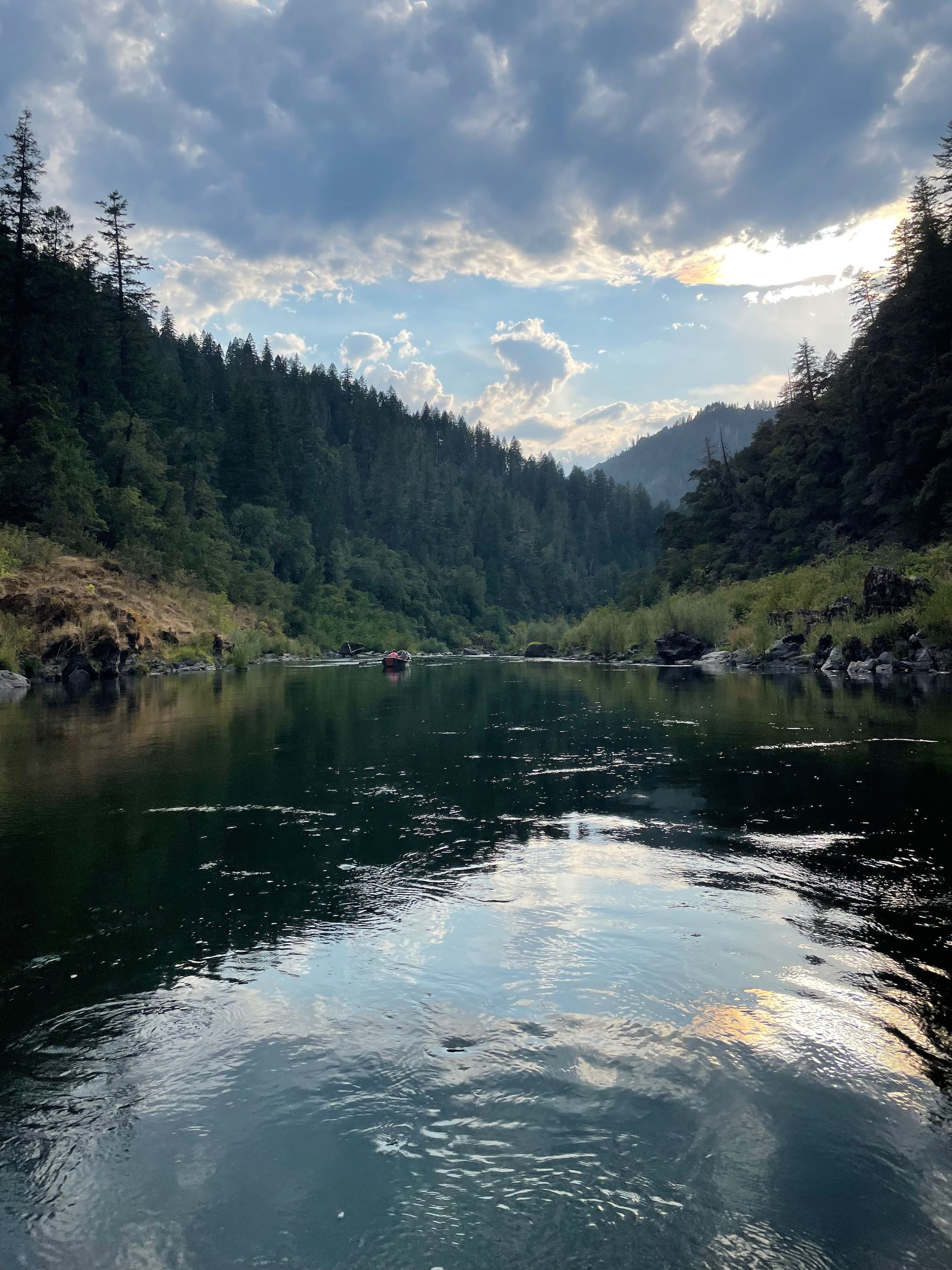 China Bar
China Bar
We pulled up to Marial lodge around 6:30. After offloading the guests and moving all the food up to the bear box, the guides headed up to the guide shack with our gear. There I got a very welcome shower (pretty luxe compared to camping out). We had an excellent dinner: ribs with a bunch of great side dishes. The guides stayed up chatting on the porch before turning in for a well-deserved night’s sleep.
Day 2
Thankfully, we didn’t have quite such an early start this morning. We fished the pool below the lodge for a while before heading downstream.
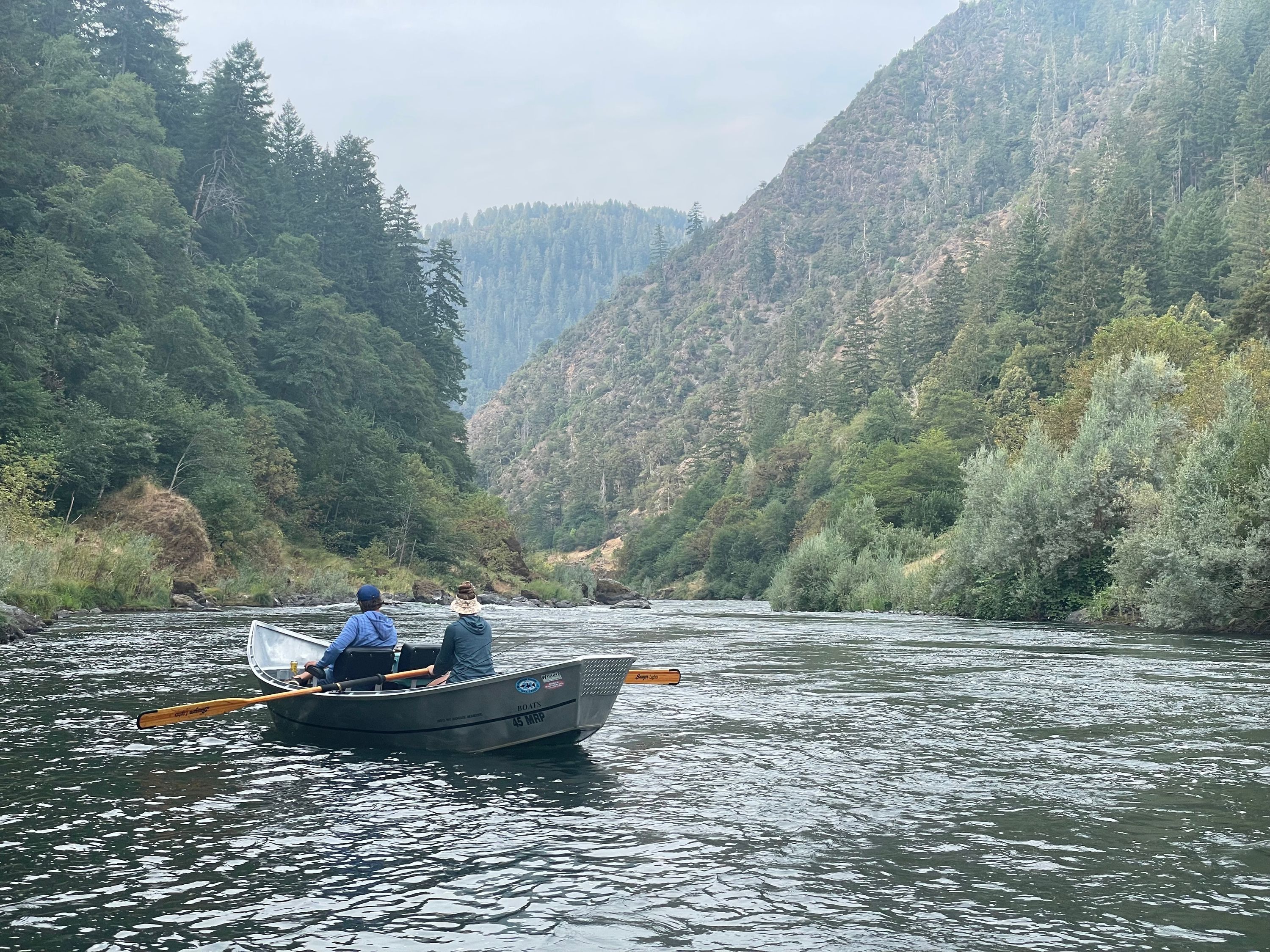 Above Mule Creek Canyon
Above Mule Creek Canyon
The first big challenge of the day was Mule Creek Canyon. This is a very long, narrow, twisting rapid. When I ran it in guide school, my eyes were pretty much glued to the water. This time I felt like I could relax at least a little bit and take a look around to enjoy some of the most spectacular scenery on the lower Rogue.
 Mule Creek Canyon
Mule Creek Canyon
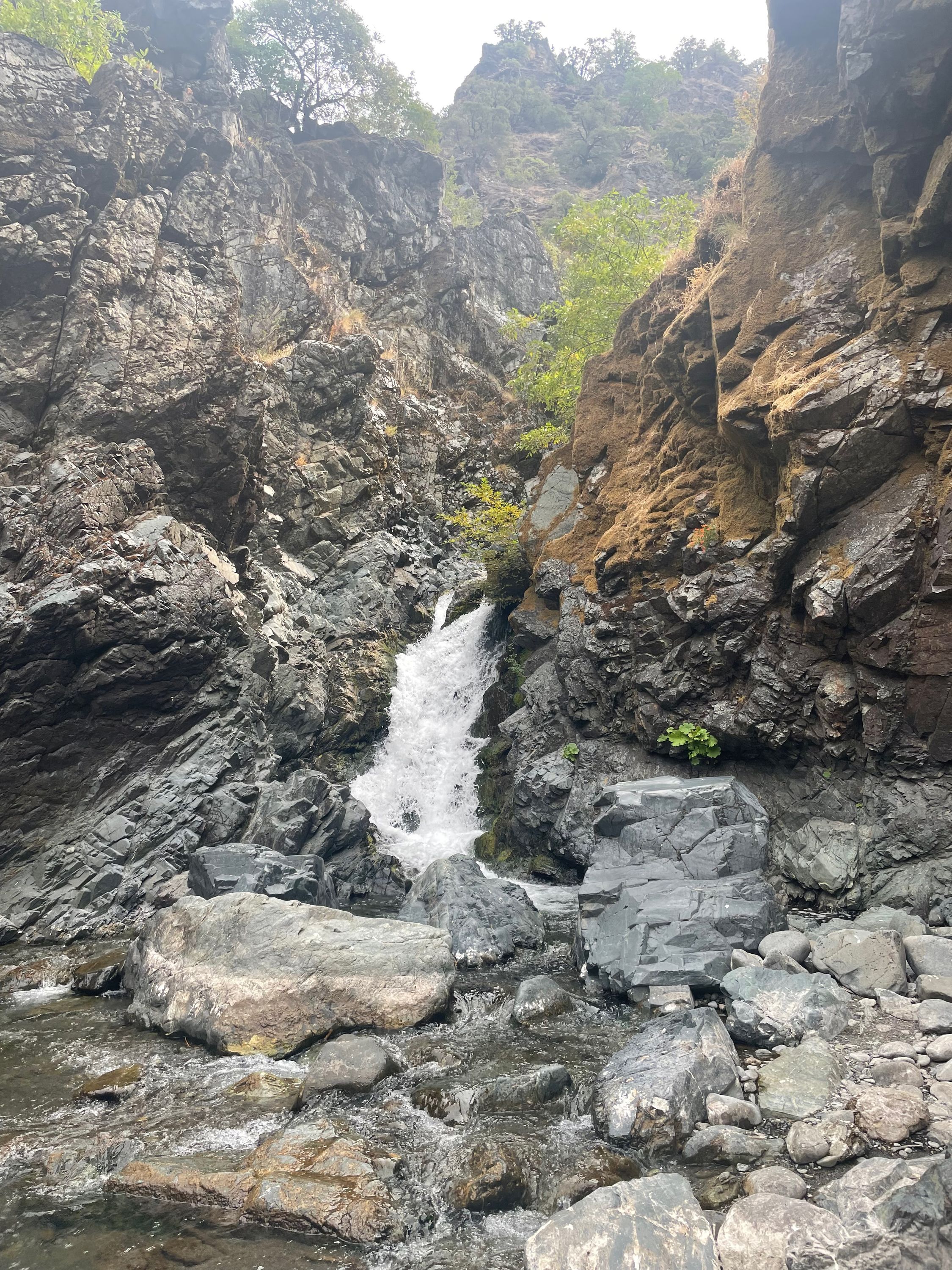 Stair Creek Falls
Stair Creek Falls
 Below Mule Creek Canyon
Below Mule Creek Canyon
Below Mule Creek Canyon, the river opens up into some broad pools. The drift boats fished there while I went ahead to take a look at Blossom Bar Rapid. Blossom Bar is the most challenging rapid on the trip, and it’s one that I didn’t row in guide school (half of us did Mule Creek, the other half did Blossom). Scouting Blossom was definitely a good choice. Not only had it been a while, but it’s also a very different rapid at the lower water level. I was able to get a good look and watch a private trip go through before the drift boats caught up. Rowing Blossom was a bit hair-raising, but I made it through all right.
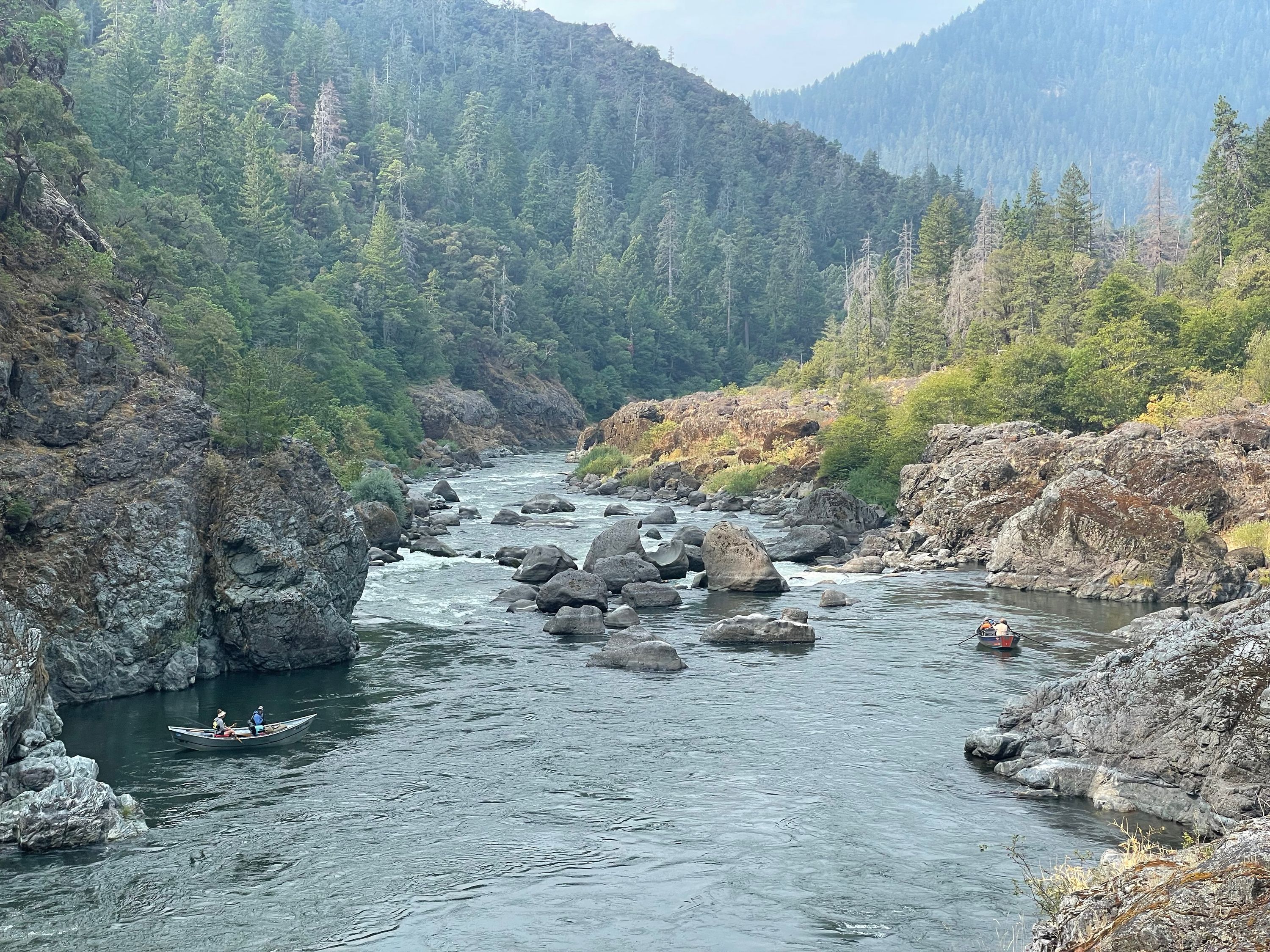 Blossom Bar
Blossom Bar
We fished our way down to Half Moon Bar, encountering a couple of jet boats coming up from Gold Beach. We took a late lunch stop that was one of the highlights of the trip: fish tacos made with freshly caught salmon.
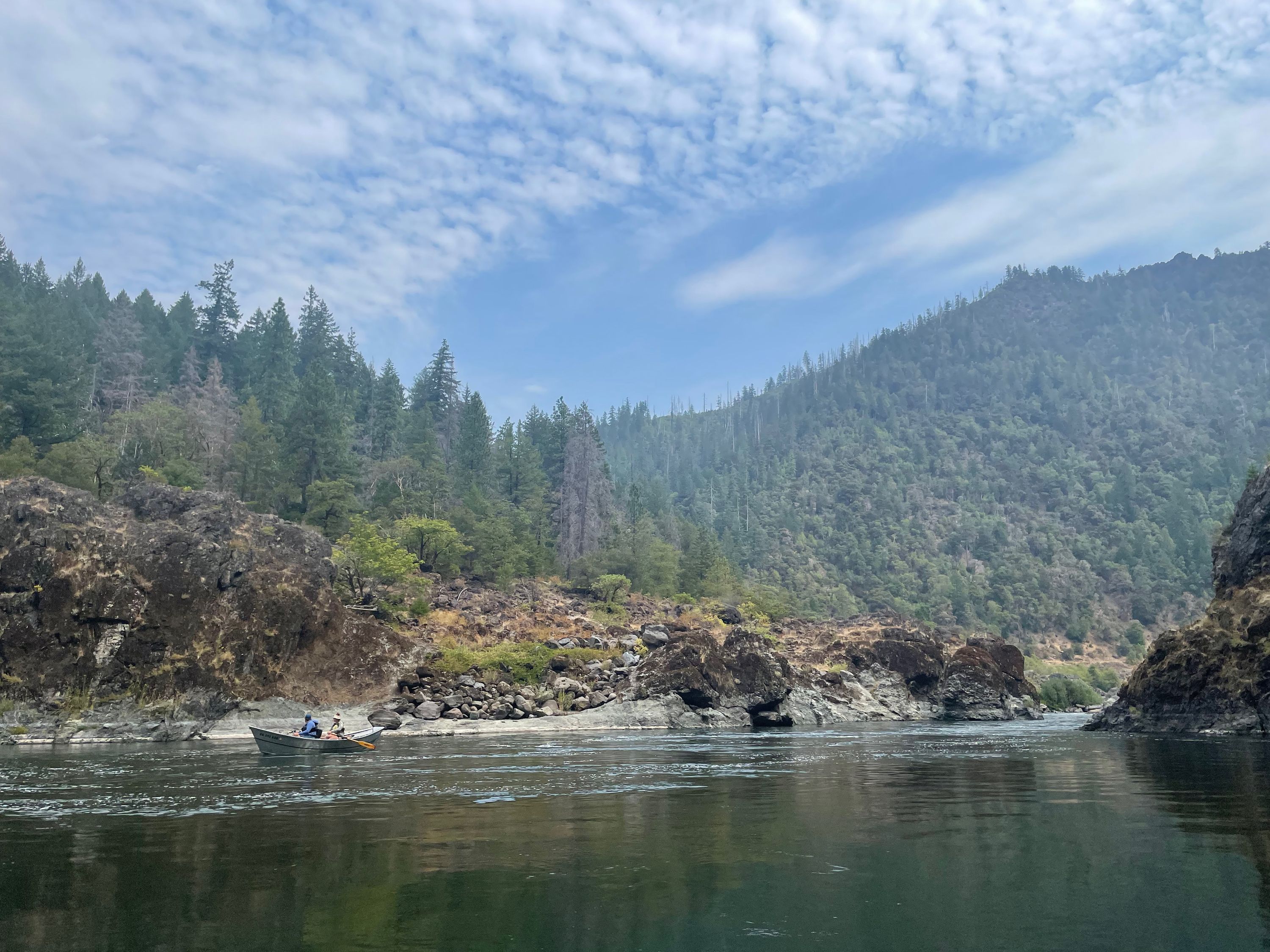 Below Blossom Bar
Below Blossom Bar
 Near Pinnacle Point
Near Pinnacle Point
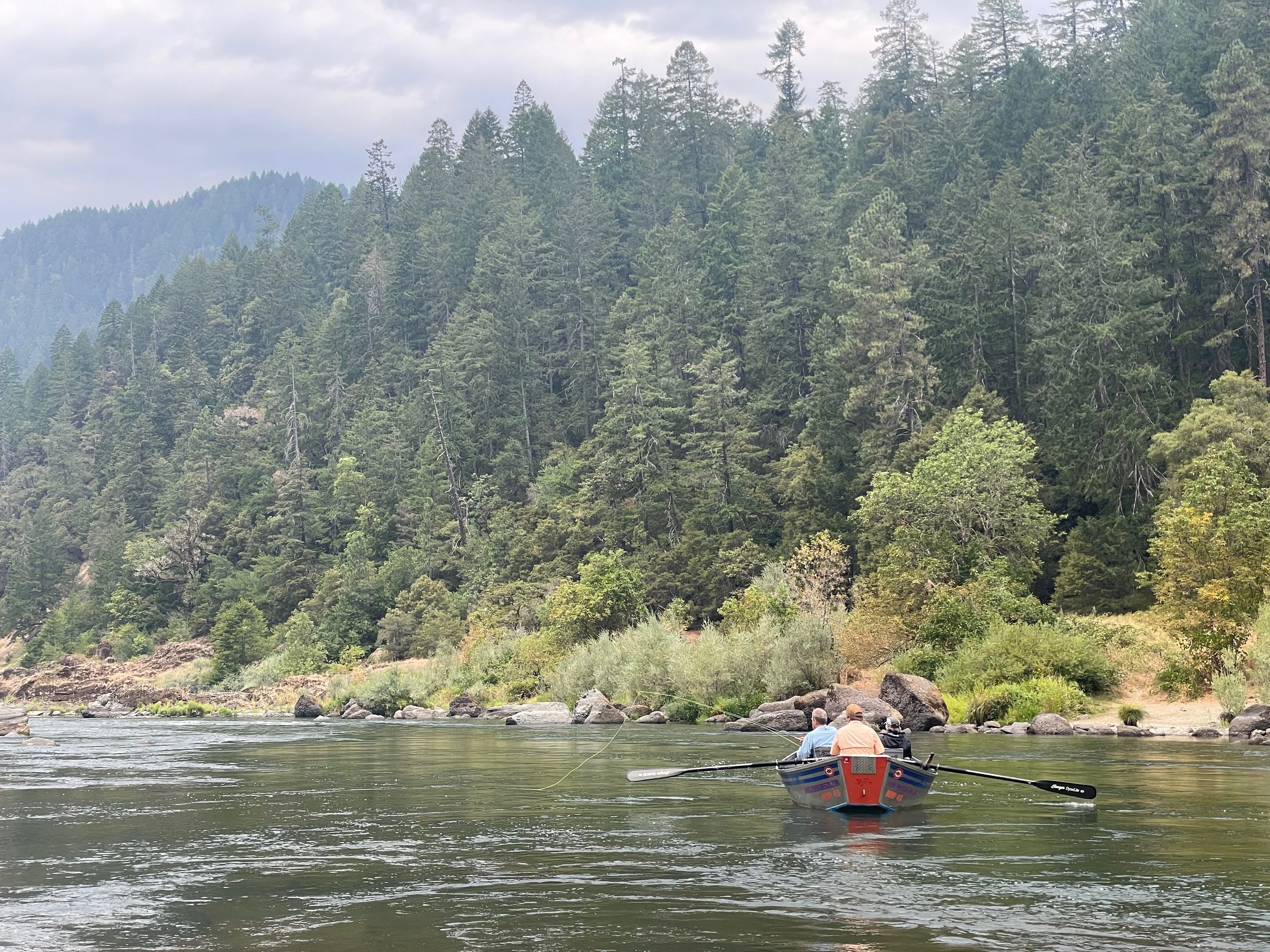 Fishing by Tate Creek
Fishing by Tate Creek
We fished our way further downstream, getting to Clay Hill Lodge around 6 o’clock. Guides and guests all hung out in the big common room, talking and enjoying one of the best views on the trip. Dinner was excellent, with some huge steaks. Afterward, we chatted on the porch of the guide shack for a while. The other guides gave me some good feedback on my run through Blossom Bar.
Day 3
 View from Clay Hill Lodge
View from Clay Hill Lodge
We had a nice breakfast at Clay Hill before heading down to the boats. After fishing the pool below the lodge for a bit, we continued downstream.
 Fishing downstream of Clay Hill
Fishing downstream of Clay Hill
Compared to previous days, the rapids in this stretch are pretty mellow. The only Class III is Clay Hill Rapid, just below the lodge. This one was kind of memorable for me during guide school, when I didn’t catch a pourover ledge extending from the right side of the river until it was too late to avoid and ended up T-ing up and taking it head on, getting my fellow students riding up front pretty wet. This time I stayed well to the left and avoided the ledge entirely.
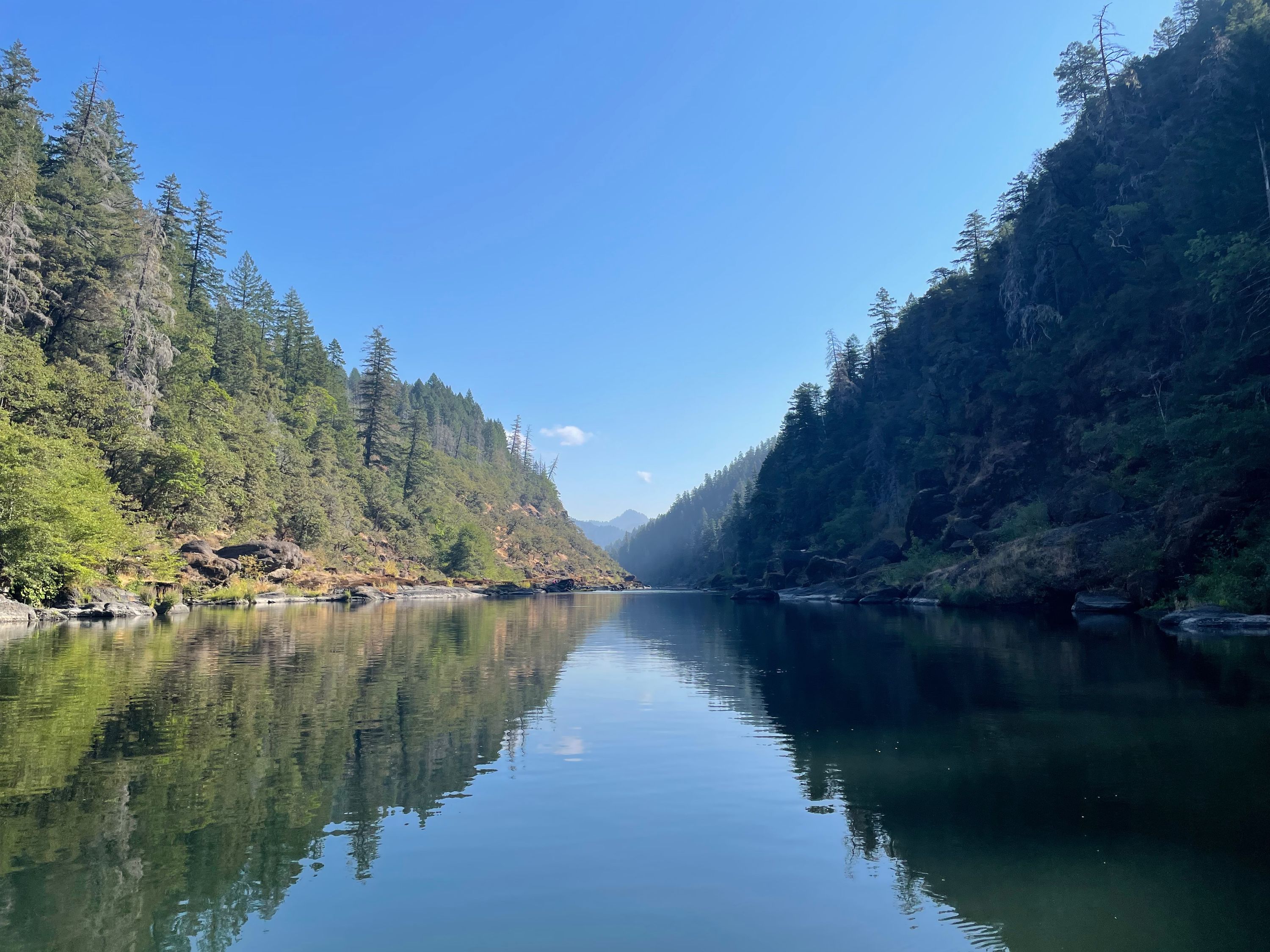 Fishing above Payton Riffle
Fishing above Payton Riffle
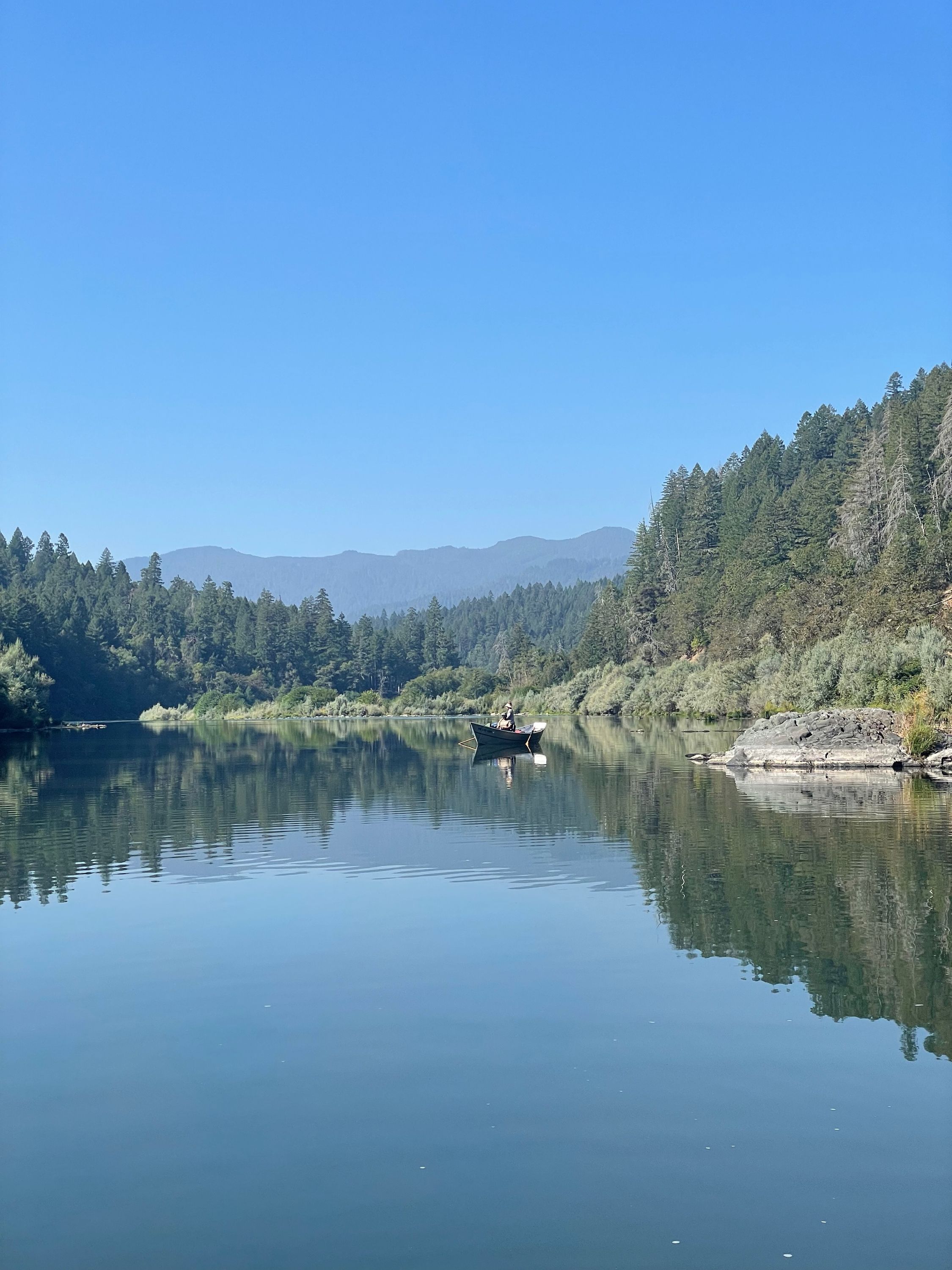 Above Watson Riffle
Above Watson Riffle
Continuing downstream, we fished, navigated the minor rapids, and shared the river with the jet boats (and a couple of other raft trips). Just above the takeout at Foster Bar, we stopped and grilled some more salmon for lunch.
At Foster Bar, we loaded the raft on top of the truck and installed outboard motors on the drift boats (now that we’re beyond the Wild and Scenic sections, motors are allowed). Usually, this is where the gear boat guide parts ways, driving the truck with the raft back to the boathouse. However, one of the drift boat guides was doing this trip as a practice run; she invited me to hop in her boat for the rest of the trip.
We proceeded downriver, switching between rowing and motoring, and doing some fishing along the way. This included side drifting, where both the boat and the bait drift downstream in the current (this seems to demand quite a bit from the fishing guide).
Before too long, we reached our lodging for the night: the Singing Springs Resort. I have to say, while they were up against some stiff competition, I think Singing Springs had the best food of the trip. They also have beer on tap.
Despite rowing only until 1 o’clock, I was pretty bushed. After a nice leisurely dinner, I took a shower and went straight to bed.
Day 4
After an excellent breakfast at Singing Springs, we set out again in the drift boats. Sitting and fishing from the drift boat was very relaxing, though I’ll admit to feeling a bit at loose ends being treated like a guest after spending the previous three days rowing and working as a guide.
 Above Painted Riffle
Above Painted Riffle
Some people claim that the Rogue below Foster Bar isn’t as scenic as the canyon further upstream. After this trip, I have to disagree. I think this stretch is beautiful. That said, I was glad to have the motor. It’s much flatter and would have required much more rowing than even the flattest parts of the Wild and Scenic section.
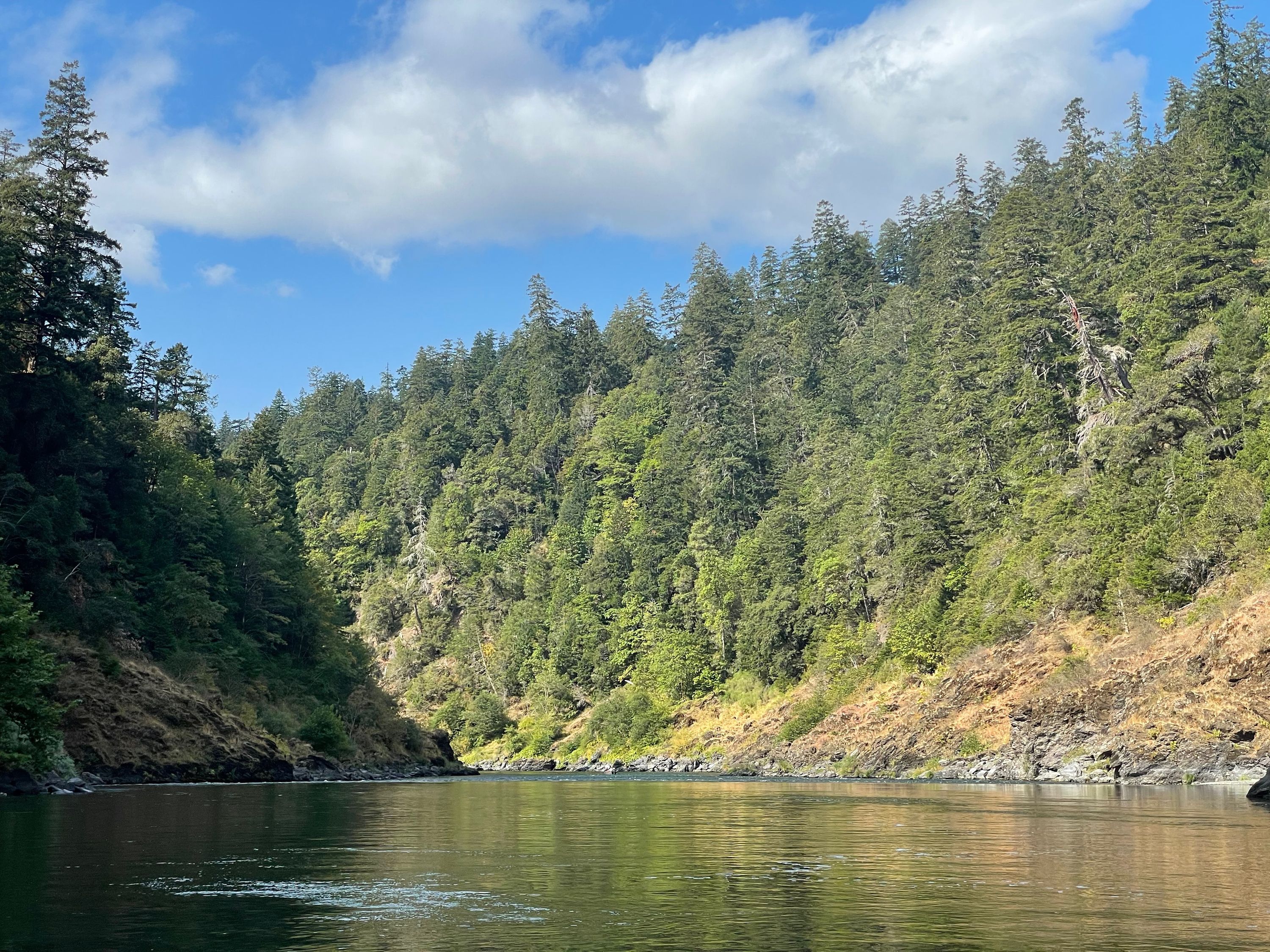 Below Boiler Riffle
Below Boiler Riffle
We got to Quosatana Campground in the early afternoon and loaded the drift boats onto the trailers. From there, it was a very curvy drive over Bear Camp Road back to the boathouse in Gold Hill.
Conclusion
This was a great trip. The Rogue was spectacularly scenic, as always, the weather was excellent, and the guests and my fellow guides made for excellent companions.
I didn’t note each bit of wildlife we saw on this trip because there were far too many. We saw deer, great blue herons, egrets, ospreys, vultures, ducks, geese, and tons of turtles. Plus lots of fish, of course.
The Watershed bag worked well. The zipper on the long side made it easier to dig stuff out than the roll-top dry bag I’ve used in the past, where whatever you’re looking for inevitably ends up at the bottom of the bag. The iPhone lanyard gave me much more confidence whipping out my phone to snap some pictures, so it played a role in the nice pics you see here. Finally, the RiverMaps Guide to the Rogue River was crucial, not just for intel on the rapids, but for keeping me oriented and helping me develop a sense of where different features, lunch stops, and lodges are (which may come in handy on any future trips).
As great as the trip itself was, perhaps the best of all was the news when we got back that the Rum Creek Fire is over 80% contained, with a forecast of cooler weather and some rain over the next week. This is a good sign for upcoming trips. Hopefully, I’ll be rowing some of those.
Swiftwater Rescue course with the Swiftwater Safety Institute
After guide school and Wilderness First Responder training, the last part of my jam-packed month of river guide training was taking a swiftwater rescue course. I signed up for the SRT PRO-I course from the Swiftwater Safety Institute. The class was in Cañon City, Colorado, training on the Arkansas River.
I was looking forward to getting some more experience in the water. During my first swim in guide school, I went over a pourover at the top of an eddy and got dunked pretty good, driven down for about five seconds. We’d planned to swim a rapid on the second day, but that got called off when a student broke an ankle. We did swim Lower Black Bar Rapid on the Rouge later in the class, but that wasn’t enough to really feel confident in the water.
Gear
The course description for the class didn’t absolutely require a dry suit but really emphasized having one. I bought a Kokatat Meridan suit, by far my biggest single purchase when it comes to river guide gear. They also wanted students to have enough carabiners, pulleys, and prusiks to set up a 3:1 mechanical advantage system. The class required everyone to bring their own PFD, preferably a rescue vest.
Before the Class
Due to COVID, the Swiftwater Safety Institute moved the classroom portion of the SRT PRO-I course online. You get a link to the online course two weeks before the class. It’s basically a bunch of videos, each followed by a quiz on the subject matter. In my case, the Wilderness First Responder class I was taking started two weeks before the swiftwater class and soaked up almost all of my time. I used the one day off in the middle of the WFR class to go in and do the online work for swiftwater.
My Wilderness First Responder class wrapped up on Thursday. I had three days to make it from Chico, California, to Cañon City. On the way, I stopped to see a friend who lives near Grand Junction and visited the north rim of the Black Canyon of the Gunnison.
Day 1
The first day of class was only a half-day, so class started at 1:30 at Royal Gorge Rafting (RGR), about 15 minutes west of Cañon City. We started with some waiver paperwork before moving on to some introductions. The instructors for the course were Matt McDonough and Joe Bailey. Matt’s a manager for RGR, while Joe guides elsewhere in Colorado. Most of the students were river guides, many from RGR. We also had a substantial contingent of first responders from Kansas (firefighters and Sheriff’s deputies).
After a quick talk about the Swiftwater Safety Institute’s philosophy and approach to river rescue, we started with some knots. This was one of the things that was covered in the online portion, but they wanted to make sure we could actually tie these. Getting live feedback from Matt and Joe helped me with a few knots.
We moved on to shore anchors. If you’ve got one feature that you’re sure will hold, like a big tree or rock, anchoring to it is pretty straightforward. They showed us a bunch of different ways to do it. In the event you need to distribute the load over multiple features, we learned how to set up a two-point self-equalizing anchor. This distributes the load equally between two anchor points.
Next up were mechanical advantage systems, using pulleys to increase the amount of force you can apply to a load. The basic system is a 3:1 or Z-drag. This can be done with a pair of pulleys, rope, and some carabiners. They also showed off some more complex systems, like a 5:1 and 7:1. We had the opportunity to pair up and set up our own 3:1 systems.
Our last topic for the day was the other end of the system: boat anchors. These mechanical advantage systems can exert a lot more force than one D-ring on a boat can take. They showed how to use the end of one rope to set up a two-point self-equalizing boat anchor attached to a pair of D-rings.
Day 2
The next morning we did some review and Q and A on the previous day’s topics, including practicing both shore and boat anchors.
Matt also demonstrated a “pig rig,” a 4:1 mechanical advantage system using a pair of pulleys, carabiners, and some prussiks. It has the advantage that you can tension a rope, then disconnect all of the pulleys and use them to set up another system. Useful for raft guides with only a limited amount of gear available.
Next up was throw bag practice. We set up in the parking lot and started out just tossing the bags themselves back and forth, then moved on to deploying the ropes. The goal was to get it within arms reach of your partner. I definitely need some practice on this. Throw bags take a while to repack, and sometimes you may need to make a second throw more quickly, so we practiced coiling up the throw-bag rope and tossing the coils. The goal is to be able to deploy a throw bag, coil, and make a second throw within 20 seconds.
We finished up the morning by going over some hand signals. After a break for lunch, we’d met down in Cañon City at a city park along the Arkansas River, where we’d get in the water.
After everyone got suited up, we started the afternoon with a quick walkthrough, going up and down the riverbank to look at the water features we’d be dealing with. None were particularly nasty, but the Arkansas was running relatively high, so we’d be dealing with a lot of water.
Our first swim was pretty simple, jumping in, heading downstream, and catching an eddy on the opposite side. Once everyone did that, we swam back across to an eddy downstream of where we’d gone in. This was more of a familiarization swim, but as someone whose whitewater swimming experience before the class was pretty limited, it had the benefit of getting me used to navigating the river from a duck’s eye view and switching between defensive and aggressive swimming (defensive being floating along with your feet downstream near the surface, while aggressive is a front crawl stroke).
The next swim was a bit more challenging. We swam out into the current a bit further downstream and went through a hole (where the water flows over an obstacle and curls back on itself). Then we caught an eddy on the opposite side of the river. This was a bit of a ride. Our next task was swimming back to the other side and catching an eddy. About half a dozen of us (all river guides) decided to walk upstream a bit and catch the hole again. I definitely got dunked a bit more the second time around.
We did some throw bag practice with live victims. Here it’s not just throwing the bag accurately but also being prepared to belay the victim once they’ve grabbed the rope and swing them into shore.
The order of operations for rescuing someone in the water is “Reach, row, throw, go.” Getting in there with them is generally a last resort. However, part of being a trained swiftwater rescuer is being prepared for that, so we worked on some contact rescues. Here you’ve got to time your jump into the water as the victim floats downstream, swim out, grab them, then grab a throw bag rope and swing both of you to shore. If you don’t get a throw bag, you’ve got to swim them to shore yourself, which is quite a bit more work.
One way to avoid the issue of missing the throw bag is to tether a rope to you before you go in the water. This is a pretty dangerous operation since getting tangled up in a rope that holds you under is a good way to drown. A critical piece of safety gear for this is a PFD with a quick-release ring on it so you can detach yourself from the rope. We did some practice just swimming out with a tether and feeling how the water flows over you when you’re stationary at the end of a rope. Then we pulled the quick release and swam to shore. On the other end of the rope, the person holding the rope and belaying the swimmer was tied into a shore anchor to keep them securely in place.
Moving on to applying this skill, we did a “live bait” rescue where a tethered rescue swimmer grabs the victim. During my first run at this, I had just gotten to the victim and barely grabbed on before the person belaying me yanked me to a stop. Matt let me have another run right away. On that second run, I got a good grip on the victim. As we were being pulled to shore when the rope suddenly went slack. It turns out the belayer had run out of rope. We were both left floating downstream and had to catch a throw rope and swim to shore.
During the day, I’d accumulated quite a bit of water in my dry suit. Partway through the afternoon, I discovered that the main zipper wasn’t completely closed, so I didn’t know whether it was operator error or an issue with the suit.
Day 3
We were back out at Royal Gorge Rafting again for Day 3.
Our first big topic was the tensioned diagonal. This is where you set up a rope running diagonally across the river, which you can use to get people and gear from one side of the river to the other. To simplify things, we set one up on dry land.
Next up was extracting someone from a foot entrapment. Getting your foot caught in a rock may not seem like a big deal, but it can be one of the most dangerous situations on the river. The force of water flowing downstream can push someone over and hold them down, drowning them in water they could easily stand up in if it weren’t moving. Matt and Joe did some dry land demonstrations of a couple of techniques, including sending a tethered rescuer out on a rope and throwing ropes out to a victim to help stabilize them and give them something to push against to get their foot out.
With the dry land stuff out of the way, we got geared up and moved down to the river. We started with some shallow water crossings: basically wading out into the river. They talked about how to use a paddle to support yourself, as well as two and three-person techniques for supporting each other in the water. Finally, they talked about using six or more people to form a big wedge and support each other in a strong current.
We set some people with throw bags as our downstream safety and practiced wading out to a rock about a third of the way across the river. Once everyone was out in the eddy behind the rock, we formed a couple of wedges and walked back to shore.
Since the people who had been doing downstream safety hadn’t gotten a chance to try this stuff, Matt divided us into two groups and sent half of us to be downstream safety while the other half walked out to the rock and practiced the wedge formation. Once they were done, we swapped. This time, rather than walking from the rock back to the shore after we formed the wedge, we walked out further. Eventually, we reached the point where the river was deep enough that people started floating and lost traction, so the wedge began sliding backward. At that point, Joe called a “blowout,” and everybody separated and swam for it.
We had a quick foot entrapment scenario where Matt played the entrapped victim out on the midstream rock. We assigned various roles, and a group of folks walked out to him, formed a wedge, and floated him back to shore.
After lunch, we split again, with half of the group tossing throw bags while the other half did some flip drills. I’d had a little bit of boat flipping experience in guide school, but I hadn’t gotten a chance to do it by myself until now. Joe also showed off an interesting technique for flipping a boat while someone’s underneath it, grabbing on so that they end up in the boat when it’s upright.
The two groups swapped, giving me a chance to do some throw bag drills. I managed the certification standard of throwing the bag, coiling up the line, and throwing it to a swimmer within 20 seconds, though it did take me three tries.
Our next project was setting up a hasty diagonal. Unlike the tensioned diagonal, rather than using anchors and pulleys to keep the rope taught, the hasty diagonal has people on each end belaying to keep everything tight. Several people swam the river, and we (eventually) managed to get a throw bag across to them. After using a second throw bag to extend the rope, we got set up on both banks.
We attached a pulley with a prusik loop to the rope so you could hang on to the loop and let the current and the angle carry you across the river. Initially, our angle wasn’t steep enough, so the first guy to go across stalled out about 10 feet from the bank in some heavy current. We moved the anchor a bit upstream. I was the next to go. It was quite a ride, holding on in the face of a strong current. We got a few more people across before some rafts came downstream and we had to let the rope go.
To get folks on the far bank back across, we set up a pendulum rig. Joe swam a line across. We tied some loops near the end and clipped in carabiners for people to hold on to. While they belayed the rope on the opposite shore, we hopped in the river and let the current swing us across. Well, most of the way across. The river’s geometry and our anchor point were such that we stalled out about 2/3 of the way over. What we really needed was a tag line running from the rope to shore to pull everybody in. Instead, I ended up letting go and just swimming/wading the rest of the way.
That finished up our time in the water. I had paid particular attention to getting the zippers on my dry suit completely closed, which seemed to have paid dividends. I was nice and dry in there compared to yesterday.
We got our gear stripped off and moved to our final exercise: pairing up and setting up a 3:1 mechanical advantage setup.
With that, we filled out some course evaluations and wrapped up the class.
After the class
The RGR guides in the class asked if anyone wanted to go boating. I’d never been down Royal Gorge, so I said yes, as did half the class. Some folks with more space in their cars than I drove down to Cañyon City to set up a car shuttle where we’d take out. The rest of us got some boats down to the beach and rigged. As we did so, more RGR guides showed up wanting to do a play trip, so we ended up with half a dozen boats and a kayak in our little fleet.
We got on the water at about 6:30. I was in a little 10’ raft with a fellow student from the class guiding from the rear seat and a pair of first-year RGR guides up front with me, paddling. The little 10’ boat was pretty sporty and quick, but we also got tossed around quite a bit. I ended up getting tossed out right at the top of Sledgehammer Rapid, a pretty big Class IV.
First, I tried to swim back to the raft. They turned upstream and were trying to paddle up to me, but before we made contact, we went into a hole, and I got pounded down deep. I remembered getting dunked in guide school and thinking, “It’s OK, I’ve been here before.” I swam back up to the surface, and when I came up, I didn’t see the raft anywhere. Later, they told me that while the raft slowed down the hole, I went deep enough to stay in the current main current and popped out downstream of them.
I had a few moments on the surface to get a breath and try to get in a defensive swim position. As I was bringing my feet up, I hit a submerged rock at the top of a hole, banging my shin pretty bad and flipping me face-first into the hole beyond. I got driven down deep again. It was kind of a blur at that point, but later I heard that I got recirculated at least once. While I was down there, I realized this was a pretty serious situation.
When the hole spat me out and I came up, it seemed like everyone on the river was yelling at me to swim left. I did, and later I found out that I’d managed to avoid a nasty recirculating hole. That got me close enough to another raft that I managed to barely get my fingertips on the T-grip of an outstretched paddle, but before I could get a grip, the current swept them to one side of a big rock while I got swept to the other.
At that point, I was basically at the bottom of the rapid. The kayak rowed by one of the guides was able to get close enough for me to latch on. He paddled me over to the raft I’d been in.
We made it the rest of the way down the gorge without incident, arriving at the take out in Cañon City around 8 pm. It’s definitely a beautiful trip with some great scenery, but that’s probably not what’s going to stick in my mind.
After shuttling back to Royal Gorge Rafting, I was getting packed up and changed into some dry clothes when I ran into Matt. He’d heard from the RGR guides that I’d swam Sledgehammer and asked how I was doing. After I assured him I was fine, he said that he’d swum Sledgehammer before. That made me feel a bit better.
There aren’t many places to eat in Cañon City at 9 p.m. on a Wednesday, so we all congregated at Chili’s for a well-earned late dinner.
Conclusions
Even before my big swim, I felt like the biggest benefit of this class for me was getting much more comfortable with swimming in whitewater. That said, I hadn’t been expecting to put those skills to the test that same day.
Beyond the additional swimming experience, this class taught me a lot of great rescue techniques, from contact rescues to rope work to shallow water crossings. I definitely feel like I’ve got a good toolbox to draw from if something happens on the river.
The class also reinforced that I need a lot more throw bag practice. I need to spend some time chucking ropes after this experience.
Matt and Joe taught a great course. They explained the concepts well and provided good coaching and feedback to the students. I’d definitely train with them again.
I also need to give props to my fellow students. They were great folks to hang out with. I also really enjoyed the opportunity to raft Royal Gorge, even if it was a bit more excitement than I bargained for.
Wilderness First Responder with NOLS
Recently, I finished a Wilderness First Responder course taught through NOLS. The class was hosted by Adventure Outings, the student outdoor club at Cal State Chico. The classroom portion of the course was on campus at the Wildcat Recreation Center.
Before the Class
The ARTA Pro Guide Course ended just before Memorial Day weekend, while the WFR courses didn’t start until the following Tuesday, so I had a few days between the two classes. On Saturday, I picked up my parents from a backpack along the Pacific Crest Trail south of Mount Shasta. While they were doing a day hike on Sunday, I worked on my blog post on the Pro Guide Course.
On Memorial Day, I dropped my parents off for another PCT backpack, then continued south to Chico. I got there around 1:30. The check-in time for my AirBnB wasn’t until three, so I spent some time walking around the Cal State Chico campus and Chico’s very walkable downtown. I stopped in a nice used bookstore and found a book on early Grand Canyon river guides.
After getting set up in my Airbnb (a lovely little bungalow less than a mile from campus), I stocked up on groceries and settled in.
The Class
The course was taught by a pair of NOLS instructors, Clemencia and Muggy. We had 24 students, at least half of which were either river guides or in the process of becoming guides. Most were college age, many of them students at Cal State Chico.
The class was about two-thirds lecture and one-third hands-on scenarios. In the scenarios, some of the students in the class would play someone injured or ill while the rest of the students had to work through the patient assessment and potentially treat them.
There was a big emphasis on the patient assessment system. Systematically going through a series of steps to gather information that informs decisions on evacuation and treatment. You start with sizing up the scene: safety, number of patients, etc. Approach the patient and get consent to treat, then check their airway, breathing, and circulation, and make an initial decision about a potential spinal injury. After that, it’s a head-to-toe examination, take the patient’s vitals, and ask them about relevant medical history.
We did 3-4 scenarios working through the patient assessment process every day. They started it out fairly simple, gradually incorporating more elements over the course of the first few days until we were doing the whole system. Most of these were done in the recreation center, but for some of them, we got out to some recreation fields or a little creek that runs through the center of campus.
Once you’ve worked your way through the whole assessment system, then it’s time to start treating (other than immediate threats to someone’s life discovered during the airway, breathing, and circulation check) and making decisions on evacuation. These treatment and evacuation decisions for different injuries and illnesses were the main emphasis of the lecture portions of the course. We mainly talked about injuries (wounds, sprains and broken bones, burns, etc.) during the first half of the class, with an emphasis on illness during the second half.
For the most part, the class ran from 8-5 every day, with an hour break for lunch. We had Day Six off (I spent it working on the pre-course “homework” for the swiftwater rescue course I’d be doing the following week and writing up my notes from the Pro Guide Course). On two days, we also had an evening session. Day Three, our evening session was in the classroom, working on splints. On Day Seven, it was out at Big Chico Creek Ecological Reserve.
That evening was pretty interesting. Not only were we out in more of a wilderness environment, but it was also by far the longest scenario, keeping us with our patient for a couple of hours. A longer duration is one of the things that distinguishes wilderness medicine from its urban counterpart, where the time to higher-level care is much shorter. Muggy does some mountaineering and joked that sometimes in that context, “A regular evacuation takes a week. A rapid evac takes seven days.”
The last day of the class is the final exam. There’s a 100-question multiple-choice test and a practical exam where you and a partner have to do the patient assessment on an instructor playing the part of an injured patient. Everyone in our class passed.
After the class
We finished up in the early afternoon on day 10. I spent the rest of the afternoon working some more on the notes from the Pro Guide course and getting everything packed up. The next day it was back on the road for the drive to Cañon City, Colorado, for my swiftwater rescue course.
Conclusions
During the Pro Guide Course, Noa really emphasized how important and valuable Wilderness First Responder training was so I came into this class with pretty high expectations. I have to say the experience exceeded them. Clemencia and Muggy were great instructors: highly knowledgeable in the subject matter and great at teaching it. We also had an excellent group of students. I was always happy to be partnered with any of them during the scenarios.
Lessons learned
This class is a firehose. I took even more notes than I usually do, filling a pair of 150-page Rite in the Rain notebooks. Most of my studying came in the form of typing up and reorganizing my notes on the computer every night (though I got behind on the days when we had the evening sessions).
On Day 9, I also worked through a 300 question online practice test. This particular practice test does come with the caveat that it’s not an official NOLS product and some of the questions are not up to date with the latest changes in the curriculum, but I found it very helpful. It played a key role in my only missing three questions on the written test.
Between nine or more classroom hours and out-of-class studying, this is a class that’s going to suck up all of your time for ten days. Don’t plan on getting much else done during the course. I’d recommend copious note-taking, whatever study methods work best for you, and the online practice test.
Oregon Pro Guide Training with ARTA
After an 18-day raft trip through the Grand Canyon in April, I decided to pursue a career change as a river guide. The guides on the Grand Canyon trip were kind enough to offer some advice on how to do this. Something I heard from several of them was to seek out some professional training in the form of a guide school.
Once I’d gotten off the river, I did some research and landed on a 10-day Pro Guide Training course from ARTA in the second half of May. It was appealing for several reasons: It fit well for me in terms of schedule. It was soon enough to give me some hope of getting work as a river guide during summer 2022, but just far enough out that I could give my employer two weeks’ notice. It also fit nicely with a Wilderness First Responder course and a swiftwater rescue course that I had found during the first half of June. The ten-day length was also a draw. Most of the guide schools I’d found were a week or less; I thought the added length and additional subject matter (including a multi-day trip during the second half of the course) would be helpful. Finally, as with many guide schools, in addition to being a learning opportunity in and of itself, it’s also a pipeline to produce new guides for the company or organization that puts on the school. ARTA does raft trips on many rivers throughout the west, including several that look like they’d be good stepping stones to working in the Grand Canyon.
Gear
ARTA provides a clear and straightforward gear list. I supplemented it with additional items from the CanX gear list and things I’d either found useful or wished I had on the Grand Canyon trip.
Those lessons learned led to several purchases on my part; everything from a paddle jacket to liquid soap. The one big new piece of gear for this course was a wetsuit. The gear list made clear that a wetsuit or dry suit was mandatory. I got an NRS 3.0 Ultra John wetsuit.
That wasn’t the end of my gear. In addition to the guide training, I’d also be doing the aforementioned Wilderness First Responder (WFR) and swiftwater rescue courses. This meant I’d be away from home for over a month. The WFR class was not very gear-intensive, but the swiftwater class definitely was. It required a dry suit, PFD, and quite a bit of other kit. All this required a whole other big suitcase and another big bag for all the gear.
At this point, I also had 90% of the gear on my backpacking list, so I decided what the heck, I’ll toss my hiking pack in the car just in case an opportunity presents itself. Throw in some stuff I’d be dropping off with a friend I planned to visit on the way home, and my small SUV was packed to the brim.
 The overloaded trunk of my SUV
The overloaded trunk of my SUV
The drive out
Despite the name, the Oregon Pro Guide Training course starts in Northern California (we’d get to Oregon later in the course). It’s quite a drive from Kansas City, so I gave myself five days to make the trip, with only about two hours on the last day to provide some cushion.
I was able to get early starts most days, getting off the road by mid-afternoon (aided by a couple of time zone changes). I spent the night in Ogallala, Nebraska; Little America, Wyoming; Winnemucca, Nevada; and Yreka, California. Of these, Little America was the standout. I’d first heard of Little America back in 2008 when I was moving from Utah to South Carolina. We drove by on Interstate 80, and I was curious about this big motel and truck stop out in the middle of nowhere in central Wyoming. Now, fourteen years later, I finally had a trip where it was a reasonable stopping point. I had a great room and some nice food.
Yreka was only about an hour and a half from Happy Camp, California, where the course would start at 8 pm, so I had a day to kill. I spent the afternoon hanging out in Greenhorn Park, including a nice walk and getting started on this write-up.
I arrived at Curly Jack campground in Happy Camp around 6 pm, after a two-hour drive. I found two of my fellow students already there. Others drifted in over the next hour or so. I made myself some dinner, and another student shared some chips, salsa, and freshly made guacamole.
Our trainers arrived around 8 pm. We started with some introductions. These included both stuff like names, preferred pronouns, hometowns, previous river experience, and what our biggest fears related to the course were.
The demographics of the ten students in the course were kind of interesting. Four were between ages 18 and 22, with another at 26. The rest of us were around my age or older (I’m 44). So two very distinct populations. In terms of what we were trying to get out of the course, I probably had more in common with some of the younger students looking to work as river guides than with the older students who were there primarily to build their skills for private boating trips.
Our trainers were Noa (no “h”), Katie, and Aaron. All have been guides for many years and have taught multiple Pro Guide Courses. They spoke a bit about what we could expect from the course: drinking from a fire hose, but with the trainers available for questions and as resources. They let us know we’d be starting bright and early at 7 am the next day and spoke about gear and being “river ready.”
With the business part of the evening concluded, we all sat around the campfire for a while. The trainers broke out a couple of guitars and a mandolin and sang some songs (stringed instrument skills are evidently required for working at ARTA).
Day 1 — Klamath River, Curly Jack to Windgate Bar
I was up early, sorting through some gear. At 7 am, we got the rafts unloaded so the trainers could get started on the shuttle. Then we had some time to take down tents, pack gear, and get river ready. That means a wet suit, splash jacket, footwear, etc.
Noa very strongly recommended wearing closed-toe shoes on the river, rather than sandals. This was a bit of a problem because these were not on the course gear list. I had been planning on wearing my Bedrock sandals. However, I had a pair of the NRS Workboot Wetshoes that I bought for the swiftwater rescue class I’ll be taking in a couple of weeks. I ended up wearing those for the first half of the course.
We ate some breakfast, and once the trainers got back from the shuttle, we headed down to the beach and started rigging boats. This involved getting them fully inflated, strapping down gear, and getting everything prepped. We also talked about rigging lines on the bottom of the raft to help you climb back on after flipping a boat.
Katie gave a safety talk which we listened to very intently. Not just because we wanted to be safe, but because we were told we’d have to give one later in the course.
With that, we split up among the rafts and trainers. A couple of other guys and I rode with Aaron. He talked briefly about how to paddle and the paddle commands, as he would with guests. However, he hopped right out of the guide seat at the rear and let one of us paddle captain the boat. We paddled downstream, catching eddies on either side of the river and ferrying back and forth.
Along the way, we stopped and floated along for a bit while Aaron had us all hop out and practice swimming under the boat: first from one side to the other, then from bow to stern. Then we had to get back in the boat, which I found pretty challenging. After we were all aboard, everyone had a chance to rotate through the paddle captain’s seat before stopping above Rattlesnake Rapid for lunch.
Before eating, we scouted Rattlesnake Rapid. It has a big hole in the middle, with lots of current pushing you towards the hole. Perhaps foolishly, I volunteered to guide us through the first real rapid of the course. After lunch, we hopped in the boats and ran the rapid. I think I did pretty well.
A bit further down the river, we pulled up on the bank for a swim. The goal was to swim across the river to an eddy and climb out on a rock ledge. Then we’d hop back in and swim across again to a spot downstream.
I saw several people get circulated in the eddy before making it to the rock, so I cut it close at the top and ended up going over a small pourover at the top of the eddy. This, combined with a surge in the river, resulted in me getting dunked pretty good. According to the trainers, I was under for about five seconds (it seemed longer). The urge to panic was strong, but I thought to myself, “I’m wearing a PFD. I’m going to be fine.” I opened up my eyes and swam up a bit, and resurfaced. At this point, I got recirculated in the eddy, shoved into a rough spot on the eddy line, and got dunked again. While I wasn’t down as long this time, I came up outside the eddy. I was pretty exhausted at this point, so rather than trying to fight my way back into the eddy, I struck out for the opposite bank where we’d intended to end the swim. Katie tossed me a throw bag. I gratefully grabbed the rope and pendulumed to shore.
One of the other students missed the eddy, and Aaron swam downstream to follow (the two of them easily got out at the next eddy). My boat got to row a short distance downstream without a trainer aboard to get them.
After our swim, we got back on the river and returned to practicing catching eddies, following the current, and holding our angle (extra hard because we had an odd number of paddlers).
 The kitchen at camp
The kitchen at camp
Eventually, we reached our intended campsite and hung out there while a couple of the trainers did the shuttle, bringing us our bags and gear. Once they arrived, we got camp set up, and the cook crew started dinner (we rotated cooking duties among three groups of students). Dinner was some excellent tri-tip steak with pasta, salad, and brownies. After dinner, we sat around the campfire a bit.
Day 2 — Klamath River, Windgate Bar to Coon Creek
The morning dawned very dewy and wet. Both sides of my tent fly were damp, and the foot of my sleeping bag was wet where it was touching the tent.
My cook group was on lunch duty, so while another crew cooked French toast, we “shopped” lunch, pulling out the stuff we’d need for fruit salad.
After breakfast, Katie talked about communication, covering hand signals and whistle blasts. She and Aaron got started on the shuttle while Noa taught us about river hydraulics. She drew out holes, eddies, pourovers, and standing waves on a whiteboard, which was very helpful. She also talked about eddy lines and ferrying boats across the current.
One thing that was new to me and would prove very useful was the boats float slower when crosswise to the current, so if you’re trying to let rafts behind you catch up, floating crossways is a good way to do it.
Last up was talking about boat angles. Setting an angle relative to the current to keep off of the bank in the bend (something I had trouble with rowing in the canyon), T-ing up to waves and holes, pointing the bow or stern at anything you’re going to bump, etc.
By this time, the sun was high enough to dry out our tents and other gear a bit, so we got packed up. When Katie and Aaron got back from the shuttle, we loaded up the truck and got back on the river. Noa, Katie, and Aaron demonstrated a typical pre-trip guide meeting for us.
Today, I was in Noa’s raft. Again, we rotated among paddle captains. I took us through a small rapid and caught some eddies. Unlike many folks who were catching eddies low, I tended to go too high and bump the boat on the rock. We also worked some on maintaining boat spacing, as opposed to the previous day when each boat was more doing its own thing.
We got to our lunch stop, and my group got started on the fruit salad. Everyone else walked upstream with a plan to swim the small rapid we were eating below. Those of us on lunch duty would swim while the others were eating.
However, one student injured an ankle pretty severely walking over the slippery rocks on the way to the top of the rapid. At the time, it wasn’t clear if it was a bad sprain or a broken ankle, but either way, it was a genuine medical emergency.
The trainers sent the other students back for lunch while they treated the injured ankle and came up with a plan. Noa and Aaron stayed with the injured student while Katie came back and briefed the rest of us on what was happening. She climbed up the very steep slope to the road above and headed downstream to see if there was a good point to evacuate someone before the take out.
At her suggestion, we all sat around going over the safety talk card. Katie returned with the news that the take out was the closest place to get someone off the river safely. She headed off to discuss a plan with the other trainers.
I got halfway through a practice safety talk before they came back and let us know what we’d be doing. I volunteered to help Katie row a raft up the eddy to the injured student. We R2ed it (paddling a raft with two people, one on each side). Once the student was aboard, we loaded everyone else and headed downstream.
The trainers took over paddle captaining to get us to the take out as smoothly and quickly as possible. To make this an educational opportunity, they talked through a “stream of consciousness” of what they were seeing and doing as they guided us downstream. I found it very insightful to learn what Noa was thinking in different situations along the river.
At the take out, they got the injured student loaded in the van. Katie and Noa drove off with her for the car shuttle while the rest of us got the rafts loaded on the trailer. Aaron taught us the Trucker’s Hitch, used to tie down the front of the rafts on the trailer. He had everyone practice tying it at least once.
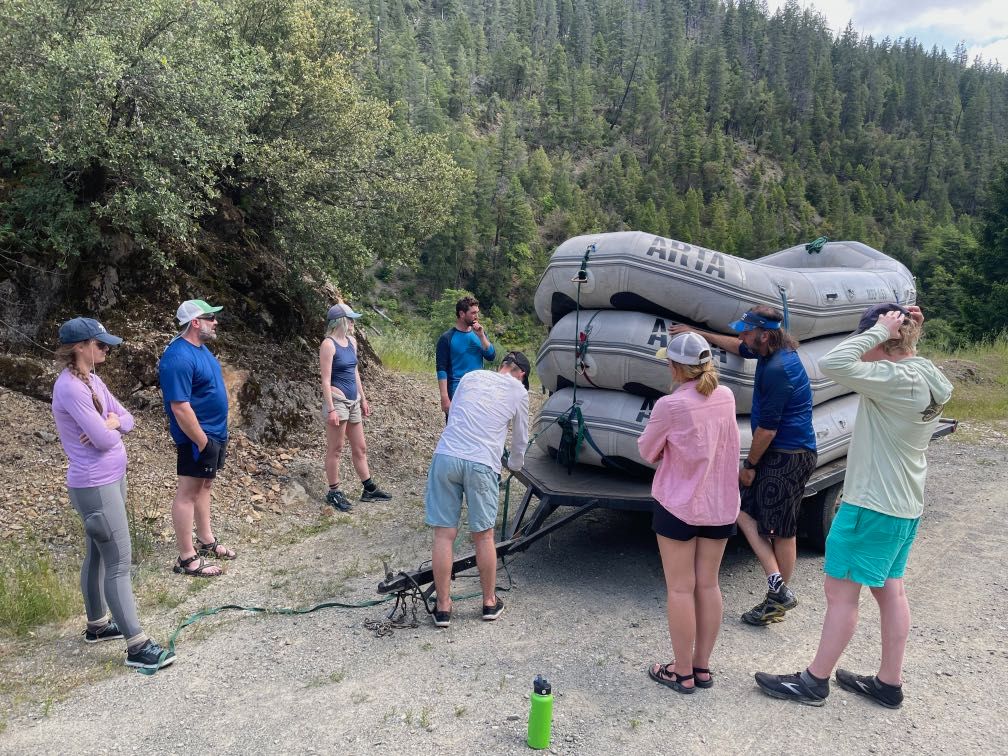 Learning the Trucker’s Hitch
Learning the Trucker’s Hitch
When they got back from the shuttle with the truck, we hitched up the trailer and headed out. I rode with Katie and the injured student in the truck.
We drove to the campground where we’d left the cars. Aaron drove the injured student to Yreka in the van for treatment. The rest of us carpooled to another campground along the Cal Salmon River, where we’d be rafting the next few days.
The other students unloaded the truck while those of us on the kitchen crew set up our tents before starting dinner, a nice vegetarian curry. We didn’t get finished until after 9 pm.
After dinner, we talked through the day’s events: what happened and how everything was handled. I have to say I have nothing but respect for how the trainers responded to the situation. They prioritized the well-being of the injured student, of course. They also kept the rest of us informed and were clear about what was going to happen.
It was very late when we got to bed. I slept very soundly.
Day 3 — Cal Salmon River, Methodist Creek to Nordheimer
Morning came early, especially for the kitchen crew. We got going and prepared a pretty nice spread of breakfast burritos. Since we’d be camping here the next three nights, we didn’t have to take down tents or pack up our gear, just secure everything for the day.
We’d be paddling on the Cal Salmon today (“Cal” to distinguish it from the Salmon River in Idaho). We drove a very long, curvy road up to a section fairly high up on the river. The put in at Methodist Creek was a very steep ramp down to a small, sandy beach. Since the ramp was too steep for the van and trailer, we had to carry the boats a fair distance down to the water. There was also quite a bit of poison oak to avoid on the way down.
This river was very different from the Klamath; much shallower, rockier, and lower volume. Often two paddle strokes would give the boat enough momentum to carry it all the way across the river. Commands had to be precise and very well-timed. In many ways, the most important command was “stop.”
I also found myself relying on the paddlers to turn the boat much more. On previous days there was plenty of time to use my paddle to turn the boat and just use the paddlers to drive us forward (or occasionally backward). Today, the obstacles came thick and fast.
We all got stuck on those rocks a lot. One choice, being a moment late on a command, or calling the wrong command could leave you hard up. The most important lesson was to stop and think about where the rock was, how the boat was held up, and what direction you wanted to get off the rock in. Sometimes you could paddle off the rock (generally, trying to spin the boat off with a turn command seemed to work better than trying to paddle against the current). When that didn’t work, there was a lot of learning how to shift people in the boat around to try to refloat it. As a last resort, the paddle captain could hop out and shove.
I was riding with Katie. She had a great lesson on “guide persona.” You project and act differently when you’re guiding, especially as a paddle captain who has to get guests to follow commands to get down the river. It’s not fake; it’s still your personality, but you may need to be more commanding and authoritative. When you’re in that back seat, it’s your boat. Own it.
After stopping for lunch, we scouted the most significant rapid on this stretch. I was in the guide spot, so I got to run it (I think it says something about how far my paddle captain skills had come in two days that I was much more enthused than scared about this prospect). I did ok. I think I did a good job choosing a line that I wanted to take, so my skill at reading whitewater seems to be getting better. Keeping the boat on that line using paddle commands was more of a challenge.
The students rotated through the guide seat. Today, more than any other, saw a dramatic improvement in people’s skills as the day went on. One in particular in our boat went from very tentative and timid as a paddle captain to far more decisive and authoritative through the course of the day. It was pretty fun to watch. I see why the trainers enjoy teaching this course.
As I was guiding later in the day, I found I was getting better at using paddle commands to maneuver the boat. However, I still didn’t always have the judgment on what was or wasn’t a doable maneuver. I found myself having to go to plan B quite a lot. For instance, in one spot with a medium-sized rock in the middle, I decided that the path downstream from the right side of the rock looked cleaner than the one on the left. After a few strokes, it was clear we probably weren’t going to make it all the way over to the right side. I didn’t want to wrap us on the rock, so I called for a back paddle, bumped the rock and spun us a bit, and took us down the rougher left channel backward. Not the most elegant of runs, but I got some praise from Katie for being decisive about it. Talking to Aaron later, he also noted that my instinct to backpaddle, rather than trying to turn the boat and forward paddle, was a good one.
As the day went on, we were still quite a ways from our take out point. This stretch was flatter and broader (a major tributary had contributed quite a bit of water to the river), meaning it was also slower. We students had taken quite a while to get down the tighter, more technical section of the river. To help get us to the take out in a more timely fashion, the trainers took over paddle captaining and gave some stream of consciousness commentary on what they were seeing and doing.
Katie has some excellent skills reading water. I think we were paddling less than either of the other boats while outdistancing them. This sort of thing is something I have trouble with, and watching her and hearing her describe what she was doing was an excellent chance for me to learn a bit more.
The take out was another fairly long ramp, though not as steep as this morning’s put in. While Katie and Noa drove that long curvy road to retrieve the van and trailer, Aaron taught us the paddle game. It involves balancing a paddle on the blade, stabilizing it with your fingers on the T-grip, then taking actions (clap your hands, pat your head, touch your toes) and getting the hand back on the paddle before it falls over. Definitely a good way to amuse guests during downtime.
After a long shuttle ride, we arrived back at camp even later than the day before. The kitchen crew didn’t get dinner started until after 8 pm. Having been on the kitchen crew yesterday, we were on the dishwashing crew today, so we couldn’t get started with the dinner dishes until they finished at around 10 pm. That made for a very late night.
Day 4 — Cal Salmon River, Butler Creek to Oak Bottom
I was up early doing some writing before breakfast. After we finished the breakfast dishes, we got geared up for the drive back up the Salmon. Today we put in at Butler Creek, a ways downstream of where we took out yesterday. It was another steep ramp to carry boats down to the river, but this time rather than a nice sandy beach, we had to negotiate a couple of rock shelves to get the boats in the water.
When they asked for a student to give the safety talk, I volunteered. I got positive feedback on my presentation, but Aaron noted that the order things are listed on the card doesn’t lead to a very smooth flow. He usually changes the order up quite a bit to tell more of a story. He also had some excellent suggestions on props, getting guests involved, and making it interactive.
We proceeded downriver, rotating the guide position among the students. This section wasn’t nearly as tight as the previous day’s, but there was considerably greater volume in the river. This meant less chance of getting stuck (though it still happened) but more speed and more force acting on the boat that we had to react to.
 The Gaping Maw
The Gaping Maw
Eventually, we reached The Gaping Maw, a pretty intense and intimidatingly named rapid. We stopped to scout it. The trainers would be guiding us through this one rather than the students. However, they asked us to scout it like we’d be the ones running it and pick out our lines before they talked about how they would run it. Along with most of the students, I settled on the same line the trainers chose to run. This was the biggest rapid we’d run so far, but we had a pretty smooth run with Aaron in the rear seat.
Switching back to students doing the guiding, we continued downriver, stopping for lunch and a debrief on the morning. I think I did better today at hitting my intended line than on Day 3.
Towards the end of the day, when we got to a flatter, slower section, we unloaded all the gear from one of the rafts so we could practice flipping and unflipping a boat. These rafts can get turned over in the water, and a guide needs to know how to climb up on an overturned boat and get it back upright. You do this by attaching a flip line, a length of webbing with a carabiner at one end, to one side of the raft and leaning off the other side while pulling on the line until the boat flips. One very evident thing is how helpful it is to have some sort of line rigged on the bottom of the raft to help you get on top of an overturned boat.
While the section where we did this was pretty calm and slow, my boat crew was the last to rotate into the unloaded boat and do the drill. We drifted through a couple of riffles sitting on top of the overturned raft. The boat rides surprisingly well in this situation, even with no one actively guiding it. The boats know the way.
We ended the day within walking distance of the campground where we were staying. The trainers offered us a choice of which stretch we wanted to run tomorrow: either run the section we’d done today again, starting at Methodist Creek, or start right here and raft down to the confluence of the Salmon and the Klamath, then continue down the Klamath through a pair of big rapids called the Ikes. It was a close vote, but we chose to continue downstream.
That meant we didn’t have to take the boats out of the water, just make sure they were tied up well. We could walk back to our campsite from there. On the walk back up, we ran into one student’s sister who was in the area guiding for another rafting company. It was nice to meet her, and the two of them had a chance to talk.
We got off the river much earlier today than on previous days, giving us a fairly leisurely late afternoon. Aaron did a lesson on knots, teaching us half a dozen that he considered vital to a river guide. One thing he emphasized was making well-dressed knots. These have the advantage of being more obviously correct, even to someone other than the person who tied them.
After dinner, we had a lot of time to sit around the campfire, talking and listening to the trainers play songs. A few of us were up late chatting and telling jokes (well, the jokes were mostly Aaron).
Day 5 — Cal Salmon, Oak Bottom to confluence; Klamath, Cal Salmon to Ikes Falls
After three days in one place, we would finally be breaking camp today. The end of the day would also involve a long drive up to Grant’s Pass to the ARTA Oregon guidehouse. To save time, rather than laying out a deli sandwich spread on the river, we gave everyone the opportunity to make a sandwich and put them in baggies after breakfast.
Today, the trainers wanted us to emphasize precision: catching eddies at the top, holding our angle well, and exiting eddies at the top.
Once everything was loaded up, we walked down to the boats. While the car shuttle was going, we paired up and gave practice safety talks.
I was guiding first today, so I got a chance to give the paddle talk. Noa gave me some very positive feedback on it.
Not only was I guiding first, but we were also lead boat, so I had to read water and choose a line without the benefit of seeing what anyone else did.
Throughout the course, the trainers had been dumping themselves out of the boat without warning to give us practice reacting to unexpected swimmers. Noa did this to me this morning, even timing it to a little bump on the rock wall as we went around a bend. I don’t think she expected the current pushing into that corner to suck her partway under the boat and hold her under. I grabbed her and pulled her head above water before hauling her into the boat. It only took a couple of seconds, but as she mentioned when we talked about it later, those were a long couple of seconds for her.
We continued downstream, rotating guides as usual. We stopped for lunch on a rocky beach at the confluence of the Salmon and the Klamath. After eating, we did some throw bag practice. We started on dry land, tossing the bags back and forth, then throwing into the river while holding on to the rope. Finally, we began rotating people through jumping in upstream, throwing the bag to them, and swinging them to shore. We also did some work throwing coils of rope in case you need to make another throw quickly and don’t have time to restuff the throw bag. I concluded that I definitely need to work on my throwing skills.
We got back on the water. Shortly downriver, we came to Little Ike Rapid and stopped to scout. The Ikes were the biggest rapids we’d run so far. I was paddle captain for this one. The rapid has a big rock in the middle at the top that I wanted to pass to the right of, but I wanted to get over to the other side of the river for the lower part of the rapid. I’d planned to establish a strong angle and have everyone paddle hard. However, just before we did our run, Noa pointed out that if I took a tighter line and dragged us through the bottom of the eddy behind the rock, I could slow us down quite a bit and give us more time to make the move. I put her advice into practice and we slowed down so much that we got passed in the middle of the rapid by the raft behind us.
Next up was Big Ike, and it lives up to its name. It has two big holes right in the middle, one after another. We stopped to scout and rotate paddle captains. The trainers emphasized how dangerous the holes were. Hit them, and a flip was very likely. If you got thrown out of the boat, the best bet is to ball up and let the raging water take you down to the bottom and spit you out downstream, underneath the recirculating water at the back of the hole.
Everyone planned to drop in on the right of the top hole. The first boat got through, no problem. The second boat didn’t get far enough right and was going to hit the hole. The student paddle captaining the boat called for a left turn to T-up to the hole. They had enough momentum to punch through the first hole and rode up the frothing wave behind the second. From the third boat, I saw them hanging right on the top of the wave, but they just barely had enough speed to make it over and slide down the back side.
The paddle captain making the quick decision to T-up and executing it well really saved the day here. If the boat had hit the hole even a little bit sideways, it definitely would have flipped. Hitting it dead on didn’t guarantee they wouldn’t flip, but it at least gave them that chance.
Just below Big Ike, we paddled over to the take out. After we got the boats on the trailer, Aaron gave out the address of the ARTA Oregon guidehouse, as well as his phone number. Some of us would be following him in the van directly, but others wanted to make stops (several wanted to hit REI in Medford for some gear before the second half of the course).
We made the long, slow drive out to I-5, stopping at the rest area along the interstate to rendezvous before students branched off to their other destinations. Our little convoy headed out on I-5, reaching Grants Pass around 7 pm. We made a stop in town to pick up some pizza.
Everyone trickled in over the next hour or so. We set up tents in the yard and spent some time sitting around a campfire before going to bed.
We’d had five days of great water, fantastic weather, and tremendous learning. I was looking forward to the second half of the class.
Day 6 — Transition Day
The trainers let us sleep in a bit today. As usual, though, once I woke up, I couldn’t get back to sleep (the neighbor starting up his diesel didn’t help). I did some writing on previous days’ trip journals while I waited for everyone else.
This morning, our big task was to unload: get everything off the truck and put away in the boathouse (a big barn/shed type building behind the guidehouse). I was put in charge of this operation. Frankly, with such a well-oiled crew, I could take a hands-off approach. We got everything unloaded in pretty short order. Most of the work was cleaning and deciding what would get rolled over to the next trip. The food buying crew got to work inventorying what was available in the boathouse so they could build their shopping list and head out on a grocery run. We got done well in advance of our noon deadline.
After lunch, we got started on the load. We had to get everything needed for a four-day trip, from the boats and oar frames to hand soap and webbing for tying down bags. They had a nice color-coded list on a big board in the boathouse that we worked off of. One thing they did that I thought worked very well was the “Good Morning” list. Anything you couldn’t take care of or get loaded goes on this list to be done in the morning before getting on the road.
When everything was on the truck (save for the items on the Good Morning list), we gathered around the list on the big board and went through every item. The rule was you could only confirm an item if you’d either loaded it on the truck yourself or seen it being loaded.
Once that was done, we had a bit more time before our next lesson on boat patching. Katie talked about the process, covering both temporary repairs in the field and more permanent fixes back at the boathouse.
Next up, we moved into talking about wrapped boats. This is where a boat is pinned to a rock by the force of the river. Noa and Aaron talked through the options from the simplest (shifting weight and having people aboard pull on the boat) to the most complex (setting up a line from shore rigged with pulleys for mechanical advantage).
 Self-equalizing anchor
Self-equalizing anchor
Perhaps the most critical part of the lesson was showing how to make a self-equalizing anchor so that if you’re the one stuck on a rock and someone throws you a line, you can get it attached to the boat without relying on just one D-ring or other anchor point that might give way. They did delve briefly into mechanical advantage systems, showing us how to set up a Z-drag system with pulleys and carabiners. However, Noa reiterated that the way to really learn this stuff is to do a full swiftwater rescue class.
This left us with a bit of time before dinner and quite a while to relax afterward. The trainers used some of this for one-on-one mid-course evaluations with students. They talked about how we were doing in the class so far, what we should be working on, and asked what we wanted to improve during the second half of the course. I talked about getting better at reading water, making decisions and going to Plan-B in rapids, and making sure my rapidly developing confidence in the water didn’t exceed my skills.
I changed out some of my off-river gear from what I’d used during the paddle portions of the course, taking a Paco Pad rather than a Thermarest, throwing in some rubber boots instead of my hiking boots, and piling everything into a big dry bag rather than the duffle I’d been using. The ARTA PFD that one of the students was using was rubbing his neck quite badly, so I loaned him my spare NRS Zen for the rest of the class.
We ended the day around the campfire, as usual.
Day 7 — Rouge River, Argo to Tyee Camp
Today was an early morning. We got a quick breakfast and packed our personal gear. We were wheels up by 8 am. I hopped in the back seat of the truck instead of the van. It afforded more legroom with Noa and Katie in the front seats.
We made a stop at the US Forest Service visitor center for our river permit. While we were there, staff at the desk twice asked me, “How can I help you?” even though I was 20 feet away and Noa and Katie were standing right in front of them. Not exactly a positive indicator when it comes to gender equity in rafting.
Once we got to the Argo put in on the Rogue River, we got right to work rigging the rafts. We would be running two 18-foot oar boats, a 16-foot oar boat, and a 14-foot Oar Paddle Combination or OPC. That’s a boat with oars in the rear and up to four paddlers up front. These oar boats take a lot more rigging than the paddle boats of preceding days.
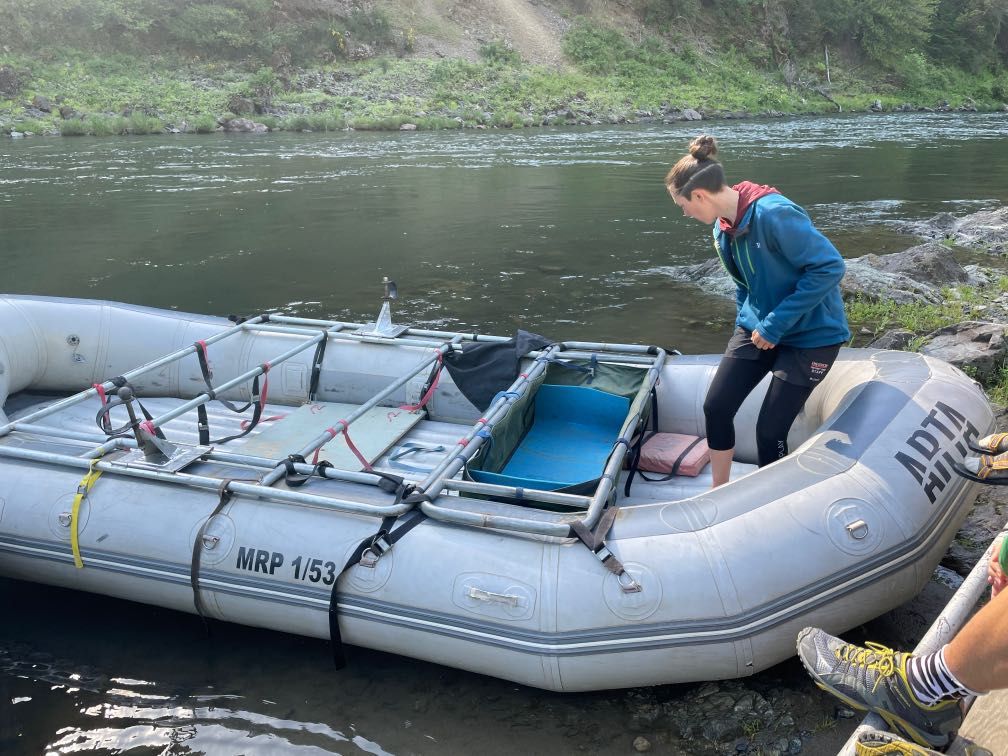 Frame on an oar raft
Frame on an oar raft
Step 1 for all of these was attaching the frames: large tubular metal contraptions where the oars attach to the boats. The frames also provide space for the coolers, dry boxes, and other gear. After we had all the boxes installed, we loaded up the bags. These mostly go in the stern of each boat, but we rigged some ahead of the rower as a backrest for anyone sitting in the front. By the time we got the boats rigged, it was almost noon. We pushed off and started rowing.
I was up on the oars first in an 18-foot gear boat with Aaron and one other student. My experience rowing a similar boat in the canyon came back pretty quickly. The real difference was the far better understanding of how to read water, choose lines, and hold angles that I’d developed in the paddle boat over the first five days of the course. There were a few bumps (both metaphorical and literal), but I was able to get the boat down the river fairly effectively.
When I started on the oars, Aaron said he was just going to watch me row for a bit and see where I was, skill-wise. When he did offer some things to work on, they were pretty subtle. Probably the biggest was to get used to doing two-oar turns (pushing forward on one oar and pulling back on the other to rotate the boat) rather than just pushing on a single oar. He also emphasized that when you needed power, shorter strokes in a good rhythm produced better results than digging in for a big stroke. I took the relatively minor nature of the corrections as a sign that I was doing well.
We stopped under a highway bridge for a late lunch. Rather than the crews of the previous five days, we divided again into new kitchen crews. My new crew got lunch duty, laying out sandwiches.
After lunch, I ran a small rapid, then swapped out with the other student. He was much more of a novice on the oars than I was. It was interesting to see how Aaron coached him, introducing certain concepts and refraining from introducing others to keep the load manageable. To both Aaron’s credit and the student’s, the improvement came pretty quickly.
We saw a ton of wildlife as we rowed along, including lots of waterfowl and many bald eagles.
Aaron took over to run the “fish ladder” at Grave Creek Rapid. This is a narrow channel bypassing the rapid that was blasted out of the rock over a century ago. You basically bounce down without using your oars. Below the fish ladder, the other student rowed a bit longer before I swapped into the center seat.
During this stint, Aaron asked me to work on managing my momentum. The big gear boat will keep plowing on much more than the paddleboats we’d been using. One extra oar stroke once you have your momentum going can carry you across a current and out the other side.
We ran a few more small rapids before stopping to camp at Tyee Camp. There’s a lot more to do with gear boats, so in addition to the kitchen crew, we also had other crews managing the unloading process and setting up the groover (the portable toilet we use on the river). A majority of students had been putting up tents to this point, but Noa recommended giving sleeping under the stars a try. Most of us went ahead and slept outside for the remainder of the trip.
After a nice tri-tip dinner, we sat around the campfire. I told a scary story for River Guides called “The Boats Know the Way” that I’d heard on my Grand Canyon trip.
Noa introduced a tricky logic problem that I was noodling on all evening. She, Katie, and Aaron sang some songs and played the guitar for us.
Day 8 — Rogue River, Tyee Camp to Missouri Camp
Noa’s logic problem kept me up for a while, but I did get it figured out. On top of that, I woke up pretty early, so it was a short night for me.
I was on the breakfast crew, so we got going on French toast. It was well-received.
Today I was in the OPC with Katie. After rotating through a couple of students, I had a chance at the oars. Even just using oar power, it was far more nimble than the big oar rigs. The paddlers provide greater acceleration. However, you have to keep two things in your mind at once.
I ran some sections of interesting water before we stopped to scout Upper Black Bar Rapid. We spent a while perusing the rapid individually. Everyone came to pretty much the same conclusion about a line, with variations in angle between the oar boats and the OPC.
This time the instructors didn’t come and scout with us. Instead, we briefed them as if they were guests. Katie seemed to appreciate how I did my pre-rapid talk. We dropped in and ran it. I was able to hit the line I’d intended and make the required move, so my actual run matched what I’d promised Katie.
We eddied out just downstream. The trainers gave us a chance to swim Lower Black Bar Rapid. Bouncing through the frothing waves in a PFD was pretty fun, actually. I appreciated the opportunity to swim some whitewater after the dunking I took on the first day.
The swim also demonstrated how different climbing onto a gear boat was. The tubes are bigger, so it’s a longer climb, but compared to a paddle boat, there are tons of handholds: the frame, straps, gear, etc.
We rotated guides and continued on to lunch, stopping by a small stream. While the lunch crew was working, Aaron untied a boat to make a point about guides wearing their PFDs at lunch and other breaks.
Noa used the creek to demonstrate some hydraulic features like holes, pourovers, eddies, and standing waves on a small scale. She invited us to play around placing sticks in the current to see how they moved.
After lunch, we rafted downstream. The river was narrow in stretches, with strong currents. This was where the OPC really shined. Unlike other boats, you could ship your oars and still maneuver using the paddles.
I got a little more time in the back seat as we moved downstream, passing from the narrower, more technical wave to broader, flatter stretches. We got to our camp around 3 pm. Today my crew was on derigging duty, so we got to work getting everything off the boats.
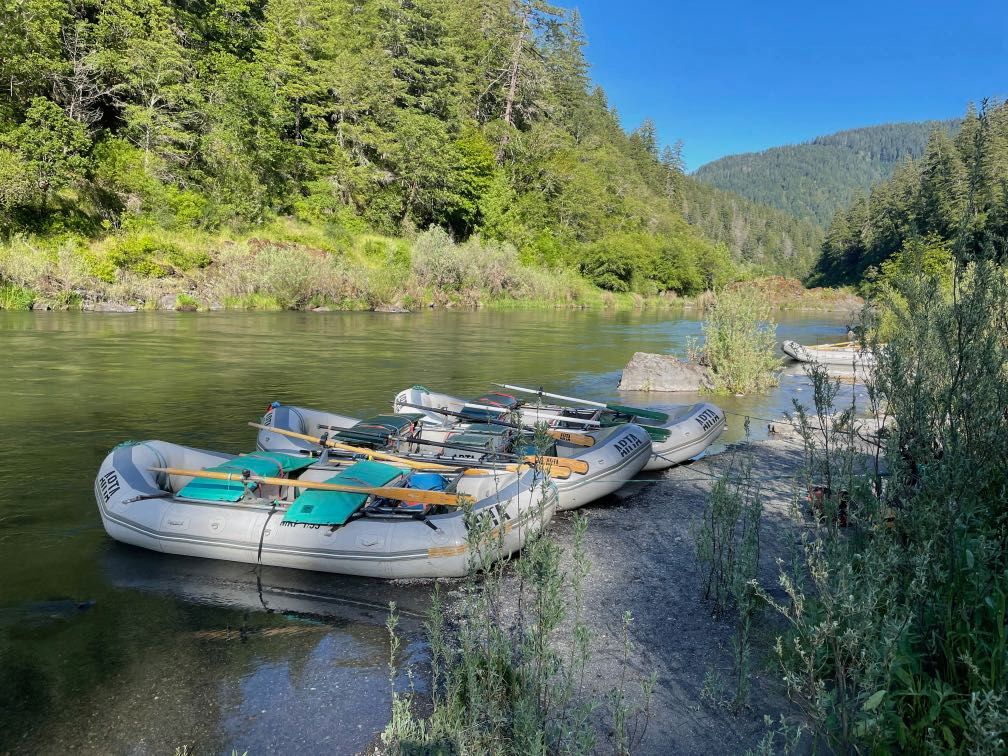 Boats at Missouri Camp
Boats at Missouri Camp
After getting camp set up, Noa talked a bit about the contents of the repair and first aid kits. We arrived early enough to have a bit of downtime after the lesson. I used it to take a quick river bath. I also got some remedial instruction in tying the Trucker’s Hitch from a fellow student.
After a fine curry dinner, we had a conversation about equity and inclusion on the river. There were a lot of good insights on the subject from both the students and the trainers.
We spent the remainder of the evening around the campfire before turning in.
Day 9 — Rogue River, Missouri Camp to Tacoma Camp
After one of my best nights of sleep of the course so far, I was up early again. It was a lovely morning. Another student spotted an osprey catching a fish and pointed it out to me in time to see it flying off with its prize. We had breakfast and got loaded up pretty expeditiously.
Today I was on a 16-foot oar boat with another student. This meant we were running without a trainer in the boat. In the late morning would be running two “final exam” rapids. Mule Creek and Blossom Bar. The other student and I traded off as we did some mild rapids while moving downstream. I felt like I was doing pretty well on the oars.
We pulled over above Mule Creek Canyon. This is a long rapid without any good place to scout, so Aaron and Noa drew it out on the sand. We had four boats and three trainers, so not only would I be rowing this one, I’d be doing it without a trainer in my boat for backup. It was kind of intimidating, to be honest. However, I was confident that the trainers wouldn’t put me in a situation where I’d be in over my head and decided to take this as a vote of confidence in my abilities in the oar boat. With nothing but some notes I took looking at a sand drawing, we pushed off for my first significant solo rapid.
Just above the rapid, I saw my only bear of the trip, a medium-sized black bear sitting up on the bank (other students spotted two more at different points during the trip, but I didn’t lay eyes on either).
The upper part of Mule Creek has some rocks on the right that force you into a sweeping turn that terminates in a wall. I pushed to keep off the bank in the turn, then shifted to pulling to keep off the wall. The second section of the rapid is narrow and twisting with vertical canyon walls. I ran most of it sideways, using my oars to keep off the sides of the canyon. A couple of times, I had to ship my oars and turn the boat to fit through a tighter spot (in both cases, going backward happened to be easier than going forward). This portion of Mule Creek Canyon is reputedly very beautiful, but twists and turns were coming thick and fast enough that I could barely spare a moment to look above the waterline. In the end, I only bumped the wall once.
The next section of the rapid is called the Coffee Pot. It’s even tighter, with lots of confused, boiling currents. There’s no real way to stay off the walls here. I just had to ship my oars most of the time and rely on the current and the fact that I was going down the river in a bouncy house. When I popped out the bottom, I rowed over to the other two boats. Because the rapid is so narrow and you need a sizable amount of separation between the boats, none of the trainers actually saw my run. Later one of them mentioned that I had a big smile on my face when I came out of the rapid, so they figured I must have done OK.
 Blossom Bar Rapid
Blossom Bar Rapid
Shortly below Mule Creek, we stopped at Blossom Bar Rapid to scout. This is a large, complex rapid requiring multiple moves with significant consequences if you mess up. There were a couple of lines through the rapid that we thought would go. Two students decided to drop in on the left and two on the right. Both would try to move over towards the left side once they cleared the first few obstacles in the rapid. Aaron would make the run down with the first boat, then come back and take the OPC through. I swapped over to the OPC to give them an extra paddler.
The first of our boats to drop in on the left side ended up getting stuck on a rock near the top. Since the OPC wasn’t going down until last, we were still up on one of the rocks we had scouted from and had a good view of the situation. It took Aaron and the student a while to get off. No advanced wrap techniques, just shifting weight, deflating tubes and floors, and lots of pulling on the raft. They eventually got it off.
The other left-side boat had a good run. The oar boat going down the right side got bumped off its intended line, going to plan B and staying on the right side rather than going left. The same happened to us in the OPC; only we went even further right, with the student in the back seat taking advantage of a narrow channel that a pure oar boat couldn’t have gotten through. Both boats managed to thread their way down to the bottom of the rapid.
We stopped for a very late lunch not far below Blossom Bar. While we were eating, Aaron untied a couple of rafts. Today, however, most students were wearing their PFDs during lunch. One swam out to a boat that was floating away. I was right behind and debated jumping in, but I figured they had it covered. Instead, I ended up hopping into another boat to help land the initial drifter and discovered it had been untied as well. After a bit of faffing about, I ended up rowing upstream a ways before I was able to get it back to shore successfully.
After lunch, we headed downstream. We had a bunch of flat water to row through. The other students in my boat generously let me plow through all of it (seriously, though, I was glad to, good practice for the flat sections of the canyon.)
Our camp was at Middle Tacoma. There are three big campsites here. Our neighbors in the Upper Tacoma Camp were a big rowing school put on by Northwest Rafting.
We got camp set up pretty expeditiously and had some time before dinner to lounge around. After an excellent fajita dinner, the trainers talked about the process for becoming an assistant guide for ARTA.
Later, while we were sitting around the campfire, a couple of the guides from Northwest came over to say hi. One of them, Daniel, mentioned that he had a birthday that day, so we dished up some pineapple upside-down cake with a candle on it and sang him Happy Birthday (slightly marred by the fact that all of us forgot his name). Later in the evening, after everyone else had gone to bed, another student and I had a good conversation with Aaron about our ambitions and our future as guides.
Day 10 — Rogue River, Tacoma Camp to Foster Bar
The previous night’s discussions of guiding for ARTA prompted a lot of early-morning thinking about the future for me. The morning dawned slightly overcast, the first time we saw anything but bright blue skies on the Rogue. We beat our previous on-river time by about 25 minutes, getting started downstream by 8:50. I was rowing one of the 18-foot boats with a pair of students up front. Today, most of the water was pretty mellow, but there was one decent rapid with a substantial pourover ledge on the right half of the river. I didn’t see it far enough in advance to move left, so I just T-ed up and ran it. Not a problem in a big oar boat, but I did get the students in front pretty wet for that hour of the morning.
 A lovely waterfall
A lovely waterfall
We stopped at a lovely little waterfall where ARTA trips often eat lunch on their last day. We were fast enough packing things up that it was way too early to eat, but we admired the waterfall and got a group picture.
There were still several miles to go before the take out. Neither of the other students were that interested in rowing, especially a flat section like this, so I stayed on the oars the whole way.
At the take out, we parked our boats and started unloading gear, piling it up on the ramp. While we waited for the shuttle service to deliver the truck and van, Aaron talked us through using the SCAT machine to empty the groover. As we did this, I noticed a level of unease among the trainers that our vehicles hadn’t arrived yet.
Eventually, a van from the same shuttle service ARTA uses arrived to pick up passengers from Northwest Rafting. The driver said they didn’t have anyone bringing vehicles to the take out that day. This produced a flurry of activity among the trainers, of course.
After some coordination with the shuttle service and Northwest, the solution they settled on was for the shuttle company drivers to start the two-and-a-half-hour drive to the take out with our vehicles. In the meantime, Aaron and the five students who needed to get out today for flights or to get started on long drives would get a lift on one of the vans the shuttle service had sent for the other rafting company. Noa, Katie, and the remaining students would wait for the trucks, load our gear, and drive back to the guidehouse.
That led to a very hurried set of goodbyes for our group. Kind of sad, given how close we’d all become during these ten days. After some hugs and hurried exchanges of telephone numbers, those that were going hopped in the van and were off.
Those of us still on the ramp had several hours to kill. Noa went over to Daniel at Northwest and said something along the lines of, “I’ve got four guide school students with nothing to do; want any help loading?” He took her up on that very quickly. We ended up helping load a bunch of their rafts.
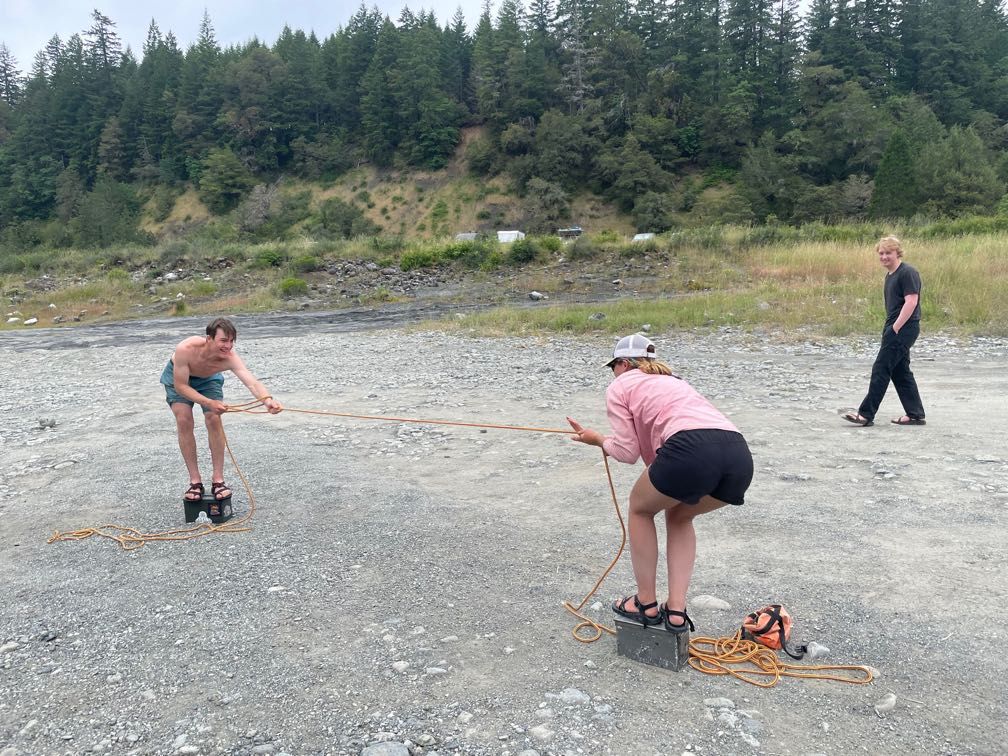 Killing time at takeout waiting for the vehicles
Killing time at takeout waiting for the vehicles
We lounged about on some Paco Pads for a while, then one of the trainers suggested we play Kubb. It was pretty fun, actually.
The vehicles arrived around 3:30 pm, and we got right on loading. With the experience the students had gained on the trip and Noa and Katie in guide mode rather than teaching mode, we crushed it. Everything was on the trucks in about forty minutes.
From there, it was a long drive back to the guidehouse via a very steep and curvy road. The other three students rode in the van, but I hopped in the truck with Katie to give her someone to talk to. We had a great conversation about river guiding and ARTA on the way back.
When we arrived at the guidehouse, we found that Aaron had done us a real solid by having a couple of platters of tacos from a local place waiting for us. After a delicious dinner, we decided to spend about 45 minutes unloading and cleaning whatever we could and then call it quits. In addition to four students and the three trainers, we also had the help of another ARTA guide who was at the guidehouse for a trip leaving in a few days. In that time, we were able to get everything off the truck and finish most of the cleaning and putting away.
After a short break, during which I took a very welcome shower, we reconvened in the living room to watch the movie Sing. There was also ice cream.
Sing was good, but I was pretty worn down by that point. I was asleep almost as soon as I hit the Paco Pad.
After the course
The next morning I was awake early, as usual. I got up and pulled out my laptop to continue working on this course write-up. Most other folks slept in considerably longer. A student made us some nice hash browns with mushrooms for breakfast.
The other students had to clear out by mid-morning. My parents had delayed their Pacific Crest Trail trip by a day, so I didn’t need to pick them up until tomorrow. Having no place to be, I volunteered to help the guide sort through all of the camp chairs, pick the ones to get rid of, and replace them with the new ones that had just arrived for this season.
We finished just after 11 am. I said my goodbyes to Noa, Aaron, and Katie and headed down I-5. After a stop at REI in Medford to pick up some gear I wanted for the swiftwater rescue class and (hopefully) future guide work, I drove to Weed, California to stay the night. I had dinner and some good beer at the Mt Shasta Brewing Company and hit the sack early for once.
Conclusion
This was a fantastic course. It wildly exceeded my expectations. I learned a tremendous amount, made some great friends, and hopefully got a good start on my new career.
The quality of the instruction was very, very high. I’ve got a background in both teaching and taking many courses as a student. Based on that experience, I can say that Noa, Aaron, and Katie have done a great job designing this curriculum. Their teaching skills are top rate. All three excel at explaining concepts and coaching students as they perform these skills. Beyond their individual qualities, they teach very well together, smoothly handing off to each other during lectures and complementing each other’s teaching styles.
We encountered a few unexpected bumps along the way. Both the injured student and the vehicles not arriving when they were supposed to threw a wrench into things. The trainers did a great job responding to both, focusing on safety in the former and getting students on their flights or on the road in the latter. Ultimately I think both ended up being good learning experiences. If nothing else, they prove that things don’t always go to plan when you’re guiding. Being able to roll with the punches and adapt is crucial.
The most significant improvement in my skills that I will take from this course is learning to read water effectively. Coming in, I had learned a little bit by watching the guides on the canyon trip and reading a couple of books on rafting, but my skills were very limited. The trainers did a very effective job of combining practical experience with explanation (especially Noa’s excellent river hydraulics talk on Day 2). They emphasized the constant application of these skills, encouraging students to read their own water rather than just following the lead boat or agreeing with the line through a rapid that someone else proposed. By the end of this course, I feel like I can look at a rapid, pick a line, and figure out if it will go or not.
Knowing where you want the boat to go and getting it there are two very different things. Throughout the course, the trainers emphasized establishing and holding your angle. A good angle and a little bit of power beats lots of power delivered at the wrong angle every time. I feel like I’ve developed a pretty good understanding of what angle I want in many situations. My ability to put that into practice grew as the course went on, but it’s still a work in progress. For the most part, I’m still reacting to getting bumped off my angle and correcting it rather than anticipating and preventing it. It’s a lifelong learning process.
The other big skill I think progressed tremendously in this class was my decision-making ability. Like many of the students, early on, I tended to overthink and not solidly commit. Running the Methodist Creek portion of the Cal Salmon on Day 3 was hugely helpful in that regard, and while it’s something I’m still working on, I feel like I progressed a lot during the course.
Of course, things don’t always go according to plan. That’s definitely something I was not good at dealing with at the start of the course. For instance, when I was on my canyon trip back in April, the guides let me run a few minor rapids. When things did not go to plan in one of them, it turned the entire rest of the rapid into a series of “oh shit!” moments. Now I’m a lot more comfortable when I have to go to Plan B (or Plan C, or Plan D…). Rather than “oh shit,” it’s more “We’re going to go over this obstacle instead of around it,” or “We’re running this next bit backward.”
I was very comfortable in the oar boats during this class. Frankly, when it came to pushing or pulling on the oars, I was surprised by how minor the refinements that the trainers suggested were. I guess I did a pretty good job learning in the canyon. Where the improvement on the oars really came wasn’t the physical part but integrating that with the understanding of how to read water, hold the correct angle, and make decisions that I learned in this course. In the canyon, I’d often take a stroke, not get the result I intended, and not know why. After this course, I’m much more likely to get the boat to do what I intended and when I don’t, I understand why and what I need to do to correct it.
On the flip side, I came into the course without any paddle raft experience, even as a paddler, much less a paddle captain (the Grand Canyon trip was all oar boats). I was a bit concerned about the prospect of coordinating a team of rowers. After this experience, I’m pretty confident in my ability to give commands and get a paddle raft where I want it to go.
While I’ve been giving a lot of attention to the boating side of things, I don’t want to give short shrift to all of the other guiding skills we learned in this course. Things like setting up camp, cooking meals, and rigging and derigging boats. How to load up all the gear for a trip and unload and clean everything when you’re done. The trainers emphasized the importance of these skills to a guiding career.
Aside from all stuff they taught us, once the training day was done, Noa, Aaron, and Katie were just great people to be around. Around the campfire, Noa sang songs that she had written. Aaron stayed up late telling lengthy and elaborate jokes. Katie’s warring love of ice cream and movie references became legend.
I have spent much time lavishing praise on the trainers; I need to do the same to my fellow students. Every one of them contributed an enormous amount to the class, and I learned from all of them. One example among many: On Day 8, I knew I needed some remedial instruction on the Trucker’s Hitch to rig a boat the next morning (we use it to tie down bags in the back of the boat). Rather than asking the instructors for help, I asked them to recommend a student who could help me out, knowing that we had other folks in the class who knew the knot and would be willing and able to help get me up to speed. The student they pointed me towards did a great job, and I was able to rig the boat the next morning without any problems.
That said, my appreciation for the other students goes far beyond what I learned from them. We developed some very close bonds in a short amount of time. I am tremendously sad that I may not see some of these people again, and we almost certainly won’t all be together at the same time.
Gear lessons learned
- Close-toed shoes really are important for this class, particularly the first five days on the Klamath and Cal Salmon. I was glad I had the NRS boots; they worked well aside from being a pain to get on or off. I wore my Bedrock sandals on the Rogue the last four days, and they worked OK there. The Astral water shoes that the trainers were wearing during the class look like a good alternative. I’ve got a pair on order.
- The gear list for the class doesn’t explicitly say you can use your own PFD, but about half the class did. I would highly recommend it. As mentioned above, the ARTA loaner PFD rubbed one student’s neck terribly. A good Type III PFD or rescue vest will probably be much more comfortable.
- I liked having the Paco Pad to sleep on, especially sleeping outside on the Rouge trip. ARTA uses them to cover coolers and gear boxes, so there may be a few up for grabs on the Rogue, but probably not enough for everyone. If you have your own, it would be good to bring it.
- All that said, my biggest gear lesson is not to bring too much stuff. I had difficulty laying my hands on specific things I needed from the big dry bag and didn’t use half of it. I need to figure out what subset of this stuff is essential.
This course was a tremendous experience, definitely in the “life-changing” category (I seem to be having a lot of these lately). If you’re at all interested in river guiding or organizing private river trips, I would highly recommend it.
Rafting the Grand Canyon — April 2022
In early February, my parents told me about an opportunity to do a Grand Canyon raft trip together in April. I’ve done plenty of hiking in the canyon but never a river trip. While this trip would totally deplete my accumulated vacation days, I decided to go for it.
This was a trip organized by the Grand Canyon Field Institute and conducted by Grand Canyon Explorations/Expeditions (CanX). April provides some of the best weather for taking side hikes from the river. The trip would be eighteen days, which is on the long side for a full river trip, affording plenty of time for hiking along the way.
Gear
CanX sent a detailed gear list, which I supplemented with some of the gear I usually carry backpacking. While I have plenty of experience hiking and living outdoors, this was a new ballgame in some ways. My backpacking trips are generally much shorter than eighteen days, so I didn’t have a sense of how many consumables I needed, like soap, chargers for my phone, and spare camera batteries.
On the other hand, because I wouldn’t be carrying all my gear the whole time, weight was not nearly as important. However, volume was a factor since everything would have to fit into a pair of dry bags. One big blue bag would carry all of my stuff needed in camp and overnight (spare clothes, etc.). A smaller purple dry bag would be with us in the raft and had to fit everything we’d need during the day.
One of the more difficult decisions was what sort of camera gear I wanted to bring. On recent backpacks, I’d been getting by with just my iPhone. However, in addition to its limited zoom capabilities, I was also concerned about bringing enough external USB battery packs to keep it charged the whole trip. I considered buying a waterproof point-and-shoot camera, but in the end, I opted against it. Instead, I brought the Canon EOS M200 mirrorless I’d bought the year before for my video conferencing setup.
I bought a pair of extra batteries for the Canon. I brought two external batteries to keep my iPhone charged: one 26800 mAh and the other 6000 mAh. I hoped that with the combination of airplane mode, low power mode, and turning the phone off at night, I’d be able to make it through the trip.
Before the river
My flight to Las Vegas was scheduled to leave at 8:35 PM. When I got to the airport, I found it had been delayed about 30 minutes. We were all boarded, pushed back from the gate, and were taxiing to the runway before we taxied right back to the gate. A couple of police officers came onto the plane and escorted a passenger off. This, plus topping off the fuel tanks, left us more than an hour behind schedule.
Upon arriving in Las Vegas, we had to sit on the tarmac for another fifteen minutes waiting for a gate to open up. I grabbed my checked luggage and hopped in a taxi to my hotel. I got to my room at 11:45 PM Las Vegas time, 1:45 AM Central. Before bed, I texted my parents, asking them to pick me up an hour later than we’d planned the next morning.
Despite the extra hour, I only managed about six hours of sound sleep before my jet-lagged brain woke me up. After an hour of tossing and turning, I just went ahead and got up.
My parents picked me up and we headed to Flagstaff. Despite the later start, we still had a little time to visit with my uncle in Flag before heading over to the hotel for an orientation meeting that evening. The orientation covered a lot of logistics for getting everyone on the bus the next morning and a bit about gear. More detailed info about life on the river would wait until we got to the put-in at Lee’s Ferry the next day. They handed out the blue and purple dry bags, and we headed off to our rooms to try to cram everything in.
I did have to make some choices about what to take, but I still packed more and a greater variety of stuff than I’d take backpacking.
Day 1
I got a decent night’s sleep, but the alarm came pretty early. We made short work of finishing packing. My Dad went to McDonald’s to pick us up some breakfast while Mom and I carried our bags down to wait for the bus.
We boarded at about 6:30 AM and started the drive to Lee’s Ferry. There was a stop at Cameron Trading Post for a bathroom break and (for some folks) souvenir shopping.
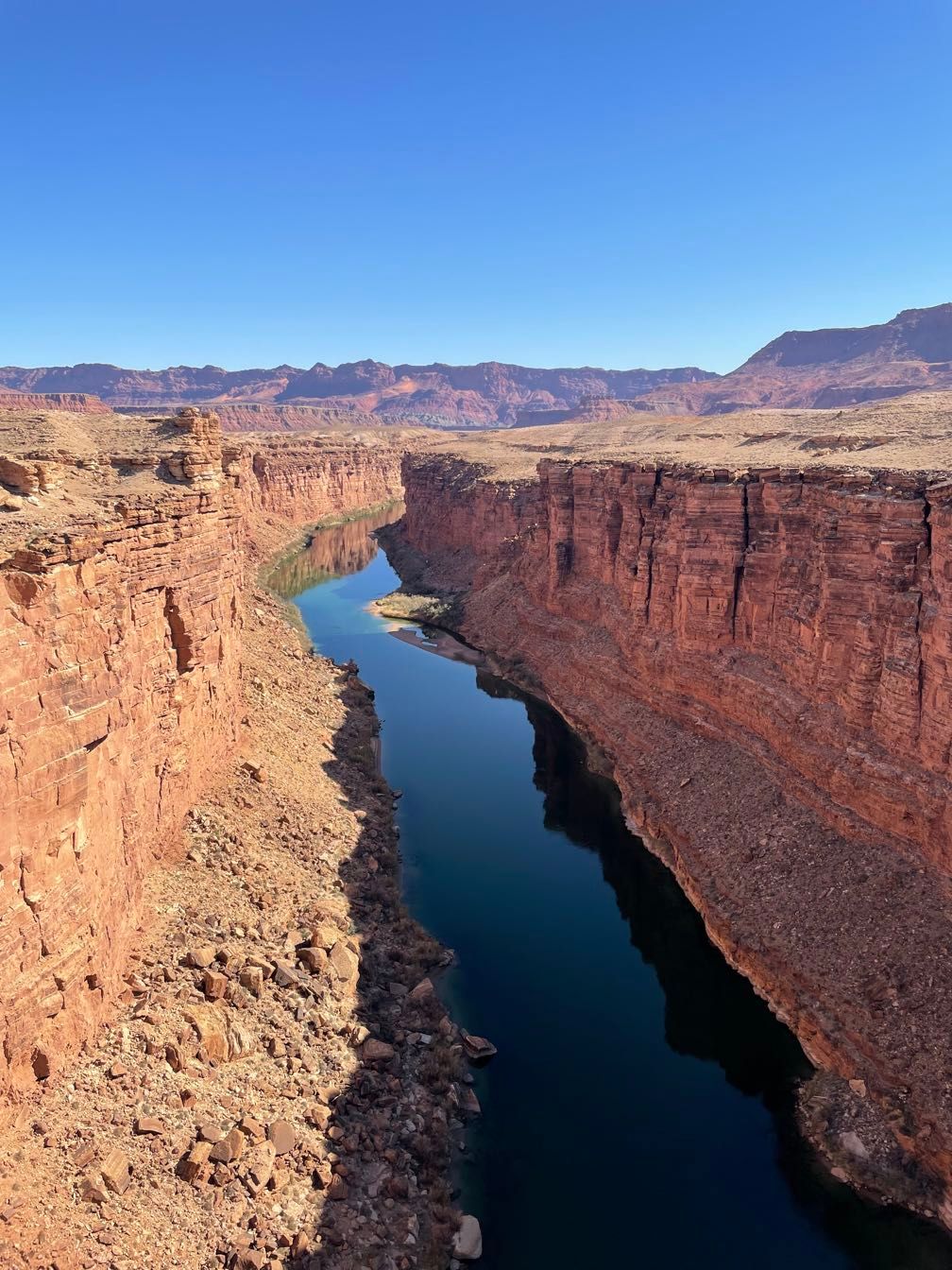 The Colorado River from Navajo Bridge
The Colorado River from Navajo Bridge
After another stop at the Navajo Bridge over the Colorado River, we arrived at Lee’s Ferry around 9:30 and met our guides.
Our trip leader was Gary, who’s been guiding in the canyon since the ’70s. The other guides were Dave, Amy, and Leo. Sequoyah was rowing our baggage boat. She’d been down the canyon several times before, but this was the first one where she’d be rowing her own boat. In addition to the river guides, we had two other people along. Sherri works for the Grand Canyon Field Institute and will be lending the trip her expertise on the Native American inhabitants of the canyon. Gary’s wife, Elise, was also along as an assistant. She’s a professor at a university in Australia.
 Gary and Dave at Lee’s Ferry
Gary and Dave at Lee’s Ferry
We did a brief orientation and fitted our life preservers before rowing across the river. There, we took a short walk up on the bluff above Lee’s Ferry, where we saw a very long petrified wood log. The guides did a bit of orientation on how our hiking trips would go, and Gary talked about the geology of the Lee’s Ferry area.
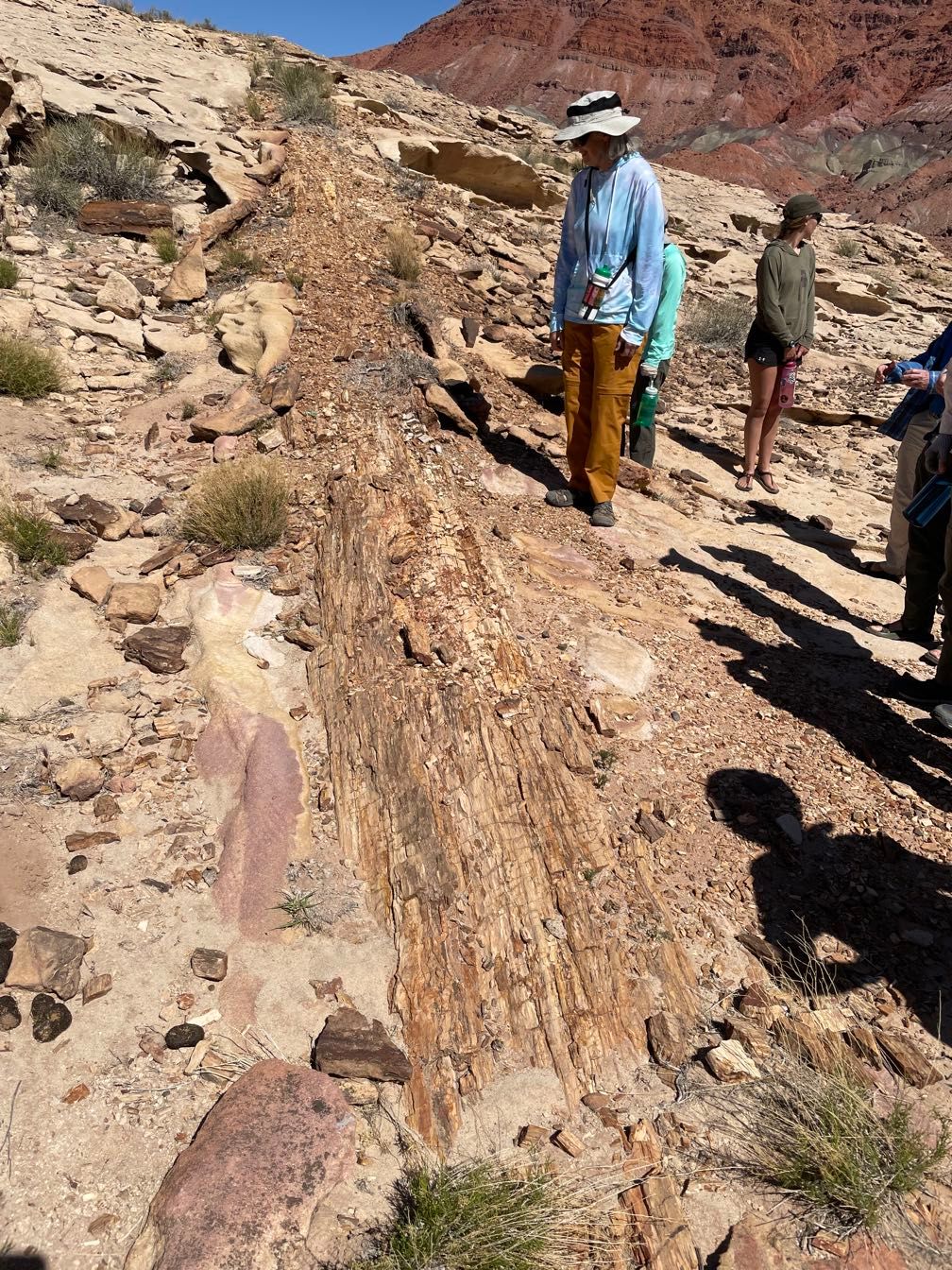 Massive petrified wood log
Massive petrified wood log
With that, we got on the river. My parents and I started the trip riding with Dave, but we’d rotate among the guides’ boats each day. There were a few minor riffles just downstream, placed there as if to accommodate river trips by providing some low-impact whitewater right at the start.
Just after noon, we stopped for lunch. After getting back on the river, we tied the five rafts together, and Dave gave the water safety lecture. We drifted under the Navajo Bridges, giving me a look at them from the underside for the first time.
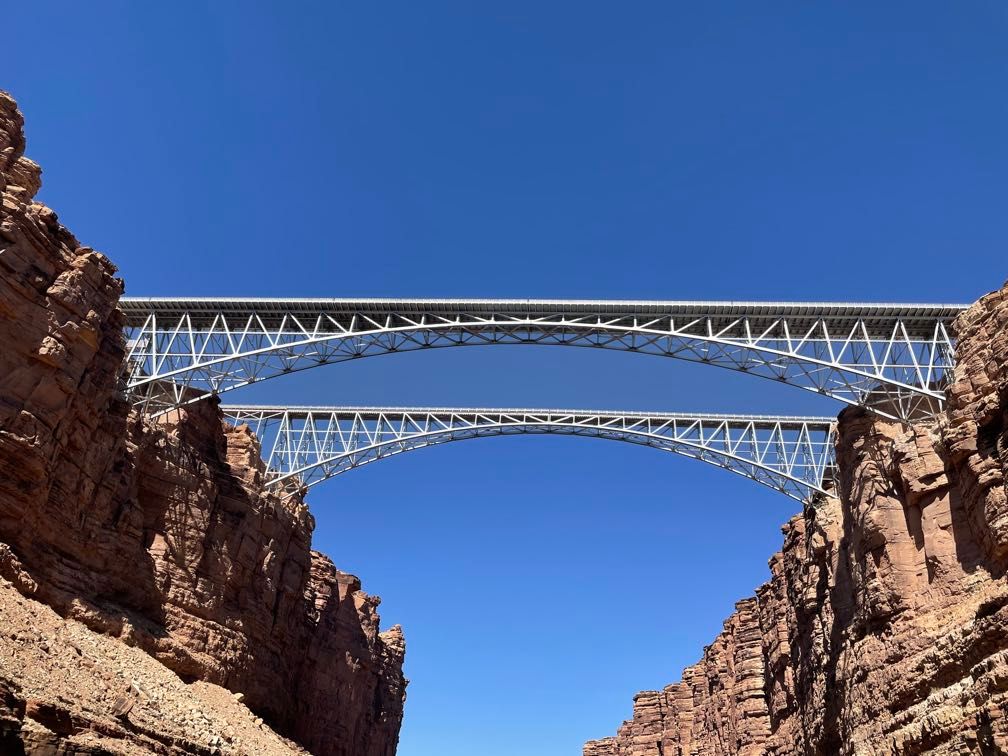 The two Navajo bridges from the river
The two Navajo bridges from the river
Shortly after that, we ran our first rapids — Badger Creek and Soap Creek. We also saw the first of many bighorn sheep. We pulled off to camp shortly downstream of an inscription commemorating Frank Brown, a railroad executive who drowned during an expedition surveying the Grand Canyon for a potential rail route.
The first order of business in camp is to get the rafts unloaded. This is very much under the principle of “many hands make light work,” with everyone pitching in to get all the necessary items (tables, food, tents, everyone’s bags, etc.) off the boats and on the beach.
After we got the tents set up, we had an orientation to the toilet setup, known as the “Groover.” Rafting trips are required to carry out all of their solid waste, so we have to do all of our pooping in a big metal box (actually an ammo can) with a toilet seat on it. Before the addition of the toilet seat, river rafters had to sit directly on the box, which tended to produce grooves in their posteriors, hence “groover.” Liquid waste, on the other hand, can go straight into the river.
We had a hearty ravioli dinner. Afterward, around the campfire, Gary talked about the Brown-Stanton expedition (on which Brown drowned). The expedition took pictures facing upstream and downstream at every bend in the river to see if it would be possible to locate a rail line along it. Gary was involved in some research trips where they recreated these photos over a century later to see how the river had changed over that time.
Day 2
Life on the river starts nice and early, about 5:30 AM. I spent some time reorganizing my gear since it was clear that the amount of stuff I had crammed into my purple day bag wasn’t doing me any favors.
After breakfast, Sherri led us in some “chair yoga,” doing stretches to help us loosen up after sleeping on the ground all night and sitting on the rafts all day. For me, at least, this was very welcome. We did it almost every morning during the trip.
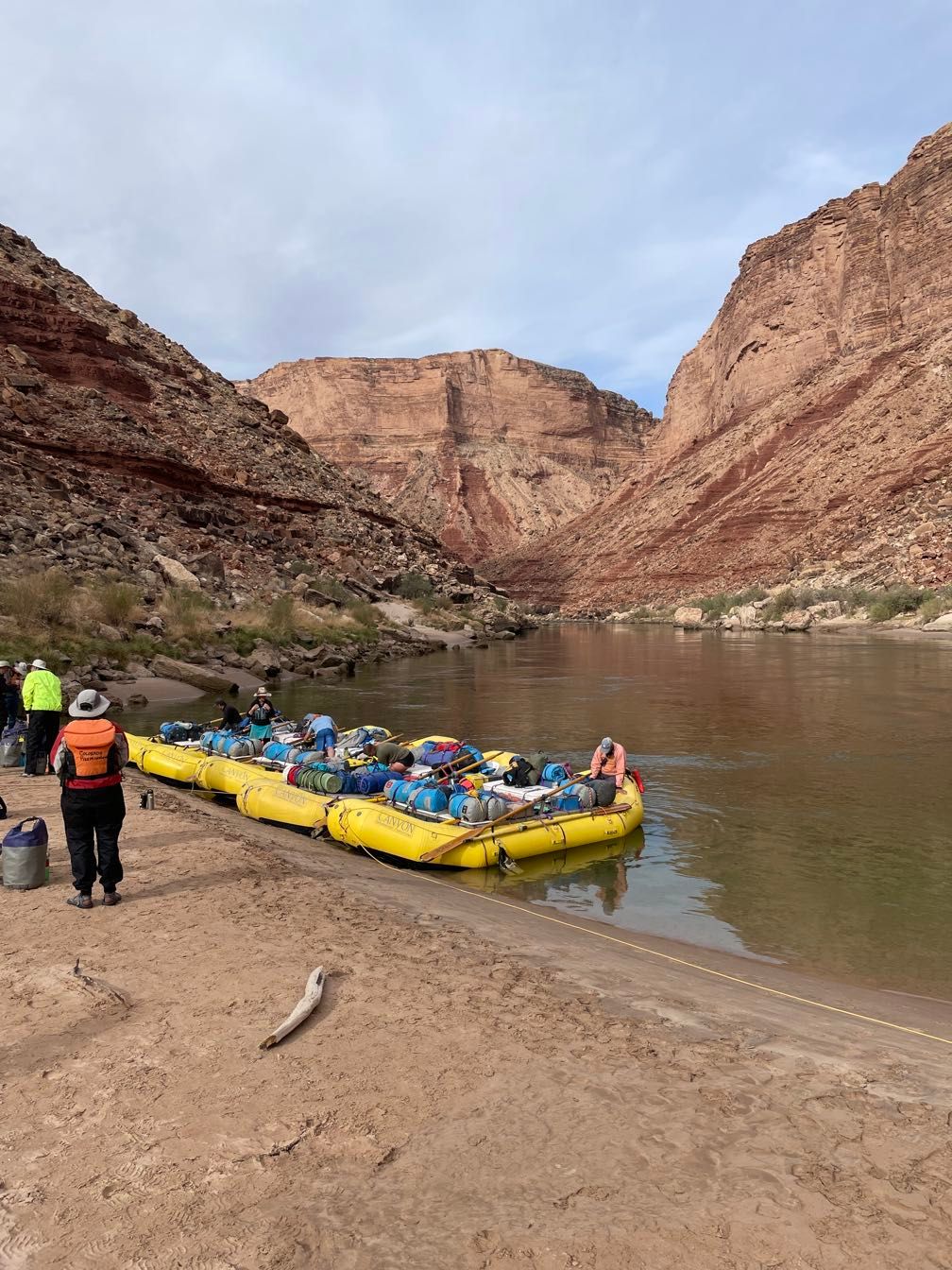 Rafts at our first camp
Rafts at our first camp
We got camp packed up and everything loaded on the boats by about 8:30, which would turn out to be pretty typical. My parents and I were riding with Leo. We saw a bighorn ewe with three cute little lambs.
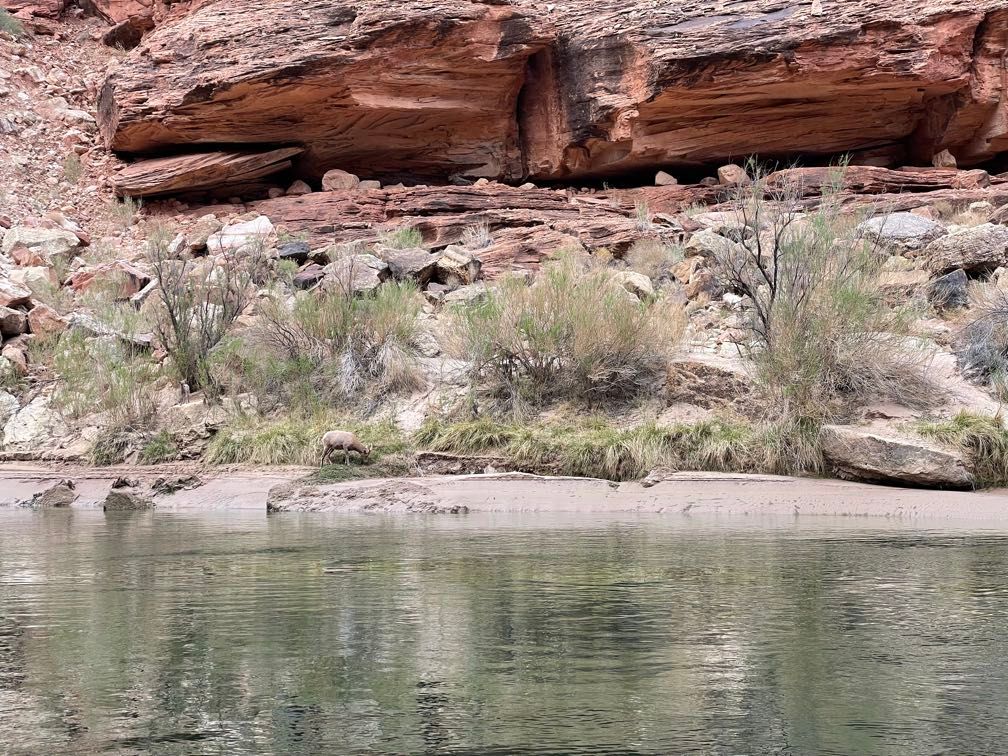 Bighorn sheep
Bighorn sheep
Very breifly we stopped at an inscription made by the 1923 Birdseye Expedition, which was surveying the canyon for potential dam sites.
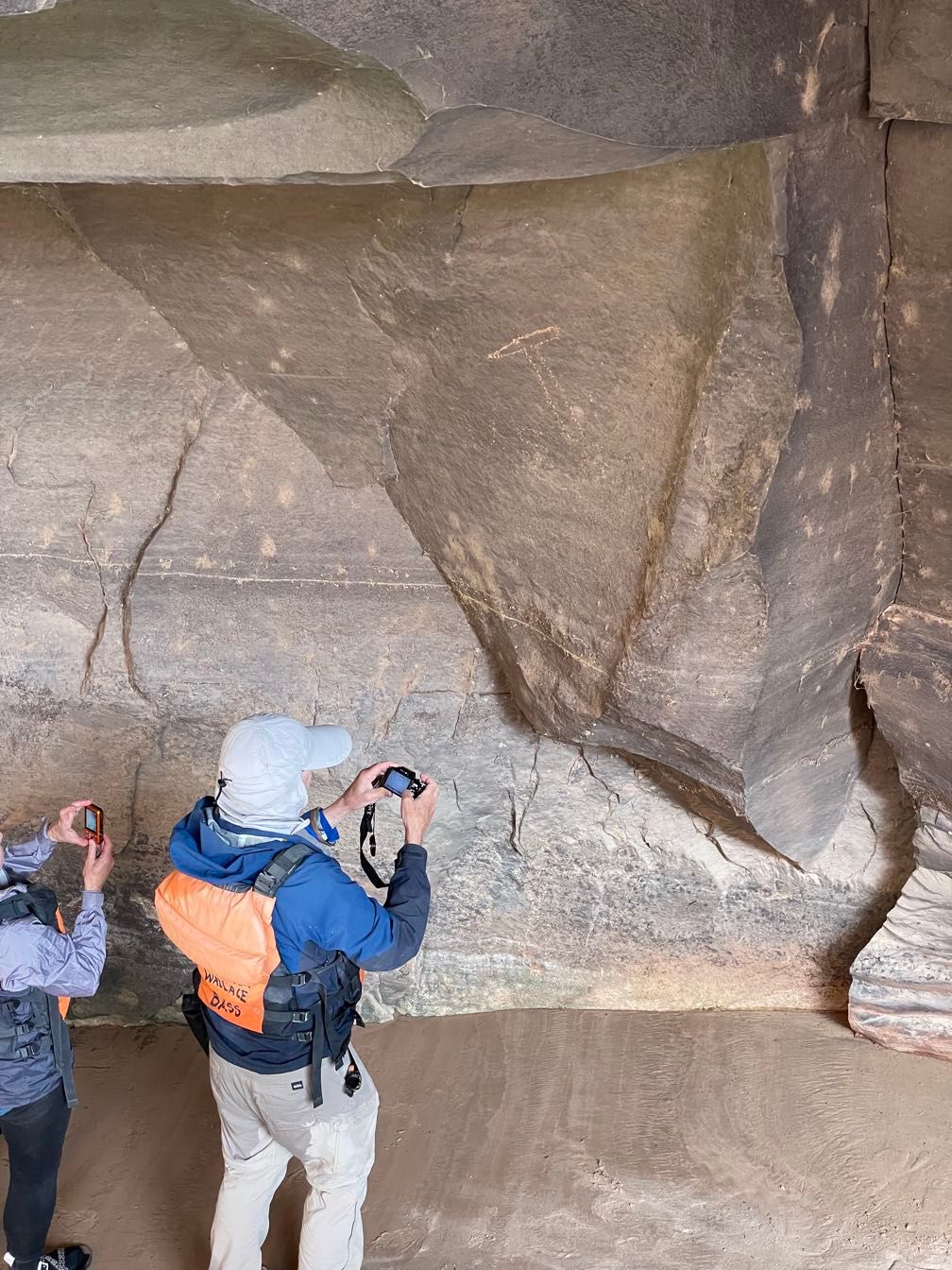 Inscription from the 1923 Birdseye Expidition
Inscription from the 1923 Birdseye Expidition
We ran a couple of minor rapids before coming to House Rock Rapid. This was the first rapid we stopped for the guides to scout it ahead of time, rather than just rafting right in. It definitely provided the most exciting ride so far (and the wettest) when we ran it.
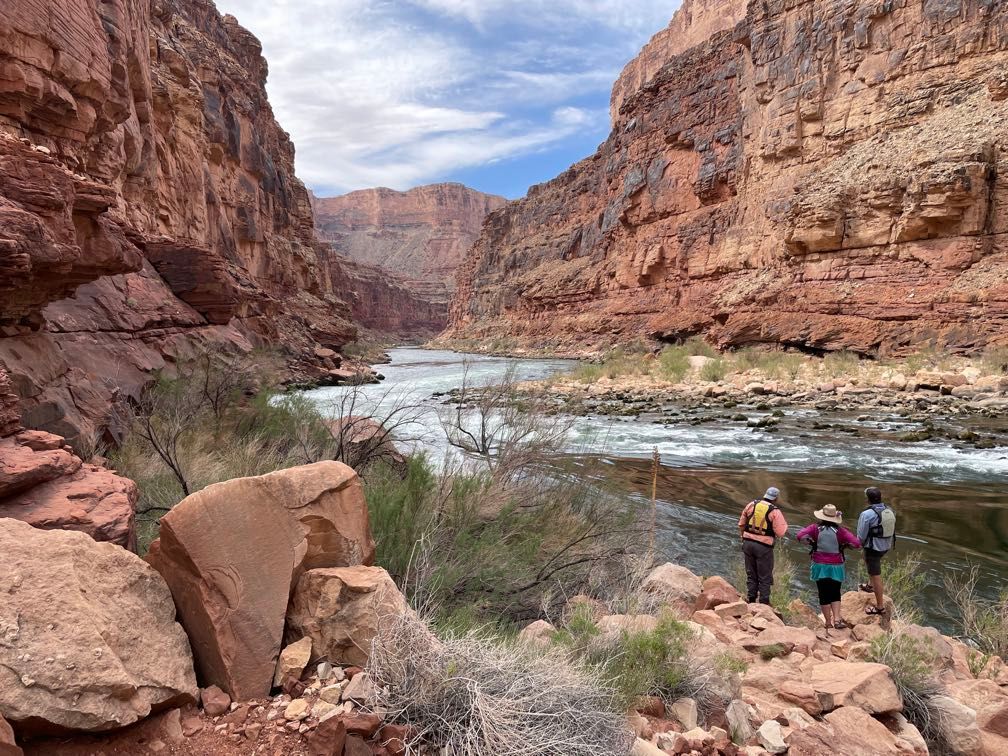 Scouting House Rock Rapid
Scouting House Rock Rapid
There was one more minor rapid; from there, it was flat for a pretty good stretch. Leo even let me row the boat for a bit.
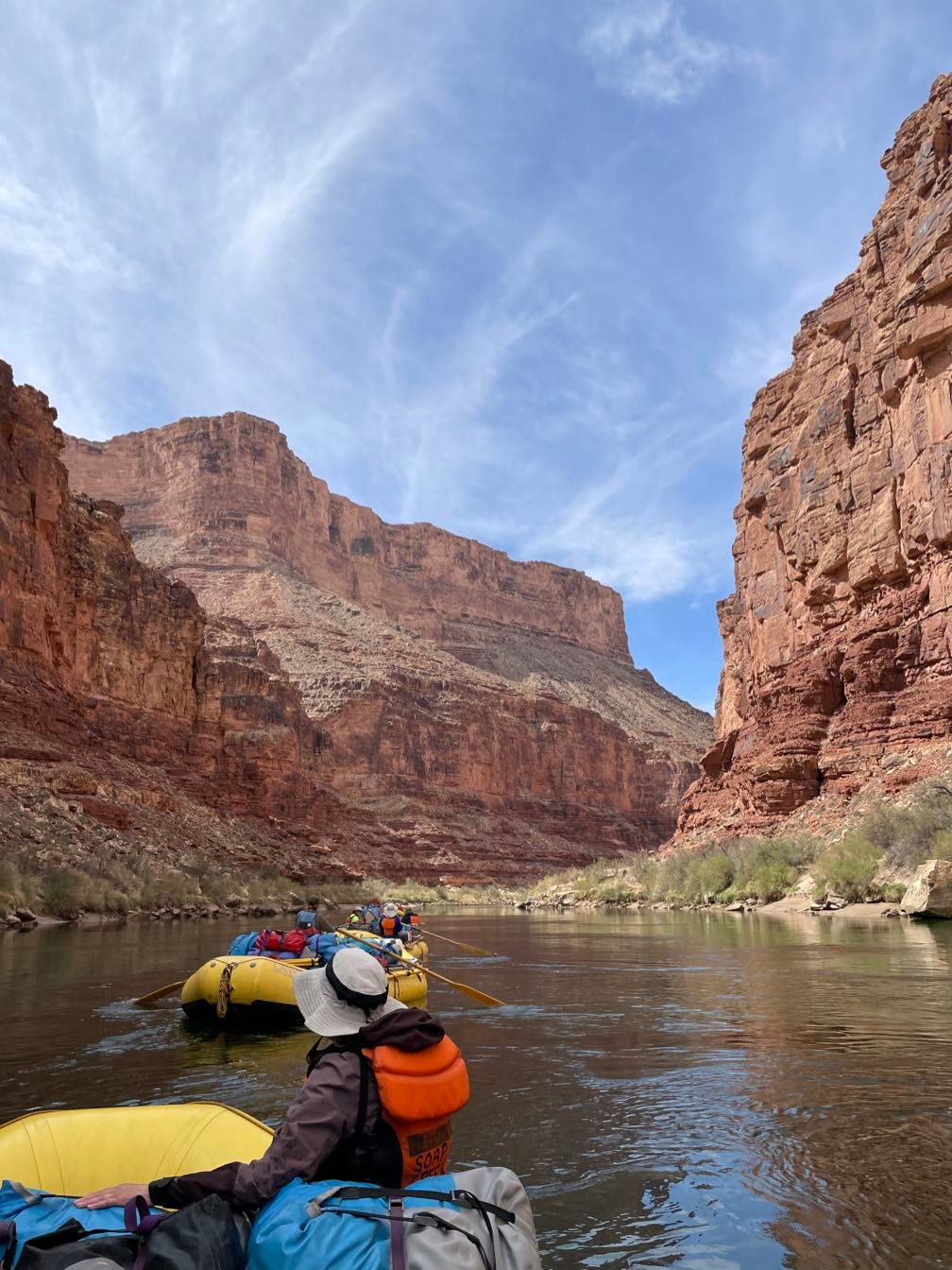 Rafting downriver
Rafting downriver
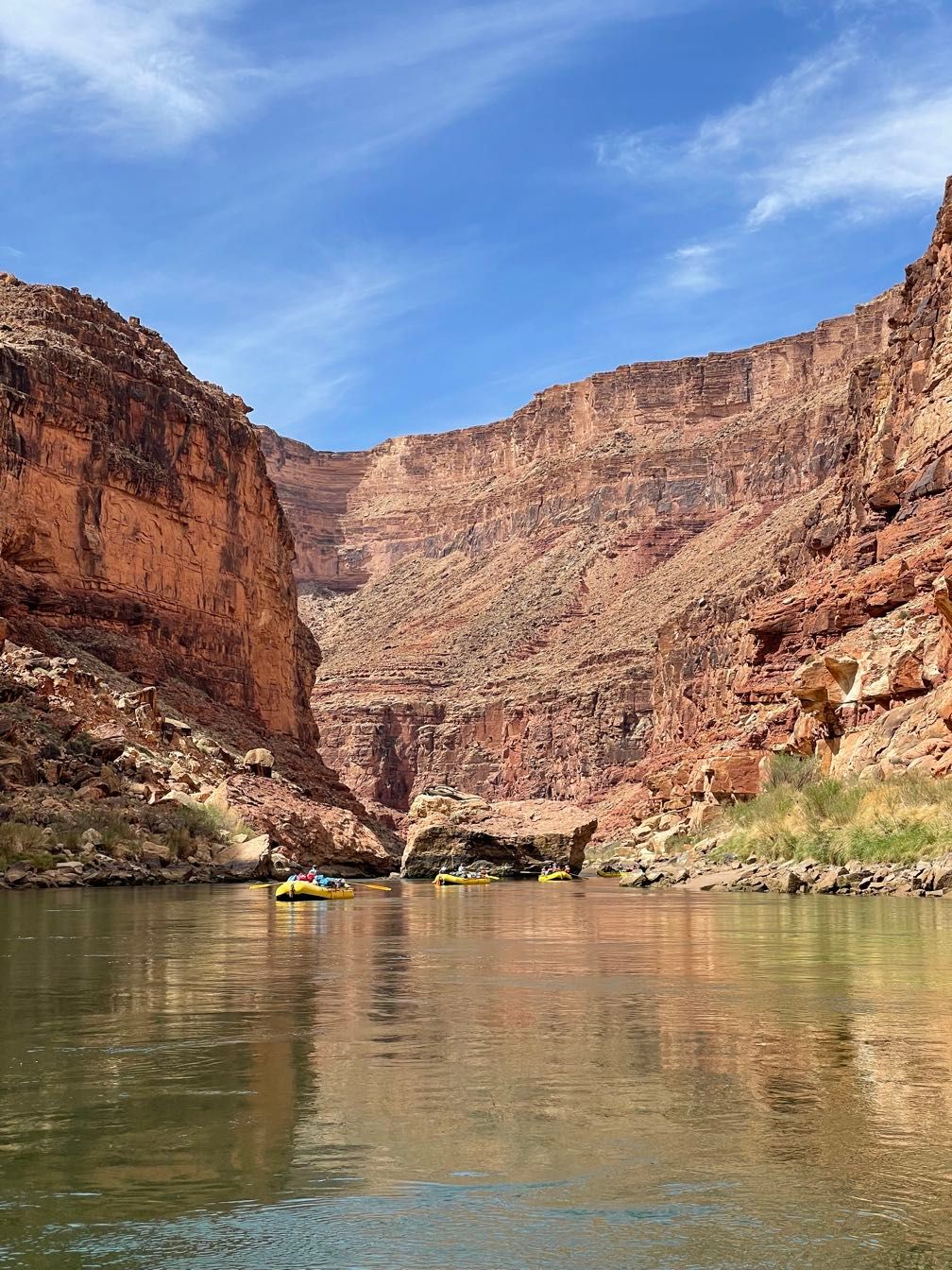 Boulder Narrows
Boulder Narrows
At North Canyon, we had lunch and took a short hike up through the Supai Formation. It ended at a nice pool, just before a short pour-off.
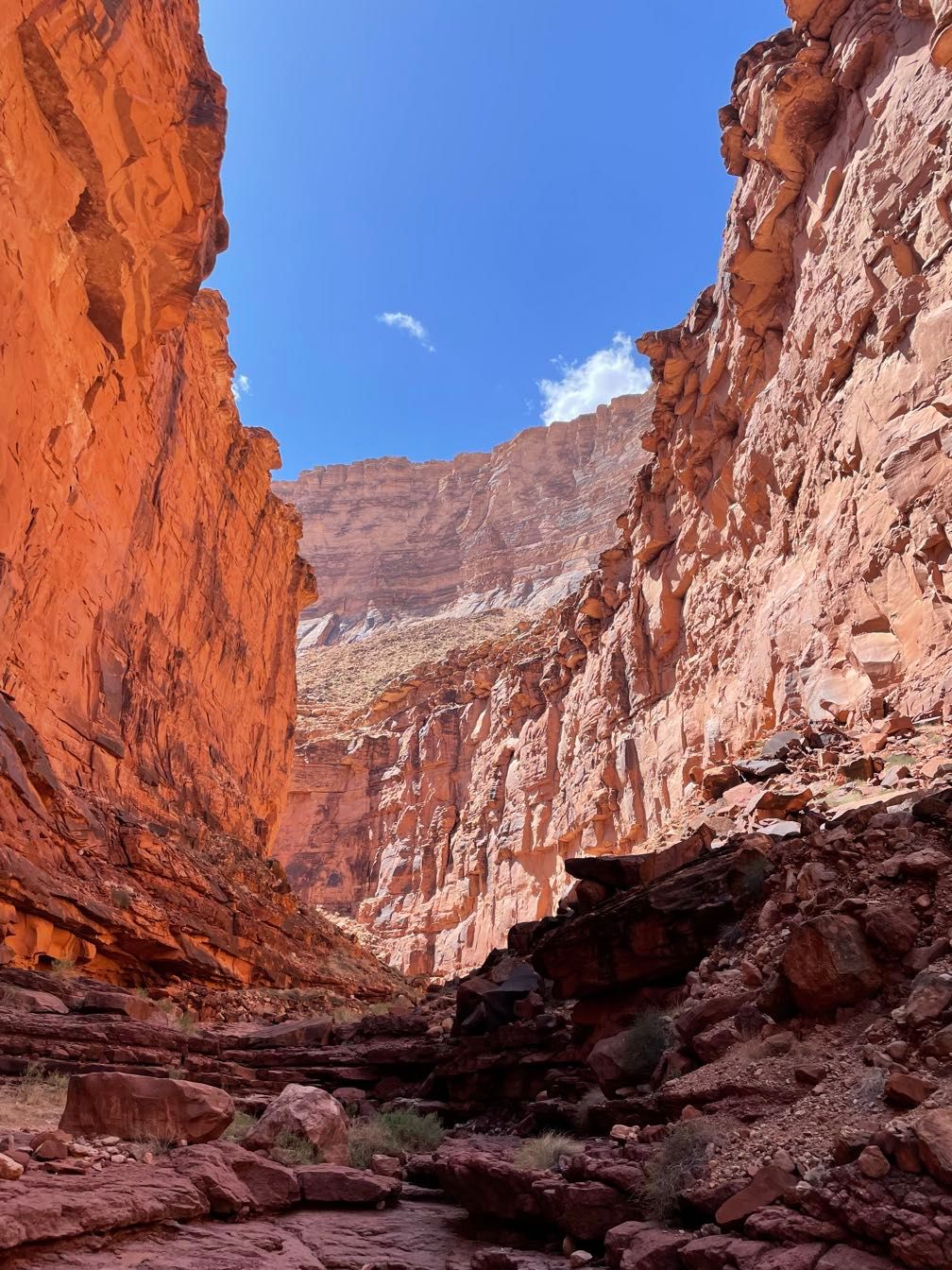 Looking up North Canyon
Looking up North Canyon
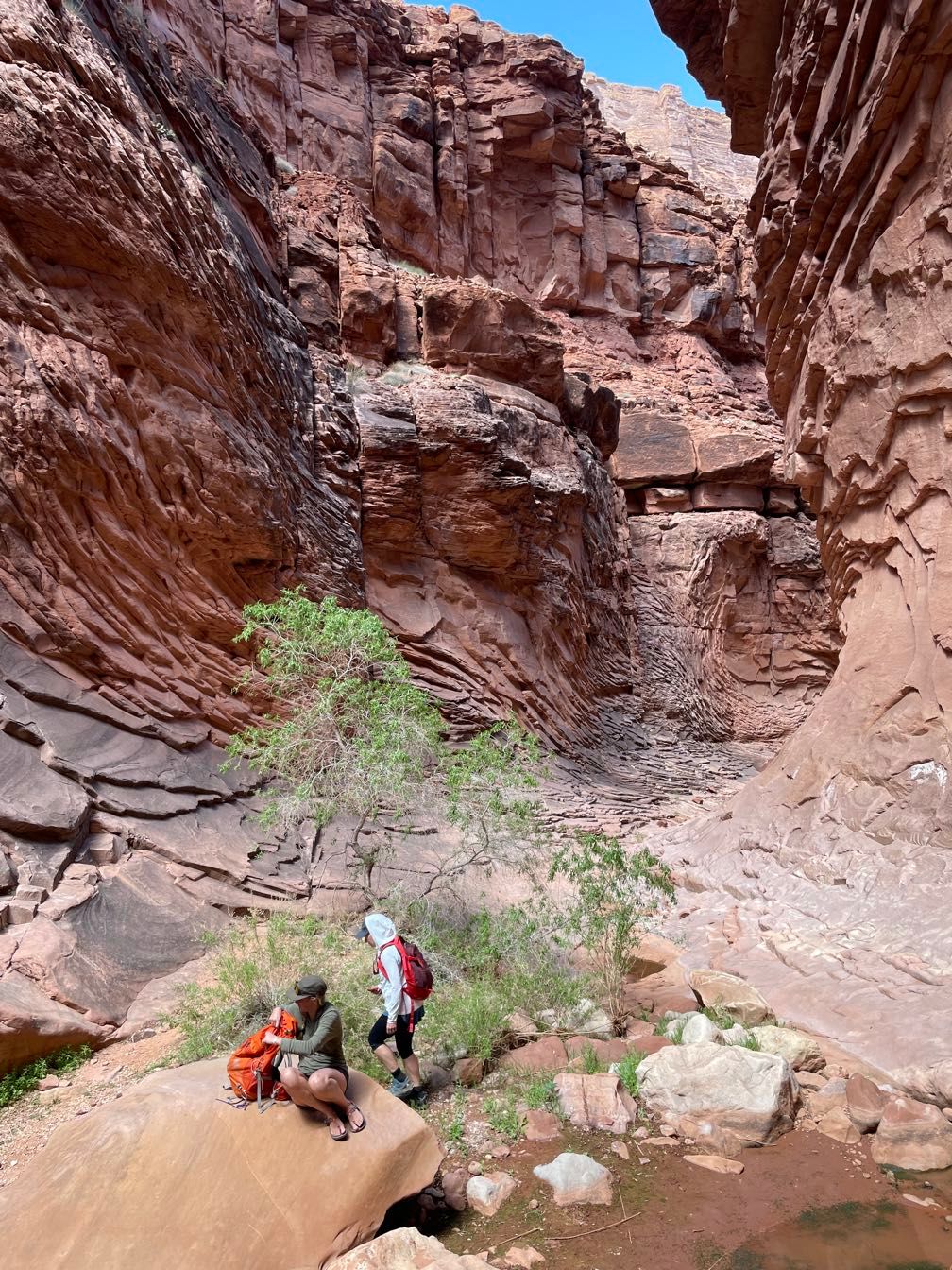 North Canyon
North Canyon
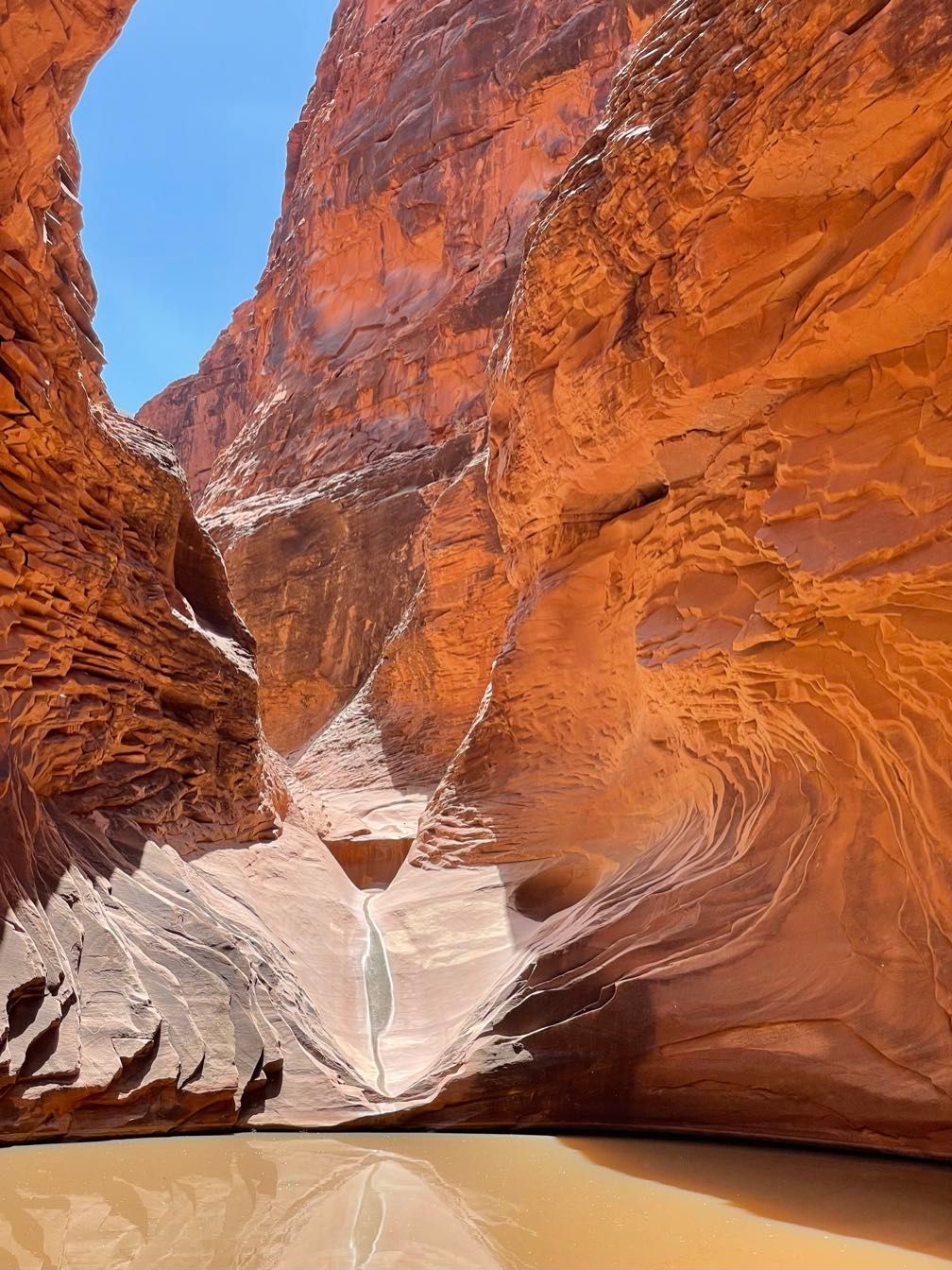 Pool in North Canyon
Pool in North Canyon
After the hike, we got back on the river and ran the first two rapids of what’s known as the Roaring Twenties (North Canyon Rapid and 21 Mile Rapid). These are a series of 11 rapids between Mile 20 and Mile 29, some at intervals as short as half a mile. We only did those first two today; the rest would have to wait until tomorrow.
 A motor rig approaching 21 Mile Rapid
A motor rig approaching 21 Mile Rapid
We pulled off to camp on a narrow beach with a big dune behind. After getting camp set up, we were sitting around when a massive wind blew up, scouring us with sand. Little did we know this would be only the first of many.
Dinner was a delightful combination of salmon, potatoes, and bok choi. Afterward, Sherri talked to us about the native peoples of the canyon.
Day 3
 Taking pictures on the beach
Taking pictures on the beach
This morning, I was a bit more efficient, getting my gear packed up before breakfast. Today, my parents and I rode with our trip leader, Gary. We ran through the rest of the Roaring Twenties in one go before lunchtime.
 Gary rowing the boat
Gary rowing the boat
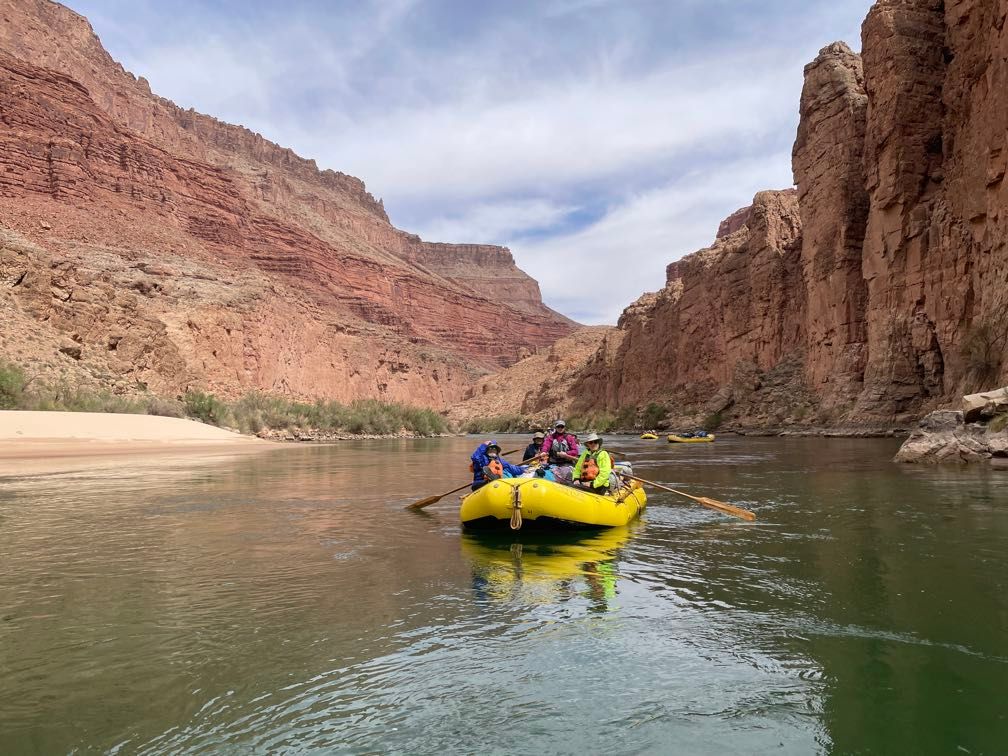 Amy’s boat behind us
Amy’s boat behind us
Around noon we stopped at a beach below some Ancestral Puebloan Ruins and took a walk up to the archeological site. We saw a couple of dwellings (walls about thigh high) and lots of pot shards. Sherri did a great job talking about the site for us, including showing us some chert that had been used to flake stone tools.
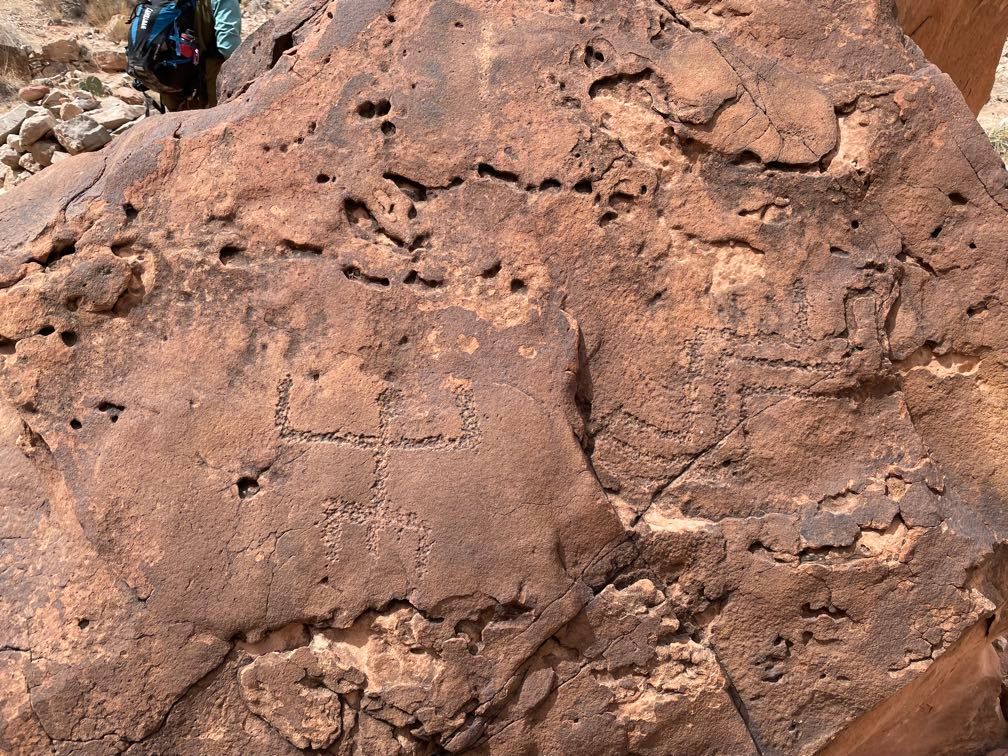 Petroglyphs
Petroglyphs
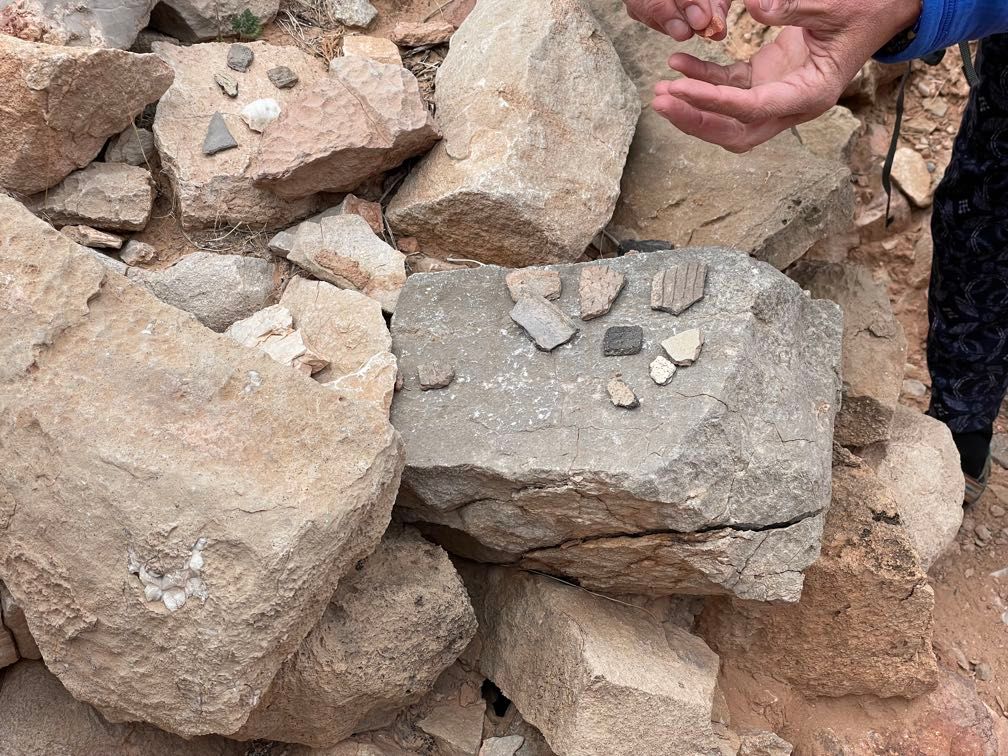 Potshards
Potshards
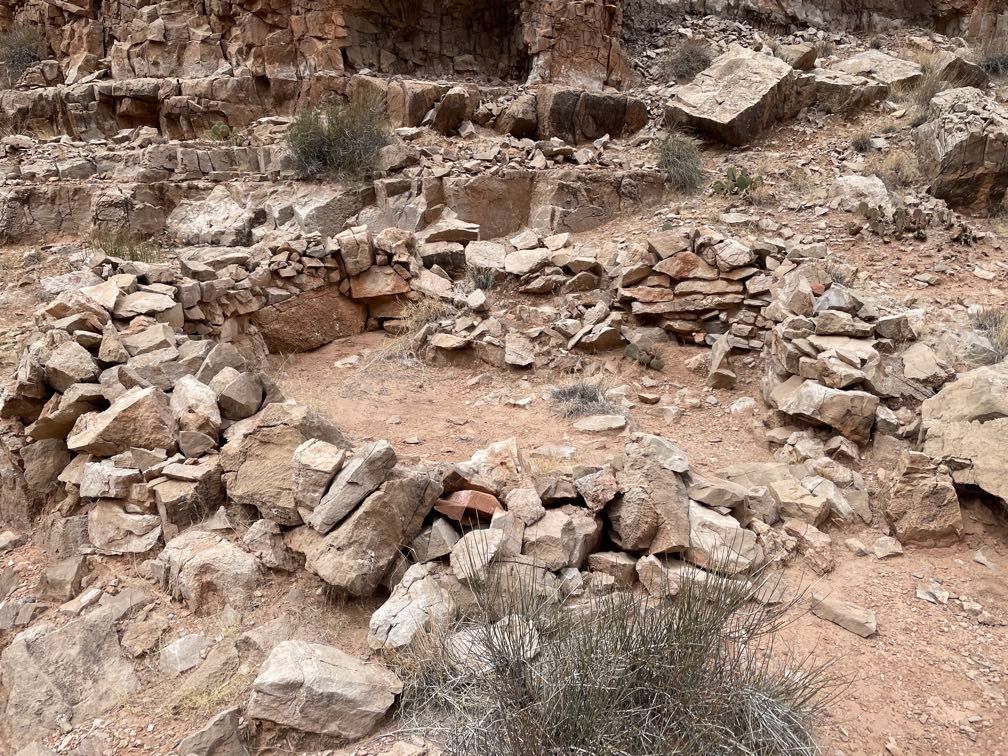 Dwelling
Dwelling
We ate lunch down on the beach. Heading downstream, we floated by Stanton’s Cave, where researchers found many split twig figurines dating back thousands of years.
 Stanton’s Cave
Stanton’s Cave
Shortly after came Vasey’s Paradise, a spring flowing out of the canyon wall, giving rise to a spectacular array of greenery growing right out of the rock. Right now, the water was just trickling out, but Gary said when it’s wetter, it spurts out a couple of holes.
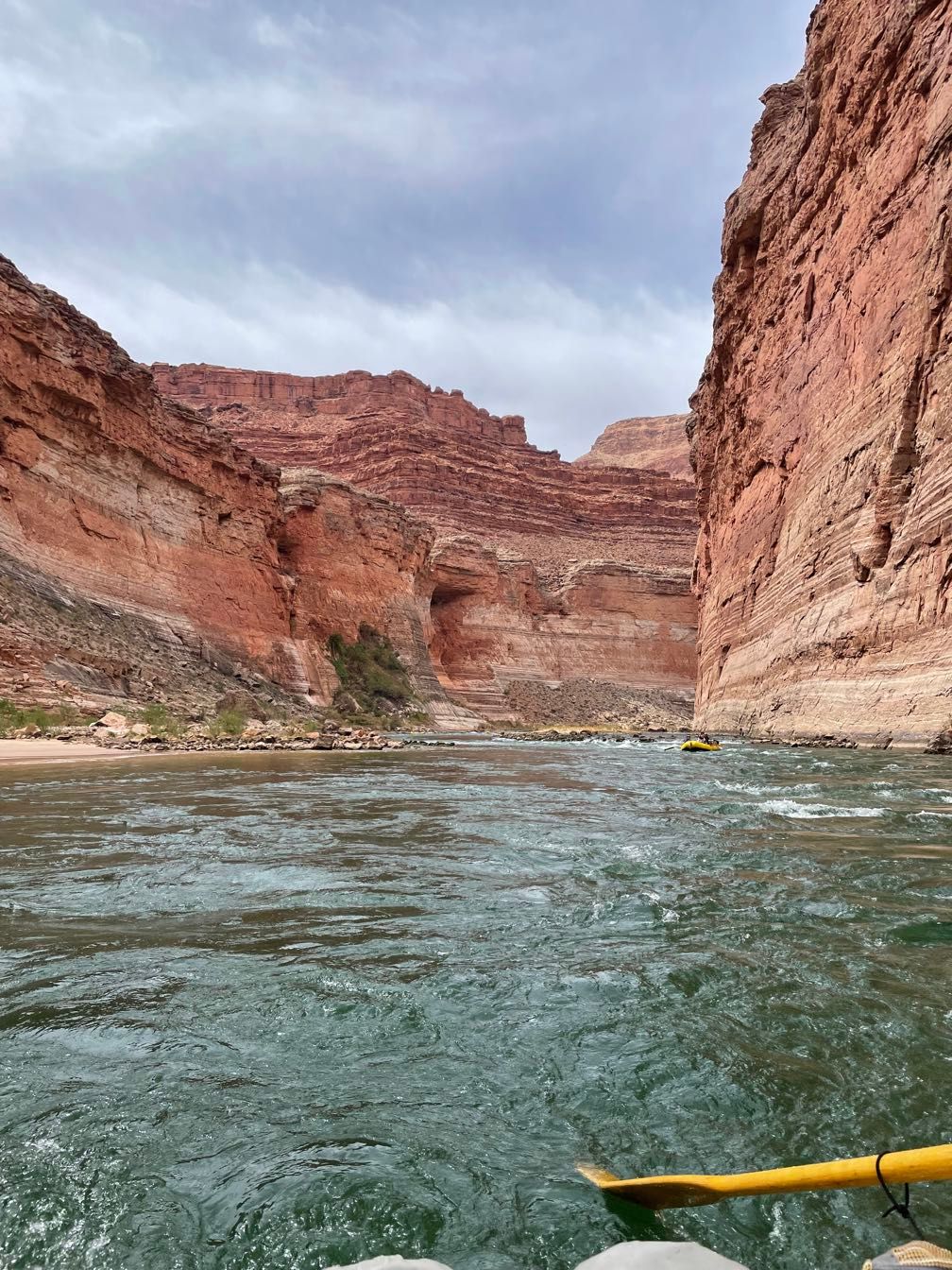 The big patch of greenery on the canyon wall is Vasey’s Paradise
The big patch of greenery on the canyon wall is Vasey’s Paradise
Redwall Cavern is a huge alcove cut into the base of the cliff face next to the river. In addition to the impressive cave itself, we also saw some neat fossils there.
 Redwall Cavern
Redwall Cavern
 Inside Redwall Cavern
Inside Redwall Cavern
 Fossils at Redwall Cavern
Fossils at Redwall Cavern
Heading downriver, we passed a place where an enormous monsoon runoff event last year had killed one member of a rafting party and injured several others. Gary knew the guides involved.
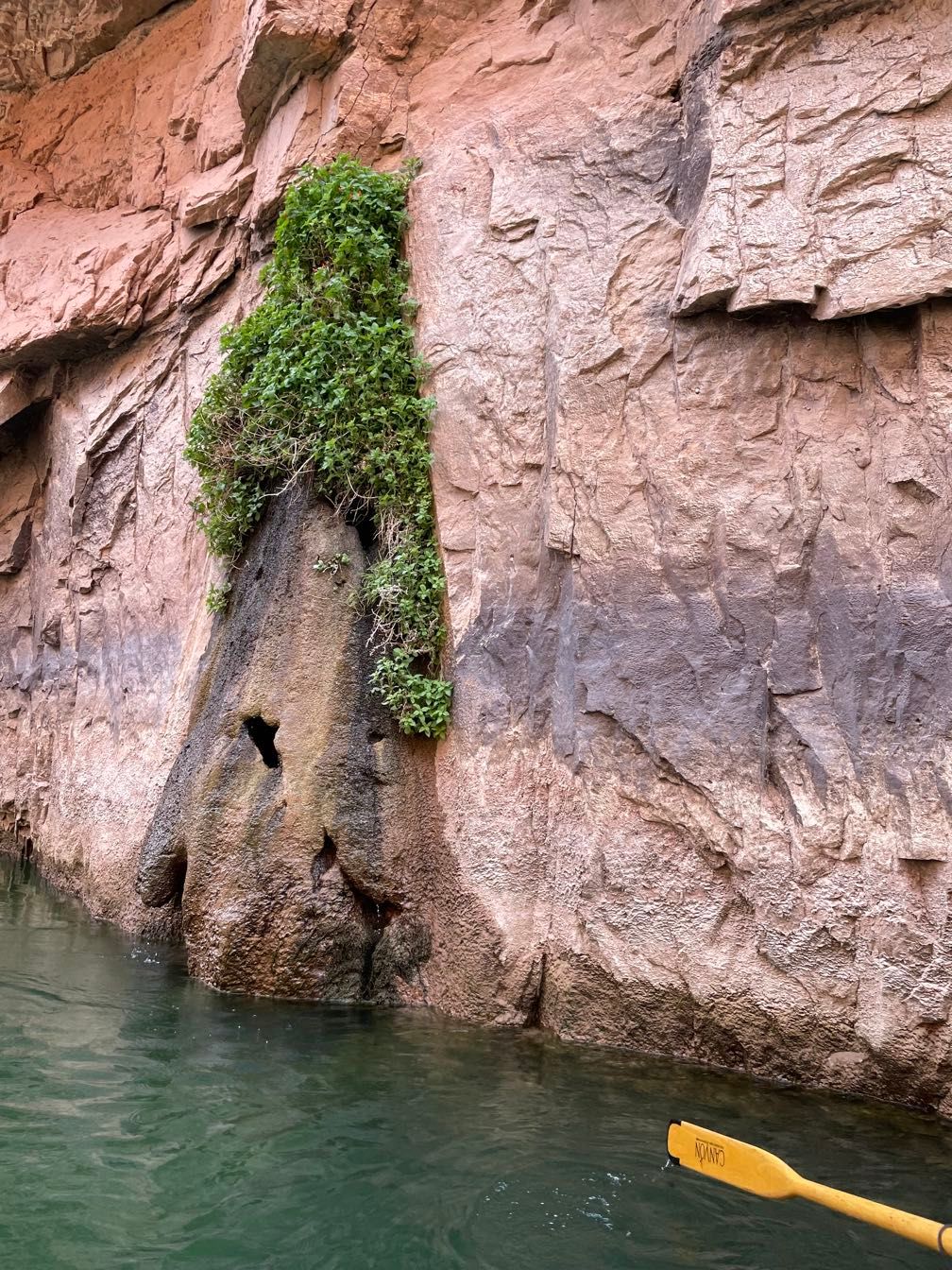 Travertine buildup beneath a spring
Travertine buildup beneath a spring
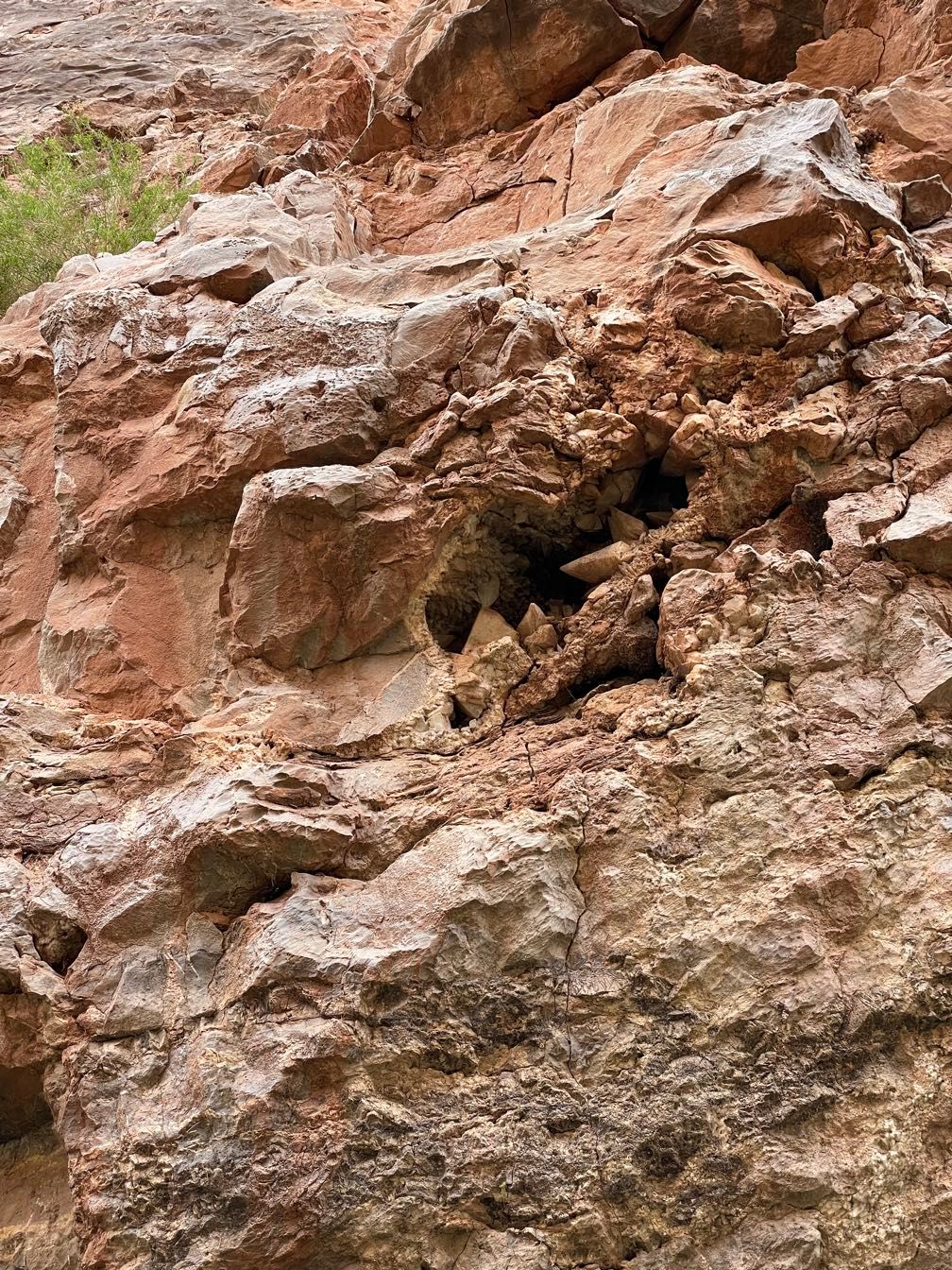 Calcite crystals in limestone
Calcite crystals in limestone
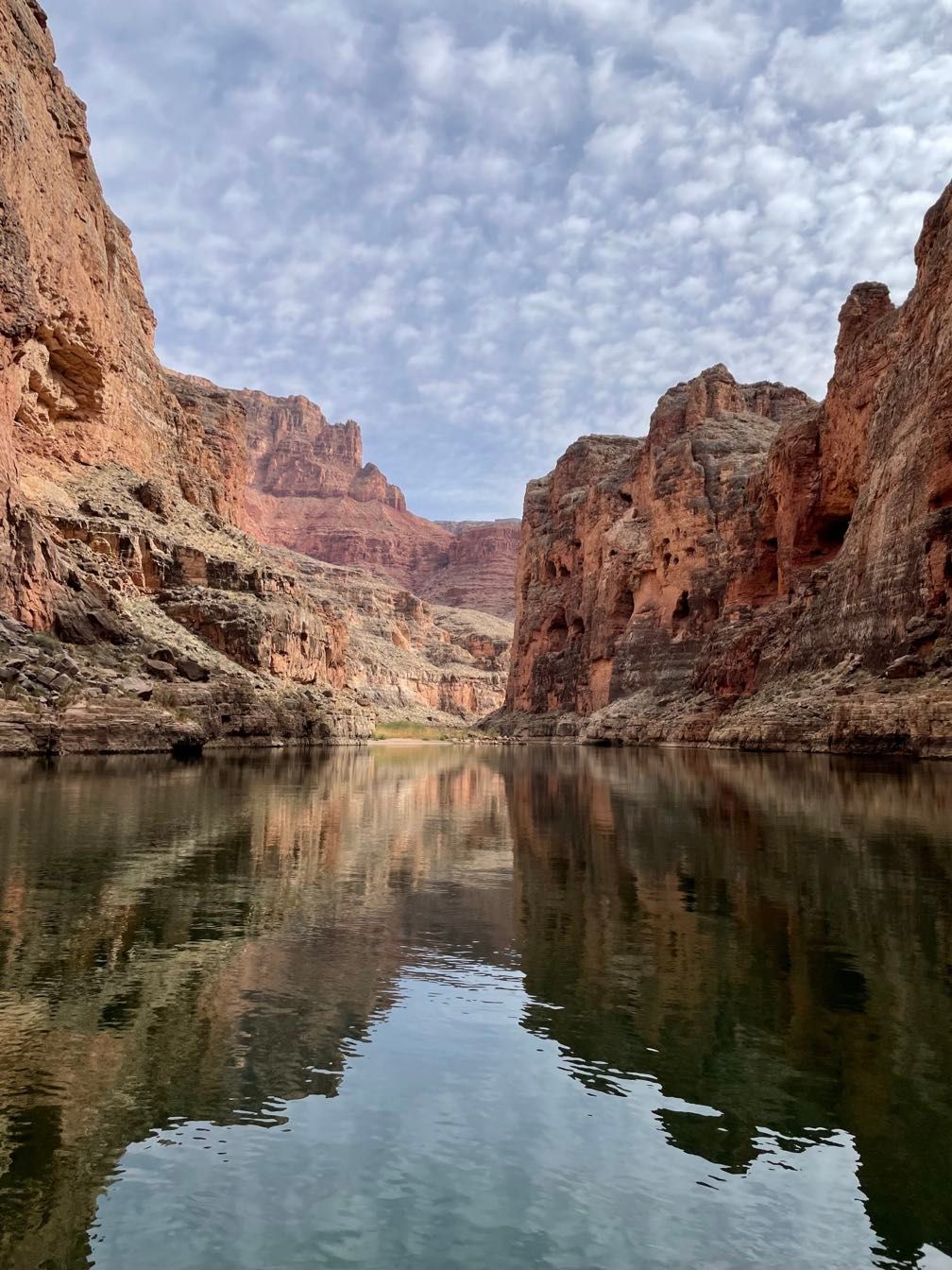 Still water on the river
Still water on the river
We stopped for the night at Redbud Camp and enjoyed some excellent fajitas for dinner.
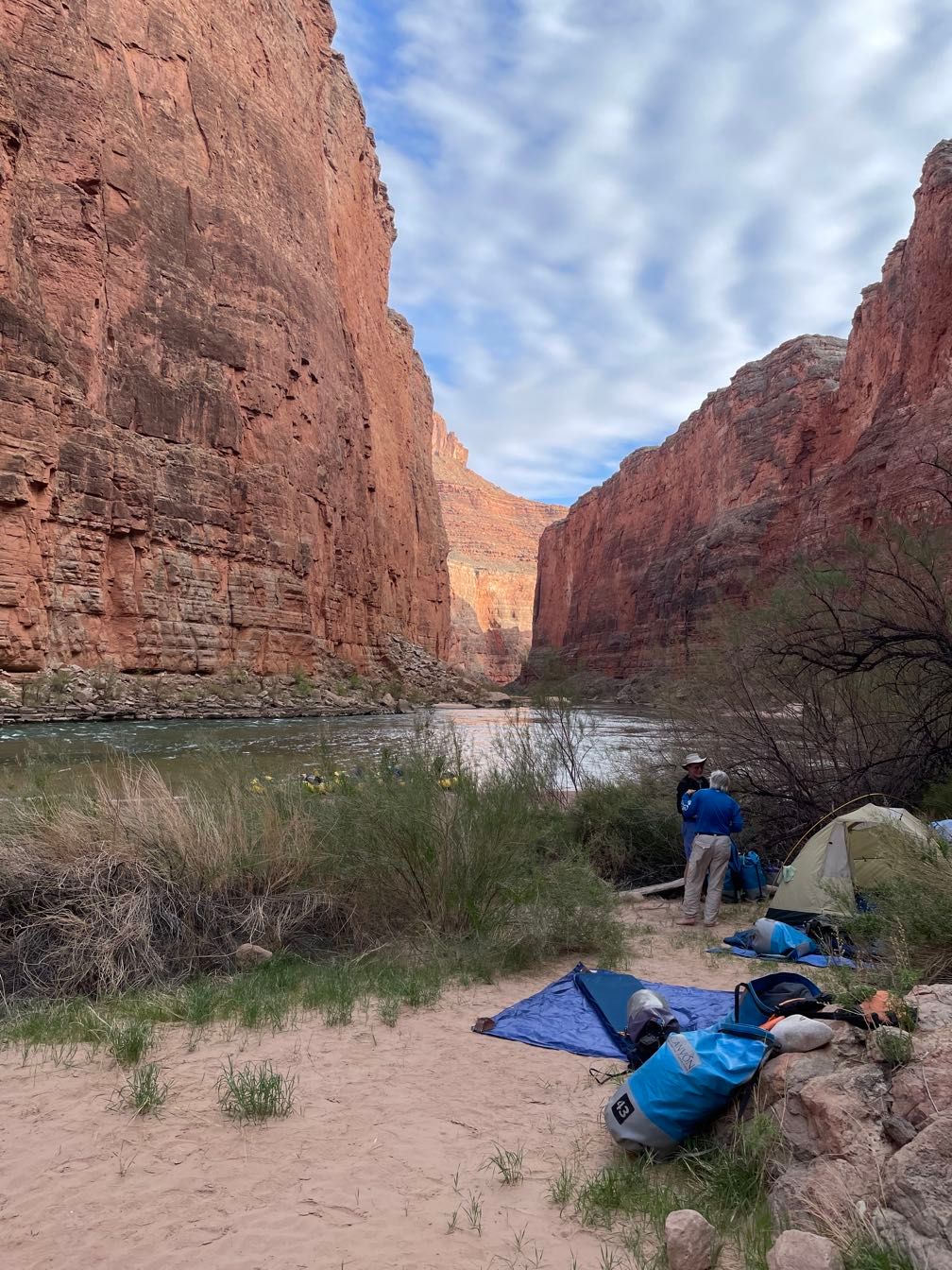 Redbud Camp
Redbud Camp
 Red rocks at Redbud
Red rocks at Redbud
Day 4
After breakfast, we walked up to Redbud Alcove; a beautiful semi-circular alcove incised deeply into the canyon wall. Gary pointed out the redbud trees that give the alcove its name. He had to explain why the flowers were, in fact, purple.
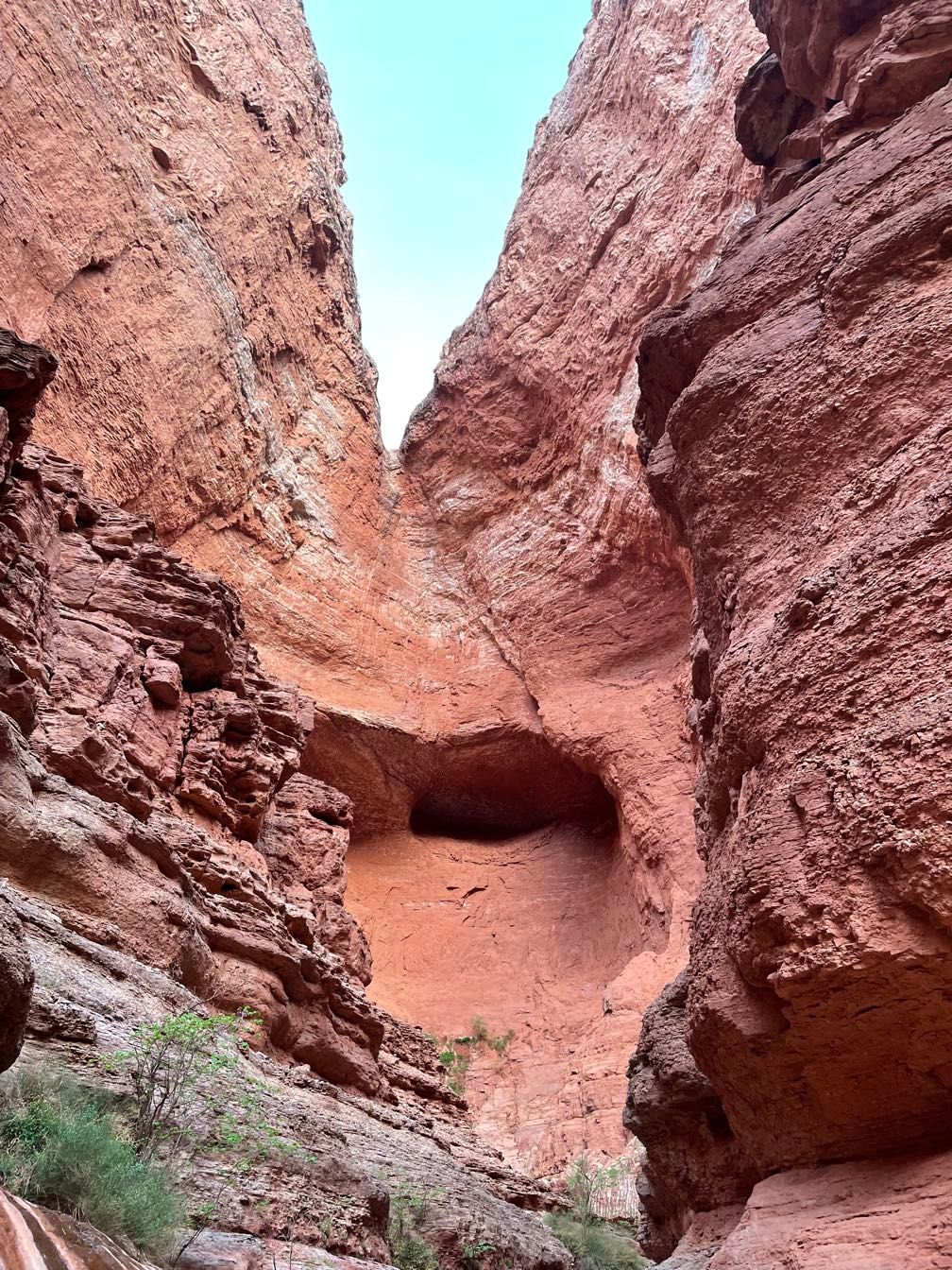 Redbud Alcove
Redbud Alcove
 Redbud tree at Redbud Alcove
Redbud tree at Redbud Alcove
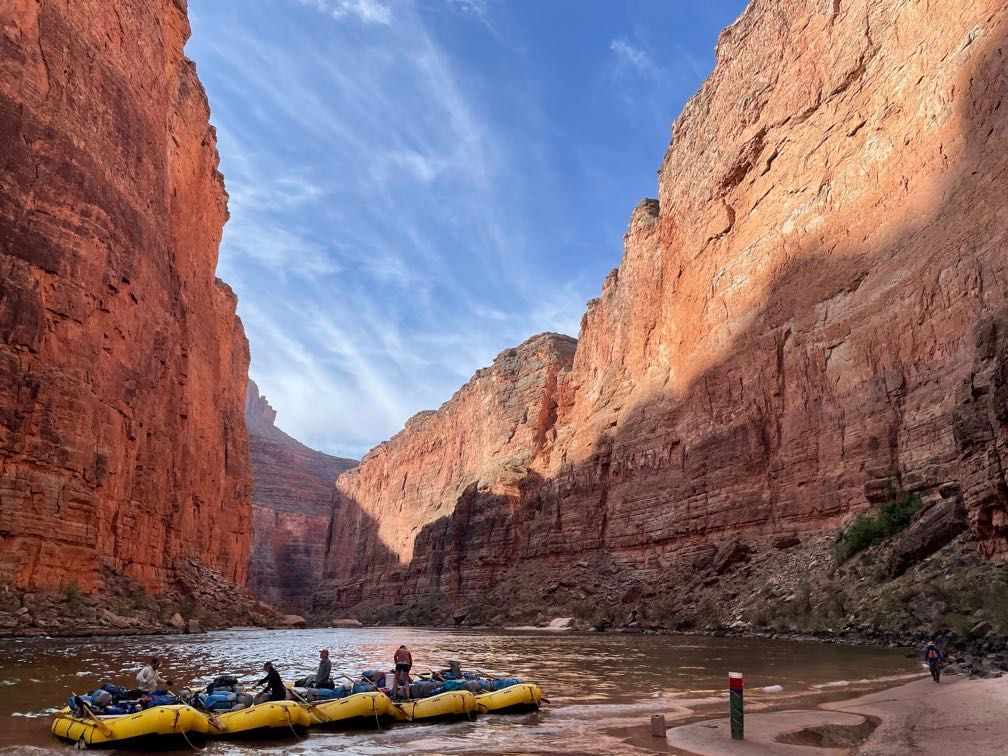 The boats at Redbud Camp
The boats at Redbud Camp
We broke camp and loaded the boats. Today, we were riding with Amy. Heading downriver, we had a long stretch of calm water. After the Roaring Twenties, these were the “Rowing Thirties.” Just past Mile 39, we passed the proposed Marble Canyon Dam site. Had it been built, it would have flooded all the beautiful canyon we’d been rafting through. Gary talked a bit about the fights over dams on the Colorado River, and Sequoyah read a poem on the subject by Vaughn Short.
 Gary talking about damming Marble Canyon, with one of the test excavations visible in the background
Gary talking about damming Marble Canyon, with one of the test excavations visible in the background
We passed the Anasazi Bridge, the remains of a wooden bridge built by the Ancestral Puebloans to cross a crack high up on the cliff as part of a cross canyon route.
Eventually, we reached President Harding Rapid, our first significant bit of water in quite a while. Shortly after that, we came to a long straight stretch of canyon and faced a stiff headwind. Amy got quite a workout. This was our first real taste of many windy river miles to come.
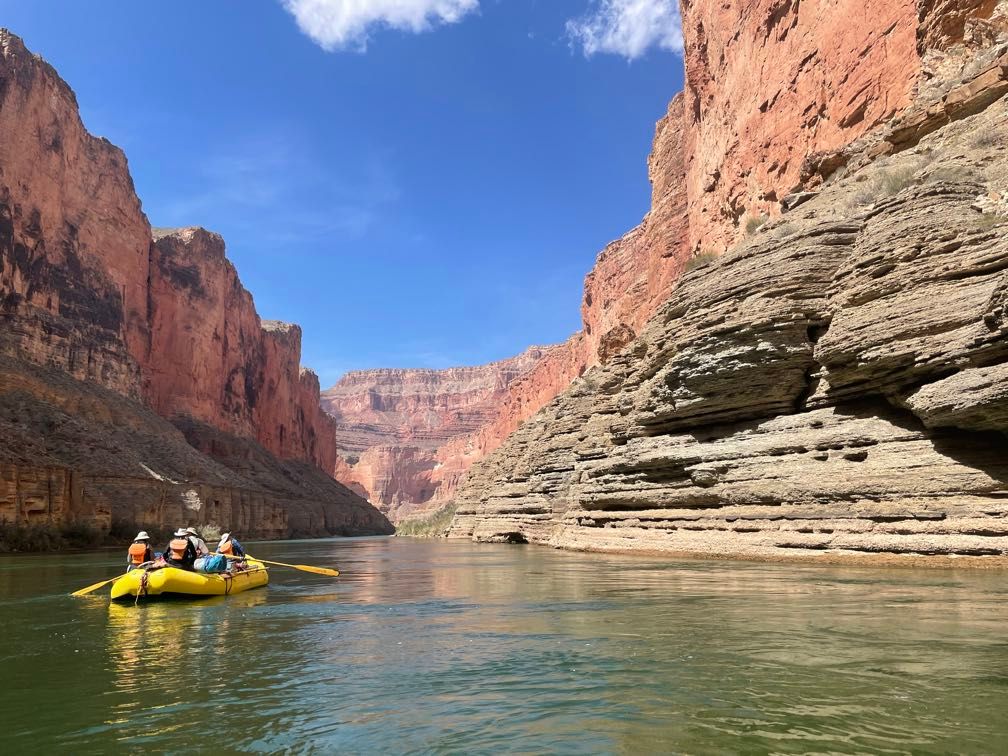 Rafting down the canyon
Rafting down the canyon
Shortly before noon, we pulled into Saddle Canyon. A group was already eating lunch there, so we delayed lunch and headed up the trail with a big helping of snacks. After a steep climb, a walk along a dry creek bed, and a short bit of wading, we reached a lovely little waterfall. We rested there for a while. Lying curled up against the cool rock was pretty relaxing.
 View from the Saddle Canyon trail
View from the Saddle Canyon trail
 Walking up Saddle Canyon
Walking up Saddle Canyon
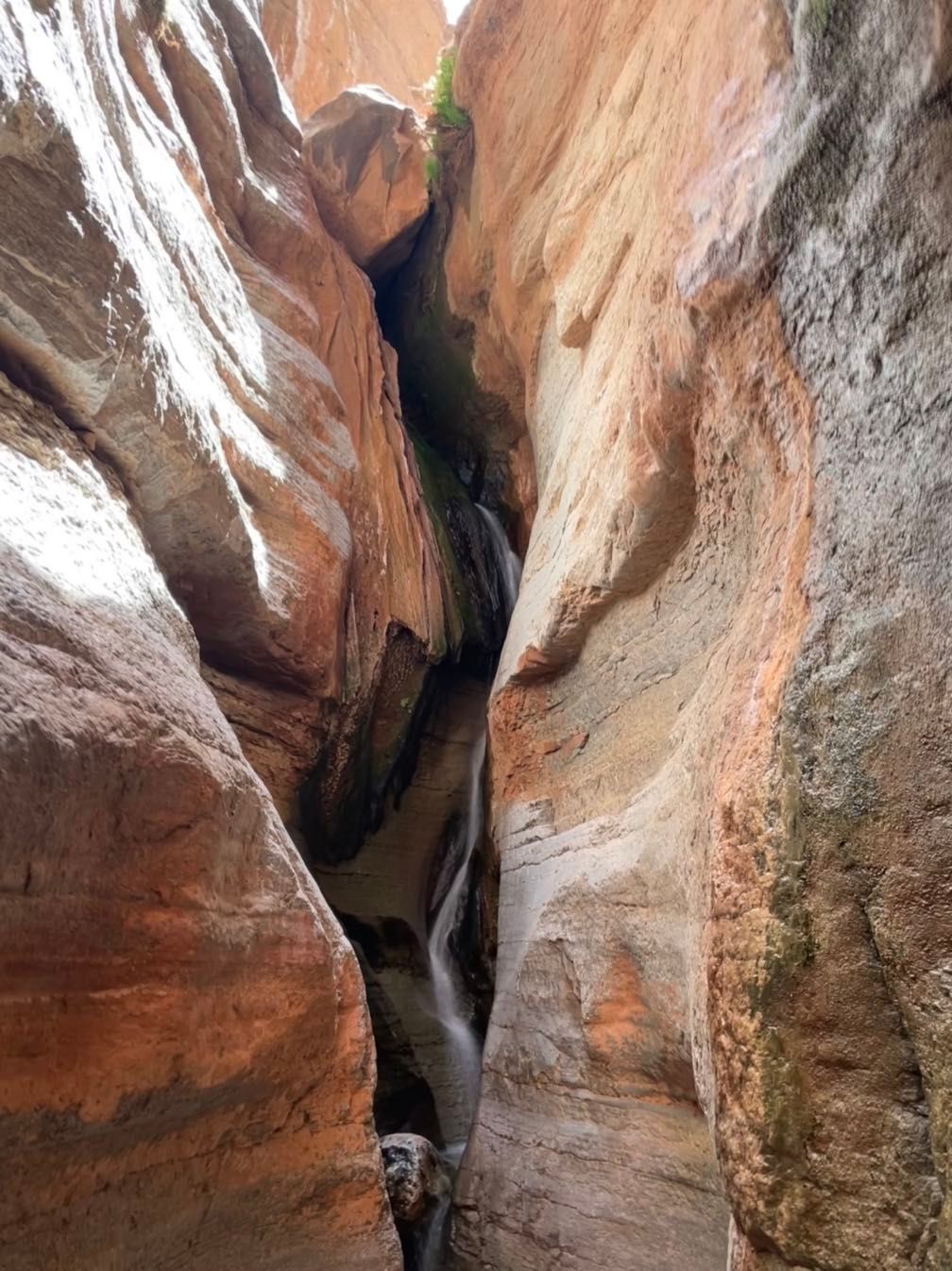 Waterfall in Saddle Canyon
Waterfall in Saddle Canyon
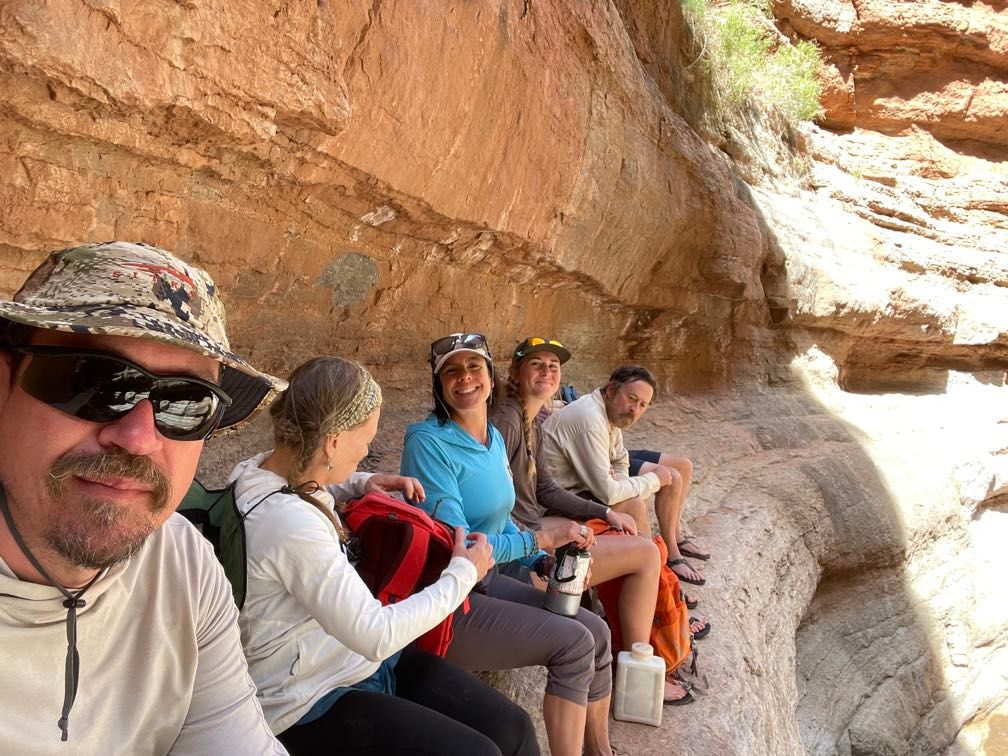 Relaxing in Saddle Canyon
Relaxing in Saddle Canyon
We headed back down to the beach to be met by a tremendous wind. It was even kicking up whitecaps out on the river. We had lunch while trying to shelter from the blowing sand. The guides talked it over and decided that there was no way to make progress against such a gale (far stronger than what they’d rowed against this morning).
We lined the boats around to a more sheltered location, then set up a bucket brigade to wet down the sand in an attempt to keep the blowing sand to a minimum. It took a lot of buckets. Once that was done, we shifted to a bag line and got the boats unloaded and all of our gear up a steep slope.
After that, it was off to find the most sheltered campsites we could. In the wind and blowing sand, we scarfed down a well-earned chicken teriyaki dinner.
Day 5
The wind continued to blow heavily overnight, making sleep difficult and snapping a pole in my parents’ tent. Around 4:45 am, it started spattering a light rain. Upon waking, there looked to be a light dusting of snow up on the Hermit Shale and Coconino Sandstone layers downriver.
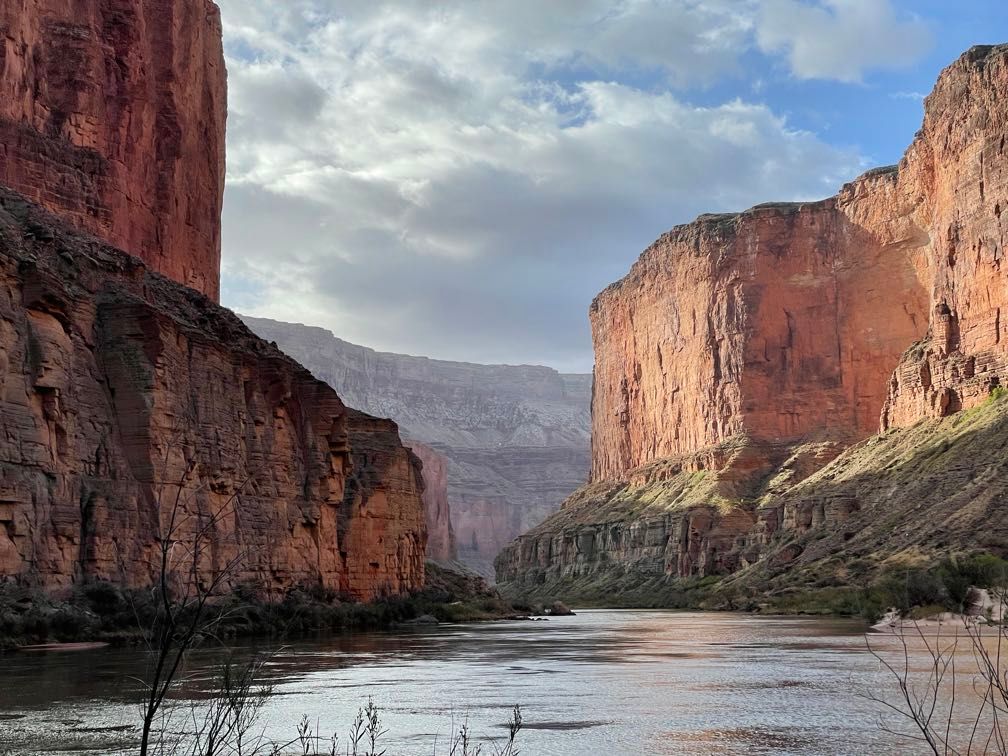 Dusting of snow up on the canyon wall
Dusting of snow up on the canyon wall
We had breakfast and got on the river, riding with Dave today. I was wearing my rain gear as much for the additional warmth as for staying dry. We saw quite a bit of waterfowl on the river this morning, even more than earlier in the trip. There was some really spectacular scenery as well. After a long, flat cruise, we go to Nankoweap Rapid. It wasn’t rough, but it’s very long, about a mile.
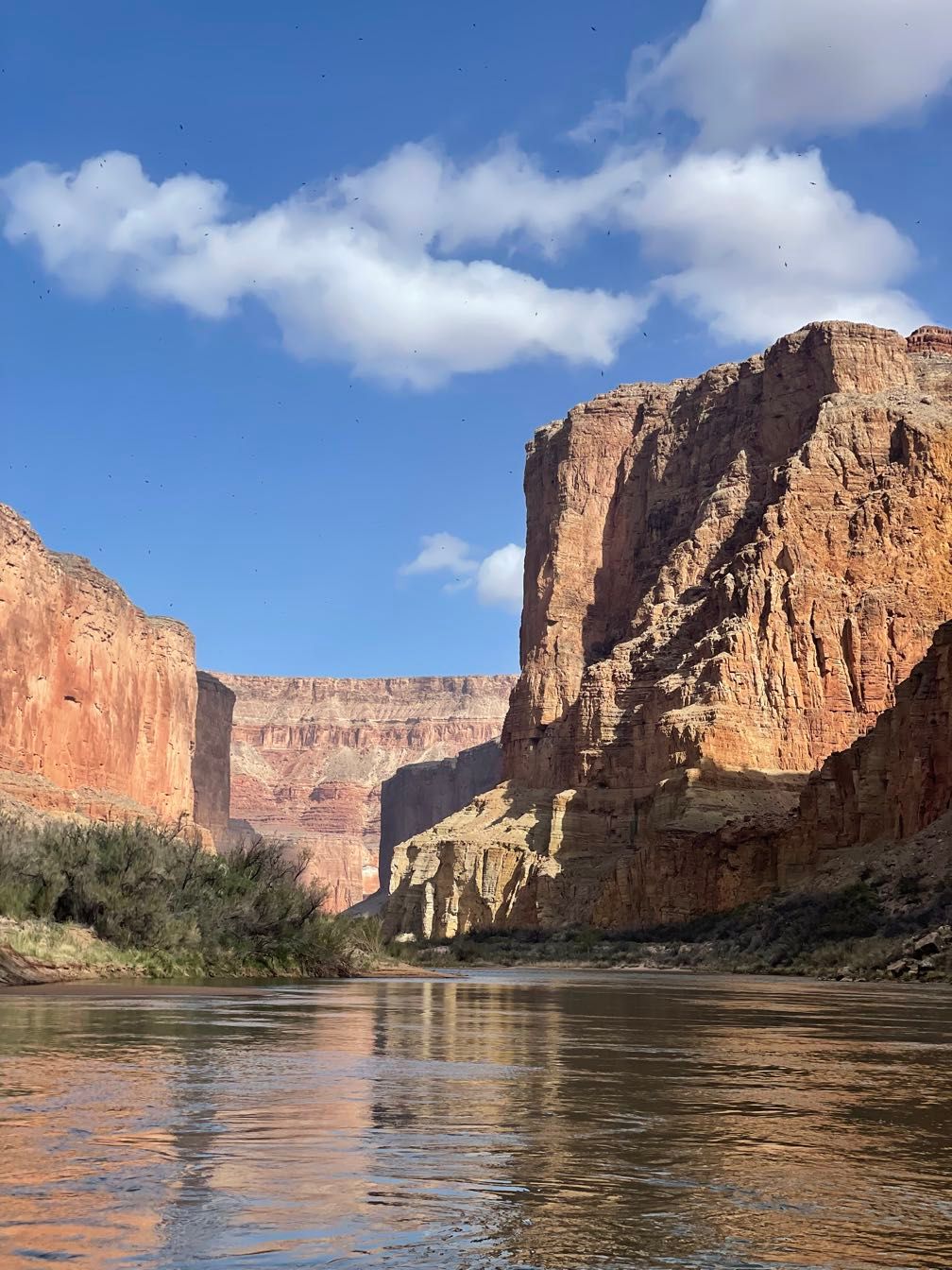 Light on the canyon walls
Light on the canyon walls
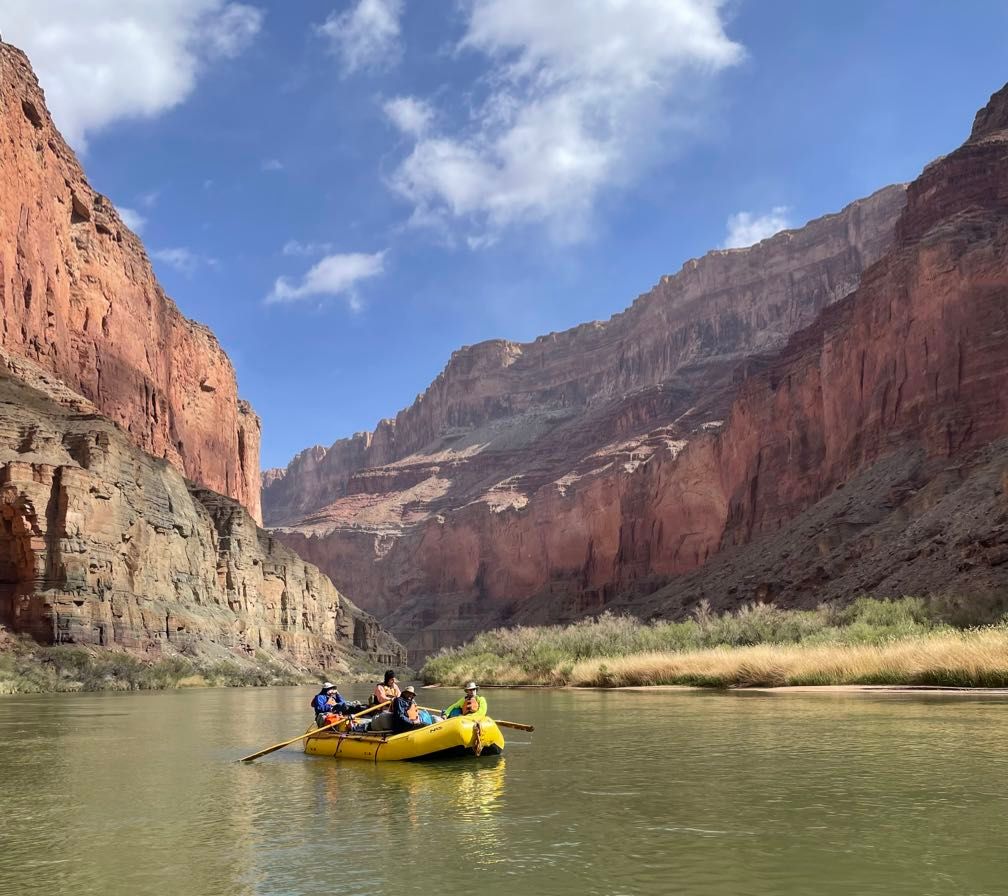 Rafting downriver
Rafting downriver
Downstream of the rapid, we pulled in and started the steep hike up to the Nankoweap granaries. It’s about 7-800 vertical feet. The granaries are an Ancestral Puebloan site where the people who farmed the Nankoweap delta below stored their crops. They’re fantastically well preserved, and the view is excellent. Sherri talked a bit about the granaries and the people who lived there.
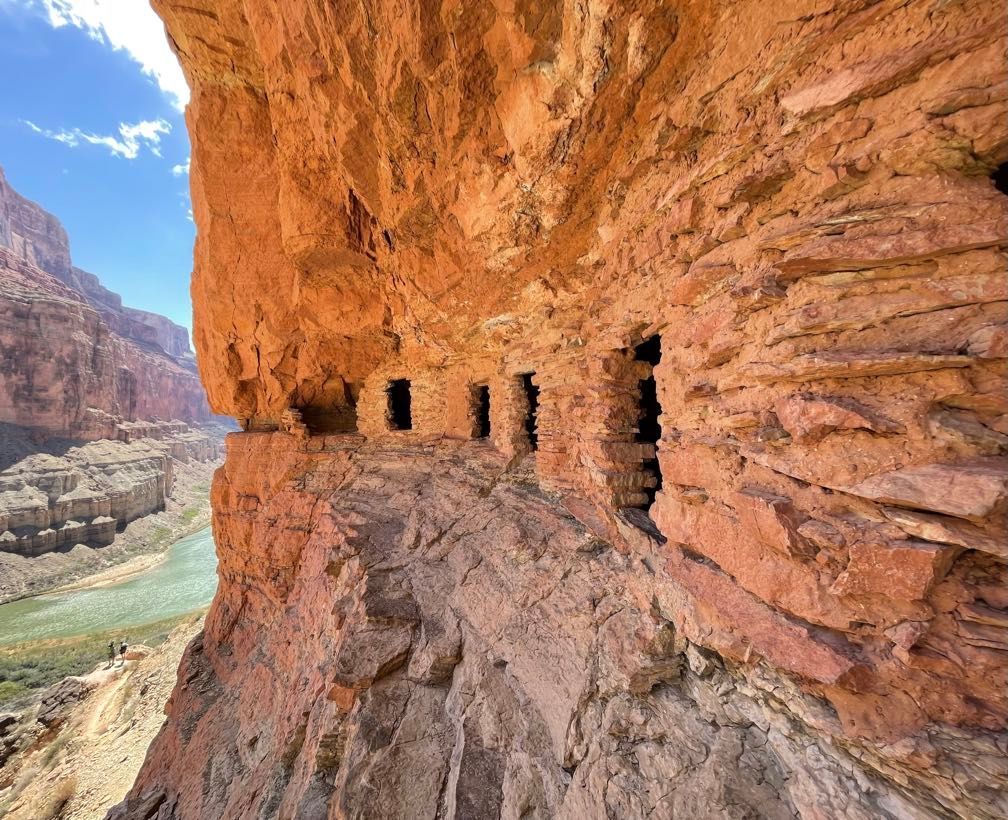 The Nankoweap granaries
The Nankoweap granaries
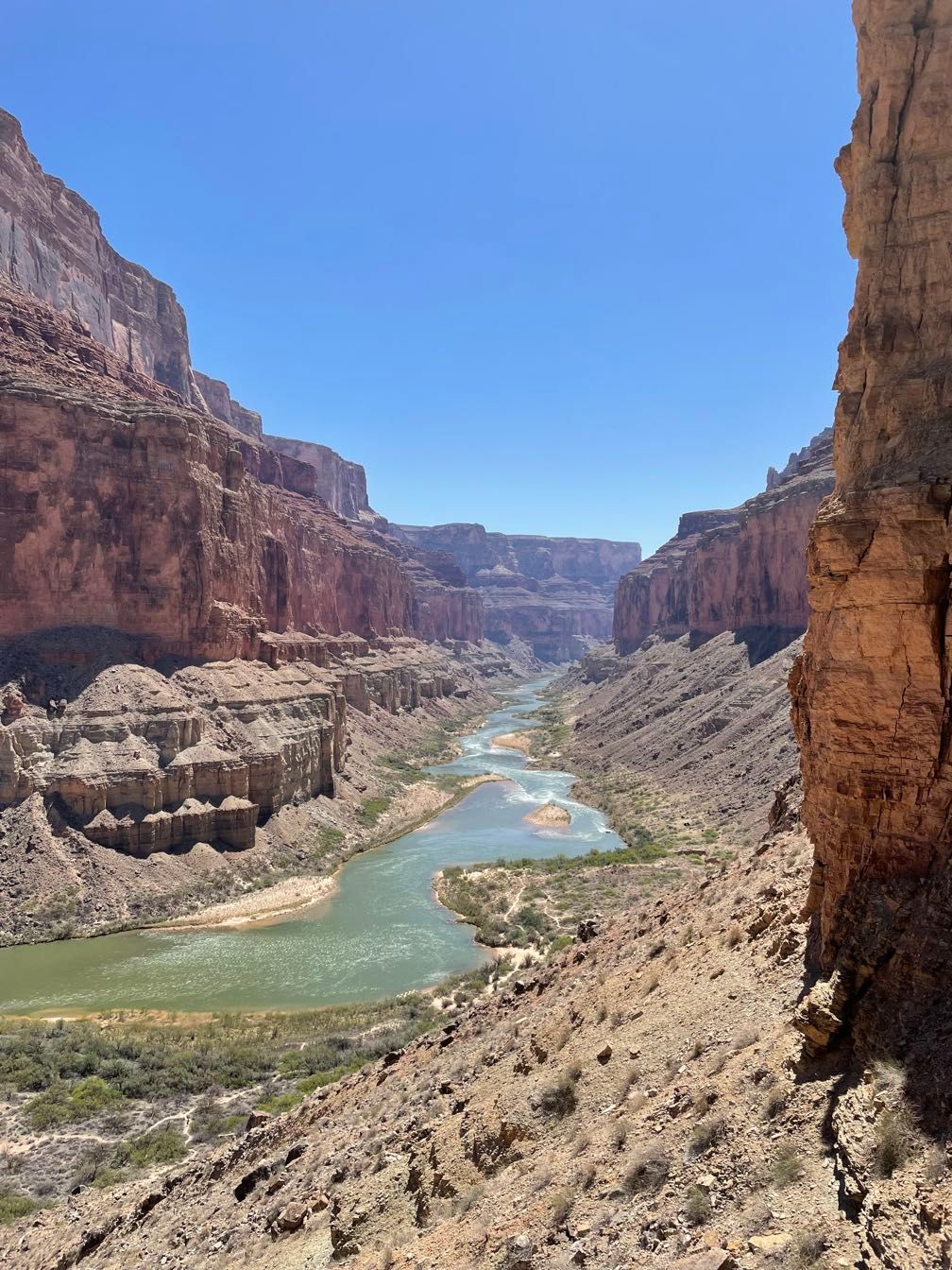 View downriver from the granaries
View downriver from the granaries
 Looking back upriver
Looking back upriver
We had lunch before getting back on the river. We floated down to Kwagunt. There we unloaded the boats and set up camp. We hiked up Kwagunt Creek to some neat geology associated with the Butte Fault. After hiking a couple of miles up a side canyon, it opens up into a broad valley formed by the heavily faulted layers. This may have been a bit ambitious a hike to start at 3 PM. Everyone was pretty pooped by the time we made it back.
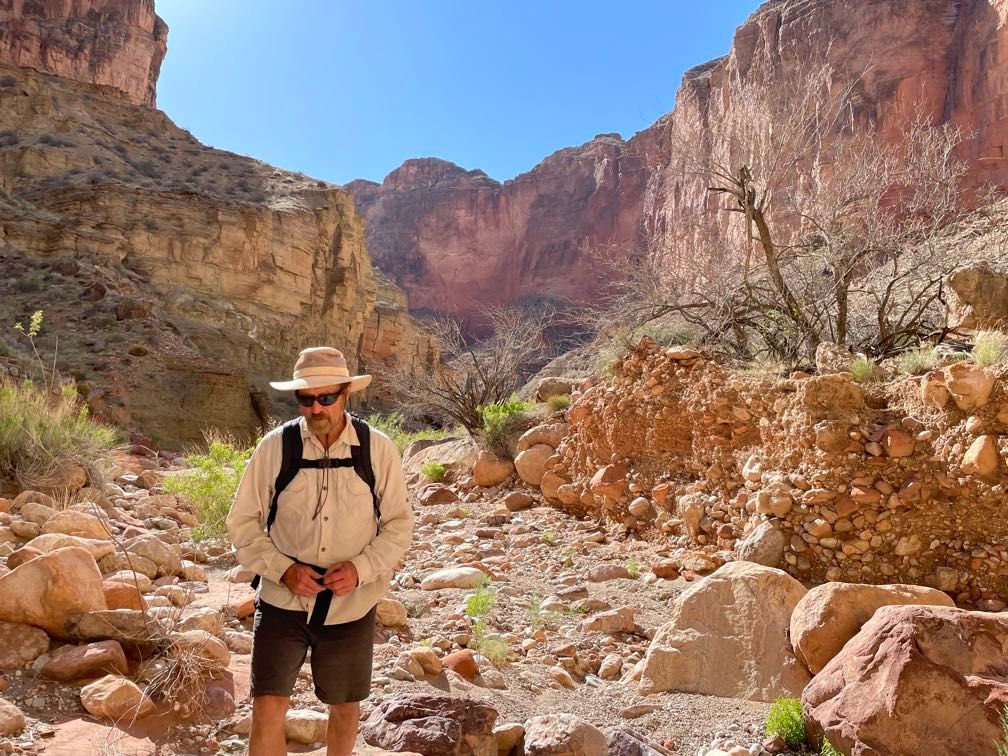 Kwagunt Creek
Kwagunt Creek
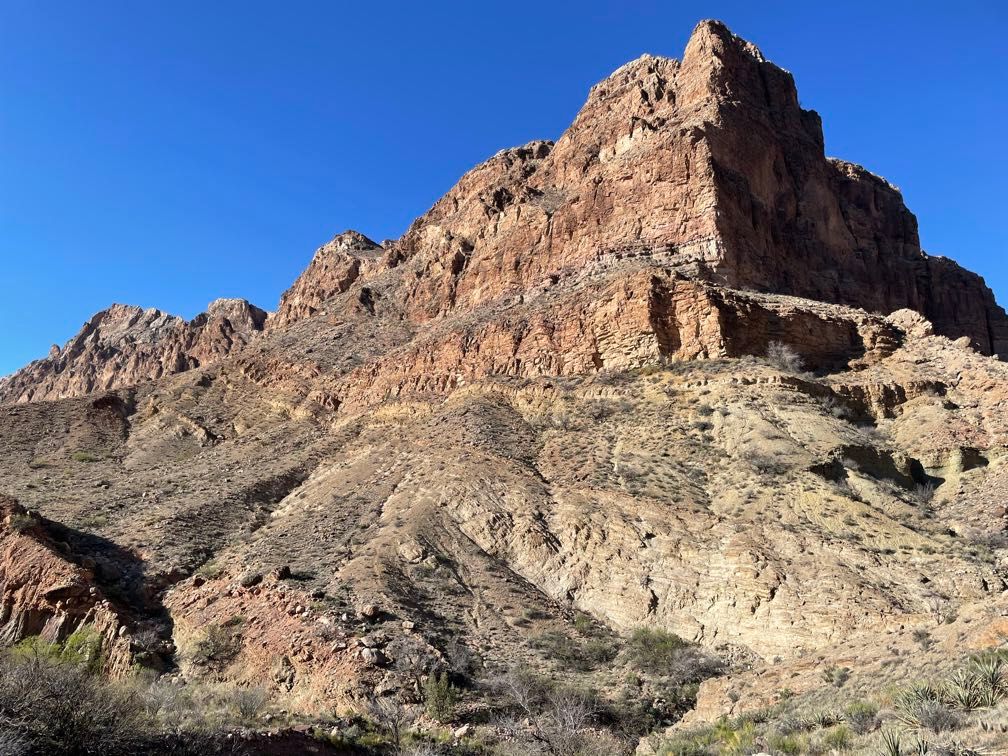 Geology
Geology
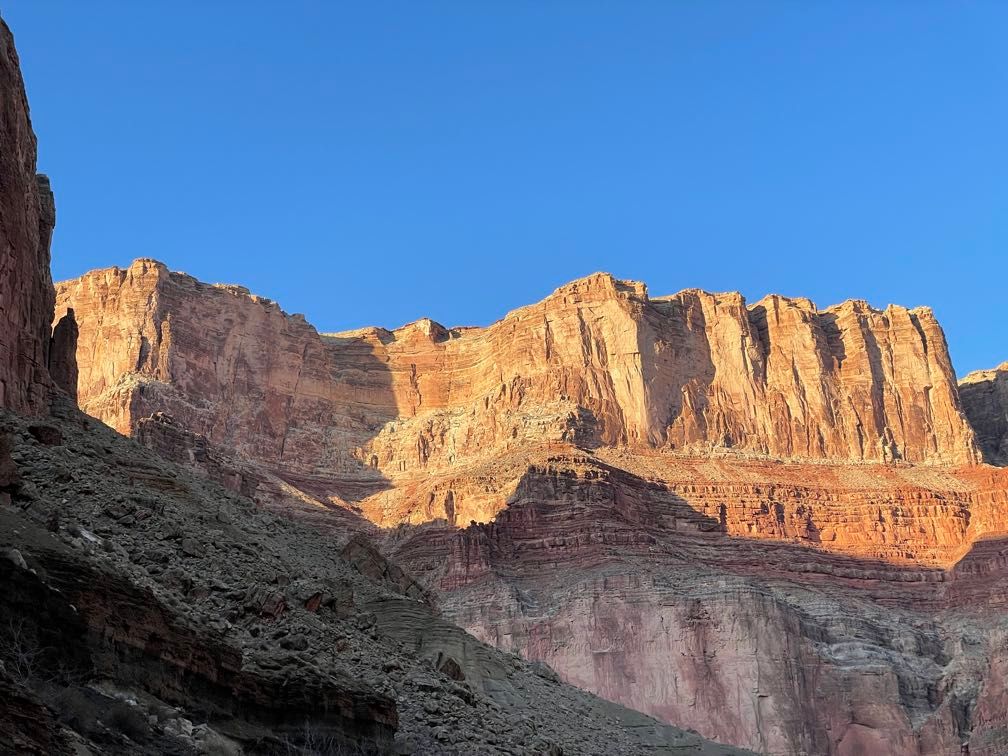 Evening light on red rock
Evening light on red rock
We had a late steak dinner. Afterward, we sat around the fire for a bit, and Sherri talked about the Hopi. Everyone hit the sleeping bag fairly early that night.
Day 6
The day dawned chilly and windy. It had been cold overnight, but I’d managed to stay pretty warm with long underwear, socks, and a hat. We had chorizo sausage breakfast burritos, one of the best breakfasts yet. My zip-off long underwear bottoms came in handy while changing into my rain pants before pushing off. Today we were riding with Leo.
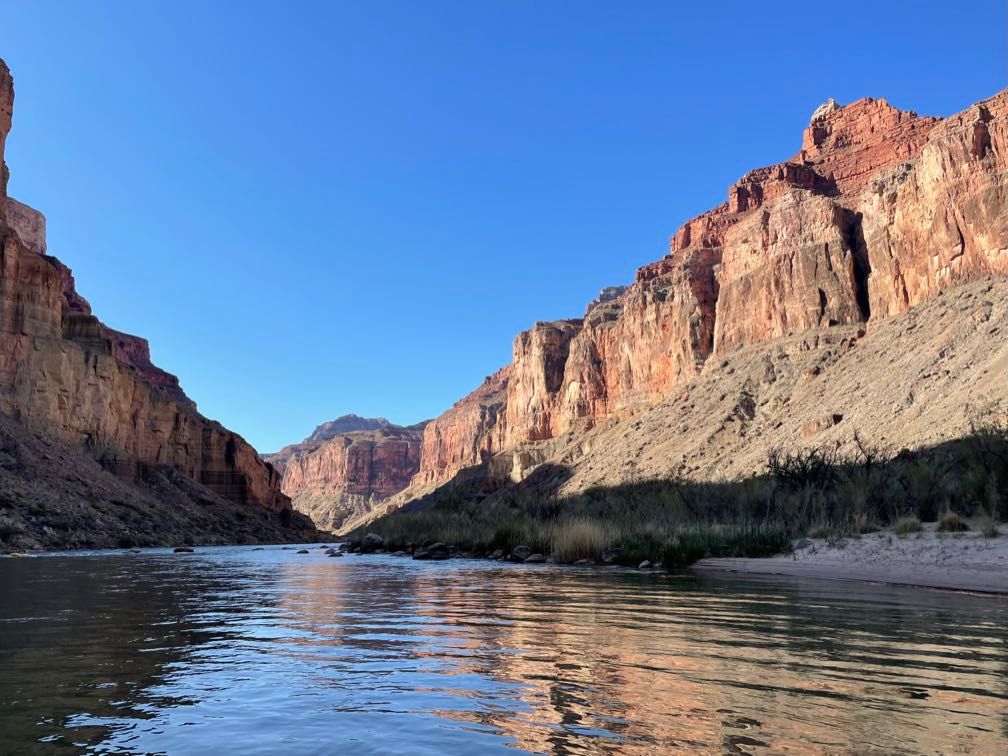 Morning light on the canyon wall
Morning light on the canyon wall
We ran some moderate rapids on our way to the confluence of the Little Colorado River. There we walked a short way upstream and saw Beamer Cabin (built on the remains of an Ancestral Puebloan structure). The Little Colorado was flowing, but not enough to turn the Colorado completely brown, just a milky green.
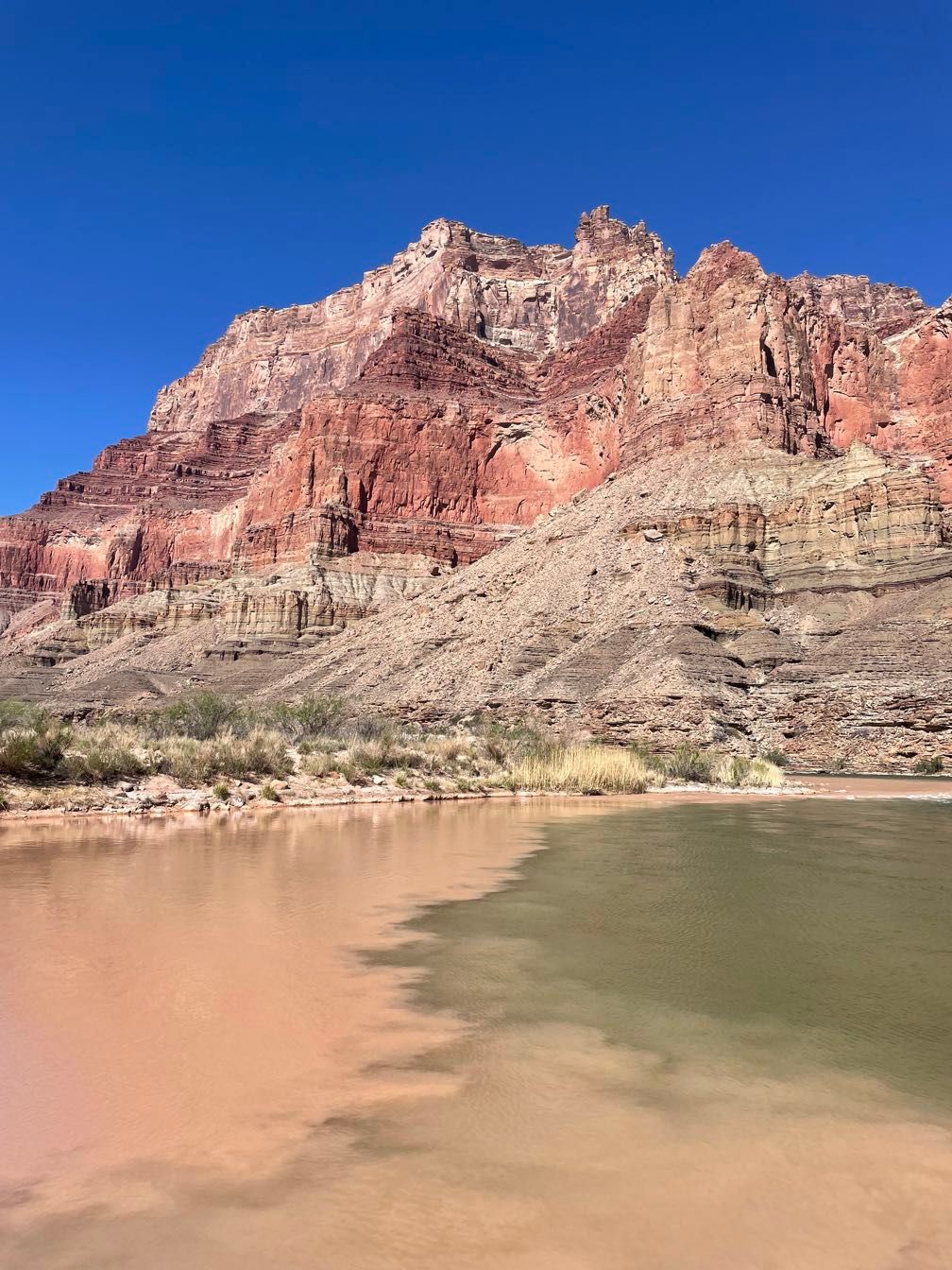 Muddy water of the Little Colorado flowing into the Colorado
Muddy water of the Little Colorado flowing into the Colorado
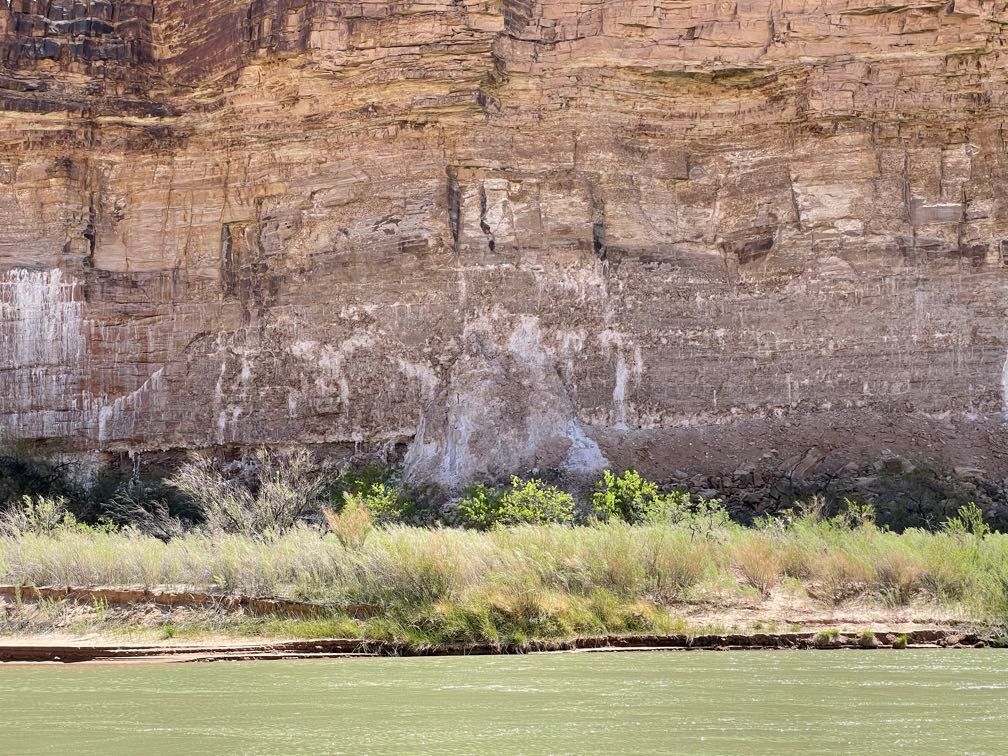 Salt deposits along the river
Salt deposits along the river
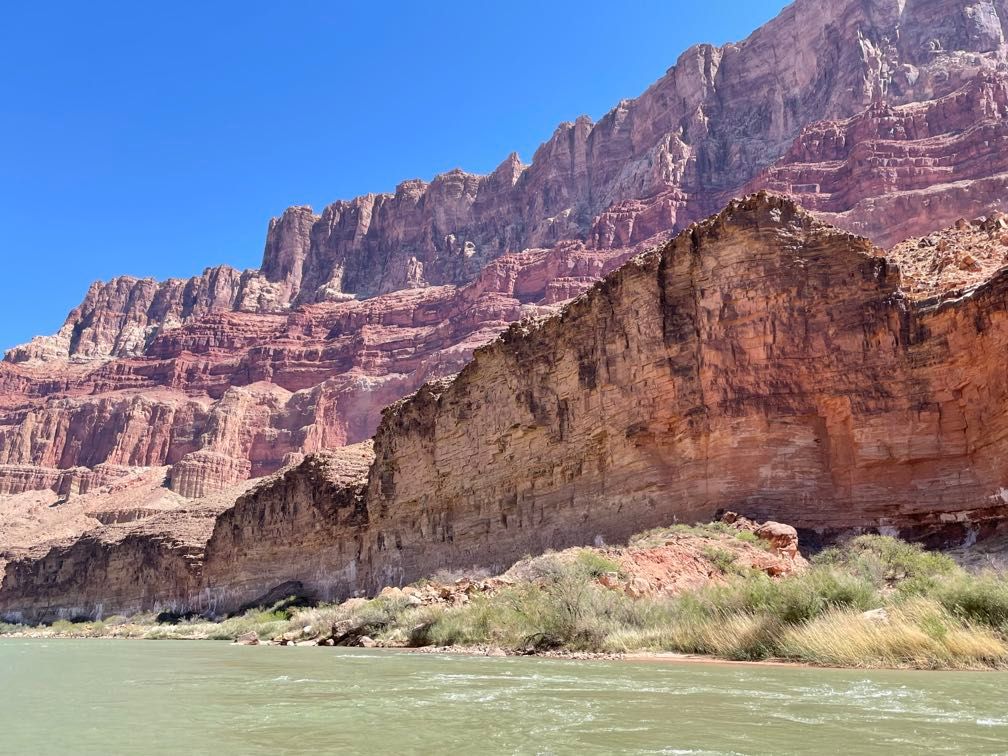 Downstream of the LCR
Downstream of the LCR
We floated down the river to Carbon Canyon, where we started a loop hike. We would walk about three miles overland and meet the boats downstream. Because Gary and Amy did the hike with us, Dave and Sequoyah walked the loop backward to pick up Gary and Amy’s boats and move them down to the end of the loop.
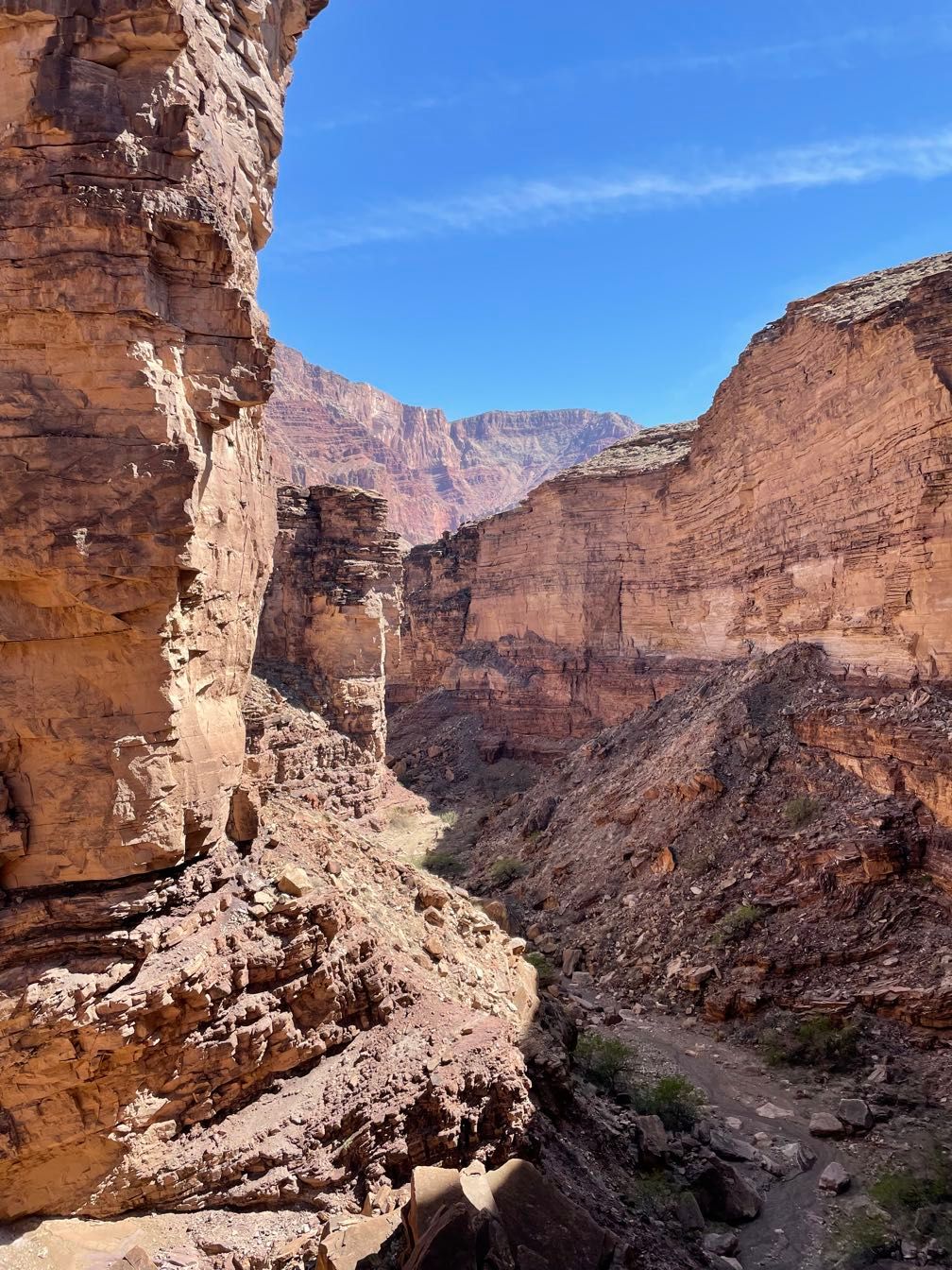 Hiking up Carbon Canyon
Hiking up Carbon Canyon 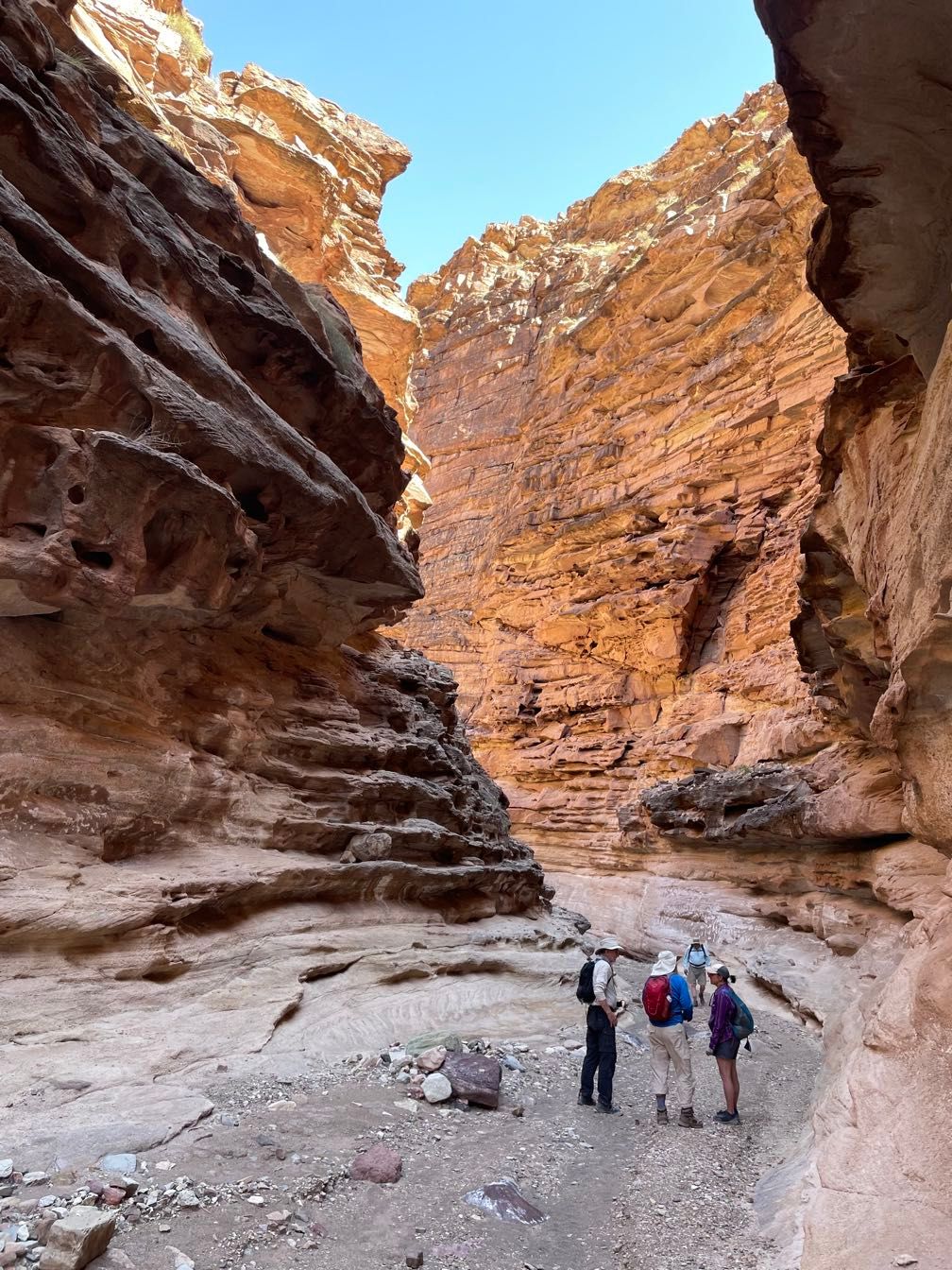 Carbon Canyon narrows
Carbon Canyon narrows
The hike up Carbon Canyon involved one very steep section to bypass a big pour-off. Up at the saddle between Carbon Canyon and Lava Canyon, Gary talked about the area’s geology and how the Butte Fault exposed the Grand Canyon Supergroup rocks. We descended from the saddle and followed Chuar Creek down Lava Canyon to the boats.
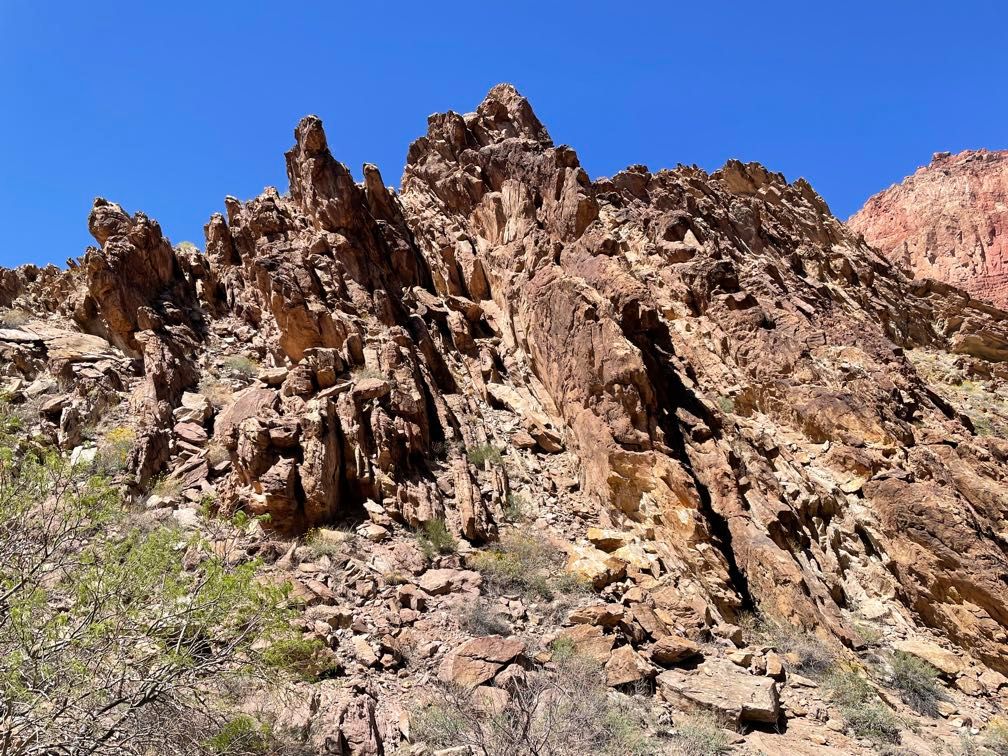 Heavily folded rock along the Butte Fault
Heavily folded rock along the Butte Fault
 An open valley above Carbon Canyon
An open valley above Carbon Canyon
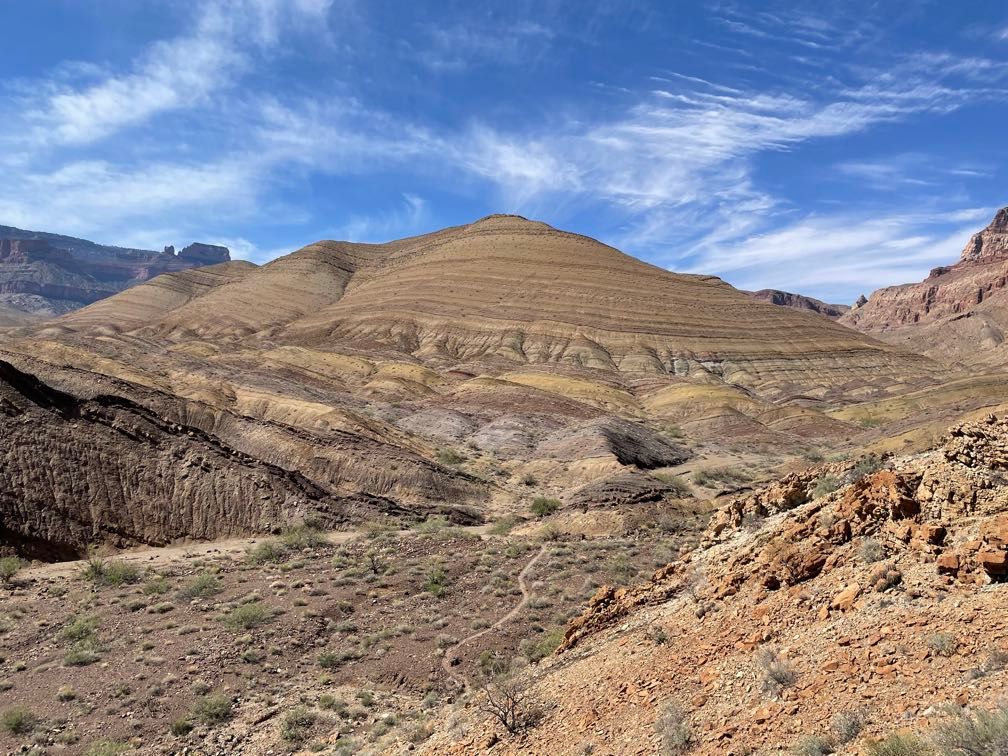 Rocks of the Grand Canyon Supergroup
Rocks of the Grand Canyon Supergroup
We rafted a short distance to our camp for the night. I did a river bath in the cold water before setting up my tent. After dinner, Sherri told us the story of Bessie Hyde around the campfire.
 Evening light on distant cliffs
Evening light on distant cliffs
Day 7
It was another cool morning, but it didn’t feel as cold as yesterday. After breakfast, Gary unrolled a couple of big maps for a geology lecture about the whole Grand Canyon region.
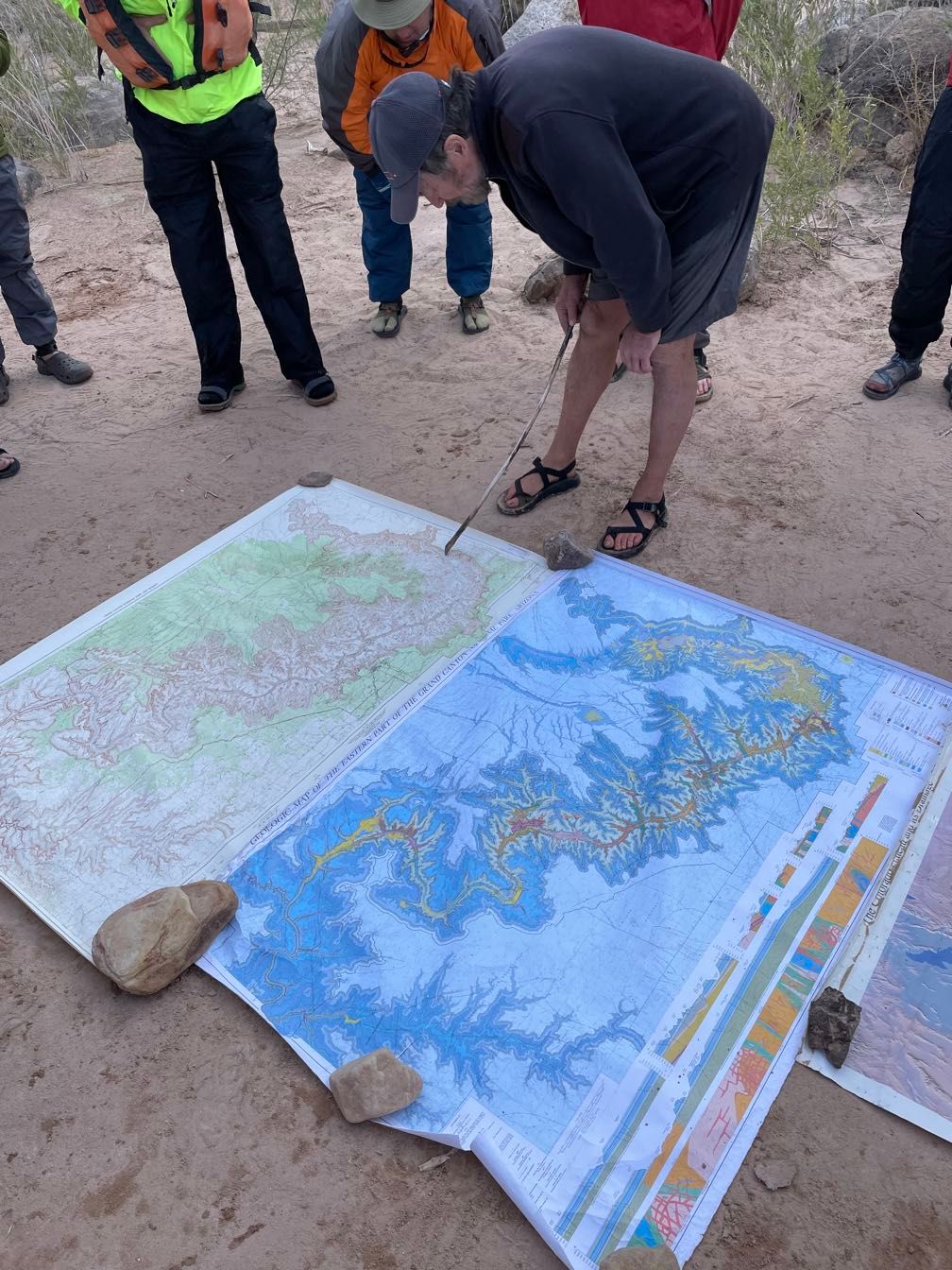 Gary giving a geology lecture
Gary giving a geology lecture
Riding with Gary, we pushed off and ran a few rapids. I was able to see a few landmarks like Solomon Butte, which helped me orient myself in relation to parts of the canyon I’ve often seen from the rim.
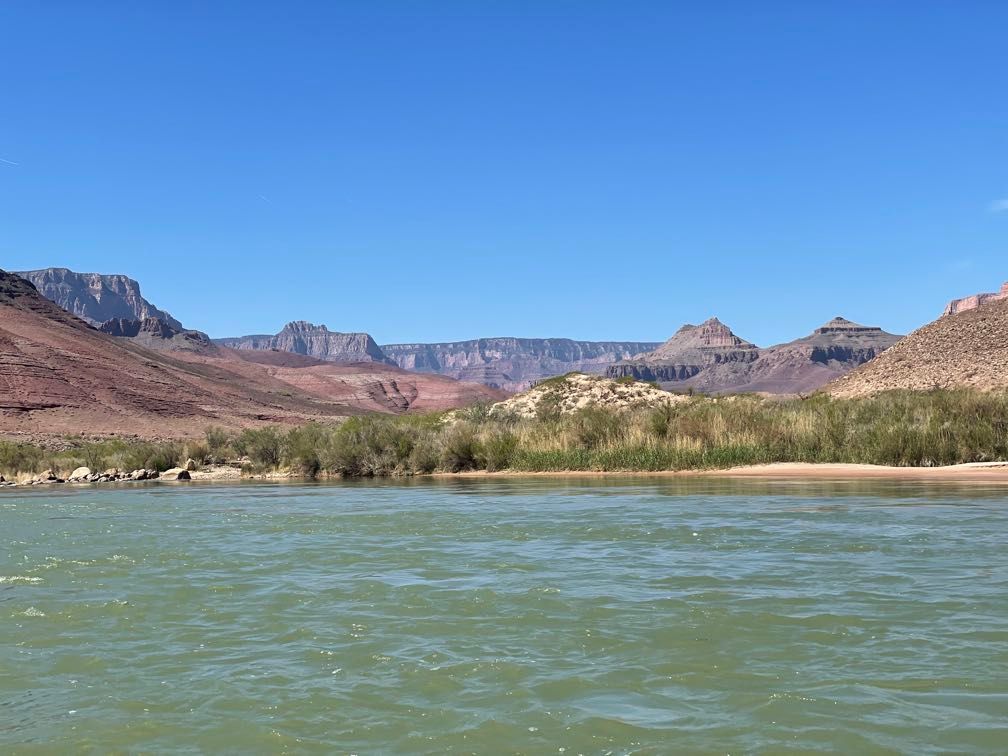 Some familiar landmarks
Some familiar landmarks
We stopped at the Unkar Delta archeology site. For about an hour walked around the loop trail while Sherri talked about the Ancestral Puebloans who lived at the site. We saw the remains of some dwellings and some really nice potshards. Sherri also demonstrated a “ticklish” cactus blossom. When you touch the tiny pollen-covered hairs inside the flower, they wave around to try to stick more pollen to the insect it thinks just landed.
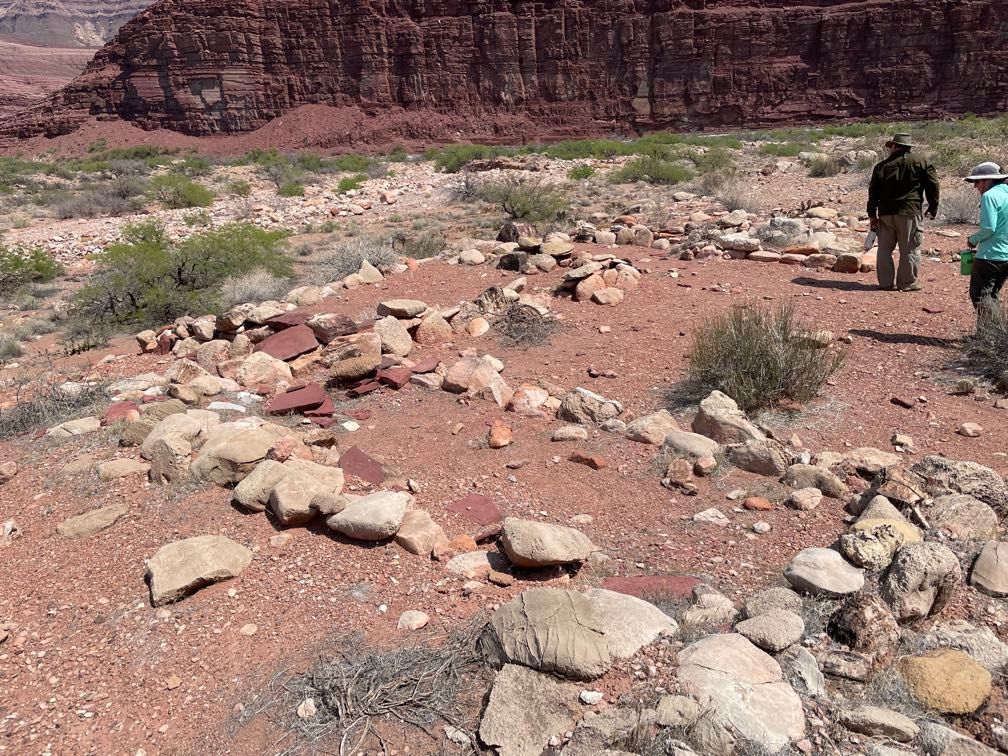 Dwellings at Unkar Delta
Dwellings at Unkar Delta
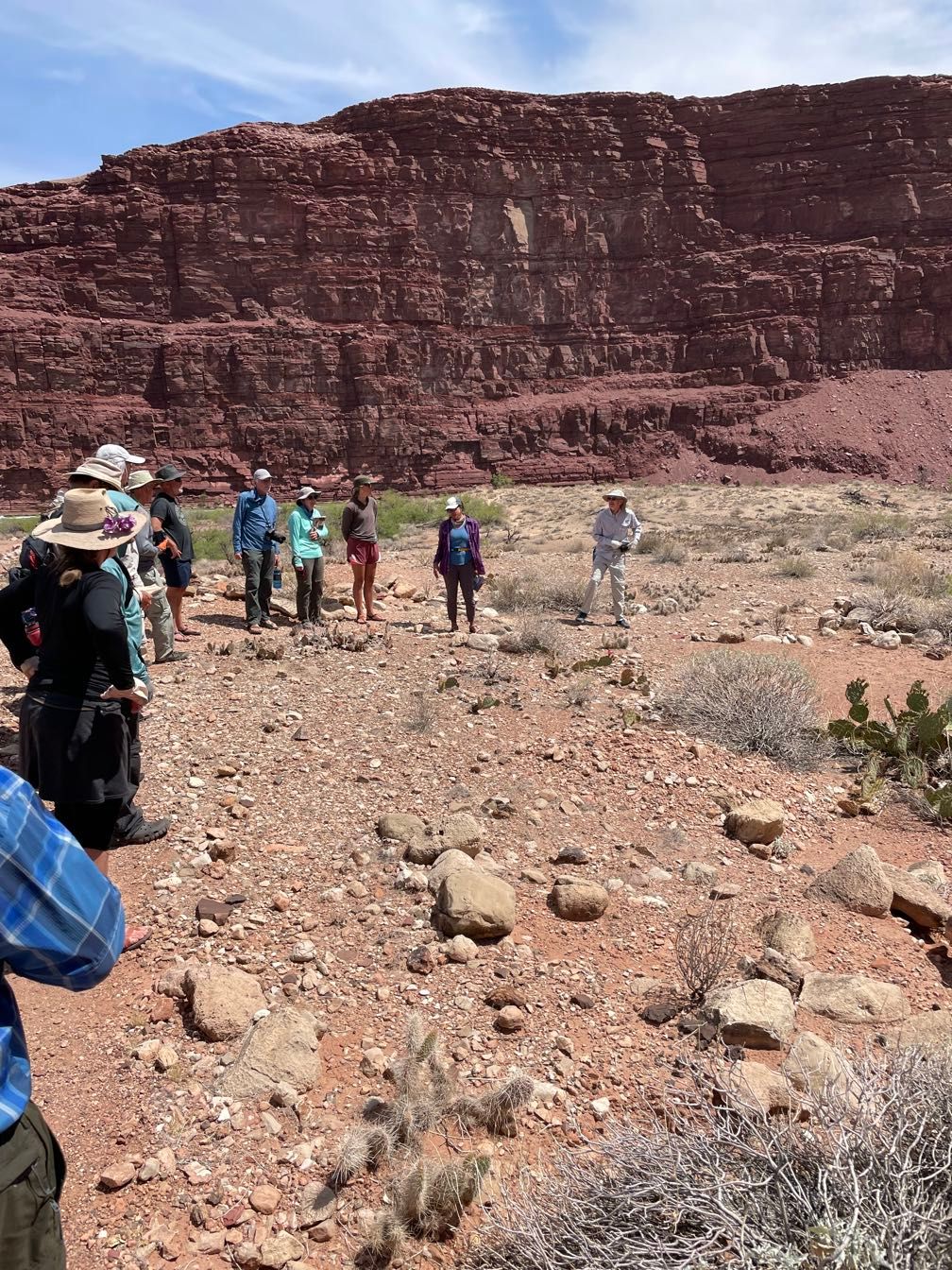 Sherri talking about the Ancestral Puebloans
Sherri talking about the Ancestral Puebloans
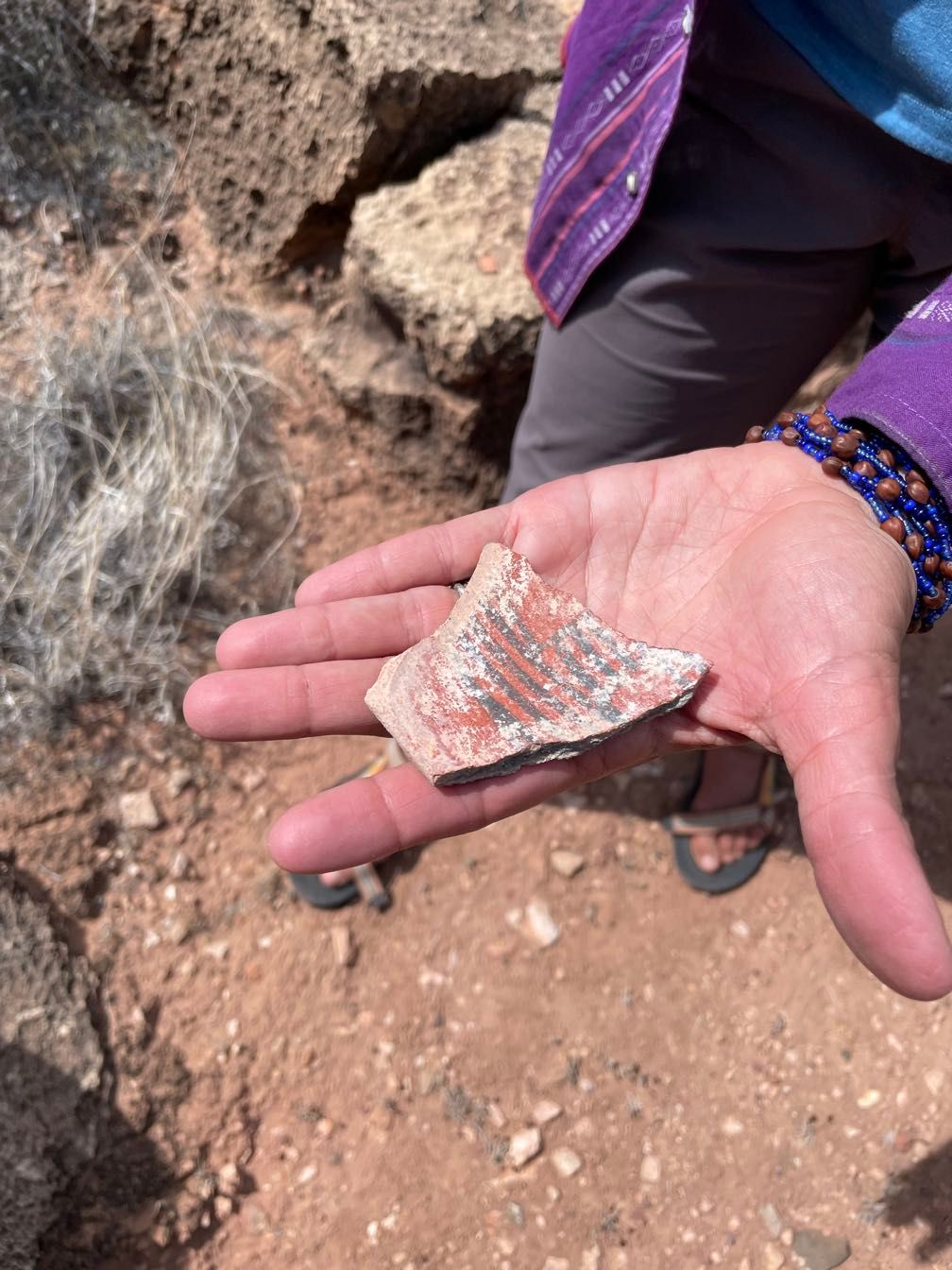 Beautifully painted potshard
Beautifully painted potshard
Rafting downstream, we passed through Unkar Rapid, which was a bit of a ride. Soon after, we came to a newer rapid caused by debris flows from adjacent streams.
We stopped for a late lunch, then hiked up the narrow 75 Mile canyon in the Shinumo Quartzite. There, Leo serenaded us with some songs on his Ukulele.
A bit further downriver, we camped at Below Nevils. It was windy again, so my parents and I held off putting up our tents until later. We had burgers and brats for dinner.
Around the campfire, my Dad talked about the Black Bridge, a pedestrian suspension bridge across the Colorado at Phantom Ranch. He described how it was built back in the 1920s and its designation as a National Historic Civil Engineering Landmark. Then we adjourned to another windy, sandy night.
Day 8
It proved to be another windy night with little sleep. During breakfast, my parents’ tent rolled over and broke another pole.
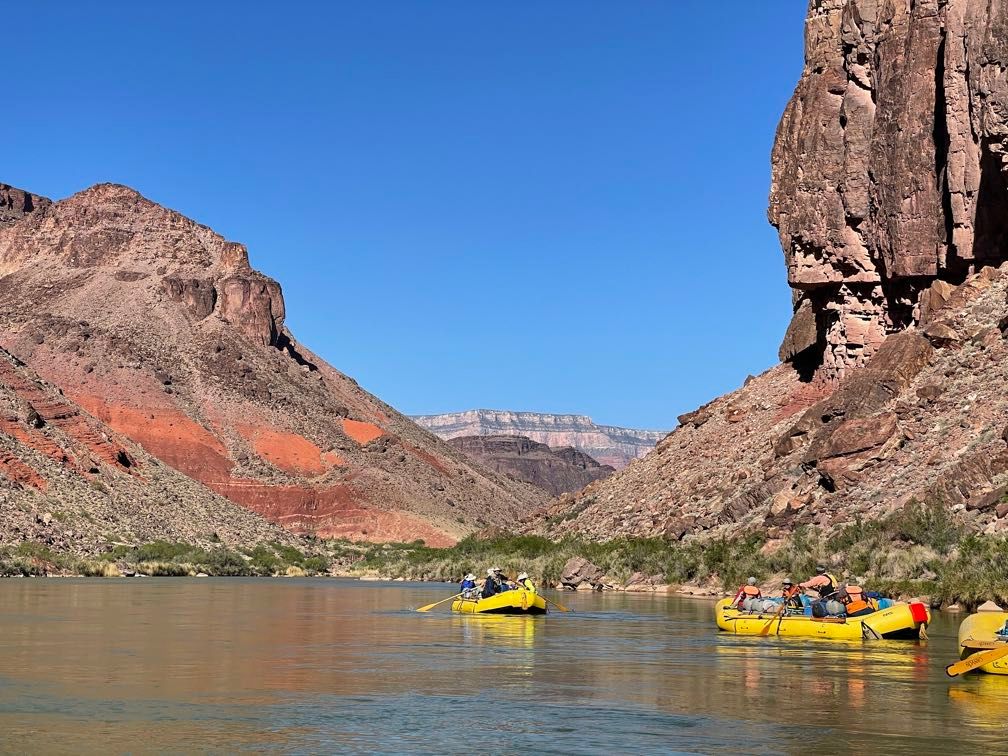
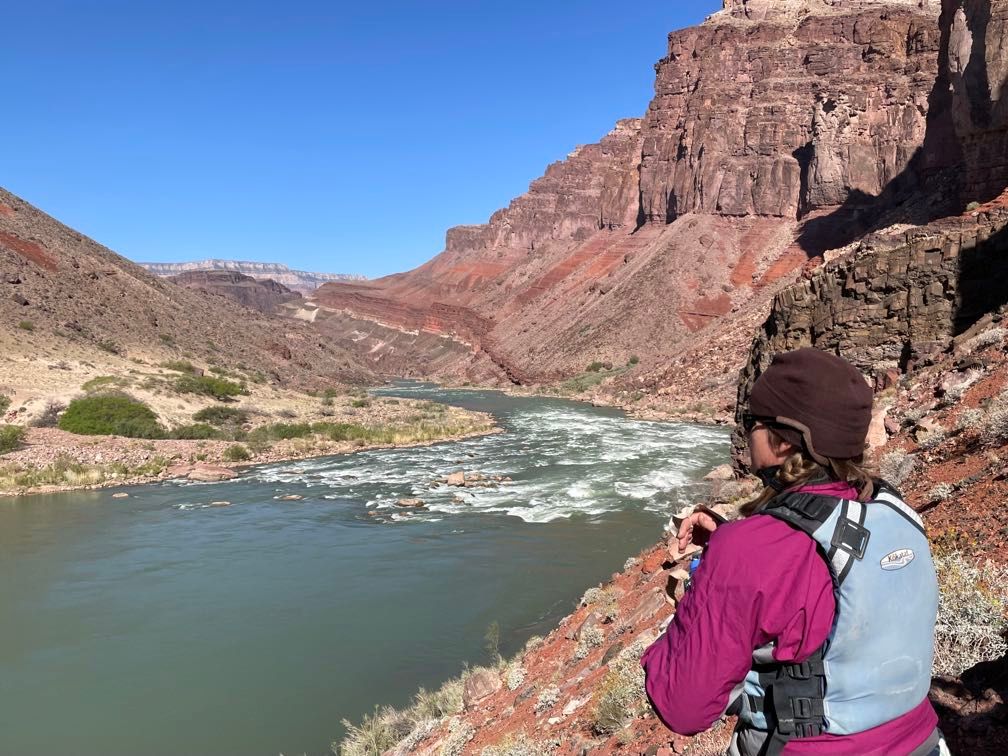 Amy scouting Hance Rapid
Amy scouting Hance Rapid
We ran a couple of rapids on the river in Dave’s boat before stopping to scout Hance Rapid. This one requires some maneuvering in the rapid. Rather than just finding the right line on entry, you have to pull to the left. It was a bit of a rough entry, followed by lots of splashing.
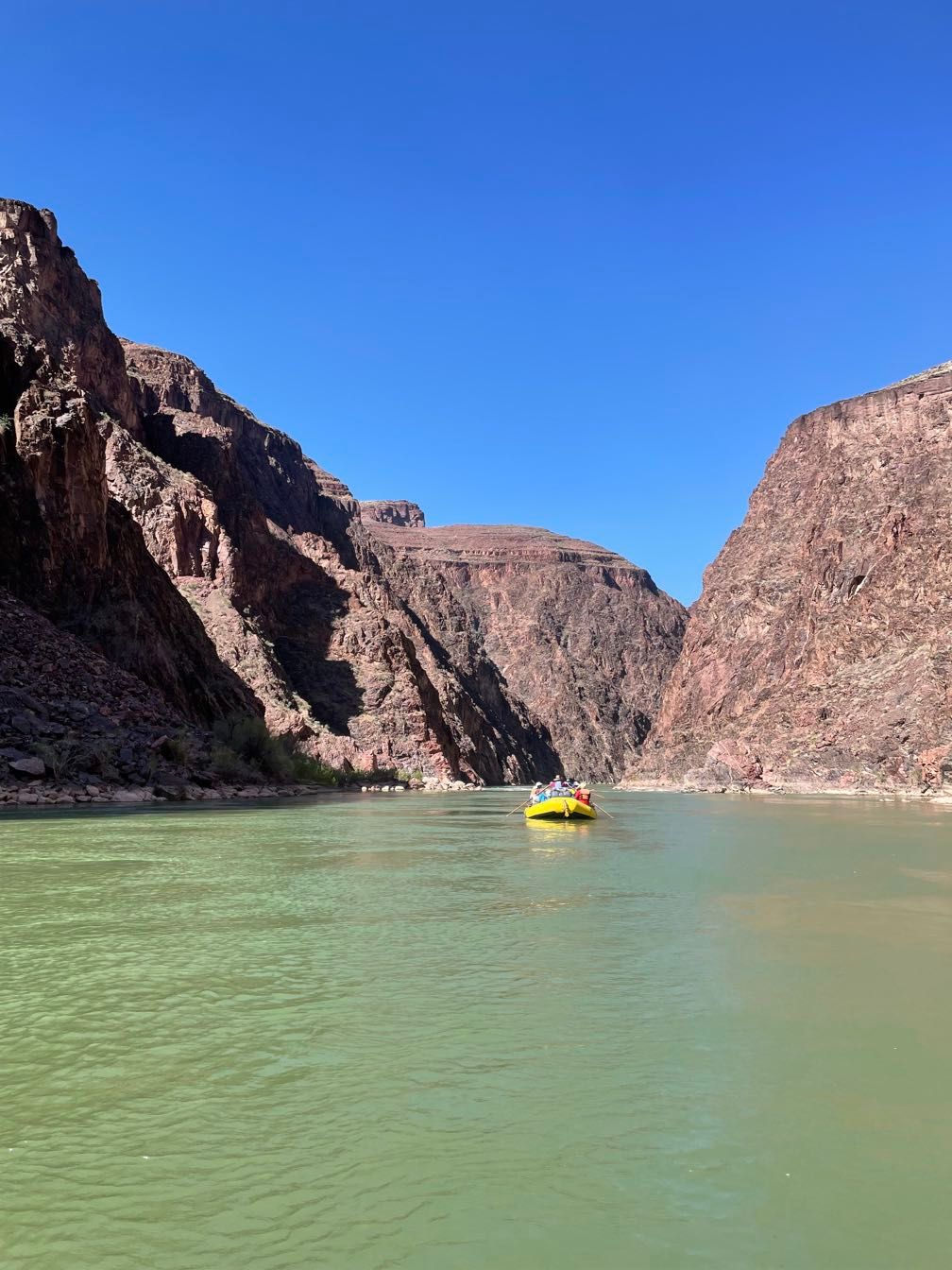 Into the granite gorge
Into the granite gorge
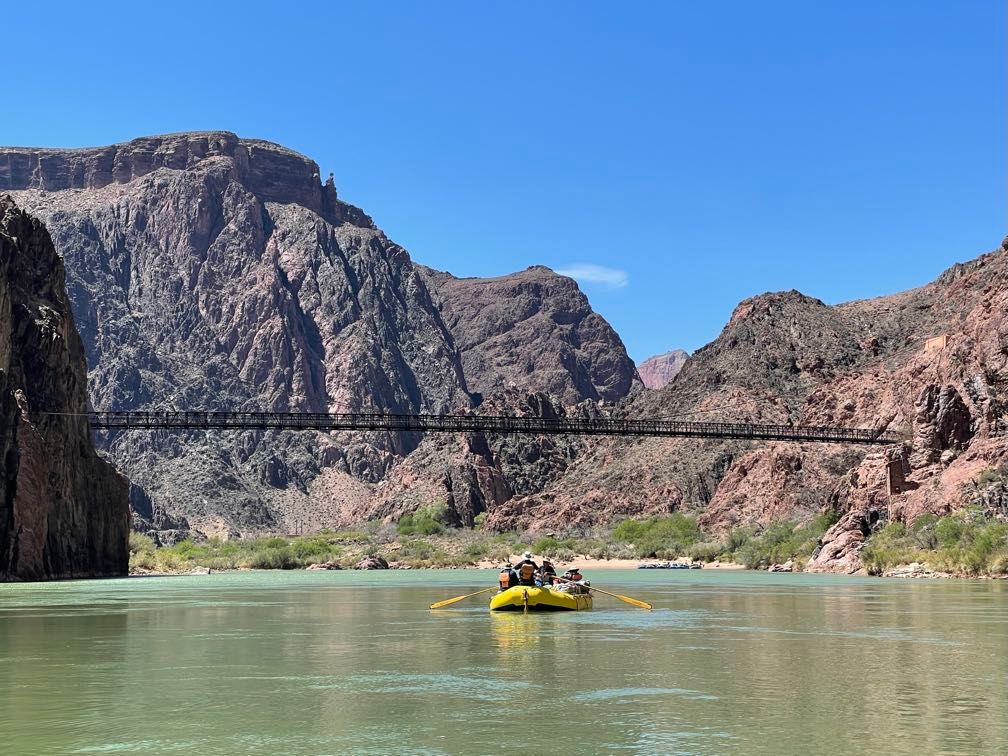 Under the Black Bridge
Under the Black Bridge
Several more rapids, including Sockdolager and Grapevine, brought us to Phantom Ranch. After lunch, some folks headed up to mail postcards and buy t-shirts. My parents and I walked up to the black bridge to look at the National Historic Civil Engineering Landmark plaque. On the way, we passed a deer munching at some vegetation that didn’t seem to be afraid of people at all.
 Deer at Phantom Ranch
Deer at Phantom Ranch
 The Black Bridge
The Black Bridge
Waiting for the rest of our group to make it back, we talked a bit with some hikers down on the boat beach.
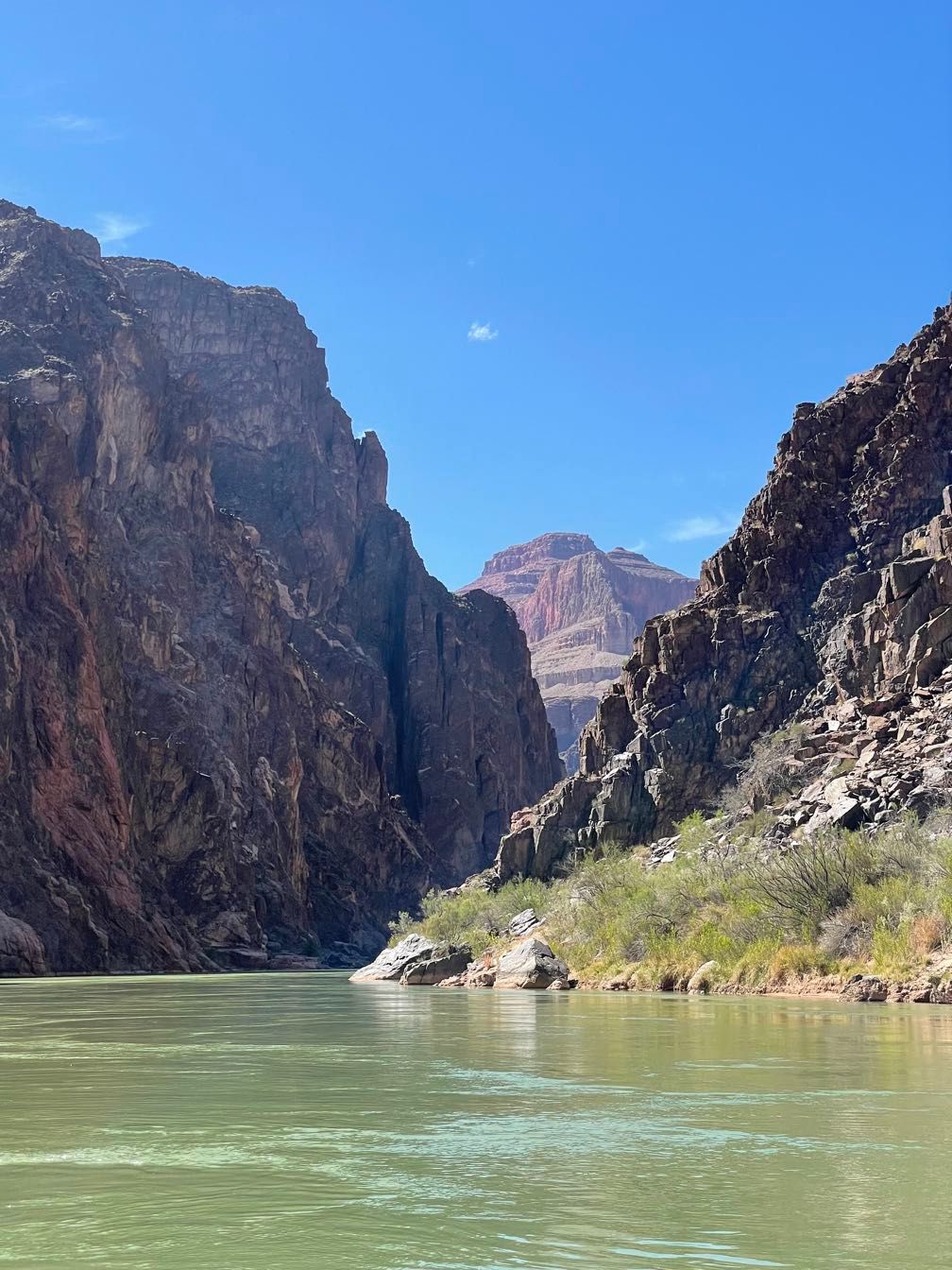 Downriver from Phantom Ranch
Downriver from Phantom Ranch
We got back on river about 2 pm, rafting down to Horn Creek Rapid. The guides spent some time scouting the rapid. We ran between the horns, which involved a 10-foot drop with a sudden stop at the end, followed by a couple of big waves.
Soon after, we landed at Trinity Creek. There we set up camp. My parents and I picked a site in a side canyon, hoping for less wind and sand. Trinity Creek has carved a very narrow side canyon through the schist. I walked a ways up before dinner.
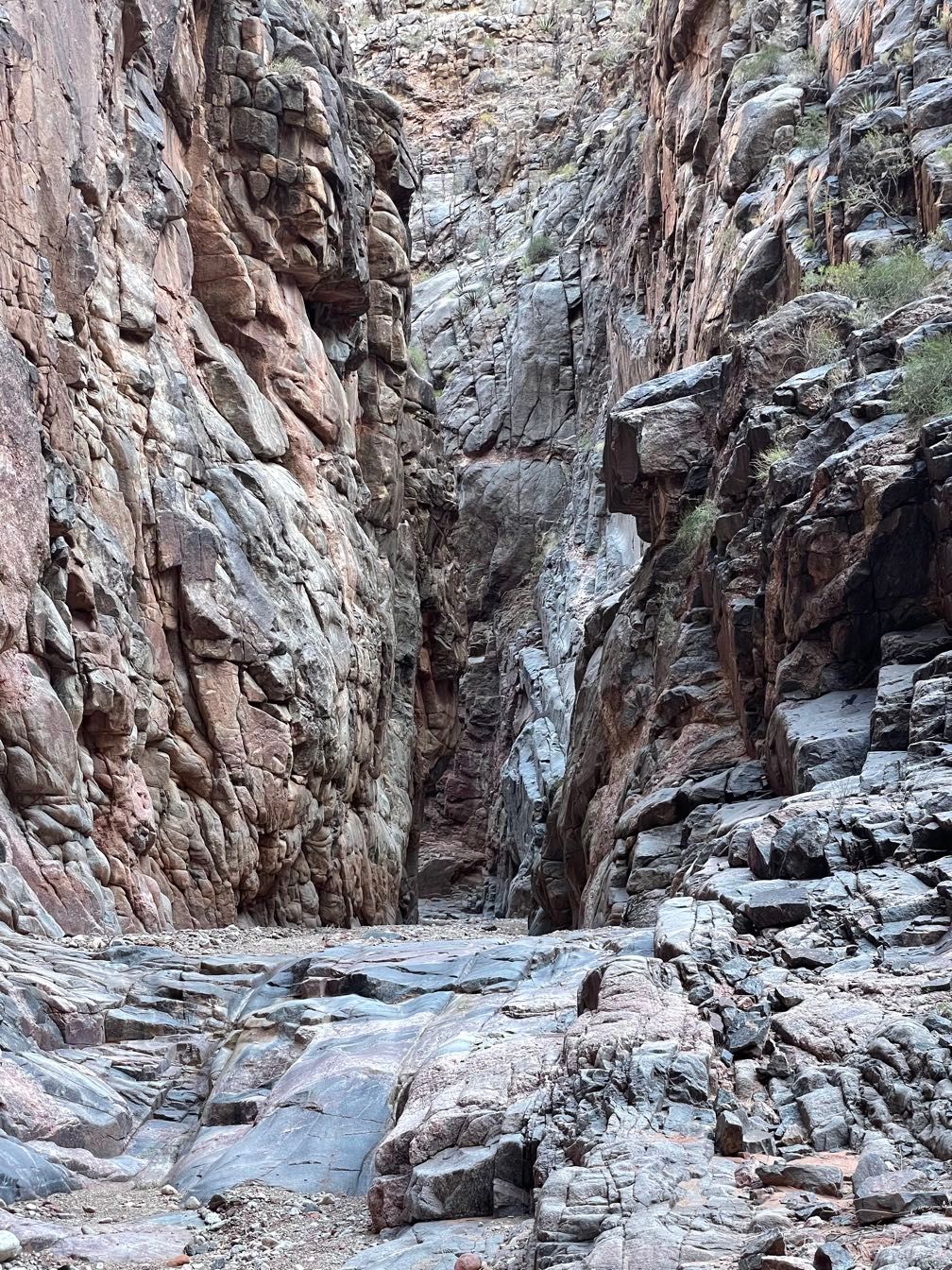 Trinity Creek
Trinity Creek
We enjoyed a nice chicken vegetable curry, and at that point, everyone was about ready to turn in.
Day 9
 The view downcanyon
The view downcanyon
With little wind or blowing sand, this was a much better night’s sleep than the last few. We had a leisurely pack-up. Gary gave us his capsule summary of Grand Canyon geology.
There are three kinds of rocks: flat layer cake, tilted layer cake, and chocolate swirl.
Back on the river in Amy’s boat, the rapids came thick and fast today. Our first big one was Granite. This is actually one I’ve seen from the shore. When hiking the Tonto Trail about 25 years ago, we camped and Monument Creek and walked down to the river here.
 Rowing downriver
Rowing downriver
 Bighorn Sheep
Bighorn Sheep
Granite was the first of many wet rapids today, with water coming at the boat from lots of directions. Shortly after came Hermit Rapid. It was one big wave train with lots of water coming into the boat. Towards the bottom, some of the waves got pretty rough too.
The next big rapid was Crystal. In addition to being wet and particularly rough, this one is tricky. We stopped for the guides to scout, and they spent a good bit of time talking about its characteristics before running it. Amy threaded between the two big holes at the top and took us down with a wet but safe ride.
 Crystal Rapid
Crystal Rapid
In less than a mile came Tuna, Lower Tuna, and Nixon Rock rapids in quick succession. Next up were the gems: Agate, Sapphire, Turquoise, Emerald, Ruby, and Serpentine (ASTER). The first three were splashy but not a bad ride. Emerald got kind of rough. Ruby and Serpentine had some hard hits. I could feel the boat bending between the rubber part where I was sitting and the front of the frame.
This brought us to Ross Wheeler camp, named for a metal river running boat abandoned here in 1915 and dragged up above the high water mark. The guides talked a bit about the boat and its history. The wind picked up again. After observing a huge sand cloud get blown up at Inscription Camp, the next campsite downstream, we made an early camp here.
 The Ross Wheeler
The Ross Wheeler
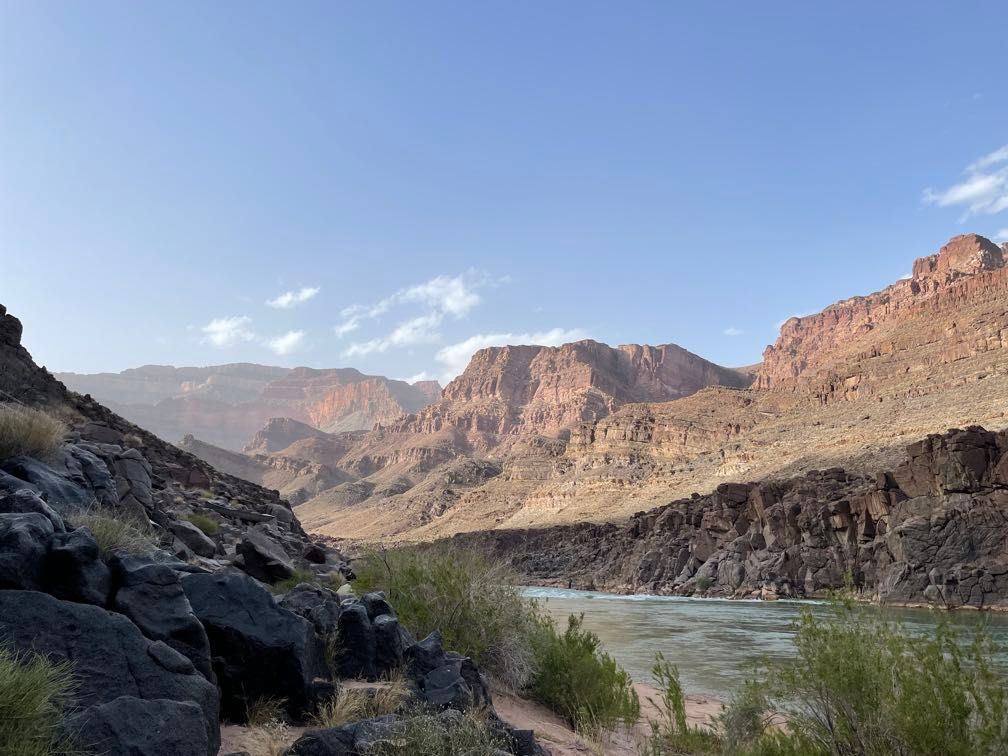 View from camp
View from camp
It was windy at times during the evening, but we had a fine dinner of Greek chicken.
Day 10
Thankfully, the wind died down quite a bit overnight. It was barely cool in the morning and felt like it would probably be a hot day.
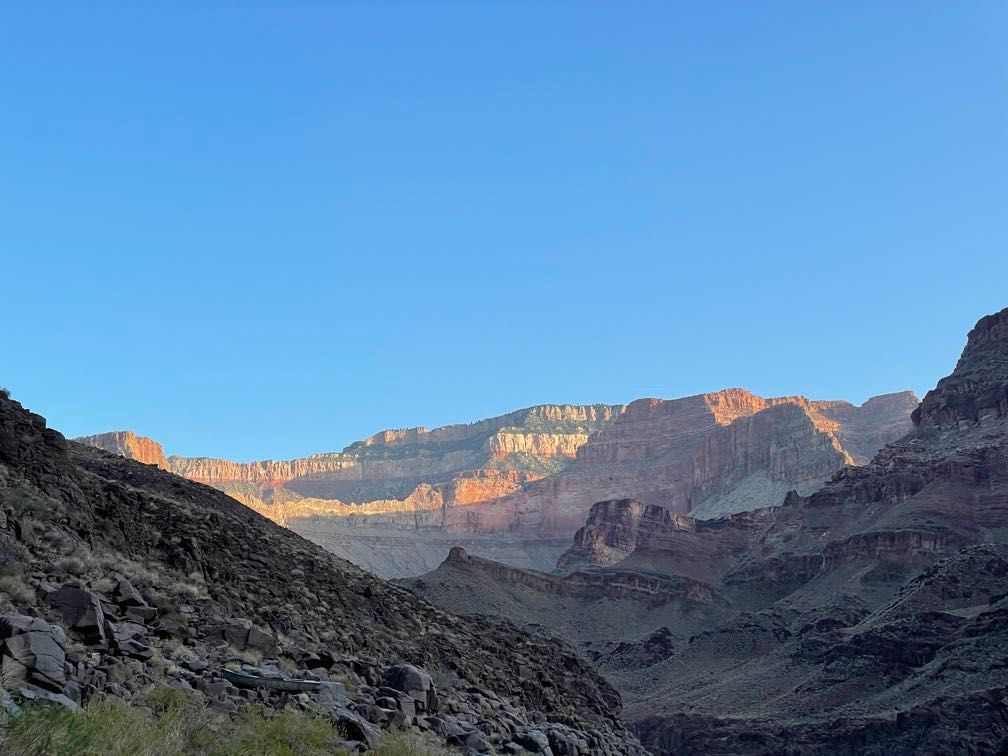 Morning light
Morning light
In addition to the usual fare, we had chocolate eggs for breakfast, as it was Easter. After breakfast, Gary did his best Bob Ross impression, drawing the rock layers in the scene before us on a whiteboard as part of his geology lecture.
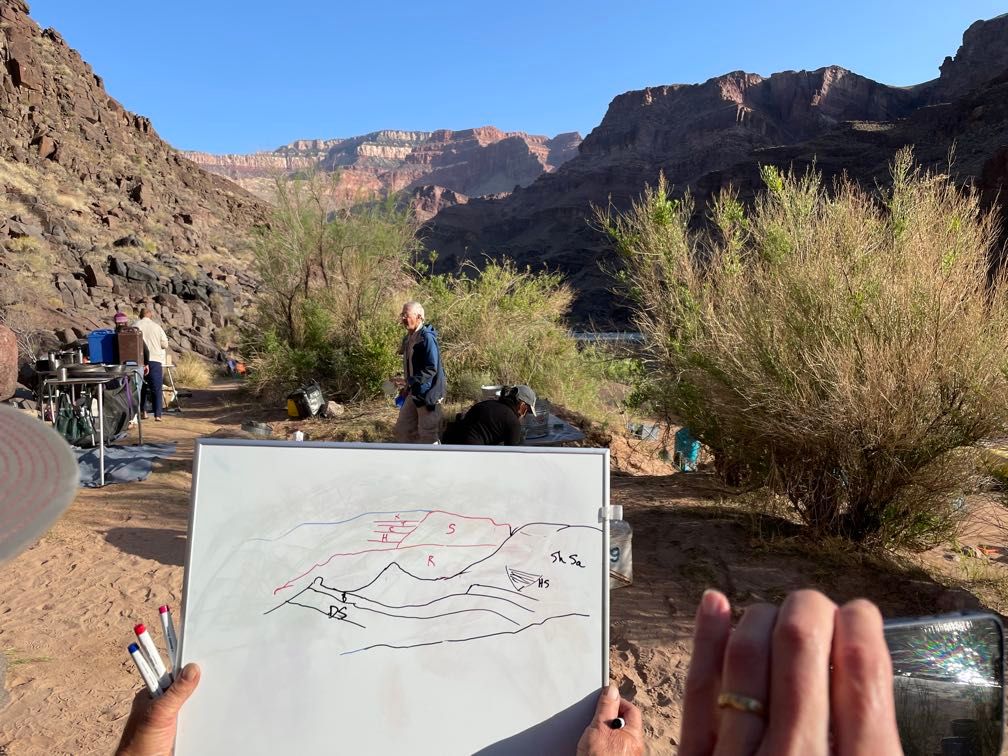 View from camp
View from camp
We loaded up the boats (riding with Leo today) and headed downriver a short way through Bass Rapid to Inscription Camp. There, a well-carved inscription reads Geo. W. Parkins Washington D.C. 1903. For many years, no one had known who Parkins was, but my Dad had done the painstaking research and identified him. He also figured out that in 1903 Parkins had been in the canyon as part of the surveying work on the Matthes-Evans Map (the first topographic map of Grand Canyon).
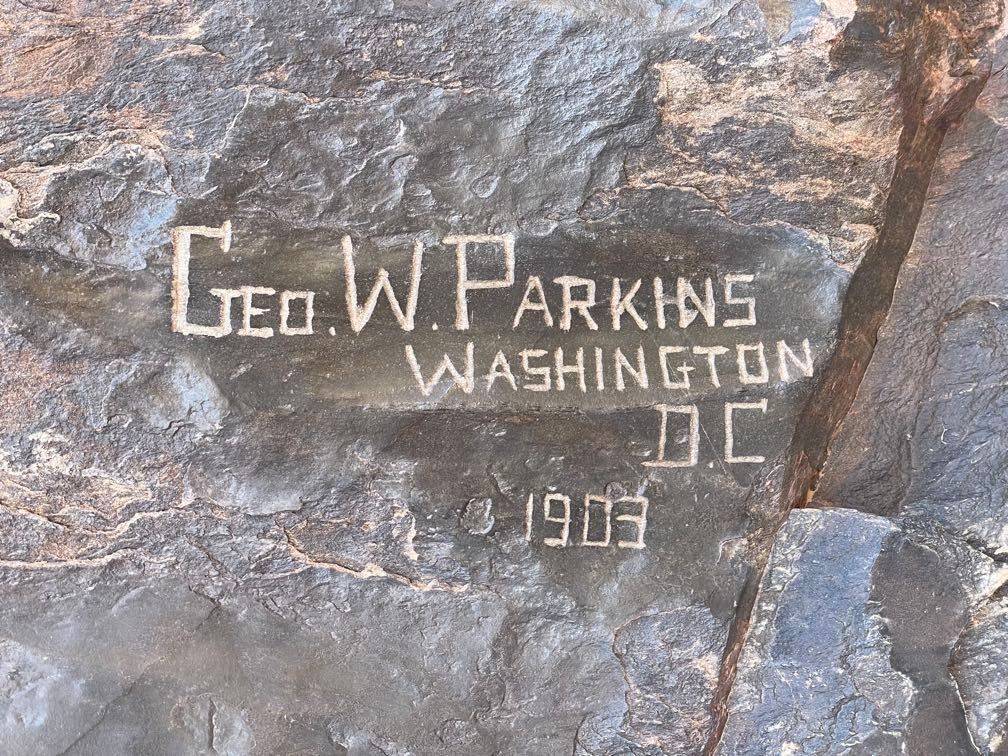 The Parkins inscription
The Parkins inscription
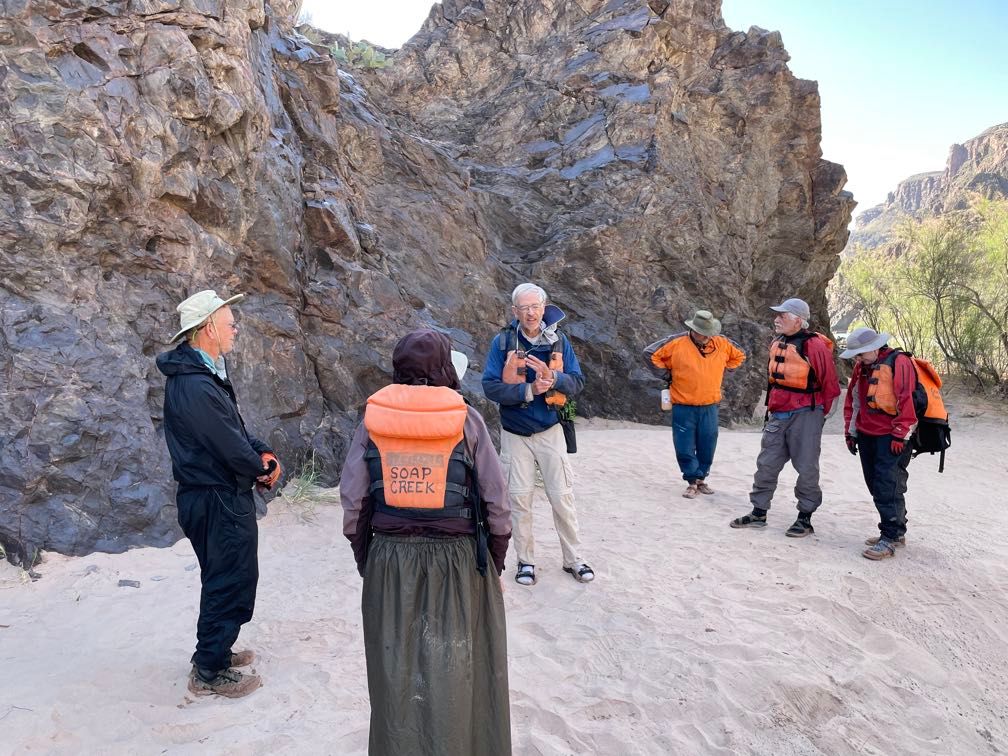 Dad talking about the inscription
Dad talking about the inscription
Leo gave us a very smooth run through Hakatai Rapid. Further downriver, Waltenberg Rapid was much more of a ride, with a significant drop and a series of big waves.
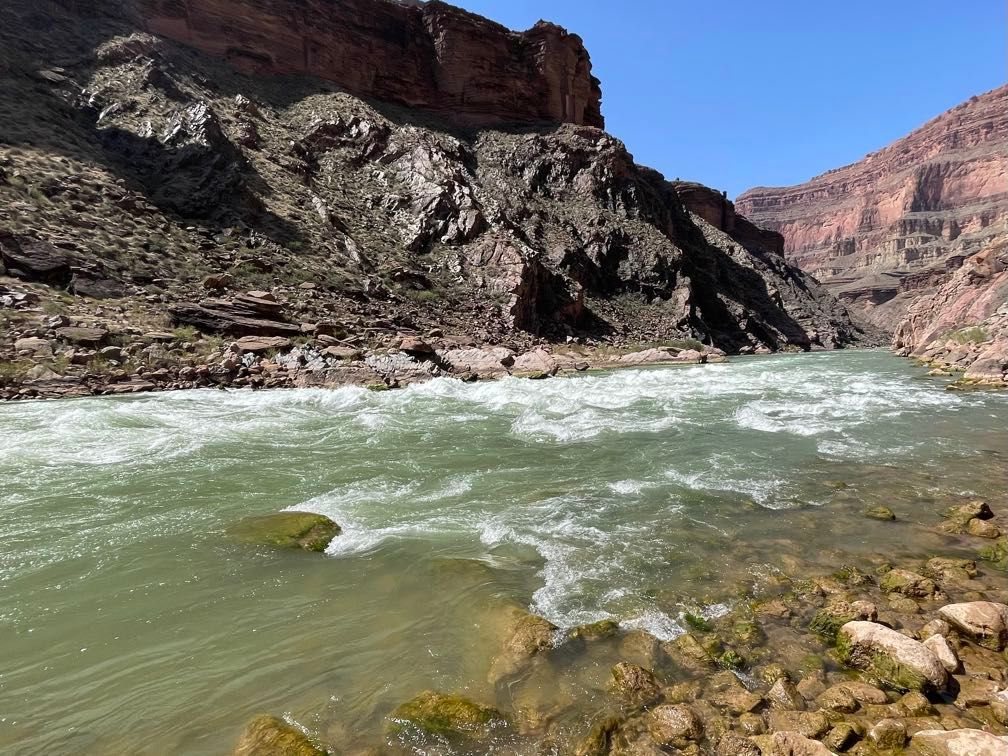 Waltenberg Rapid
Waltenberg Rapid
This took us to a pull-off just below Garnet Canyon. We scrambled up about 20 feet through an arch in the schist (my Mom decided not to attempt this). From there, it was a mile or so of walking in the heat along a trail back upstream to Garnet Canyon proper. Up canyon a bit, we rested in a shady alcove while Gary talked about the geology of what we were seeing.
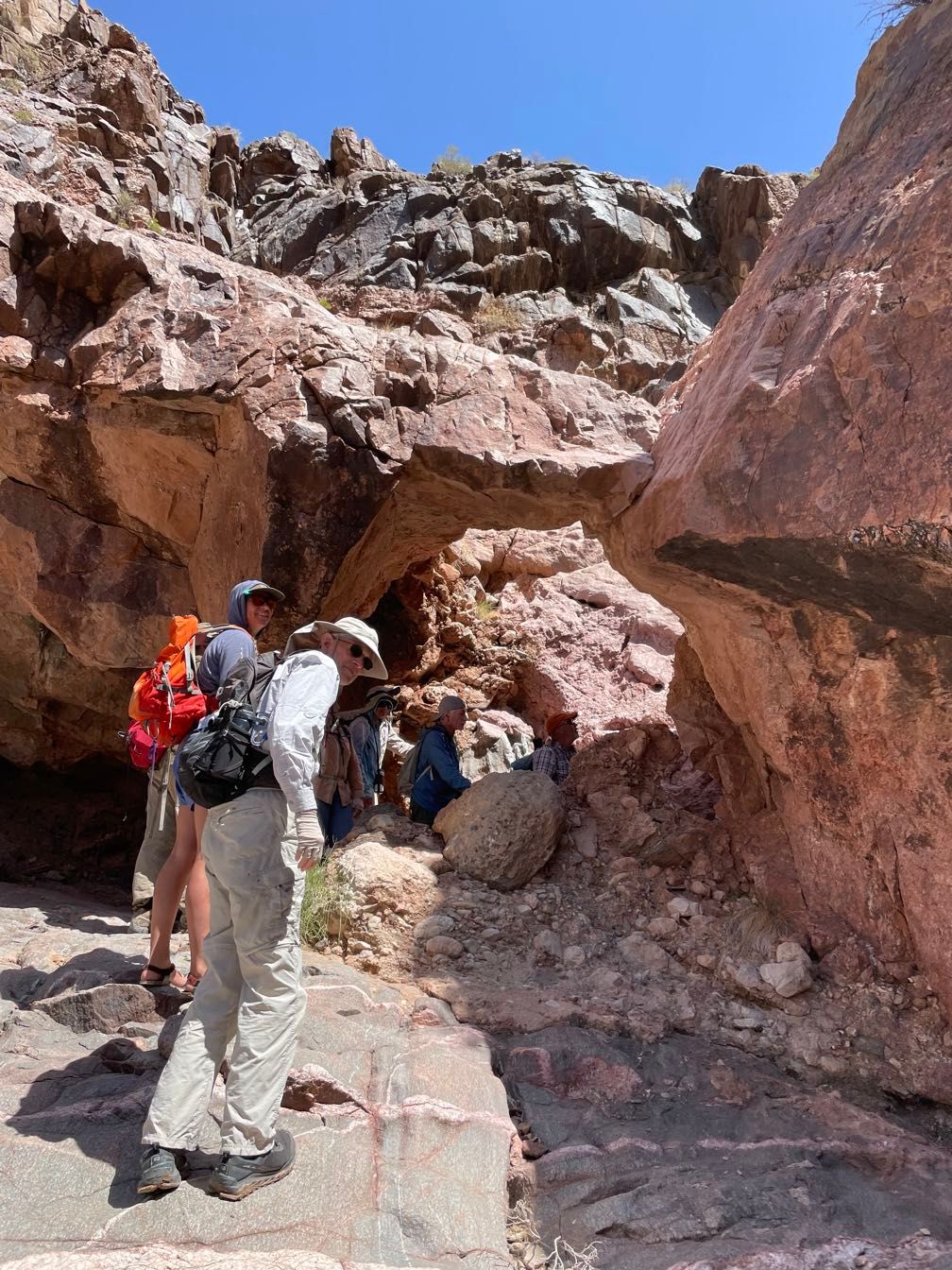 Scrambling up the arch
Scrambling up the arch
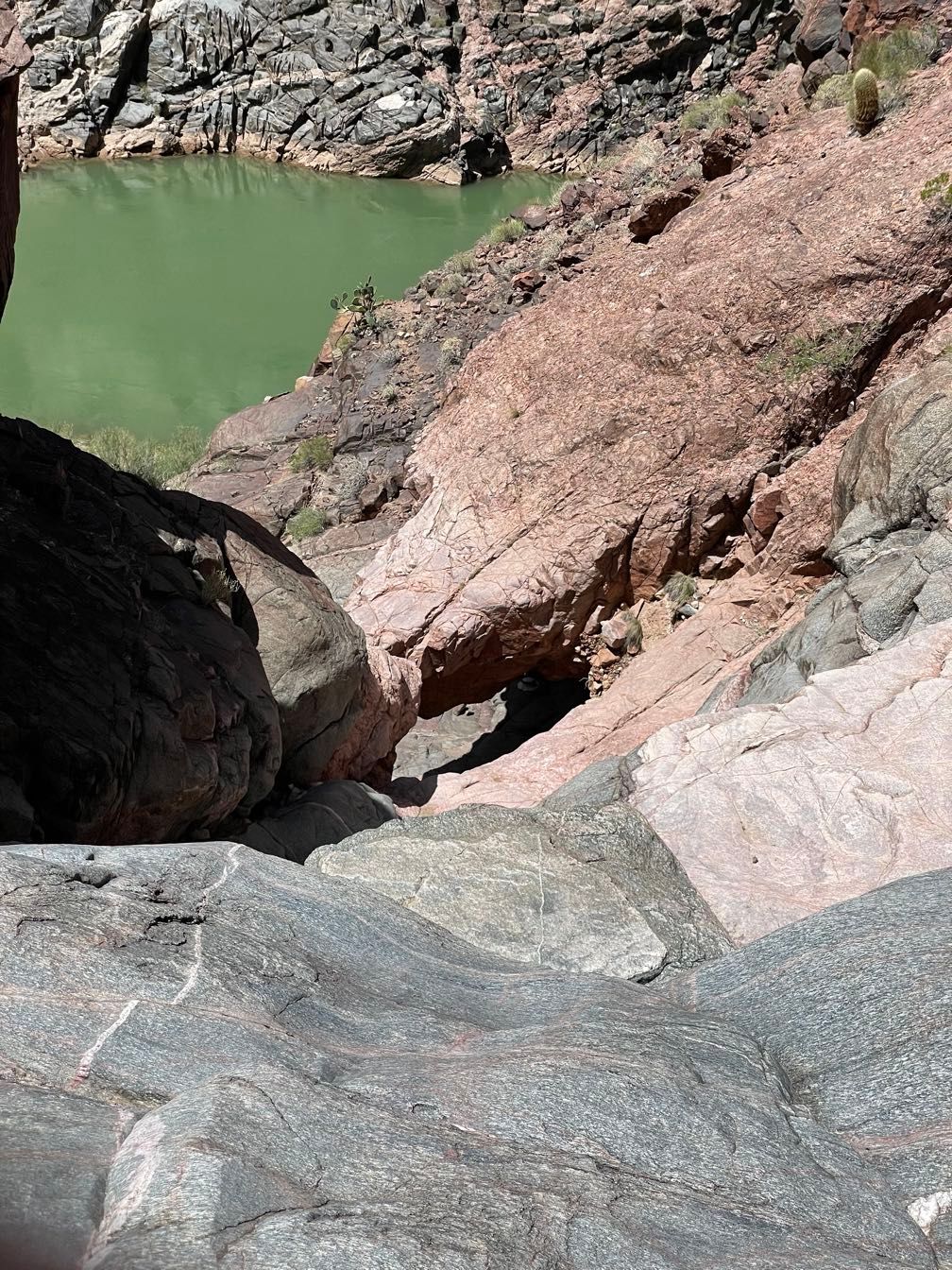 The arch from above
The arch from above
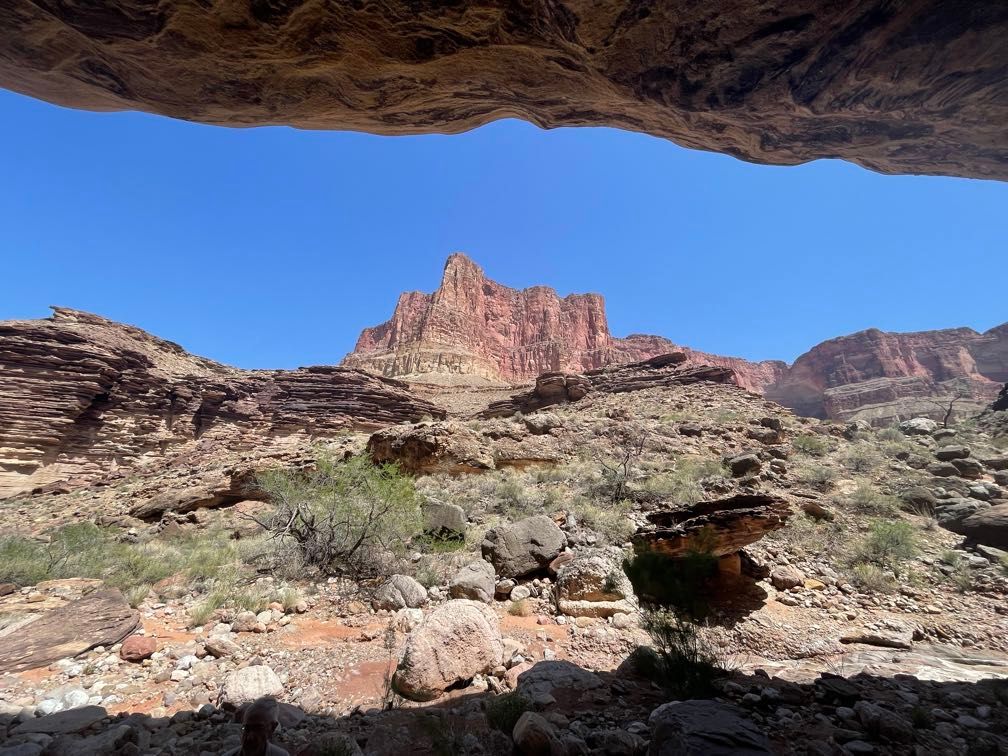 Looking out from the alcove
Looking out from the alcove
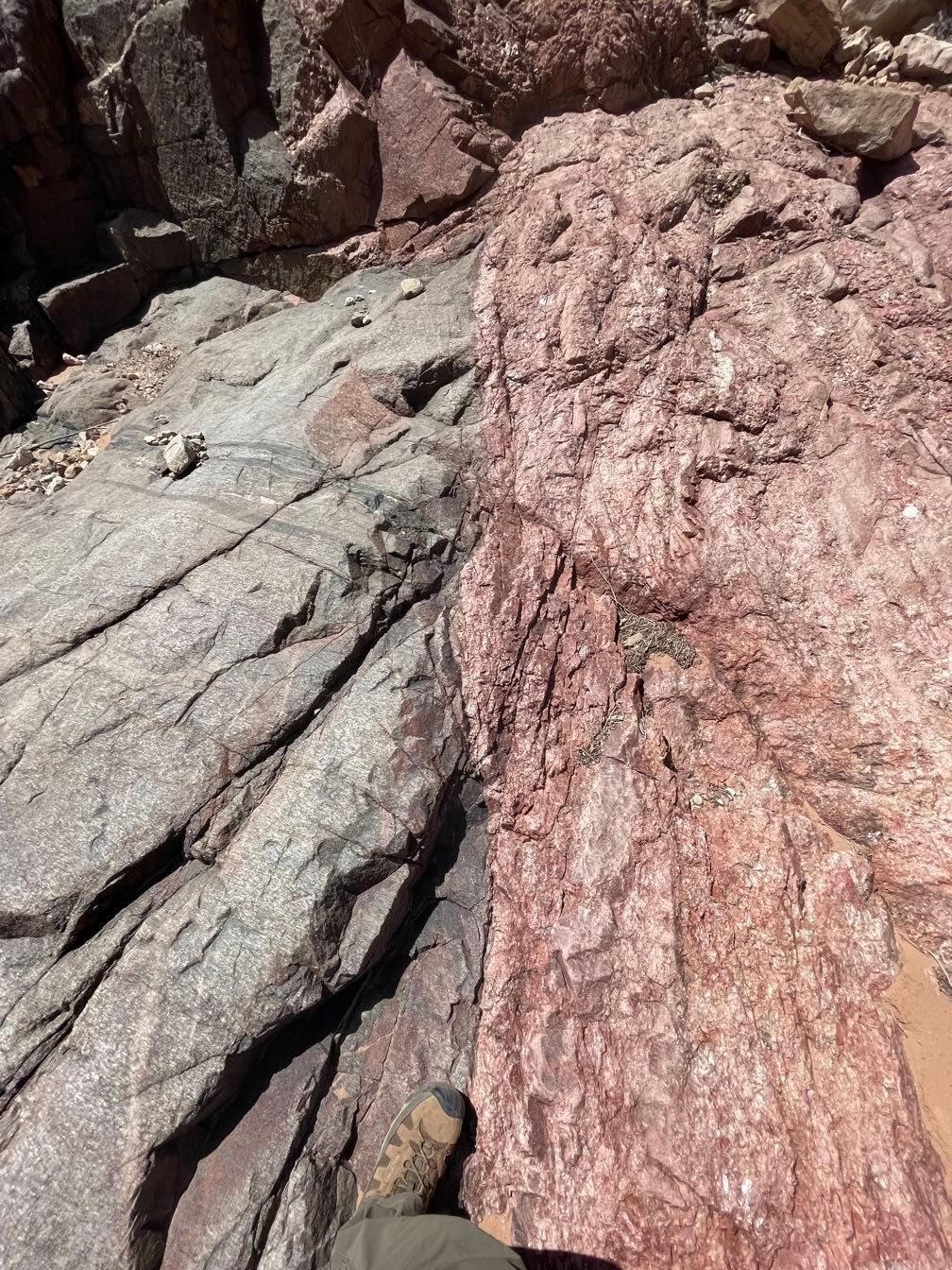 Schist and granite
Schist and granite
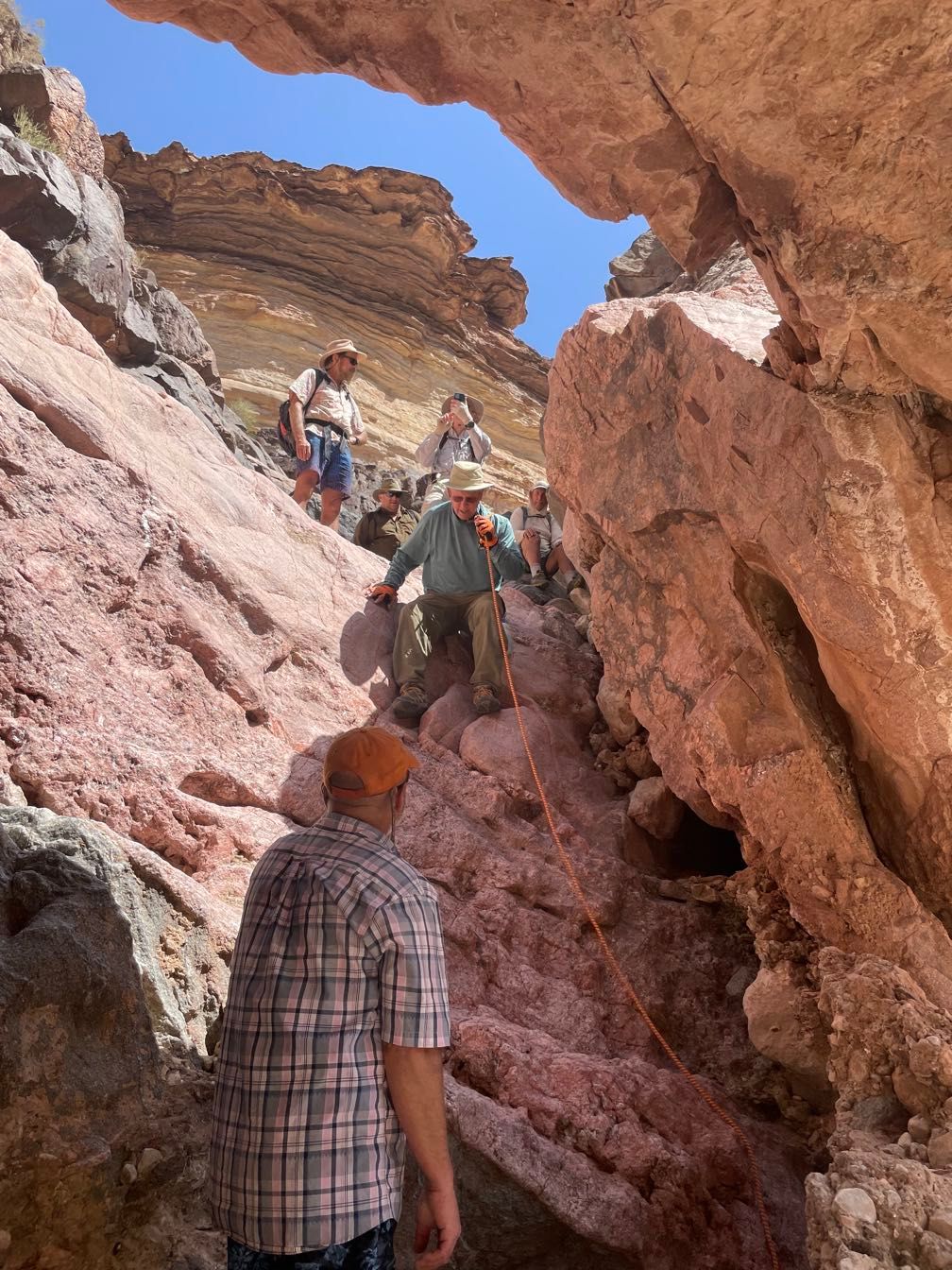 Scrambling down
Scrambling down
We walked back, scrambled down with the help of a rope, and got back to the boats for a late lunch. We pushed off downstream, and Leo let me row through a couple of riffles to Elves Chasm. I did take us on a detour through one eddy, but other than that, I think I did OK for a newbie. I did wear a nice blister on my hand through. I guess I don’t have the proper calluses.
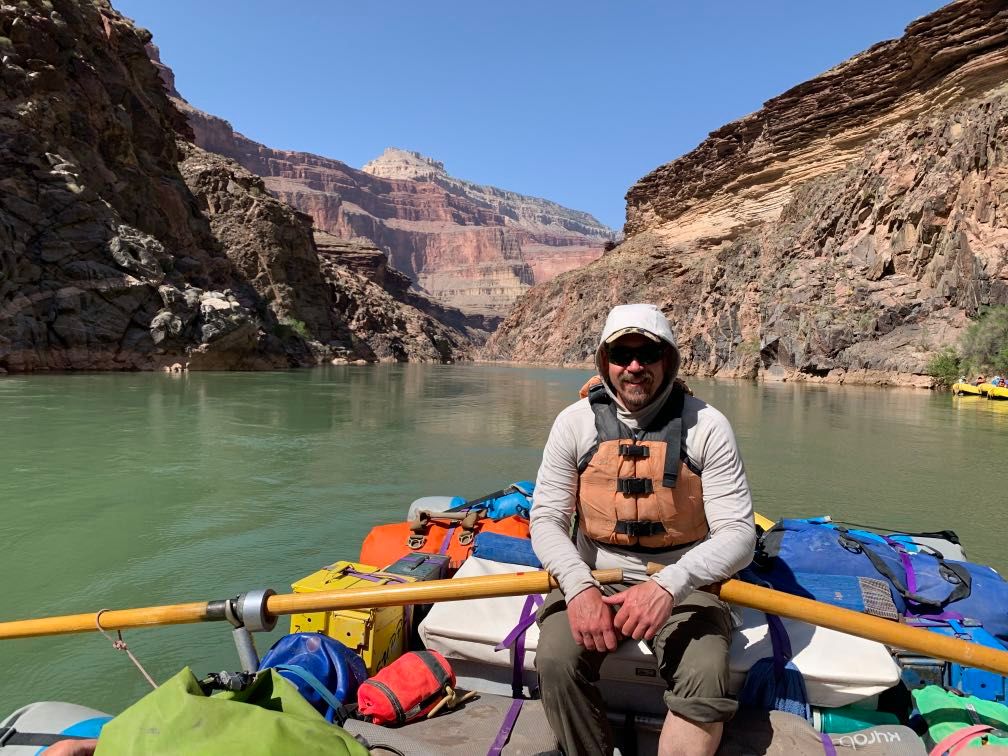 On the oars
On the oars
Elves Chasm is a short, scrambly hike ending at a beautiful waterfall. You can swim across the pool below and make a slippery climb up a cave behind the waterfall to reach a spot where you can jump through the fall into the pool. With a bit of trepidation, I emptied my pockets, swam the pool, climbed up the cave, and made the leap.
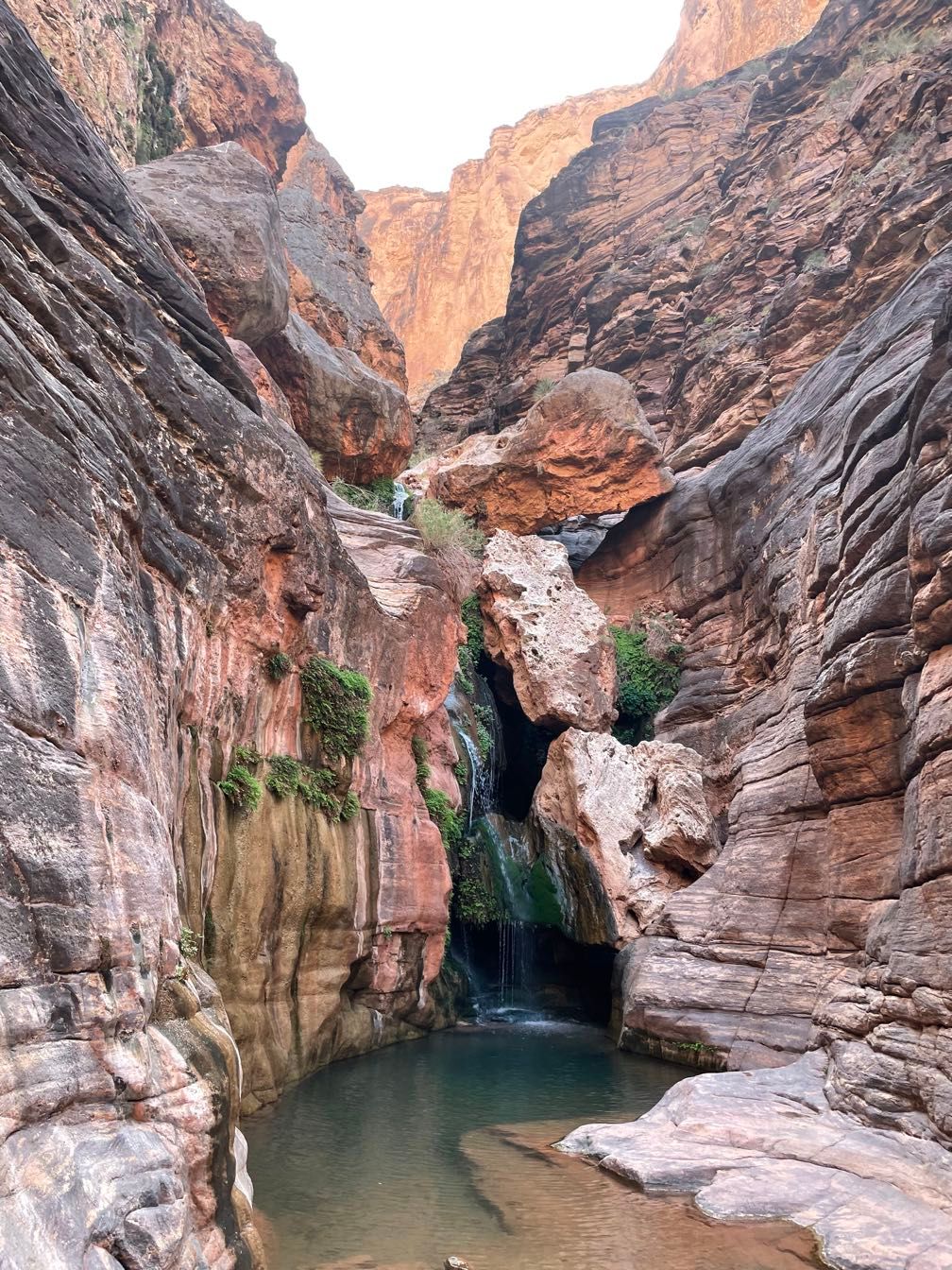 Elves Chasm
Elves Chasm
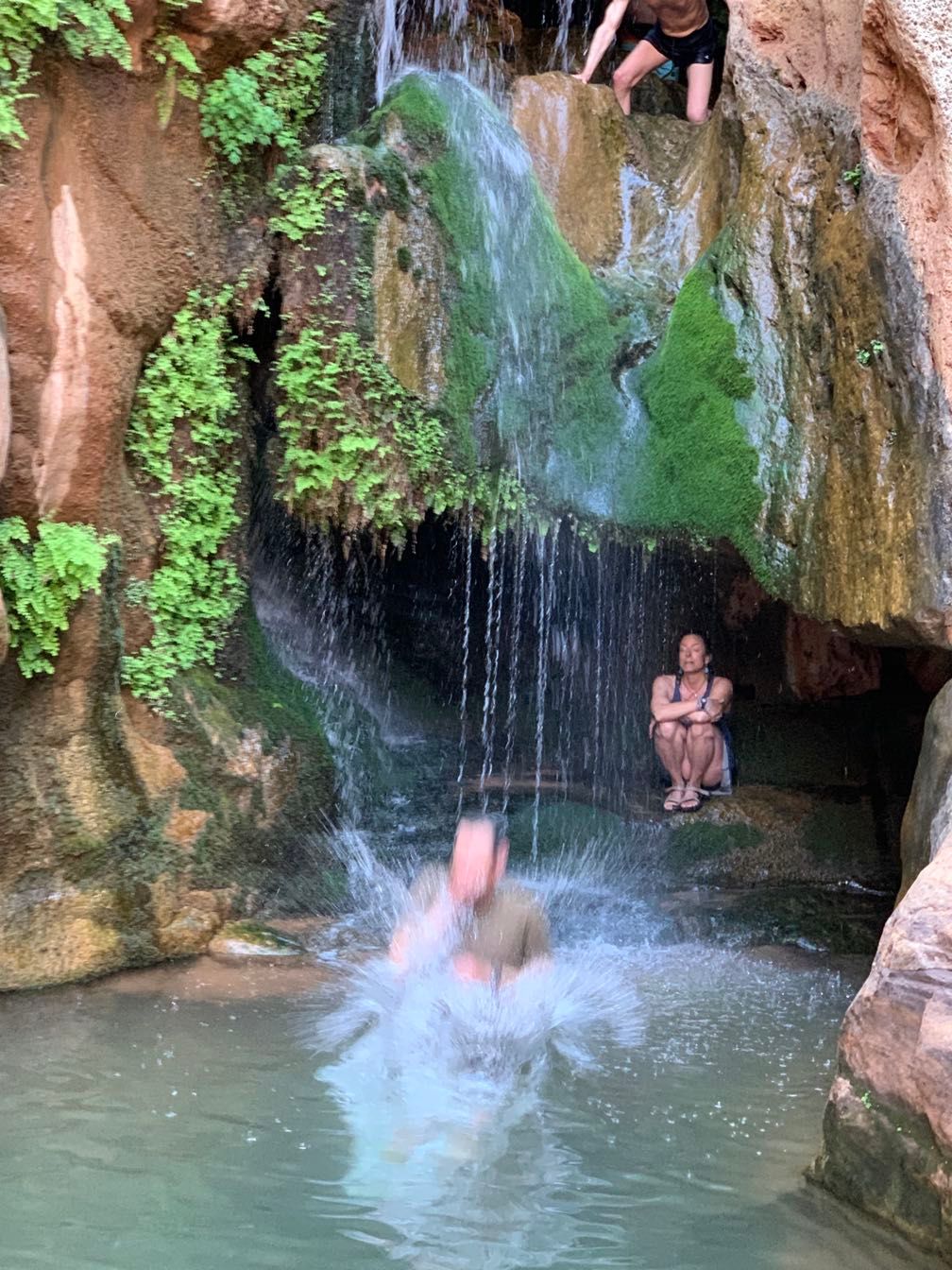 Made the leap
Made the leap
 Reflections on the river
Reflections on the river
I was pretty wet after that, but the day was hot enough that it felt pretty good. We made the short walk back to the boats, then a short float down to Big Dune camp. We enjoyed a jambalaya dinner, and Leo told some great stories around the campfire.
Day 11
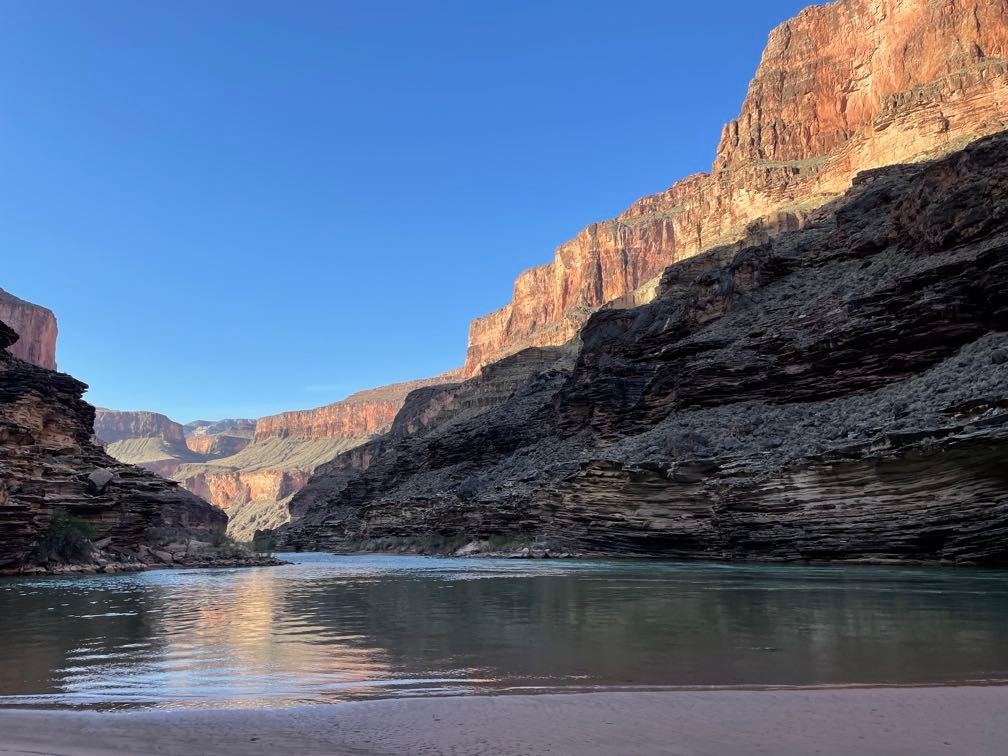 Morning at Big Dune
Morning at Big Dune
Starting on Gary’s boat, we rafted a short way downstream to Blacktail Creek and hiked up. Gary talked for a bit about the deposition of Tapeats Sandstone, Bright Angel Shale, and Muav Limestone, including how the order of deposition relates to the changing shoreline of an ancient sea.
 Blacktail Canyon
Blacktail Canyon
 Gary talking about geology
Gary talking about geology
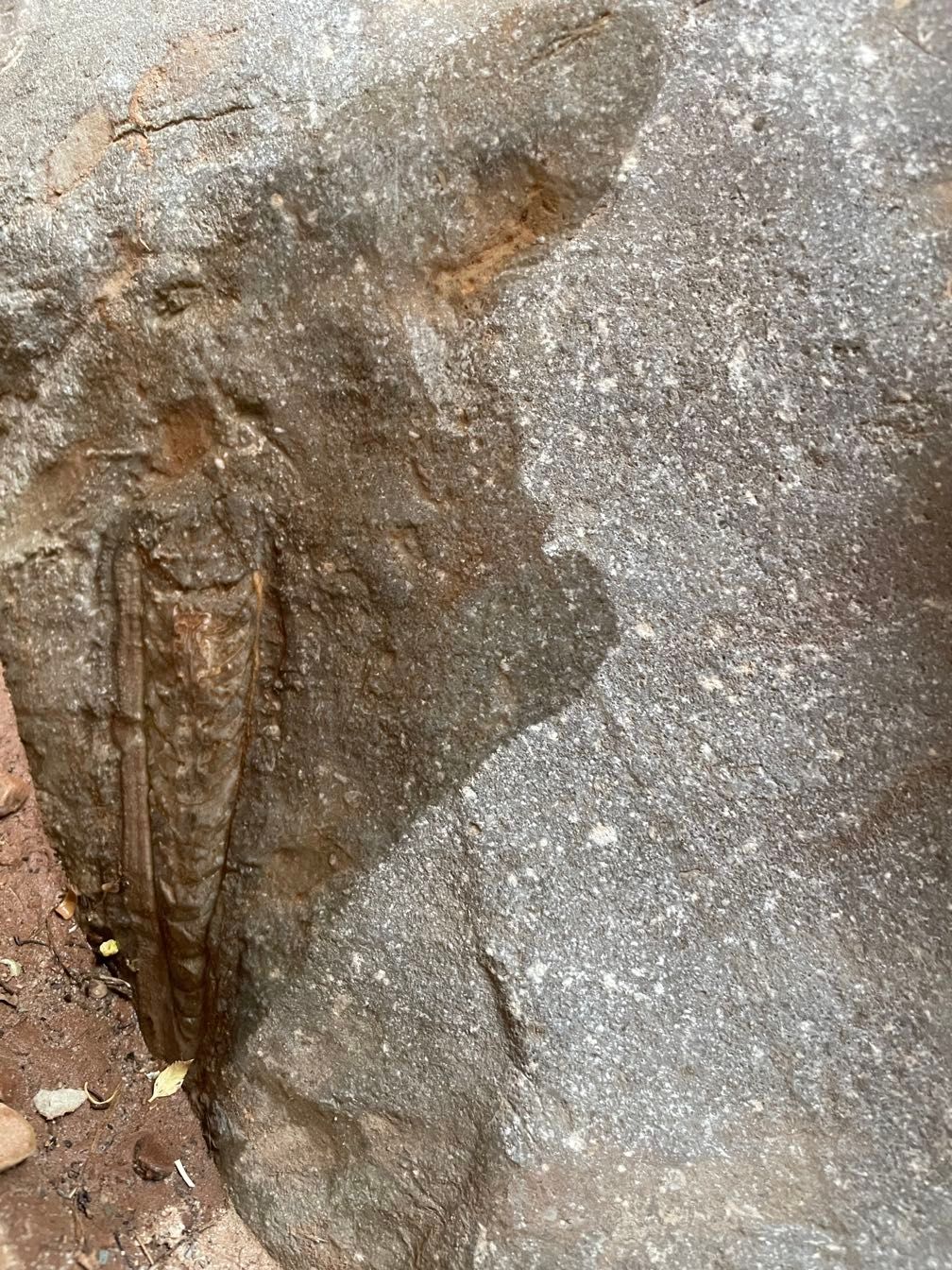 A fossil
A fossil
He suggested that we continue our hike upstream to a small waterfall in silence. Hiking quietly up the narrow slot canyon in the Tapeats was a pretty neat experience. The waterfall was lovely.
 Waterfall in Blacktail Canyon
Waterfall in Blacktail Canyon
 Looking up
Looking up
 Walking down Blacktail Canyon
Walking down Blacktail Canyon
Partway back downcanyon Leo serenaded us again with his Ukulele. Sherri spent a bit of time talking about the Ancestral Puebloan archeological site near the mouth of the canyon. Amy got in on the action by talking about a science project she’d been involved with on how varying water releases from Glen Canyon Dam affected the population of certain insect species that breed at the water’s edge.
 Looking up from Blacktail Canyon
Looking up from Blacktail Canyon
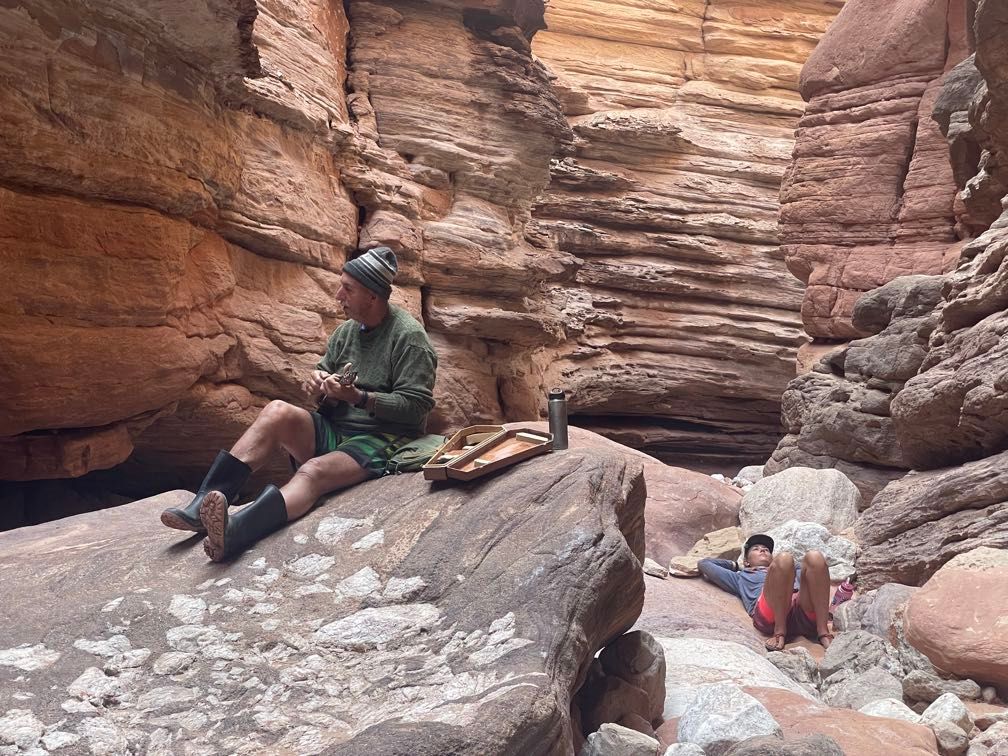 Leo with his Ukulele
Leo with his Ukulele
 Amy talking about insect life
Amy talking about insect life
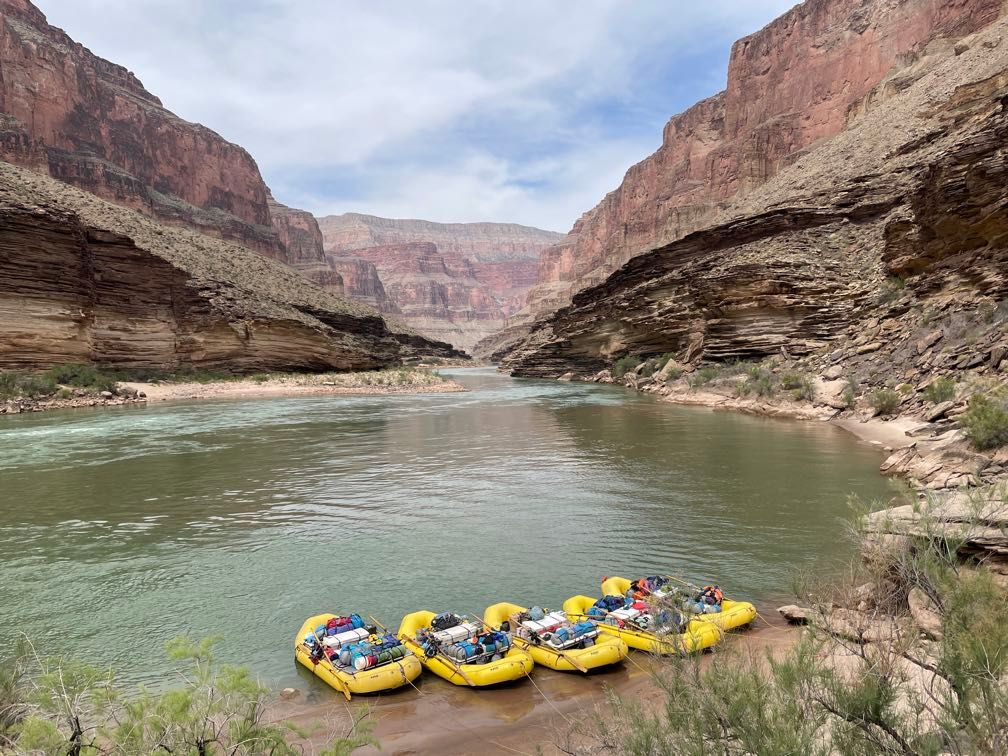 Boats at the mouth of Blacktail Canyon
Boats at the mouth of Blacktail Canyon
After walking back to the boats, we rafted downstream. We spotted a tall cairn up on top of the Muav Limestone that was used during the making of the Matthes-Evans topographic map of the canyon.
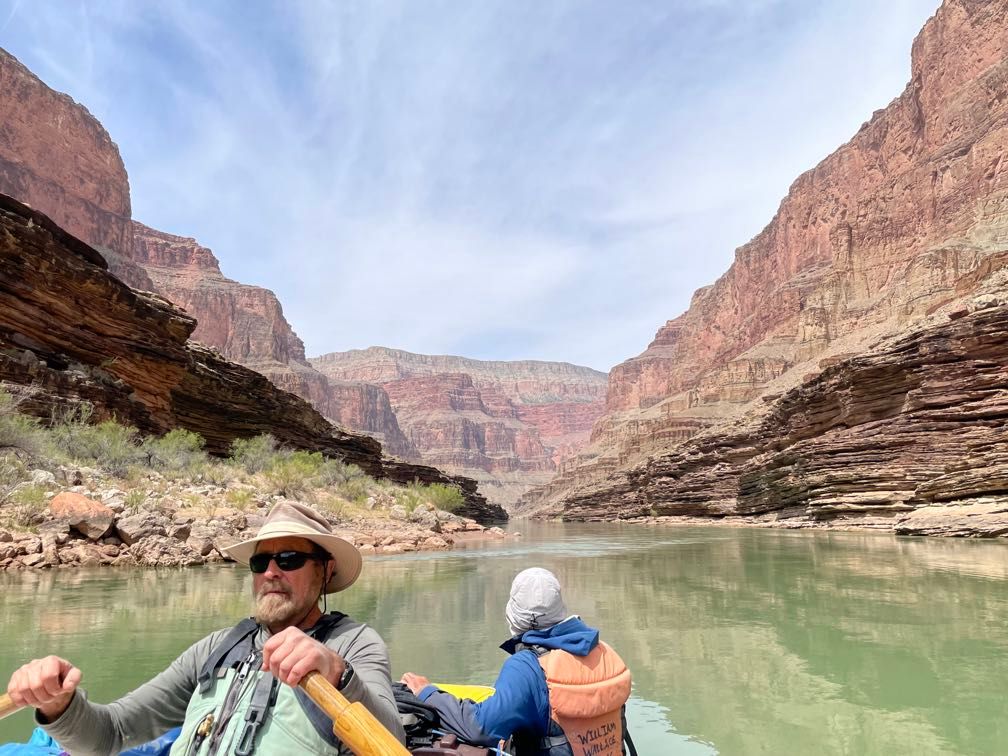 Rowing downriver
Rowing downriver
I caught a big wave in the face at 125 Mile Rapid and several more in Fossil Rapid. After stopping for lunch below Fossil, we got some more big water at Specter Rapid.
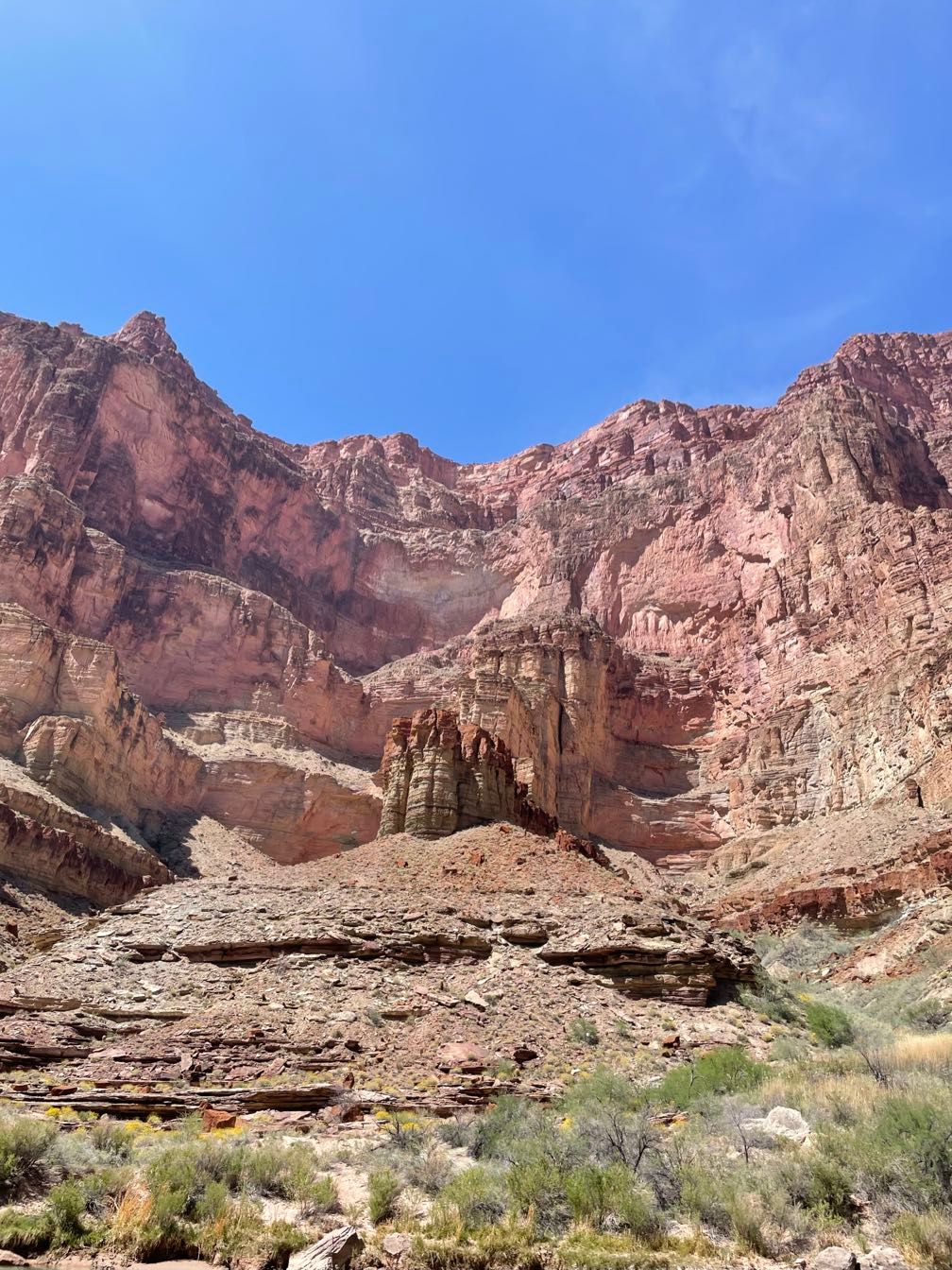 Red rocks
Red rocks
 Black rocks
Black rocks
We stopped at Bedrock Canyon and hiked upstream. Mostly an easy walk, but one section required some hand and foot scampering up an exposed ledge about 20 feet off the ground. My Mom opted out of that very quickly. Above the scramble, we walked a bit further to a trickling 18-foot waterfall.
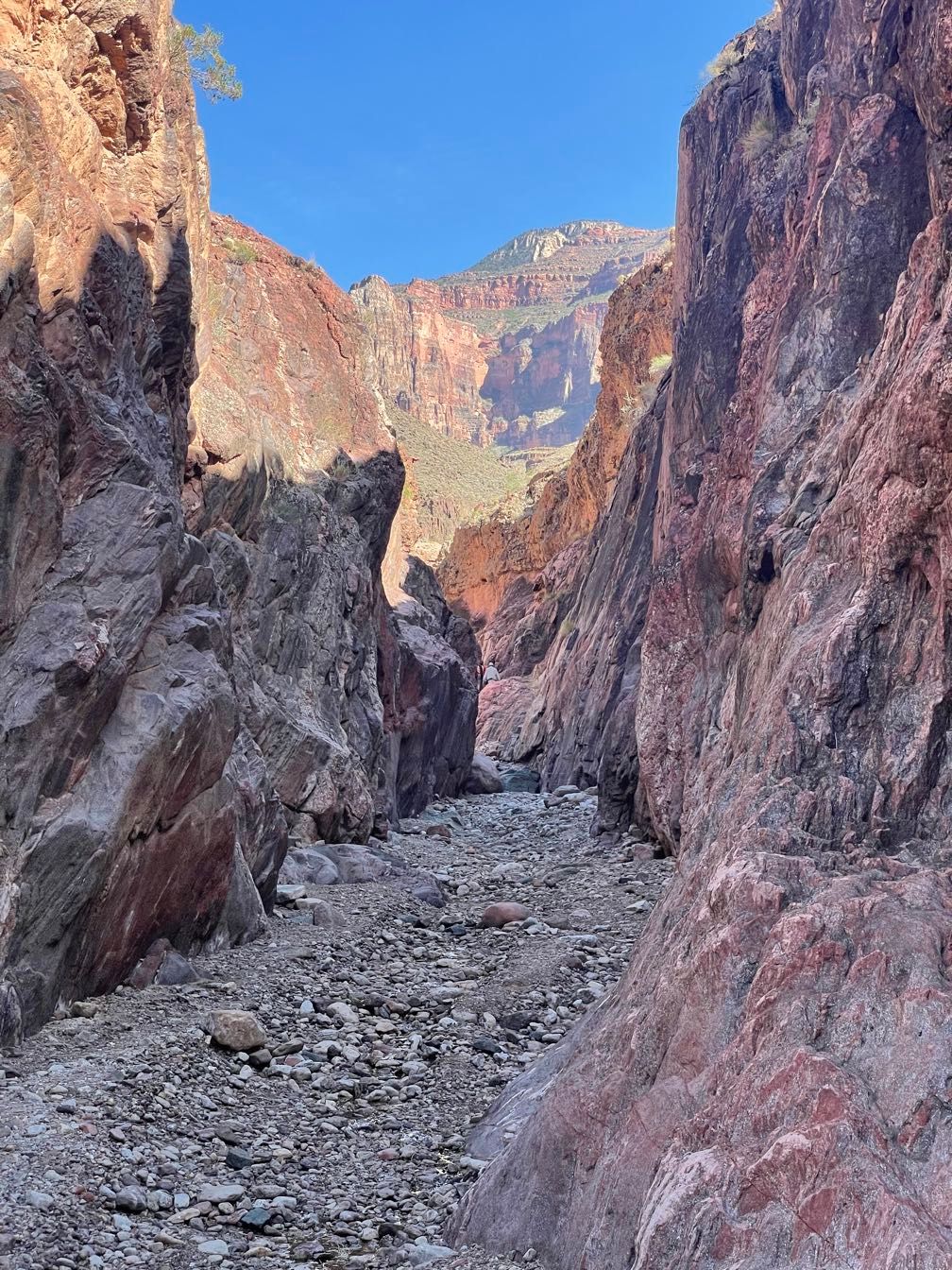 Bedrock Canyon
Bedrock Canyon
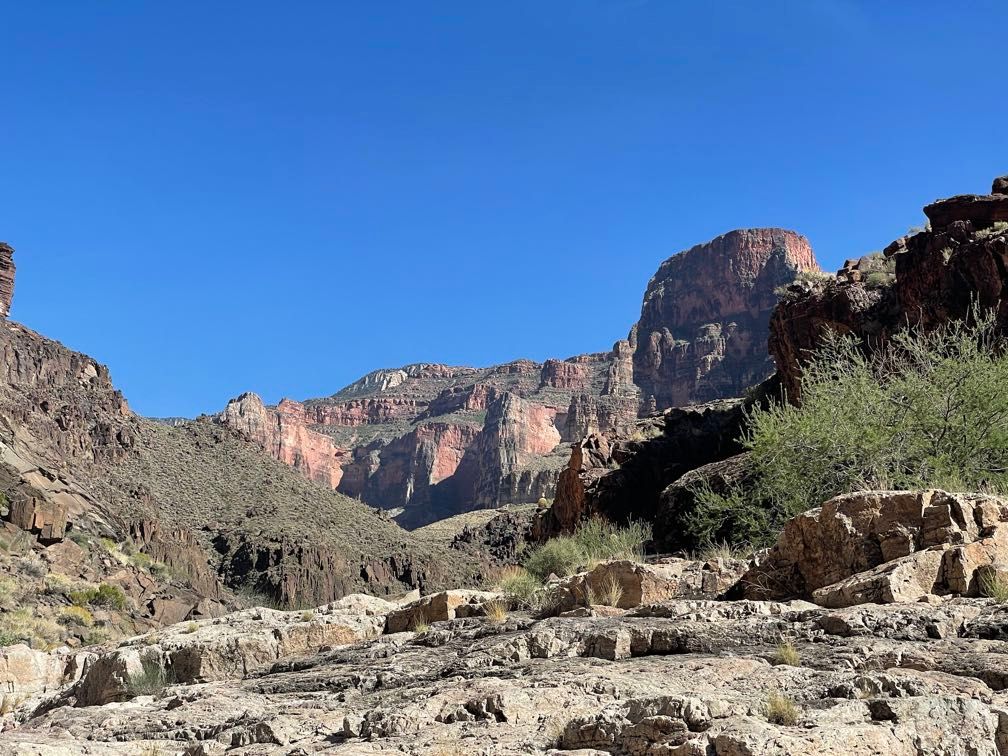 Looking up at the rim
Looking up at the rim
 Waterfall in Bedrock Canyon
Waterfall in Bedrock Canyon
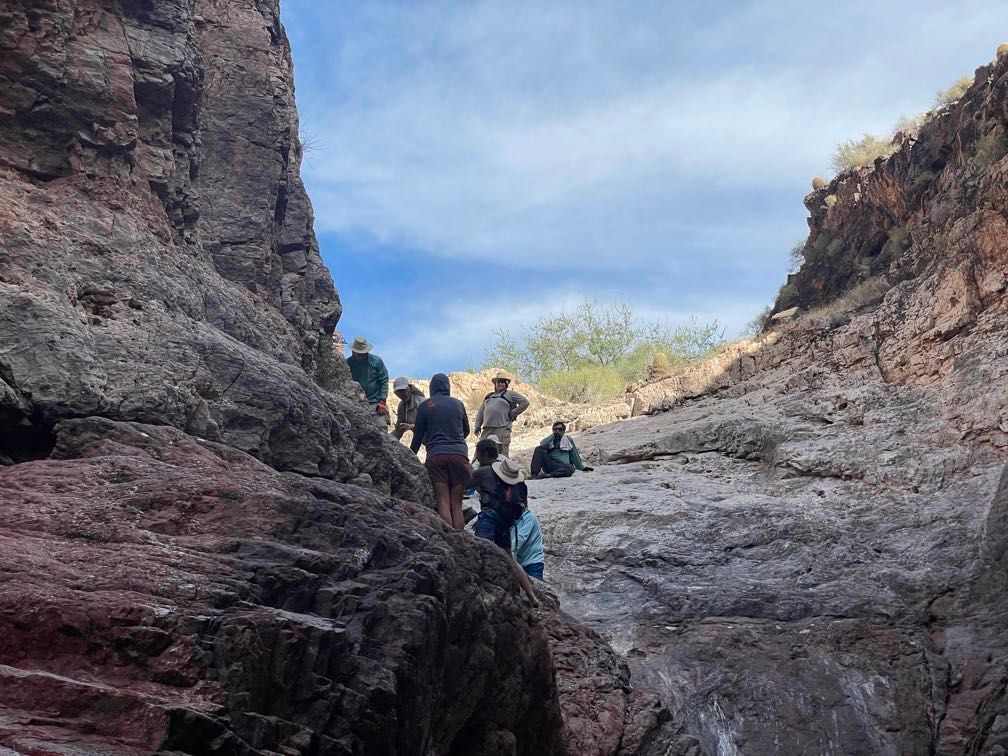 Coming down the scrambly bit
Coming down the scrambly bit
Back at the boats, we pushed off and ran Bedrock Rapid. This rapid has a big island in the middle, and while the current wants to push you left, you really want to get to the right of it. Sequoyah got swept down the left channel. This took her into an eddy where a boat can get smacked against vertical rock walls. As she told us later, she broke one oar and an impact jammed the oarlock of her remaining oar. She was able to free up the jammed oarlock with a hammer, replace the broken oar with a spare, row herself out of the eddy and get past the island without getting flipped (which happens to many boats that take the left channel). Truly an impressive performance.
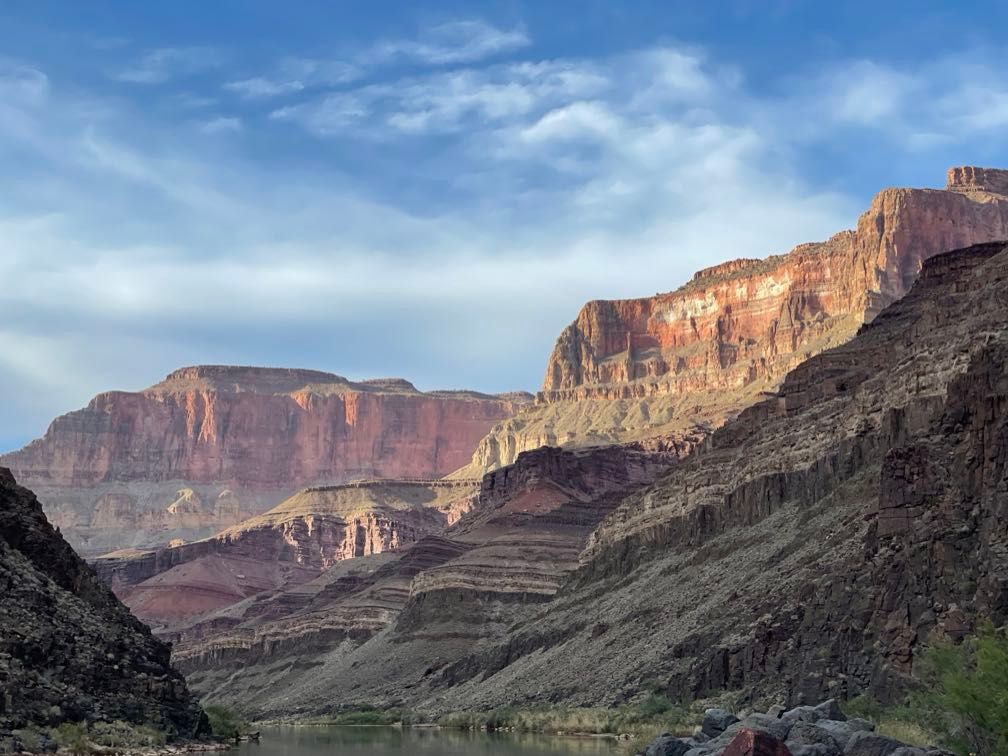 Evening light at Diabase Camp
Evening light at Diabase Camp
After that excitement, we rafted down to Diabase Camp, a short way downstream. We had a great dinner of pork tenderloin. We also had a guest for dinner: a fat little mouse going after our crumbs. Despite river rafters’ best efforts to ensure everything gets packed out or goes in the river, these camps get enough use that they can be a steady food supply for things like mice and ants.
Day 12
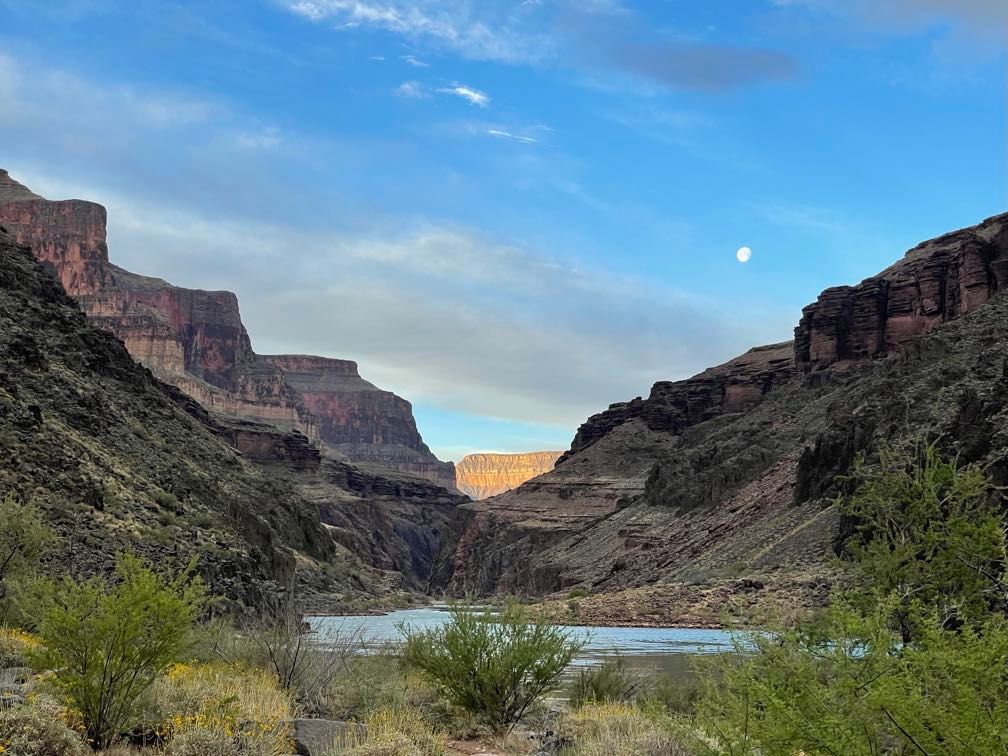 Moon over the canyon
Moon over the canyon
Following breakfast, we rafted a short distance downstream to scout Deubendorff Rapid. Amy ran it very neatly.
After another minor rapid, we came to Tapeats Creek, where we would start our longest hike of the trip up to Thunder River and back. This was a long enough hike that some guests opted for a shorter walk, only partway up Tapeats canyon.
One of the key features of this hike was repeated creek crossings: three on the way up and three on the way back. The first one came immediately, crossing Tapeats Creek right at its mouth. We climbed a steep trail covered in loose pebbles and rock several hundred feet up to the top of a flat rock layer. We followed this rock layer as it angled slightly down until it met the rapidly rising creek for our next water crossing. I was wearing my boots, so every crossing meant changing to my water shoes (I also removed the long pant legs of my convertible pants), all of which was kind of a pain.
 Steep climb
Steep climb
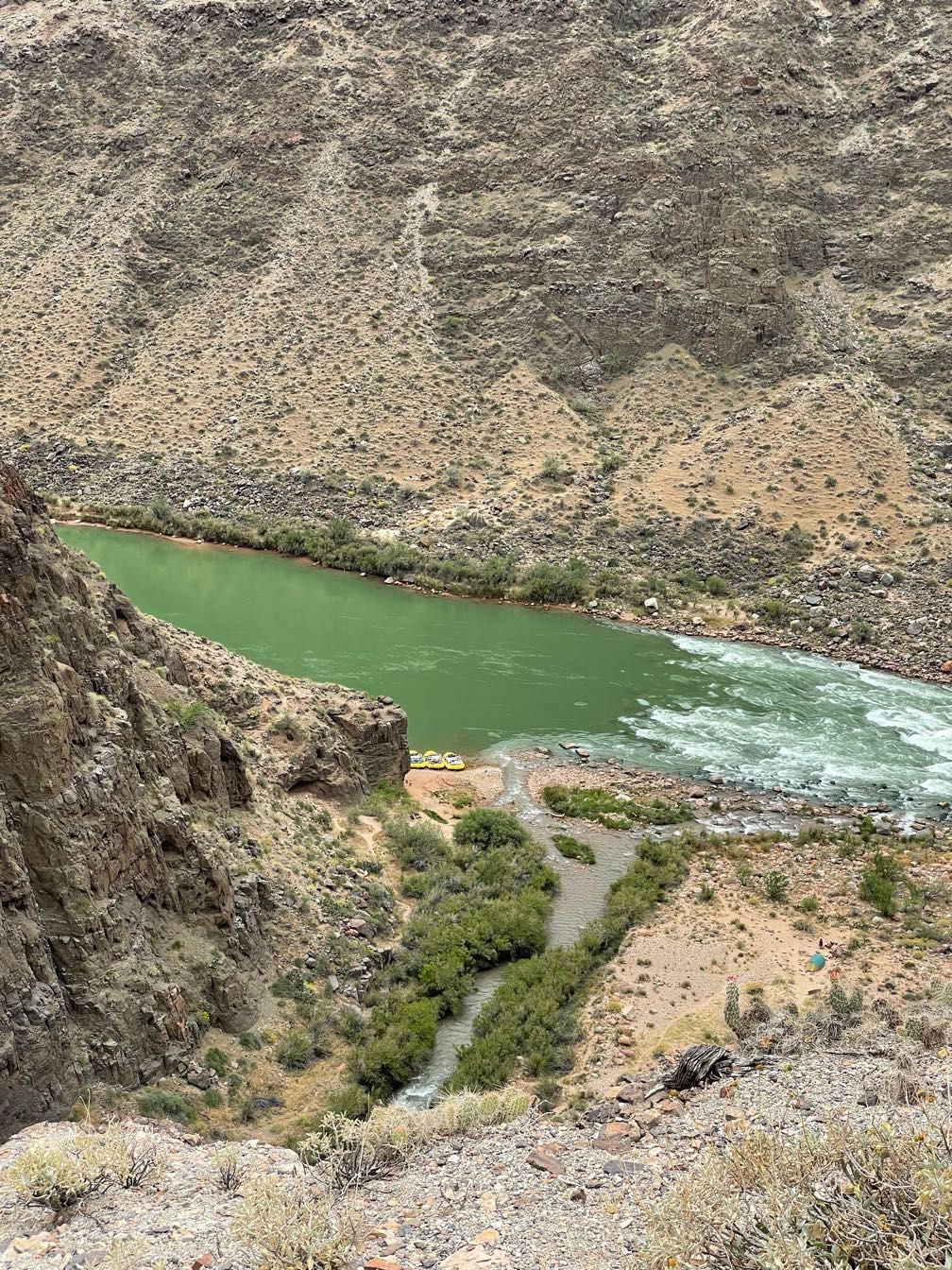 Boats down at the mouth of Tapeats Creek
Boats down at the mouth of Tapeats Creek
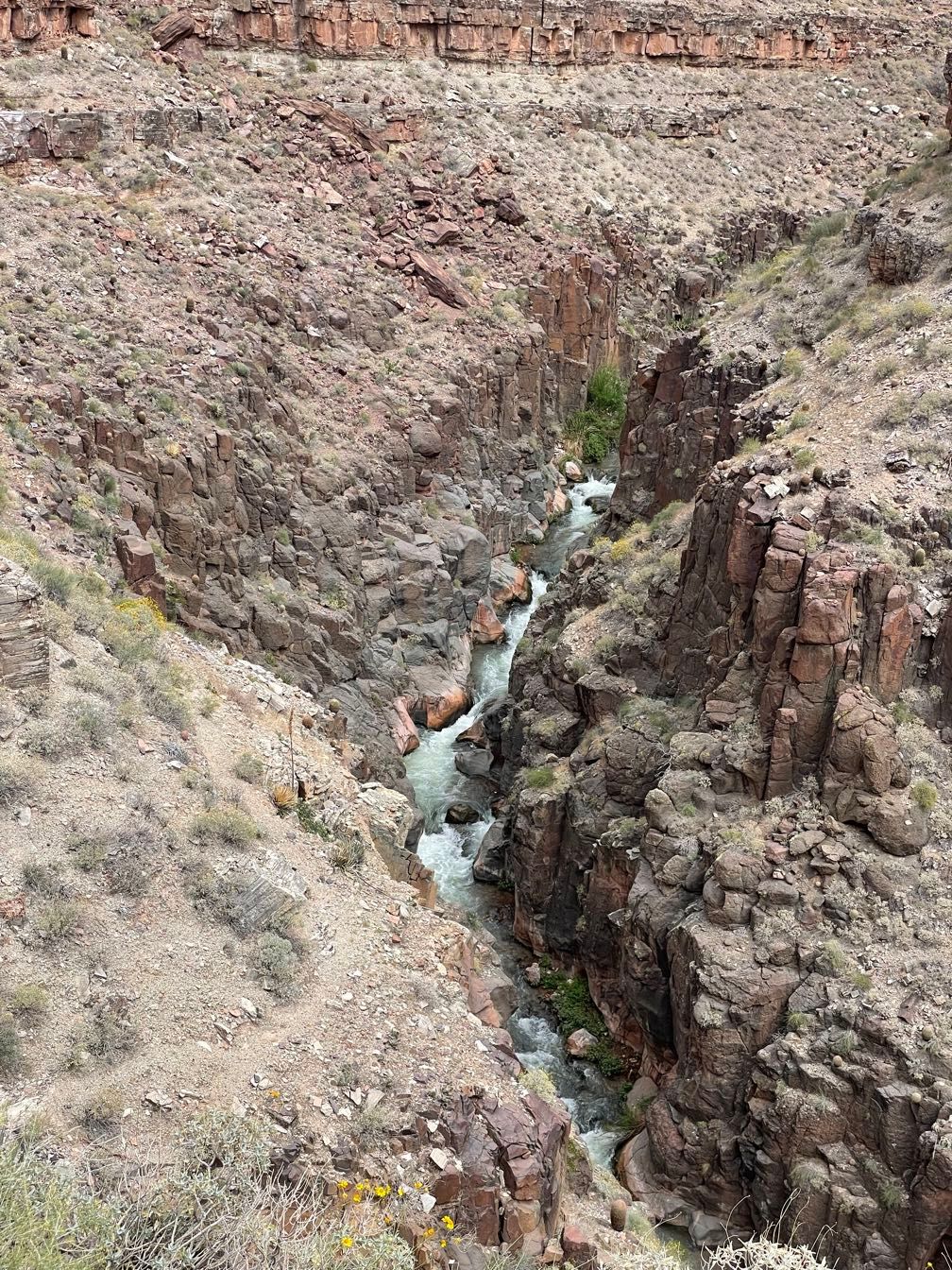 Tapeats Creek far below the trail
Tapeats Creek far below the trail
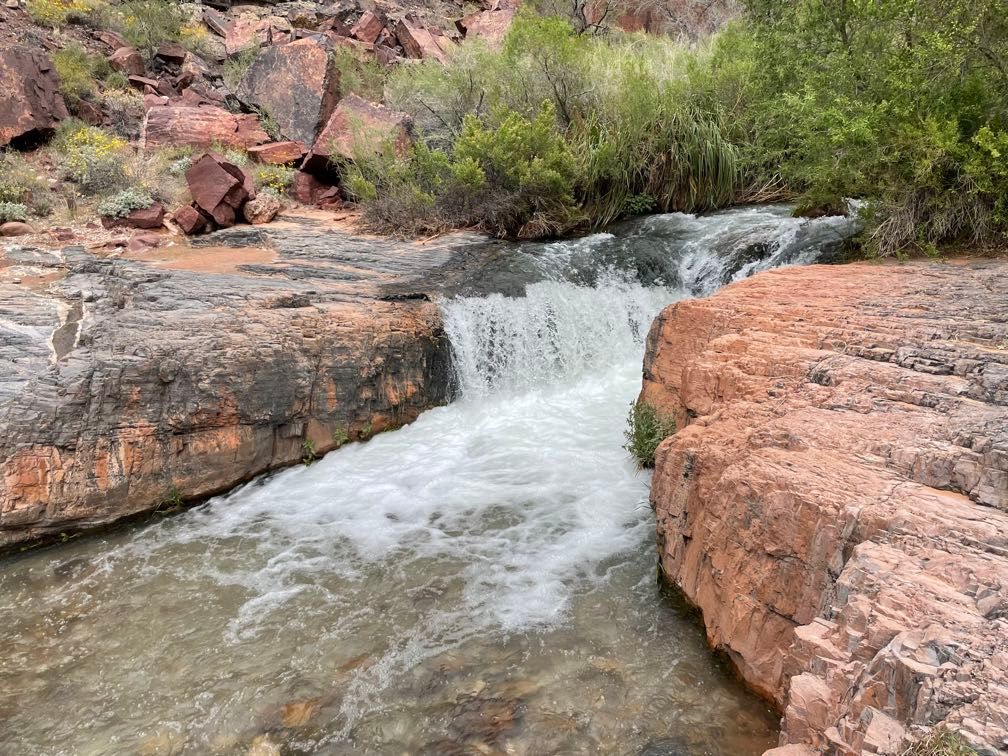 Tapeats Creek
Tapeats Creek
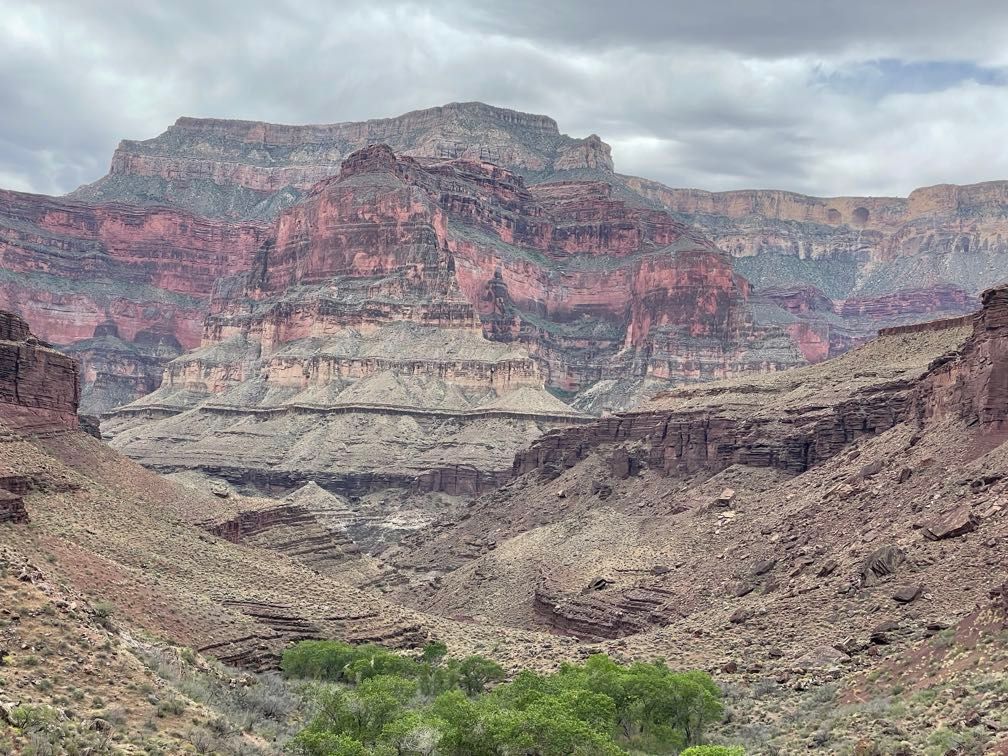 Red rocks on a cloudy day
Red rocks on a cloudy day
On the other side, we generally paralleled the creek. We had a nice trail in many places, but in a few, it got kind of scrambly. Eventually, we recrossed the creek and passed through the campground for folks hiking into Thunder River. It was another steep climb up a trail through heavily crumbled rock to Thunder River.
 Thunder River cascading down
Thunder River cascading down
Thunder River was worth the walk, though. It’s a massive spring where water shoots out of the Muav Limestone and cascades spectacularly down the cliff in a series of waterfalls.
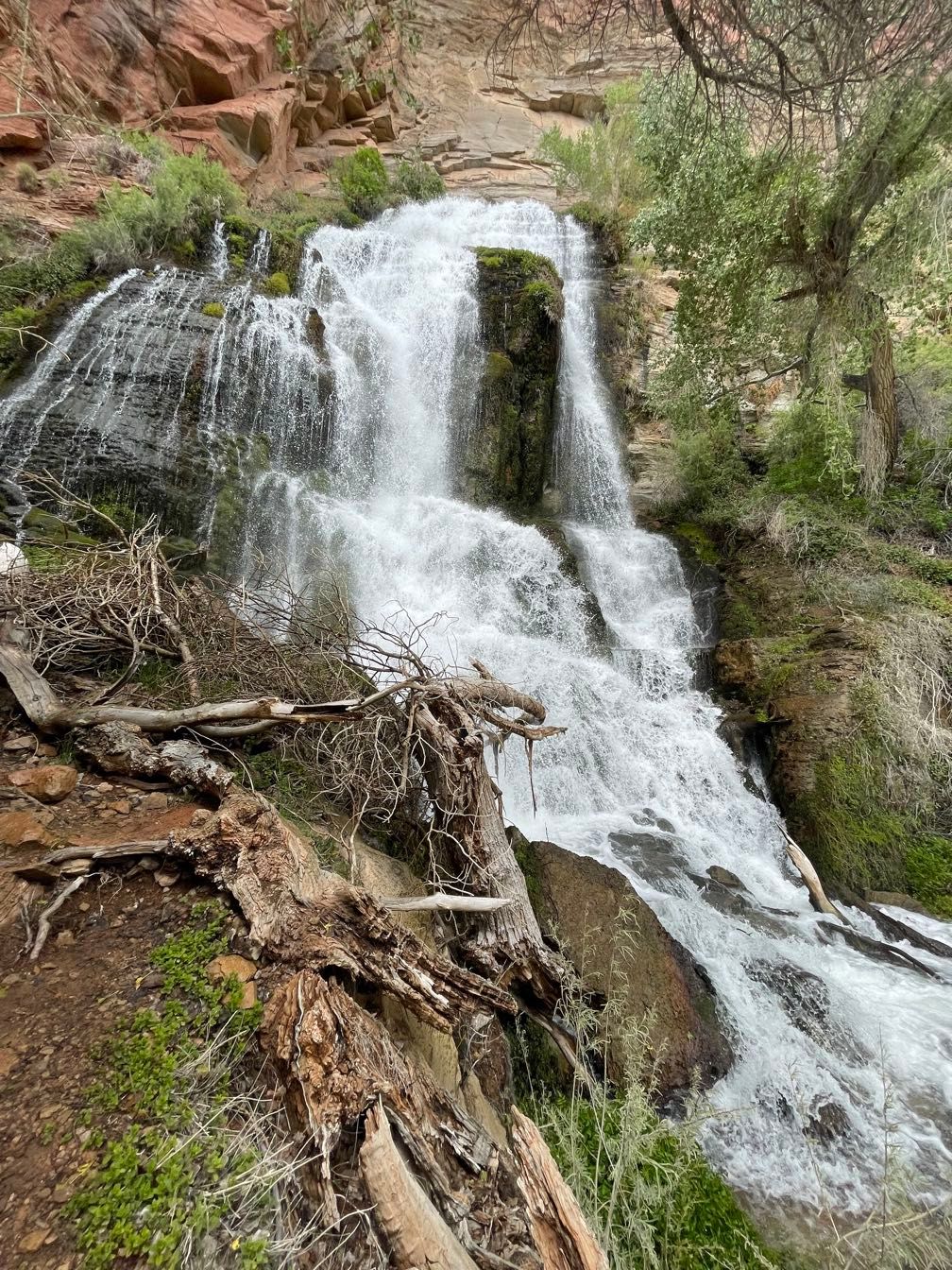 Thunder River waterfall
Thunder River waterfall
There we met an NPS science crew taking water samples. We’d seen their motor rig earlier in the trip. We spent a bit of time talking with them and enjoyed our packed lunch before starting the hike back down.
If anything, coming down these steep, crumbly trails was worse than going up. During the morning walk up the creek, some light clouds had helped keep the temperature tolerable, but coming back, they cleared out, leaving us exposed to the sun’s full force on the hottest day of our trip. I took about 4.5 liters of water with me and used almost out of it. Several people used all their water, and the guides had to pump some more using a backpacking water filter.
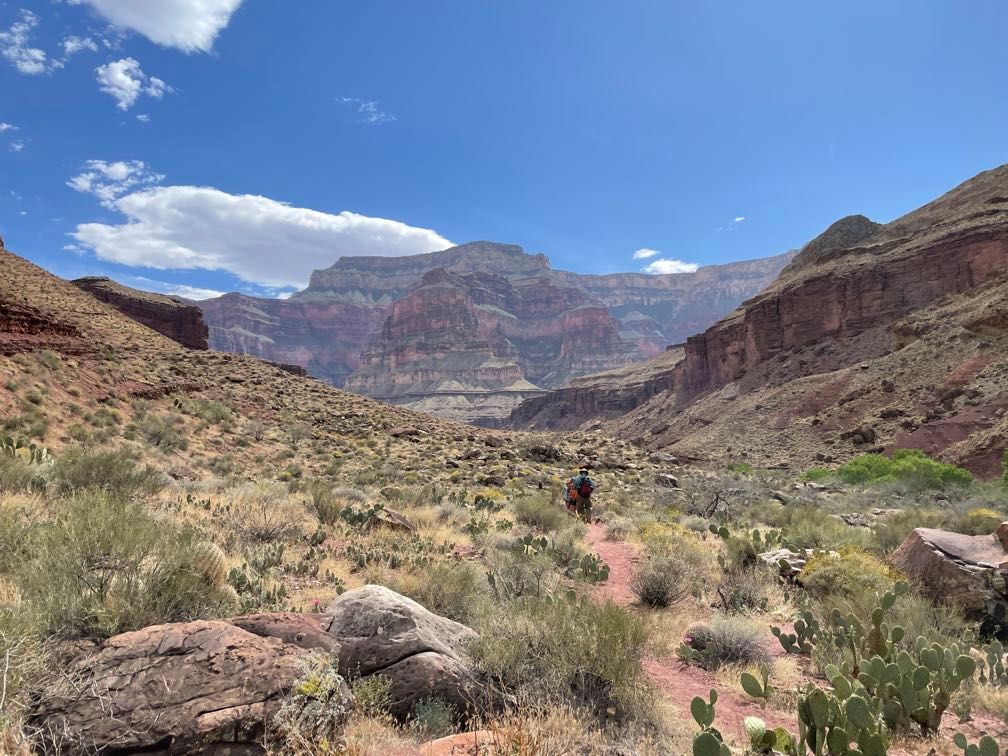 Blue skies
Blue skies
Back at the beach, we pushed off and ran Tapeats Rapid and Mile 135 rapid. Hot as it was, I opted against any waterproof gear and got thoroughly soaked. It felt pretty good though perhaps a tad excessive.
 Pink clouds at sunset
Pink clouds at sunset
We stopped at Owl Eyes Camp, named for a pair of alcoves up in the Kaibab Limestone just below the rim. There we enjoyed an excellent dinner of pozole (a chili-like Mexican stew made with lamb) and a well-deserved rest.
Day 13
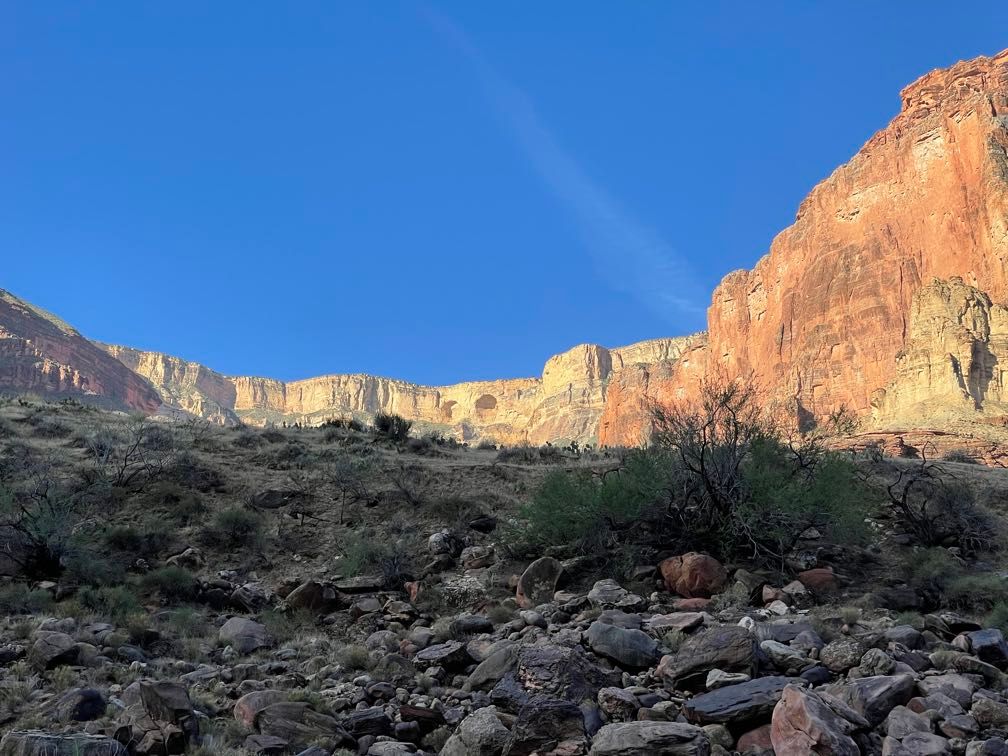 The Owl Eyes alcoves
The Owl Eyes alcoves
In Dave’s boat, we rafted down through the narrowest part of the Colorado River in the Grand Canyon. Relatively recently (geologically speaking), a big slumping of land on the right side of the river cut off the original channel. Since then, the river has eroded a very narrow channel down through the schist.
 Through the narrowest part
Through the narrowest part
We stopped at Deer Creek, a short way downstream. A waterfall tumbles hundreds of feet out of a narrow side canyon.
We climbed up a steep trail up to a ledge above the slot canyon. As we walked upstream, there were some exceedingly narrow spots. We passed some handprints placed there by the Paiute people, who continue to use the Deer Creek Canyon as a ceremonial site today.
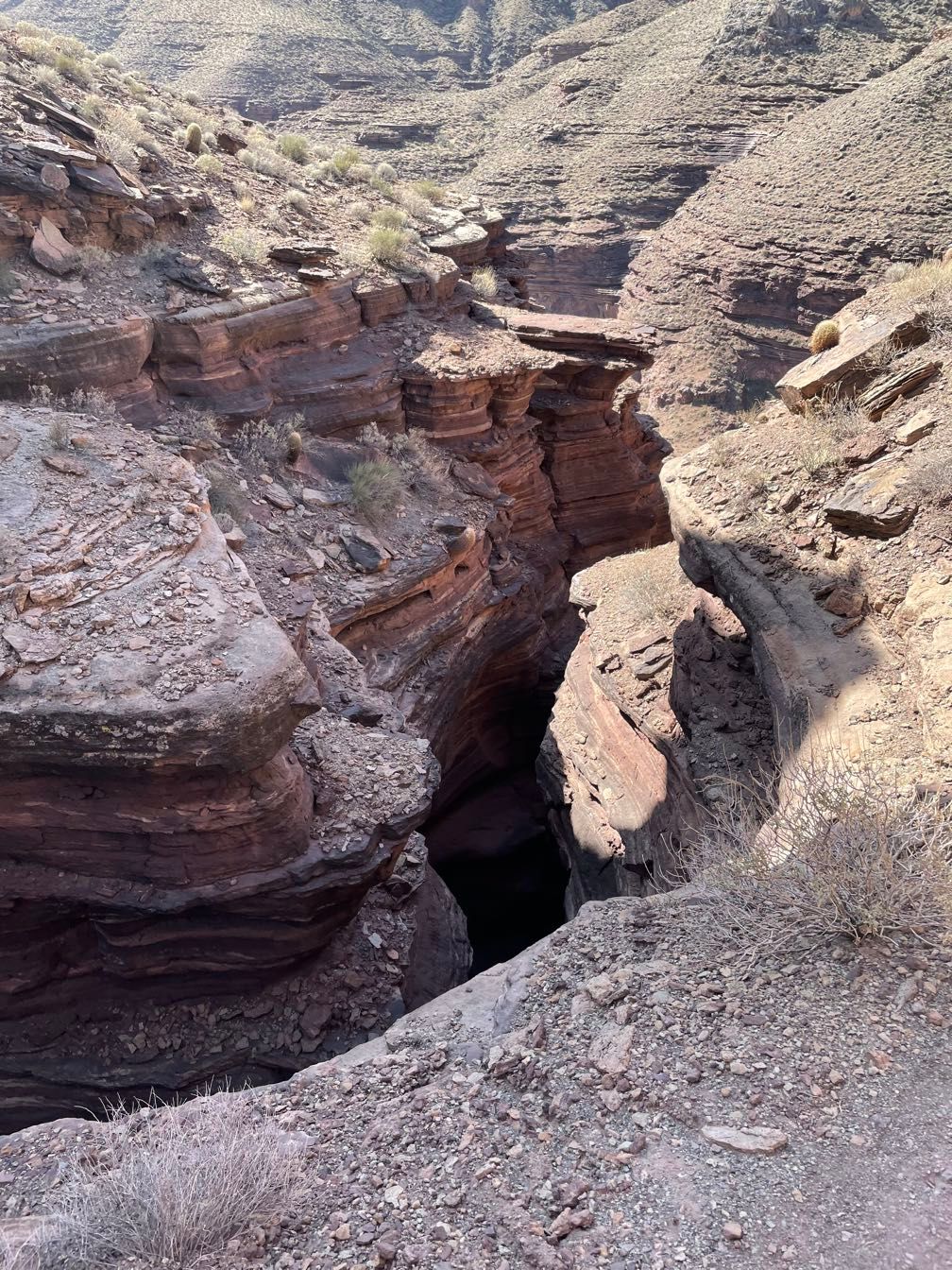 The Deer Creek slot canyon from above
The Deer Creek slot canyon from above
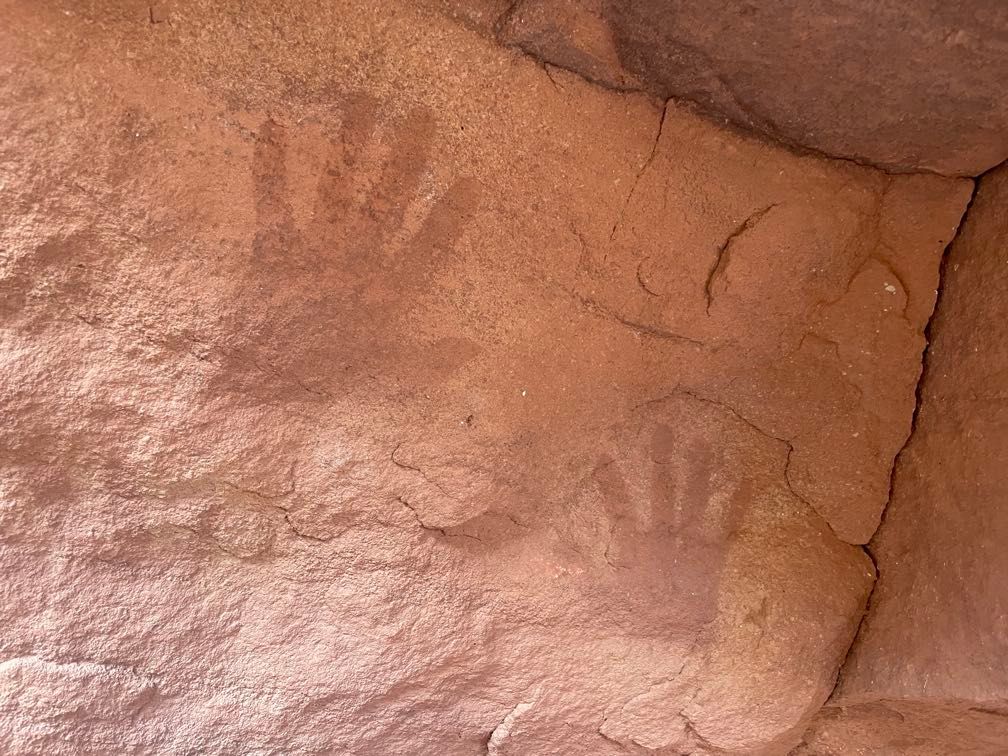 Paiute handprints
Paiute handprints
This brought us to “the patio,” a flat area where the canyon broadens out at the boundary between the Tapeats and the Bright Angel Shale.
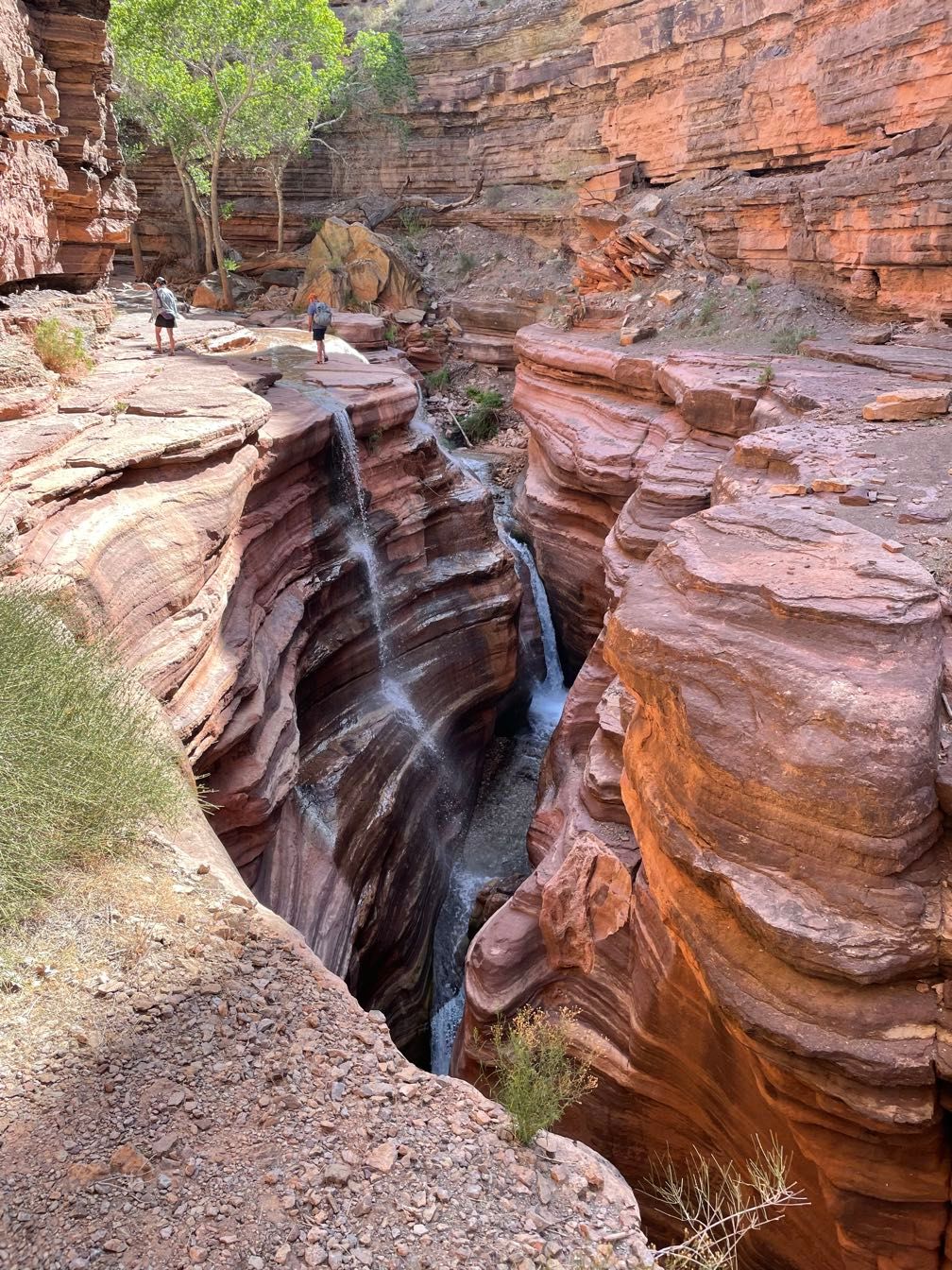 Approaching the Patio
Approaching the Patio
 The Patio
The Patio
We enjoyed a nice rest. Sherri gave a talk on the Paiute people and their use of the site. As we were getting ready for the hike back, Gary pointed out some fossil worm burrows and places where trilobites had rested.
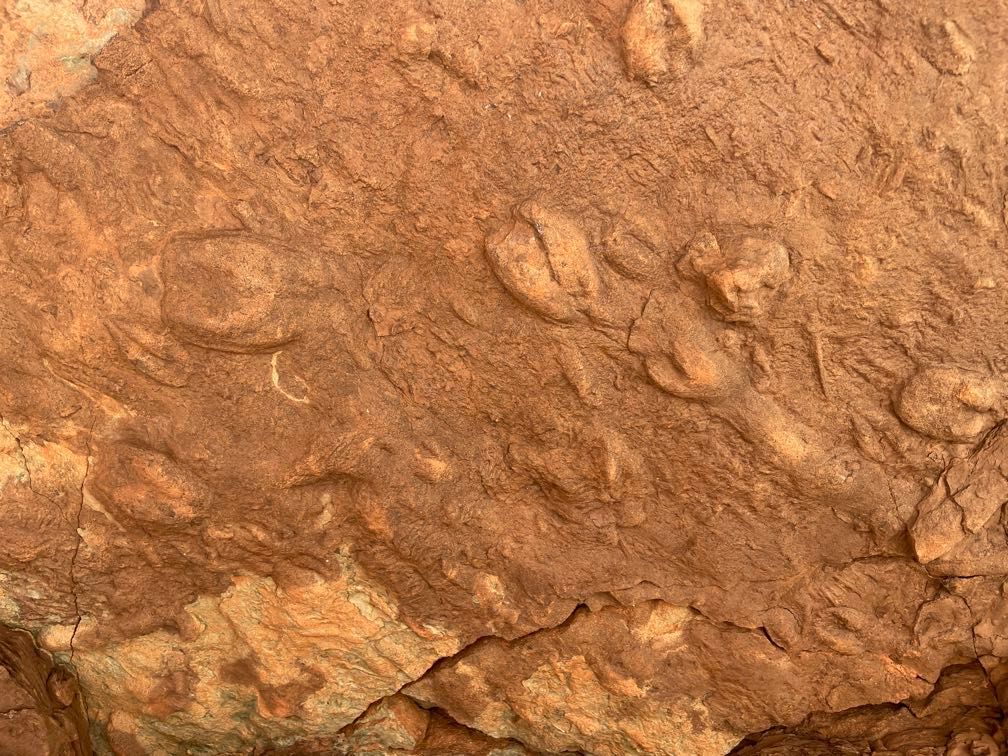 Trilobite resting spots
Trilobite resting spots
We made the hike back down to the boats, stopping near the end for a closer look at the waterfall. Some folks jumped into the pool there for a swim. I limited myself to enjoying the cool spray and taking some pictures.
 The waterfall
The waterfall
We pushed off for a short trip down through Deer Creek Rapid to a camp known as the Football Field for lunch. Given the hot day, I eschewed my waterproof gear in favor of some cooling splashes.
After lunch, we ran Doris Rapid and Cranberry Rapid. At that point, Dave let me row a bit, including through the (minor) rapids Fishtail and One Hundred Forty-One Mile. After about four miles of rowing, Dave took over and landed us at Kanab Creek. We enjoyed a stroll up the canyon.
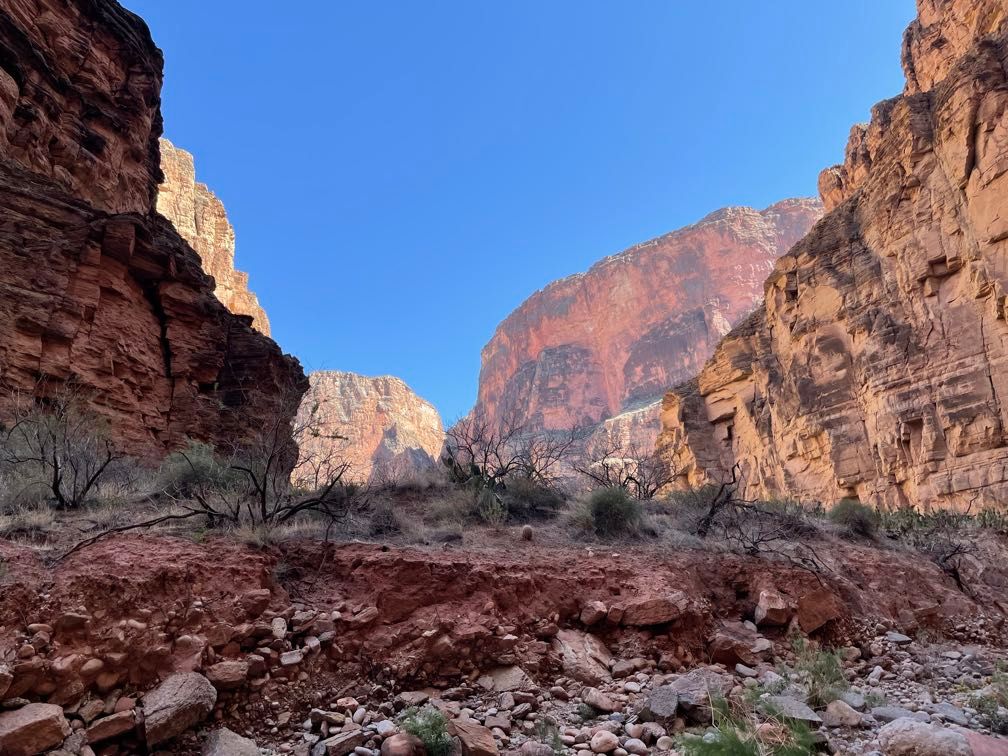 Kanab Creek canyon
Kanab Creek canyon
 Kanab Creek
Kanab Creek
This is one of the biggest drainages into the canyon, and we saw lots of aquatic life: frog eggs, tadpoles, and a ton of flannel mouth suckers swimming upstream spawning.
 Flannel mouth suckers
Flannel mouth suckers
After this leisurely stroll, we pushed off and ran Kanab Rapid on our way to the campsite Below Kanab for the night. Tonight’s dinner was pasta with andouille sausage.
Day 14
Riding with Leo today, we pushed off and went through Upset Rapid, which was pretty wet.
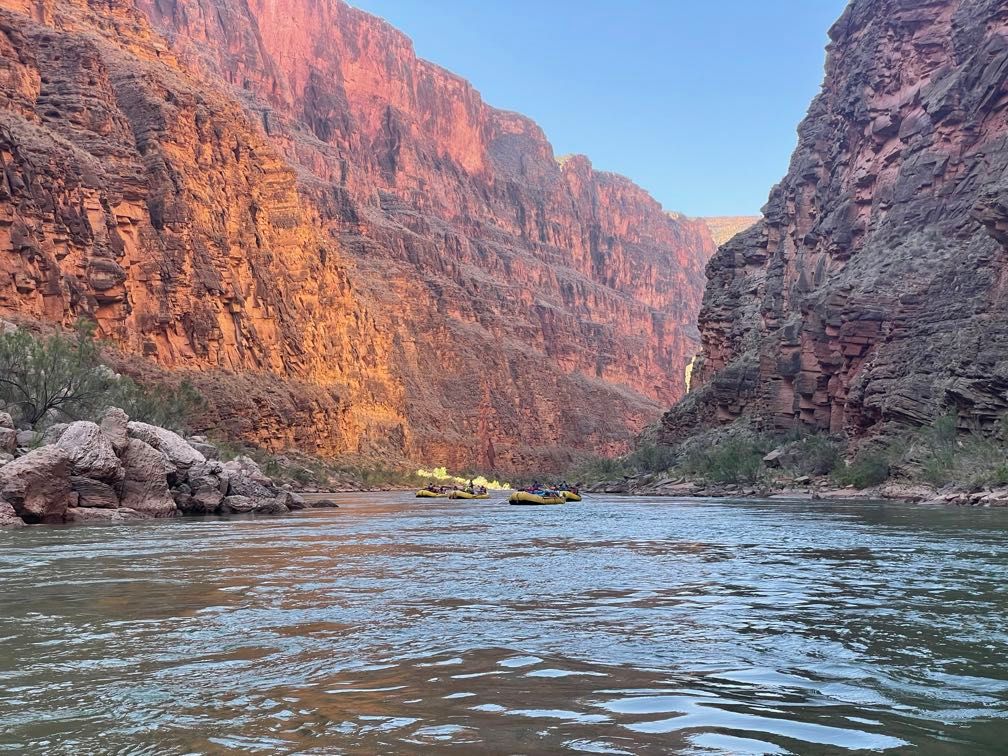 Rafting through red rock
Rafting through red rock
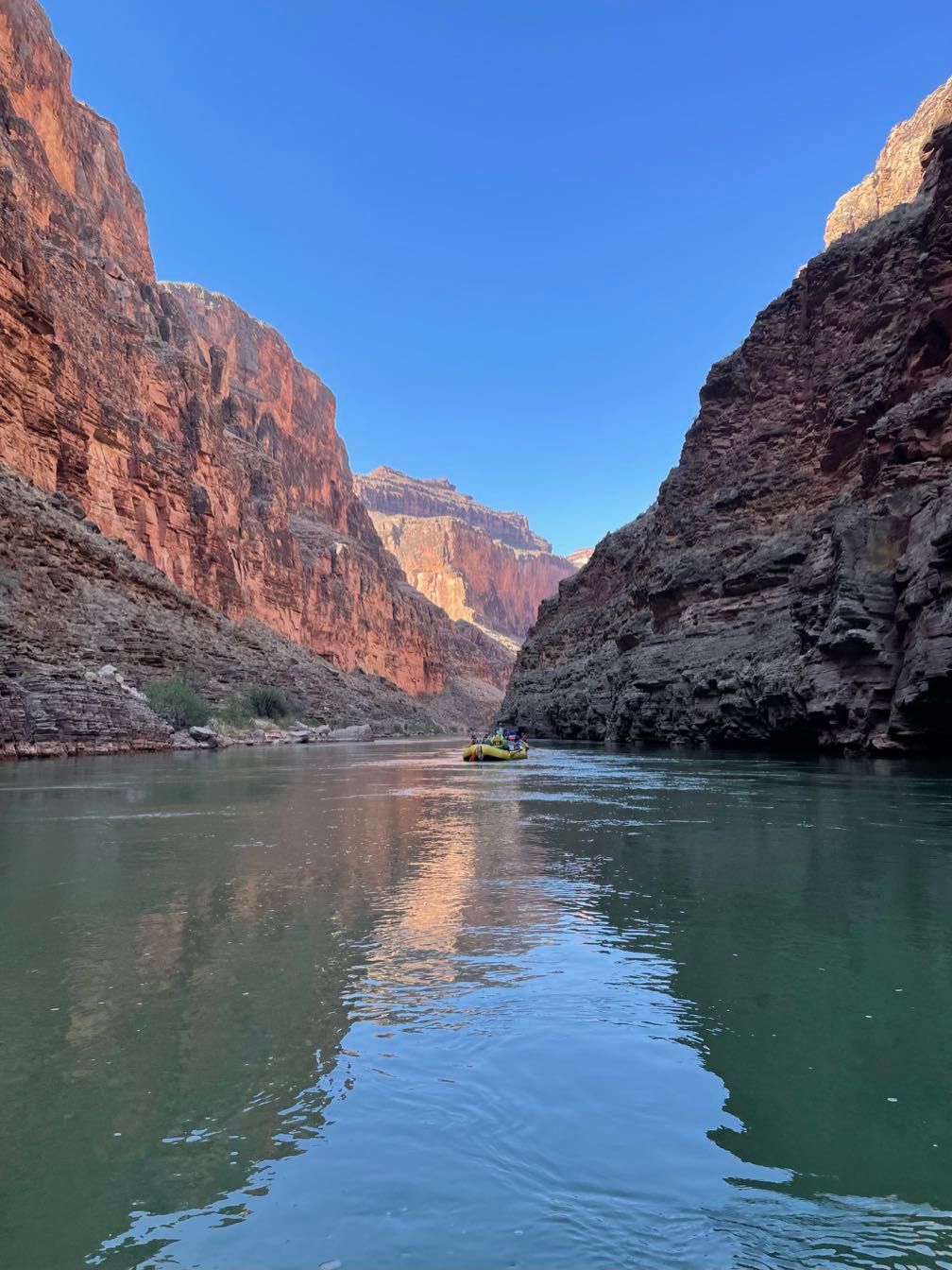 On the river
On the river
 Red walls
Red walls
Shortly after Upset, we saw a USGS science trip doing river channel mapping. They had two big motor rigs and at least four other boats. Tripods with surveying equipment dotted the riverbank. They were on a 24-day trip and mentioned that the greatest depth they’d surveyed was 29 meters at mile 127.8 in the Middle Granite Gorge.
 An alcove
An alcove
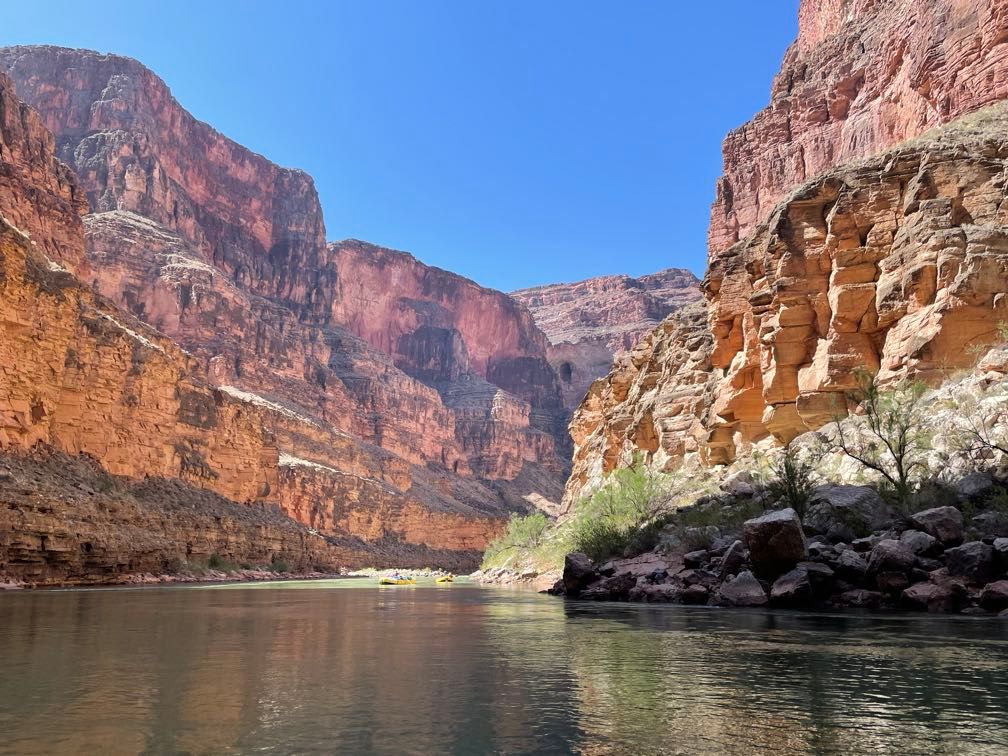 Light on red rocks
Light on red rocks
I volunteered to row for Leo. I kept it up for about four miles, including Havasu Rapid. It was really enjoyable, and I think I’m getting a bit better at it.
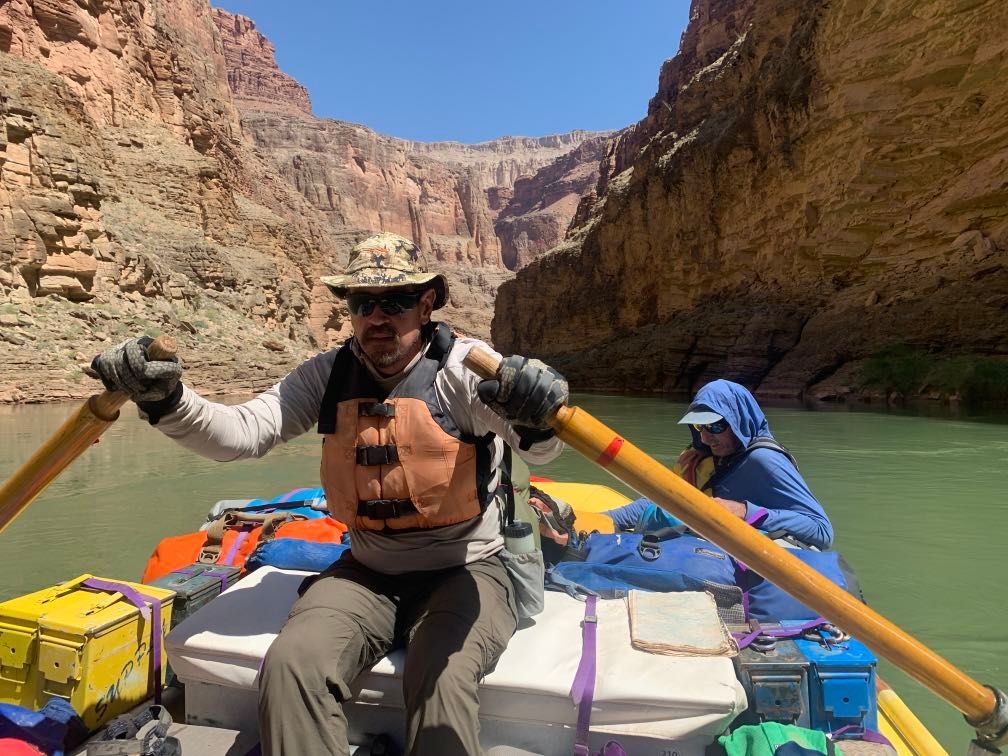 On the oars again
On the oars again
We stopped for lunch at sort of a natural amphitheater along the riverbank with tiers of stone layers about sitting bench height. A bunch of flannel mouth suckers congregated around Sequoyah’s boat. We fed them bits of cheese, which they sucked right up.
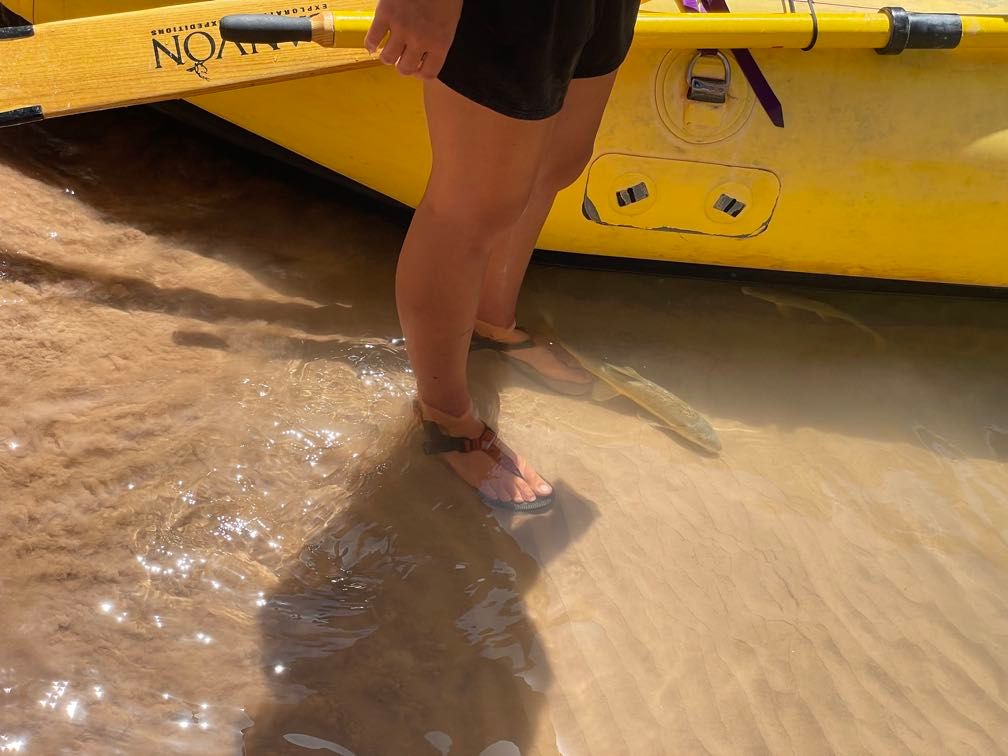 Kanab Creek
Kanab Creek
During the day, we saw several bighorn sheep. There was a ewe with three little lambs and several rams, including some with impressively curled horns.
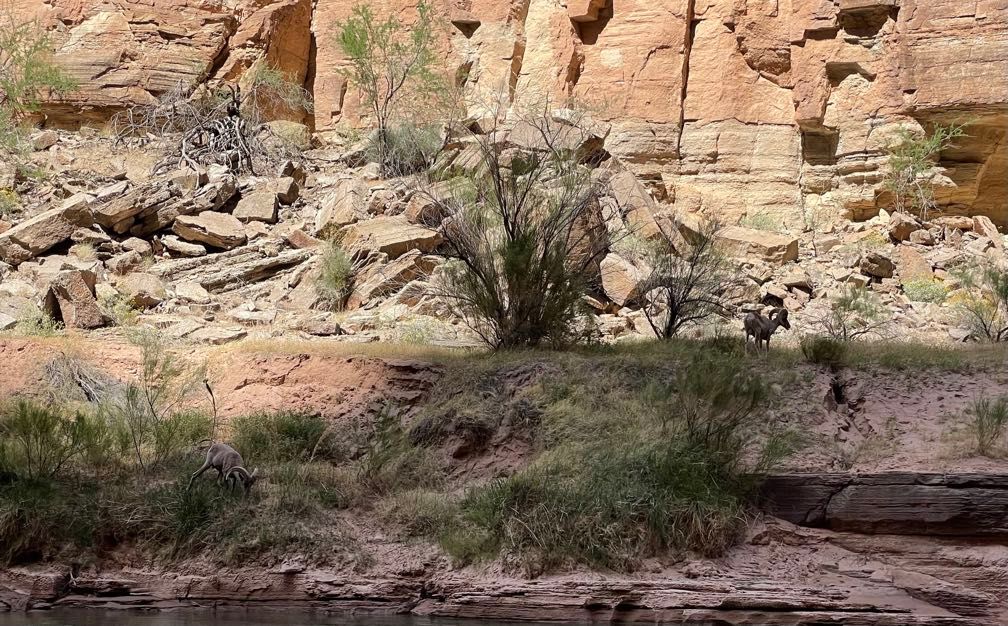 Bighorn rams
Bighorn rams
 Another ram
Another ram
At that point, it was a very windy afternoon run down to National Creek for a hike. Leo asked Sherri (who he shanghaied from Amy’s boat) and me to sit up front and paddle to help him progress against the wind. We pulled into National about 3 pm.
We decided to camp there rather than just doing the hike, so we unloaded the boats and set up camp. About an hour later, we started wandering up National Creek’s steep-walled canyon. We came across some rather noisy frogs (though we couldn’t actually lay eyes on them). Further up, there was a smooth pour-off with a lovely little waterfall. Then it was back to camp for some chicken fajitas.
 Hiking up National Creek
Hiking up National Creek
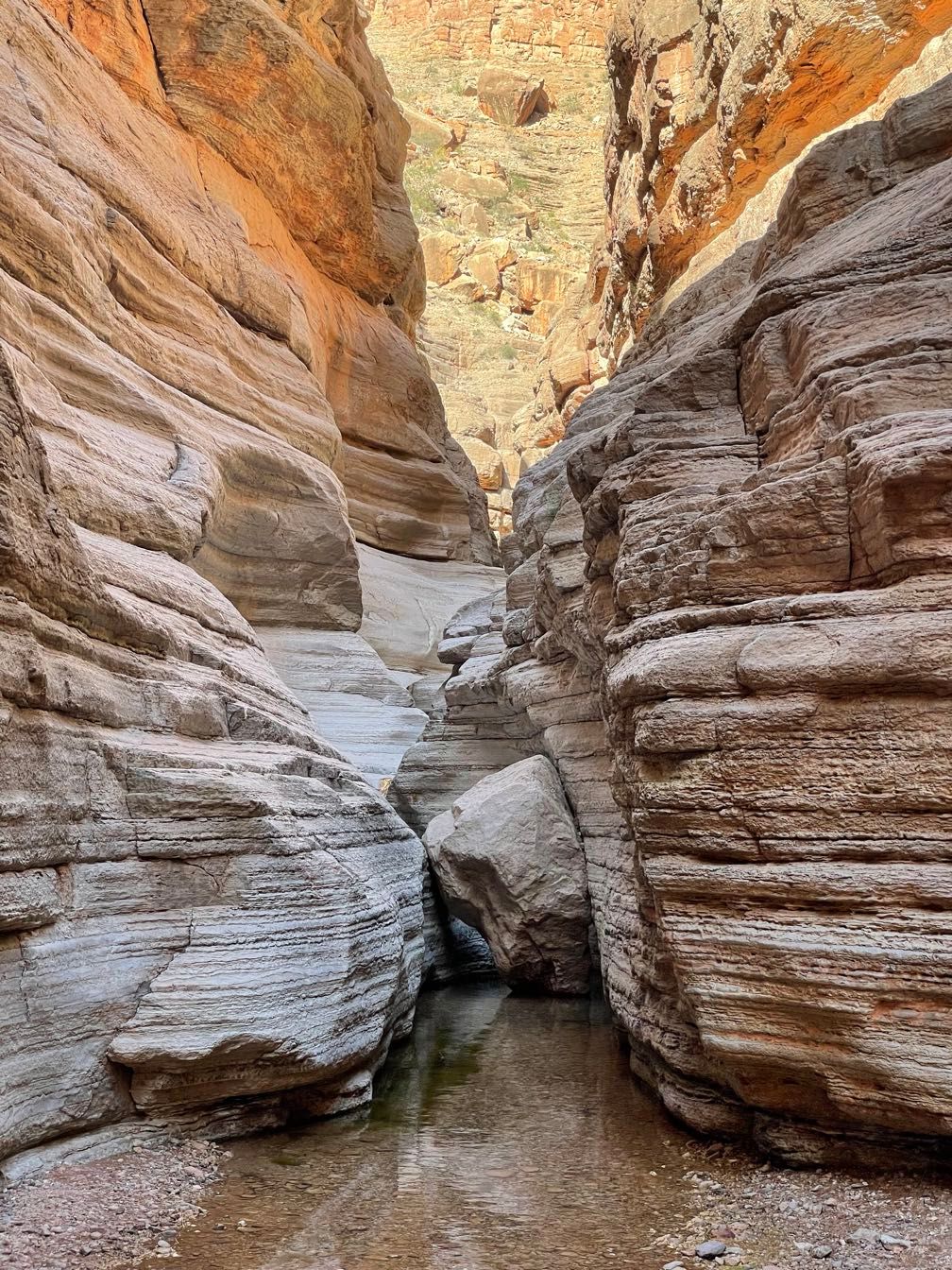 The pour off
The pour off
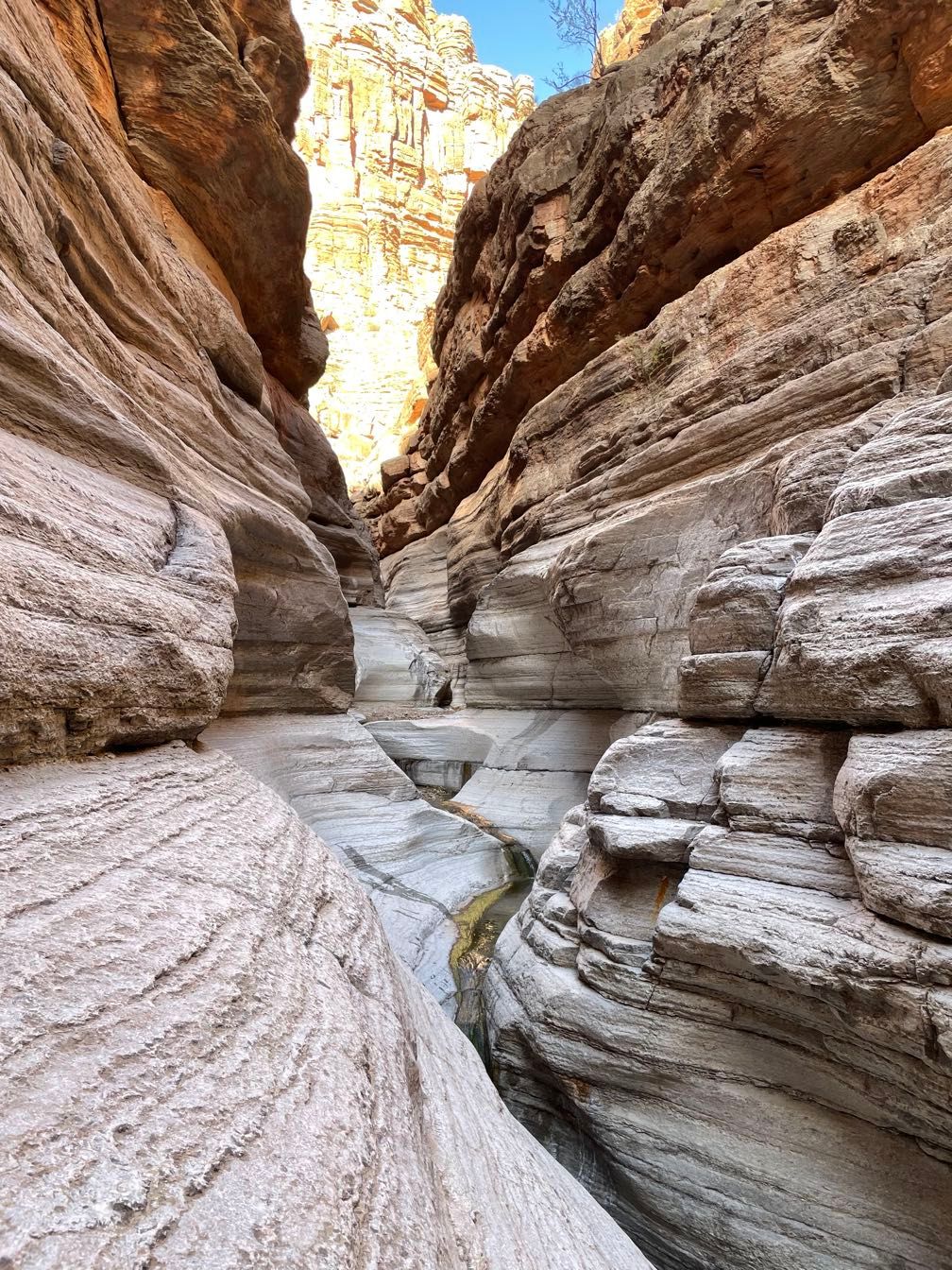 The waterfall
The waterfall
After dinner, Sherri talked to us about the Havasupai and Hualapai tribes.
Rather than set up my tent, I decided to sleep out under the stars.
Day 15
It was definitely less stuffy than in the tent, but there was some wind about midnight, and a few spots of rain around 5 am.
We would be doing Lava Falls Rapid later in the day. Dave drew out the rapid in the sand and talked through how to run it with Sequoyah.
We got a fairly early start today, which turned out to be a good thing. We rafted a short way downriver to Fern Glen, pushing against some wind on the way. Fern Glen was a nice side canyon with a walk up to an enormous jam of chockstones and some nice greenery.
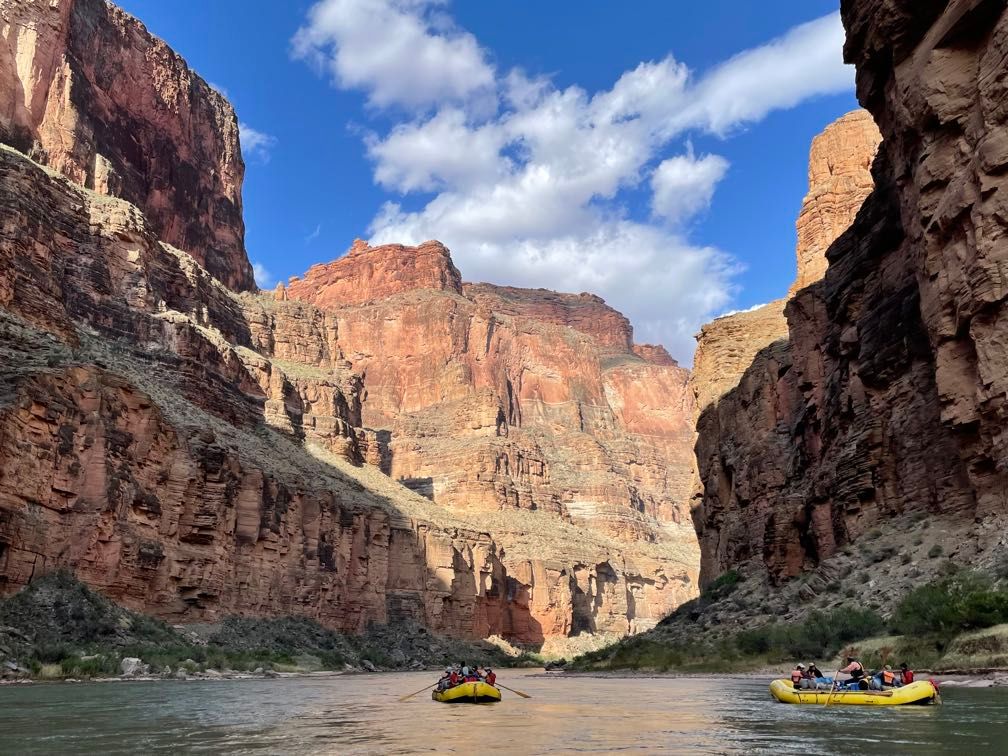 Rafting downriver
Rafting downriver
 Ferns at Fern Glen
Ferns at Fern Glen
 Slot canyon portion of Fern Glen
Slot canyon portion of Fern Glen
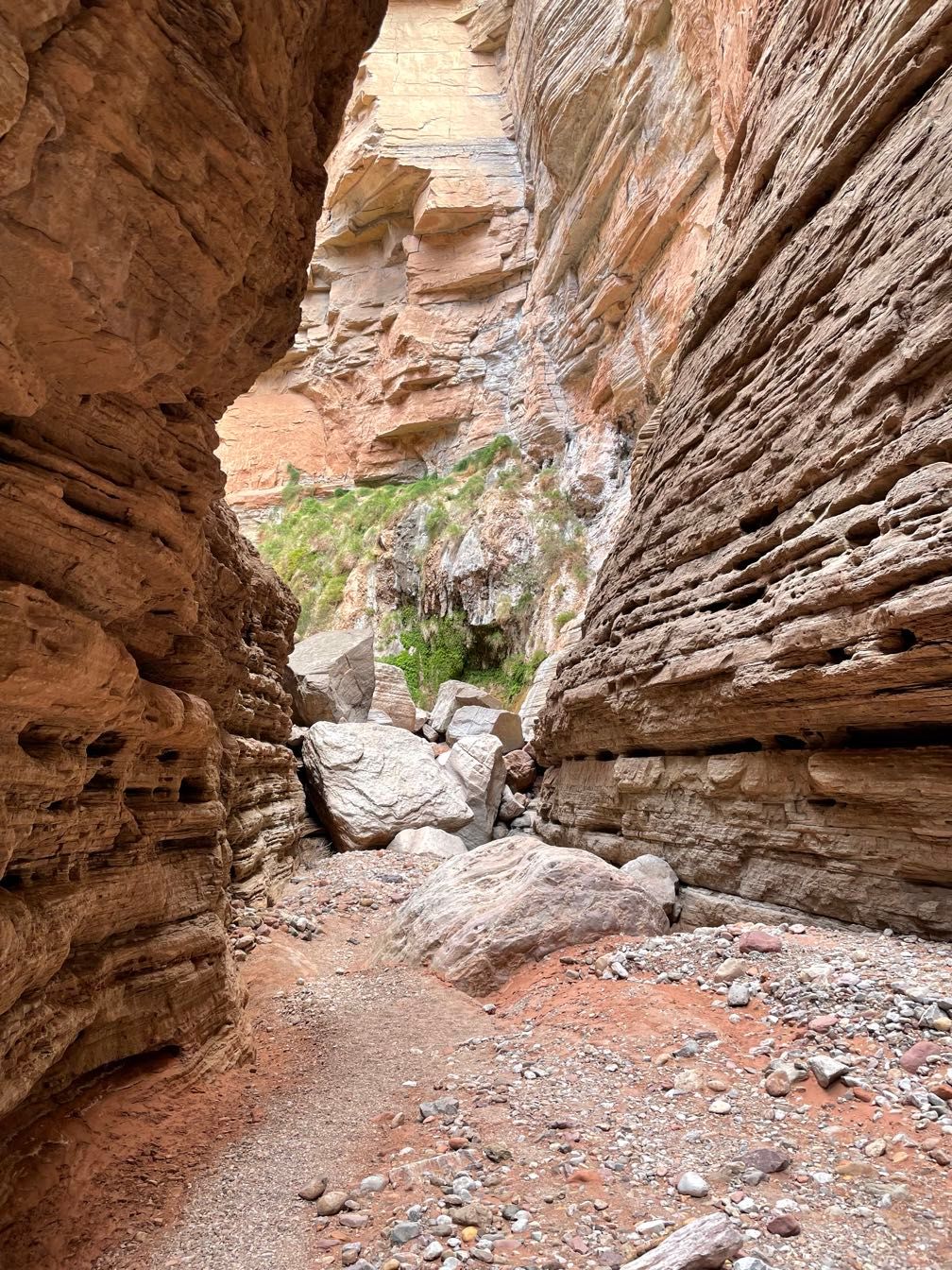 This jam of chockstones was as far as we got
This jam of chockstones was as far as we got
We floated out from Fern Glen and ran right back into a brisk headwind. Dave let me row for a bit. Doing it against such a stiff wind was eye-opening. He had me turn around and pull the oars for a while rather than pushing. This was the first time I’d pulled for an extended period. Dave had some good advice to keep me going in a straight line.
Dave took over rowing, and the wind grew even more intense. Like Leo yesterday, Dave handed out a pair of paddles and had us passengers help him out. Josh and I paddled from the front for a while, but eventually, we settled on me in the front right and Sherri in the left rear (or vice versa when Dave was pulling).
It started raining on and off just before lunch, and the wind intensified. Even with Dave rowing and Sherri and I paddling, there were times when we barely made progress.
We stopped for a rainy, windy lunch below Red Slide, a massive landslide from the Redwall layer slumping down to the river. As it had gotten warmer in recent days, I’d returned my fleece and midweight layers to the blue overnight bag rather than the purple day bag. I was just wearing my GoreTex jacket over a thin t-shirt. This was fine when I was paddling, but I got kind of cold during lunch.
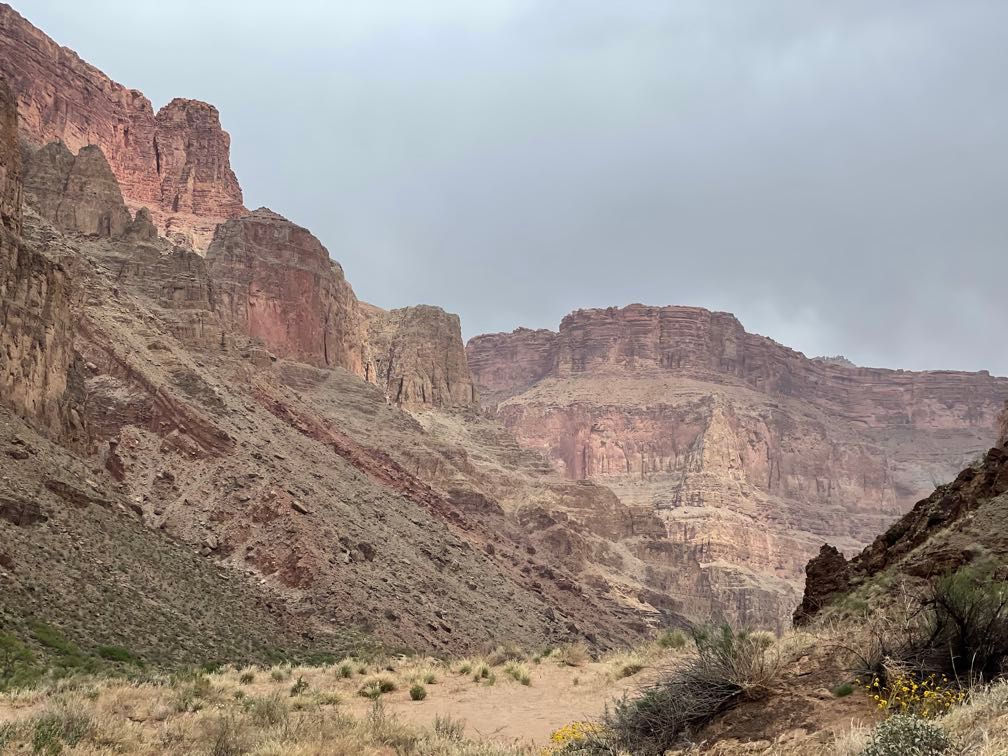 Red Slide
Red Slide
When we got going again, the wind was, if anything, even more intense. Sherri and I paddled away to help Dave make headway.
I have to say that Sequoyah really kicked ass rowing the baggage boat here. She not only pulled away from Amy, who is probably the most skilled rower on the trip, she also pulled away from Dave and Leo, who had passengers rowing to help them.
Eventually, after a long stint of slow progress against the wind, we finally reached Lava Falls. I tagged along when the guides went to scout the rapid. Having seen Dave’s sand diagram earlier made what otherwise would have been an incomprehensible mess much more understandable. I could see how you would thread your way through the hazards.
We cast off and ran Lava. Honestly, even though this is the highest-rated rapid on the river, I got wetter and had a rougher ride in some of the other rapids we’d done on the trip.
Just as we finished Lava, as if on cue, the wind died down, and the clouds parted, turning a miserable day into a nice afternoon. We pulled into Tequila Camp, just below Lava, to stay the night. It was a bit early to be stopping, but after the exhausting day of rowing and paddling against the wind and the tension of running Lava, it was good to stop then.
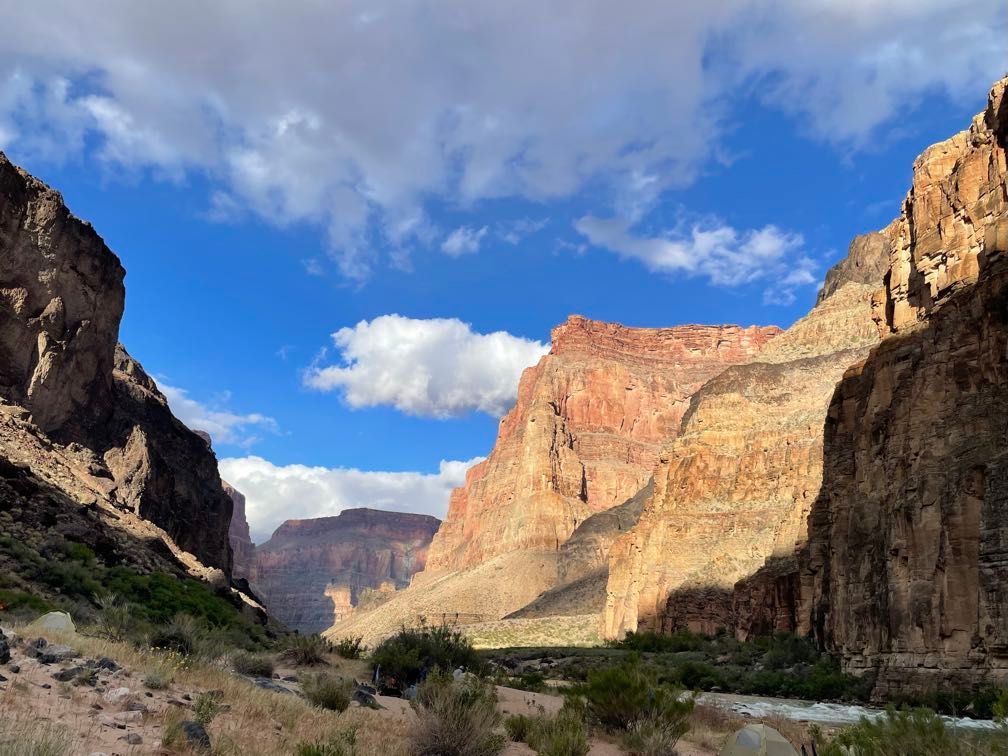 A beautiful late afternoon
A beautiful late afternoon
 Clouds coming up at sunset
Clouds coming up at sunset
After a few hours of beautiful weather, the wind began to gust, and we got a bit more rain. We had a lovely dinner of pasta with sausage. Josh performed a sea shanty he had written about our merry band. With that, we all headed to bed, aided by the gentle roar of Lava Falls. After a very long day, I was asleep almost from the moment my head hit the pillow.
Day 16
Before we got on the water, Gary gave a talk on plant identification. We pushed off and headed down to Whitmore, where there’s a large pictograph panel made by the Havasupai. Leo let me row for a bit on the way down, including Whitmore Rapid.
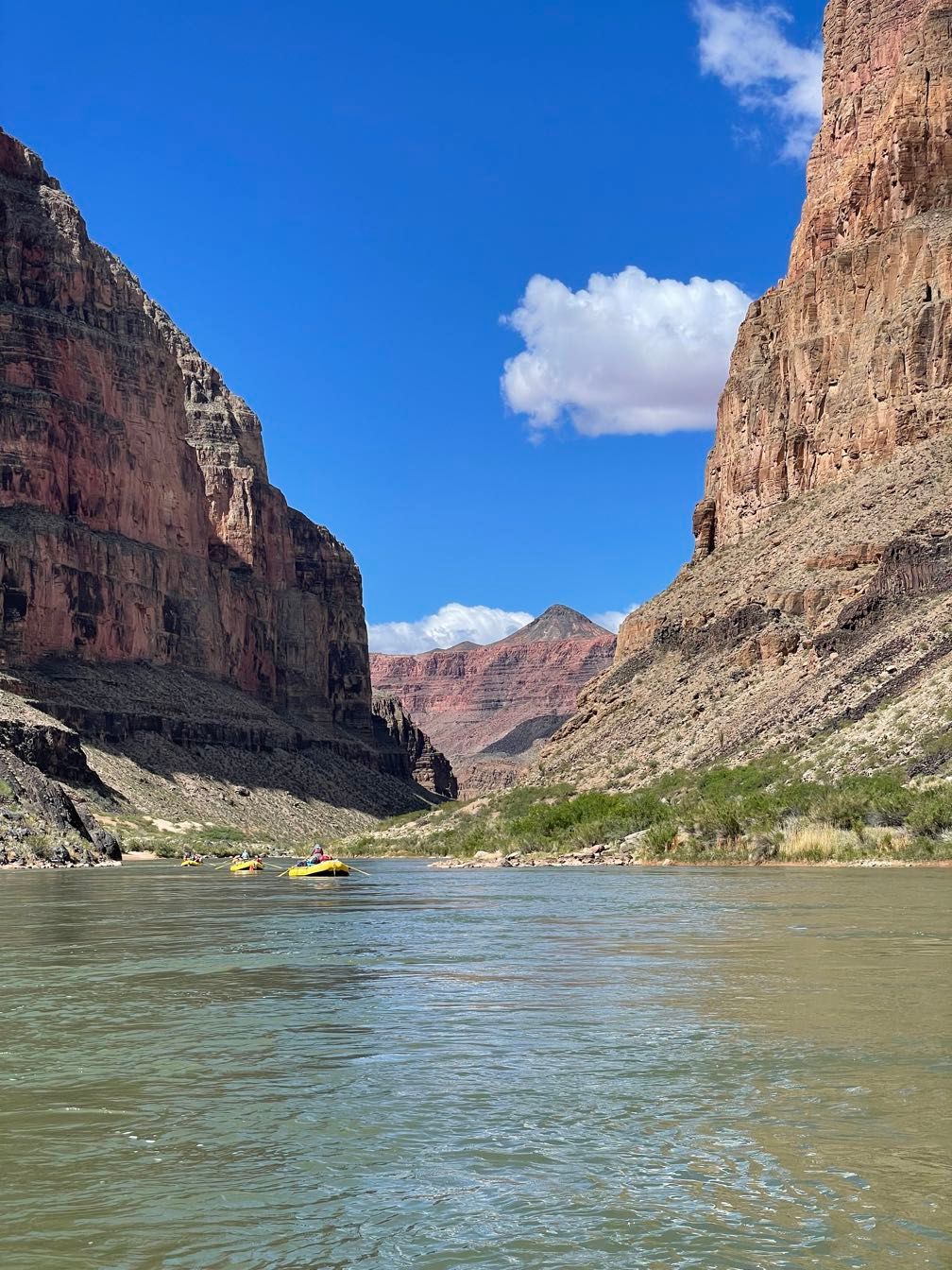 Rafting downriver
Rafting downriver
The pictograph panel was pretty impressive, with many figures, mostly in red hematite paint. Sherri talked a bit about its significance.
 A small fraction of the figures on the Whitmore panel
A small fraction of the figures on the Whitmore panel
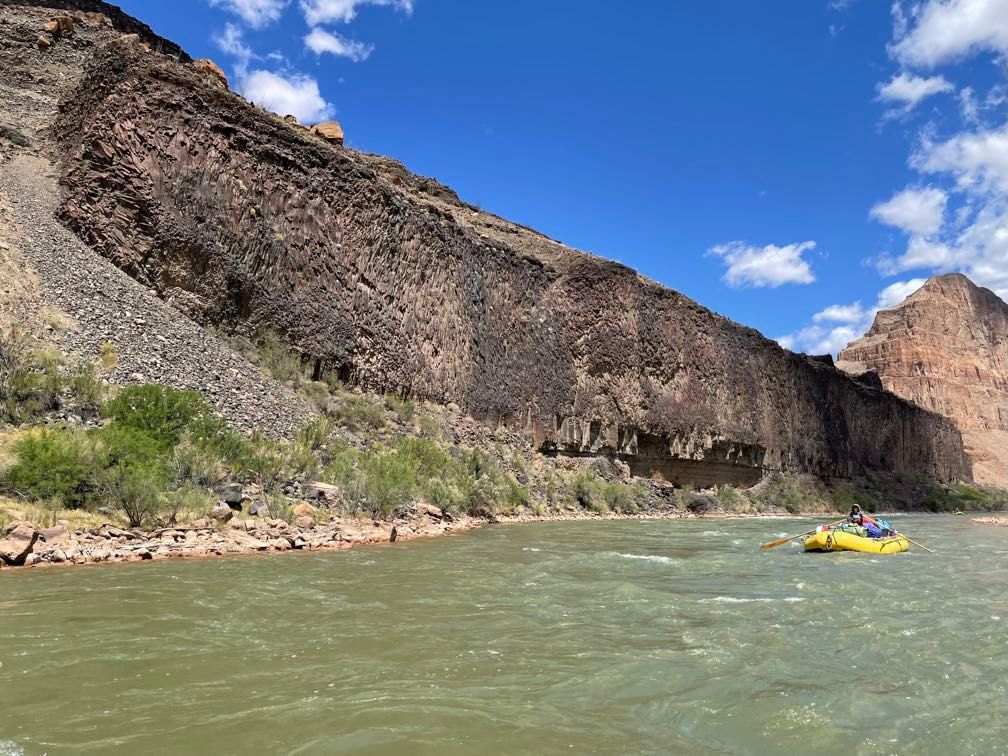 A massive wall of basalt
A massive wall of basalt
We stopped for lunch near a cave formed by sedimentary rock under a lava flow eroding away. Gary took us up to the cave while the rest of the guides made lunch. We got back on the water with plenty of miles to go. We faced some stiff headwinds. While not as bad as yesterday, it was pretty difficult. I did another stint of rowing. Leo and Justin paddled for a bit to make it somewhat easier.
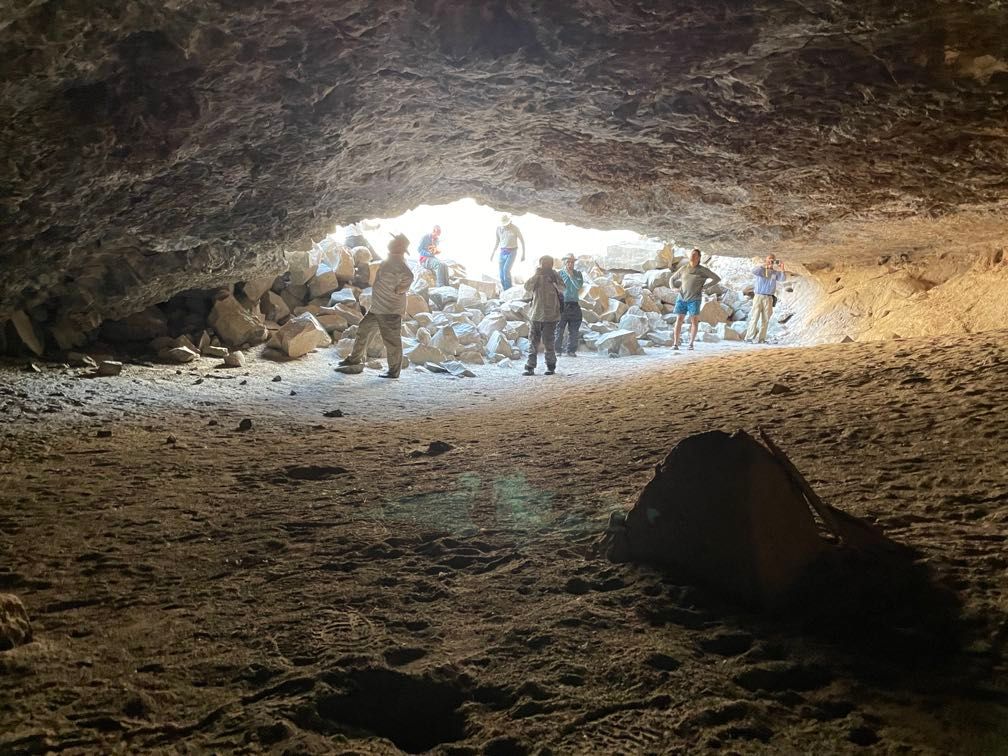 The cave
The cave
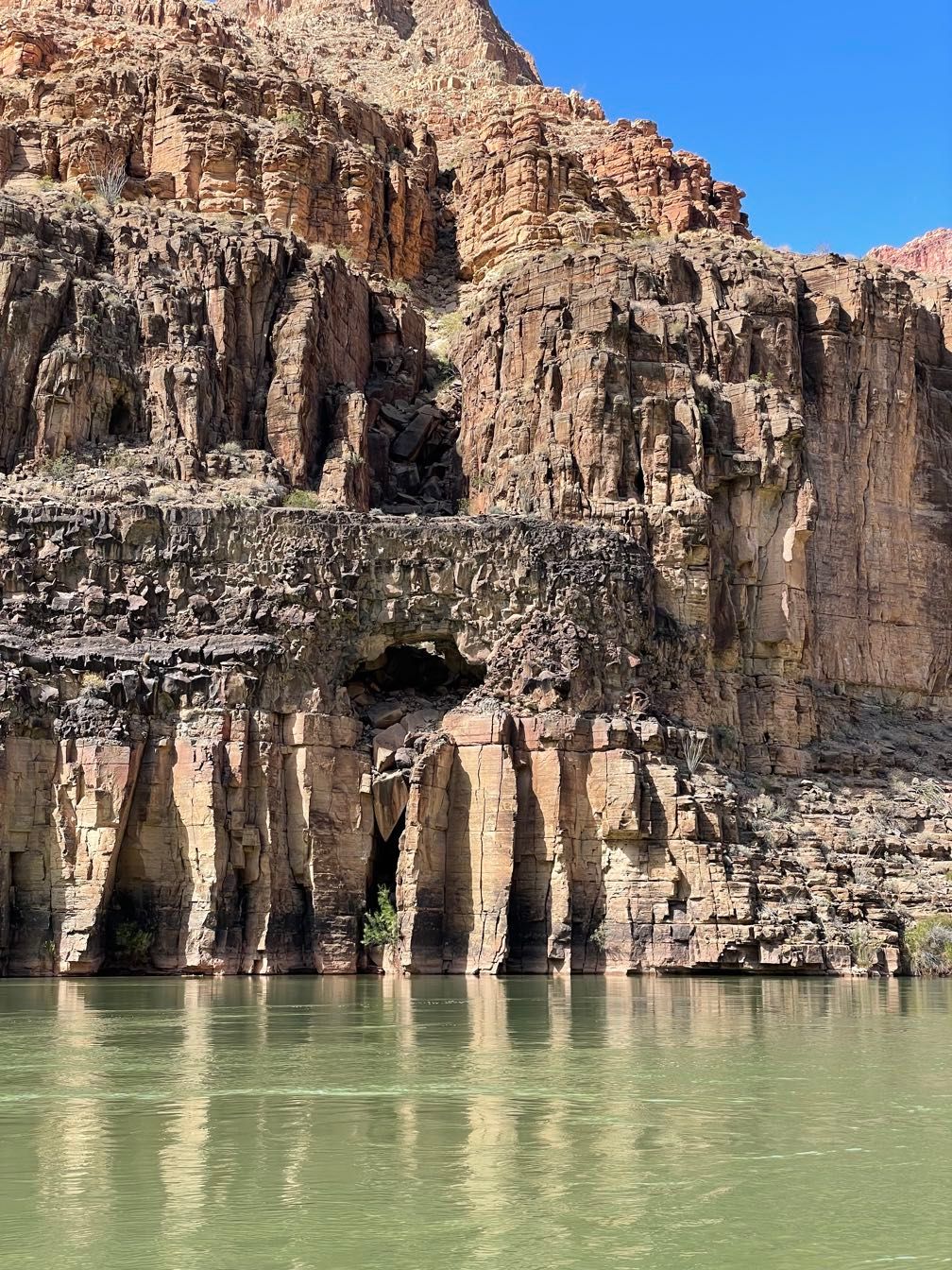 A basalt arch
A basalt arch
We pulled off to camp at Mile 202 (no clever camp name today, though it does have a cool wall of basalt). Dinner was pulled pork sandwiches.
Day 17
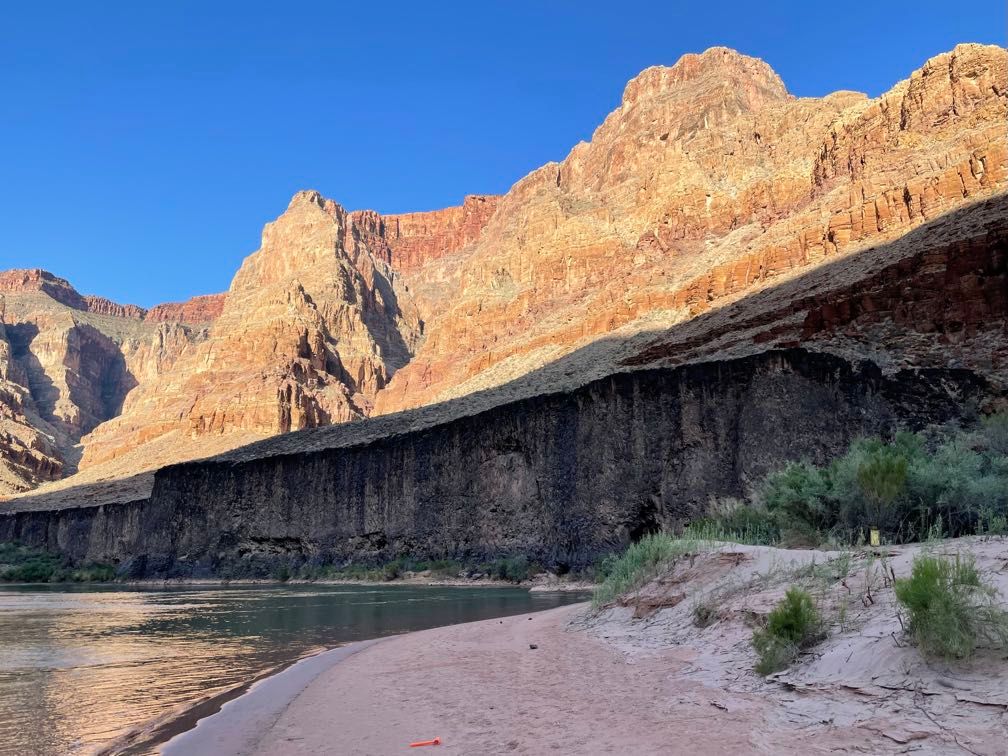 Morning at Mile 202
Morning at Mile 202
It was quite chilly this morning. After our last day of chair yoga, Gary gave a good talk about how the canyon was formed.
 Gary’s lecture
Gary’s lecture
Getting out on the river, we rafted down to some pestle-like grinding holes in a limestone shelf next to the river used by native peoples.
 Grinding holes
Grinding holes
We ran 205 Mile Rapid. At Indian Canyon, we stopped for a short walk to points of interest that ran the gamut from botany, to Ancestral Puebloan agave roasting pits, to jars left by early settlers, to packrat middens. We continued downriver, stopping for lunch at Granite Park, just above 209 Mile Rapid.
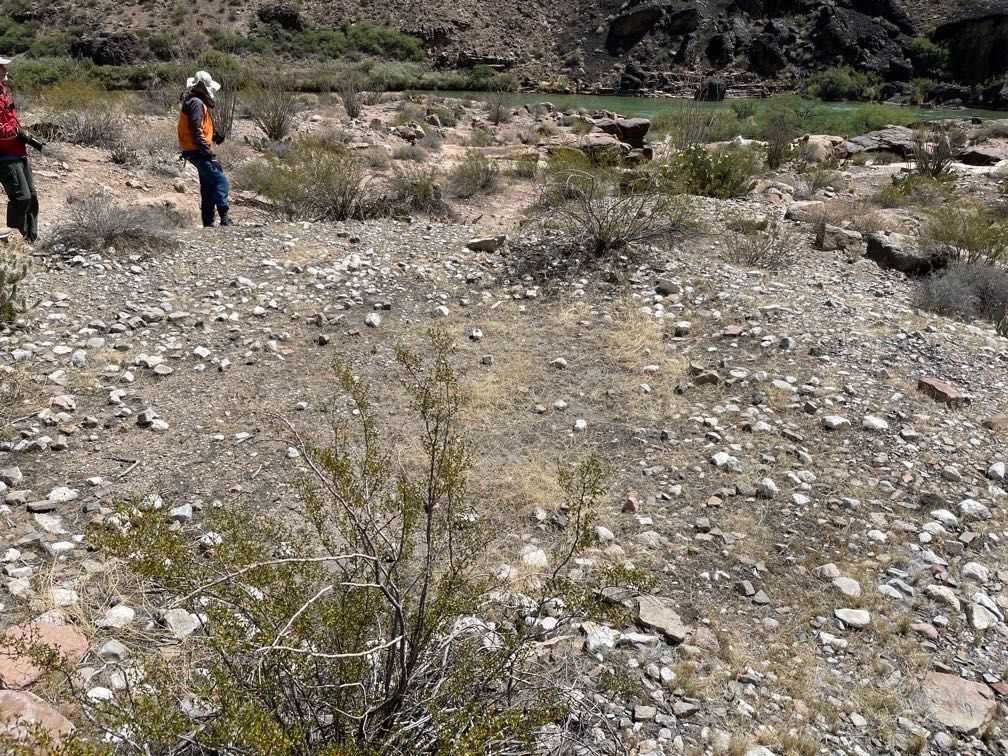 Agave roasting pit
Agave roasting pit
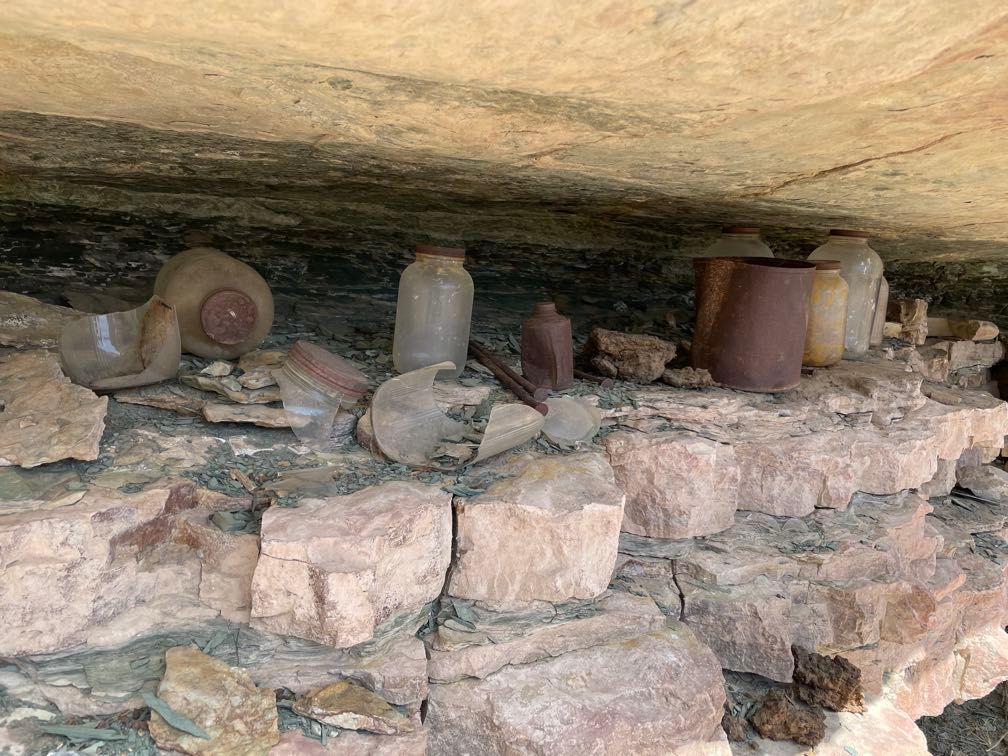 Jars
Jars
I rowed a couple more miles before Leo took over for Little Bastard Rapid. We floated by Pumpkin Spring, a river-side spring that has built up lots of travertine, stained orange by the minerals in the spring water. We continued downstream through Three Springs Rapid and 217 Mile Rapid. There are some neat opportunities down here for cliff jumping, but the relatively cool day didn’t make that very appealing. I did a bit of rowing, my last stint of the trip.
 Pumpkin Spring
Pumpkin Spring
We stopped for the night at Middle 220 Mile Camp, one of three on a large delta at 220 Mile Canyon.
Throughout the whole trip, Sequoyah had been collecting the clips from all the bags of bread on the brim of her hat, saying she’d teach us how to use them for duck calls. At dinner, she handed out two clips to each person and showed us how to interlock them and hold them at a particular angle. Then she demonstrated how to use them…by holding them up to her mouth and yelling, “Here duck duck duck duck!” It was definitely a long con.
After dinner, Gary talked a bit about the logistics for tomorrow: getting an early start, the trip down to Diamond Creek, getting the boats off the river, the journey back to Flagstaff, and plans for post-trip drinks. We had the opportunity to talk about our feelings about the trip. Everyone seemed to agree that it was a pretty awesome experience.
Since we’d be starting early, I decided to sleep out under the stars again. It was kind of chilly, but I did all right.
Day 18
We had a quick breakfast and got the rafts loaded up. We rode with Dave and got on the river about an hour earlier than most other days. There was about six miles from camp to Diamond Creek, with a couple of minor rapids. The previous night Gary had suggested doing the part from the last rapid to Diamond Creek in silence. It was quite a pleasant experience just drifting quietly along.
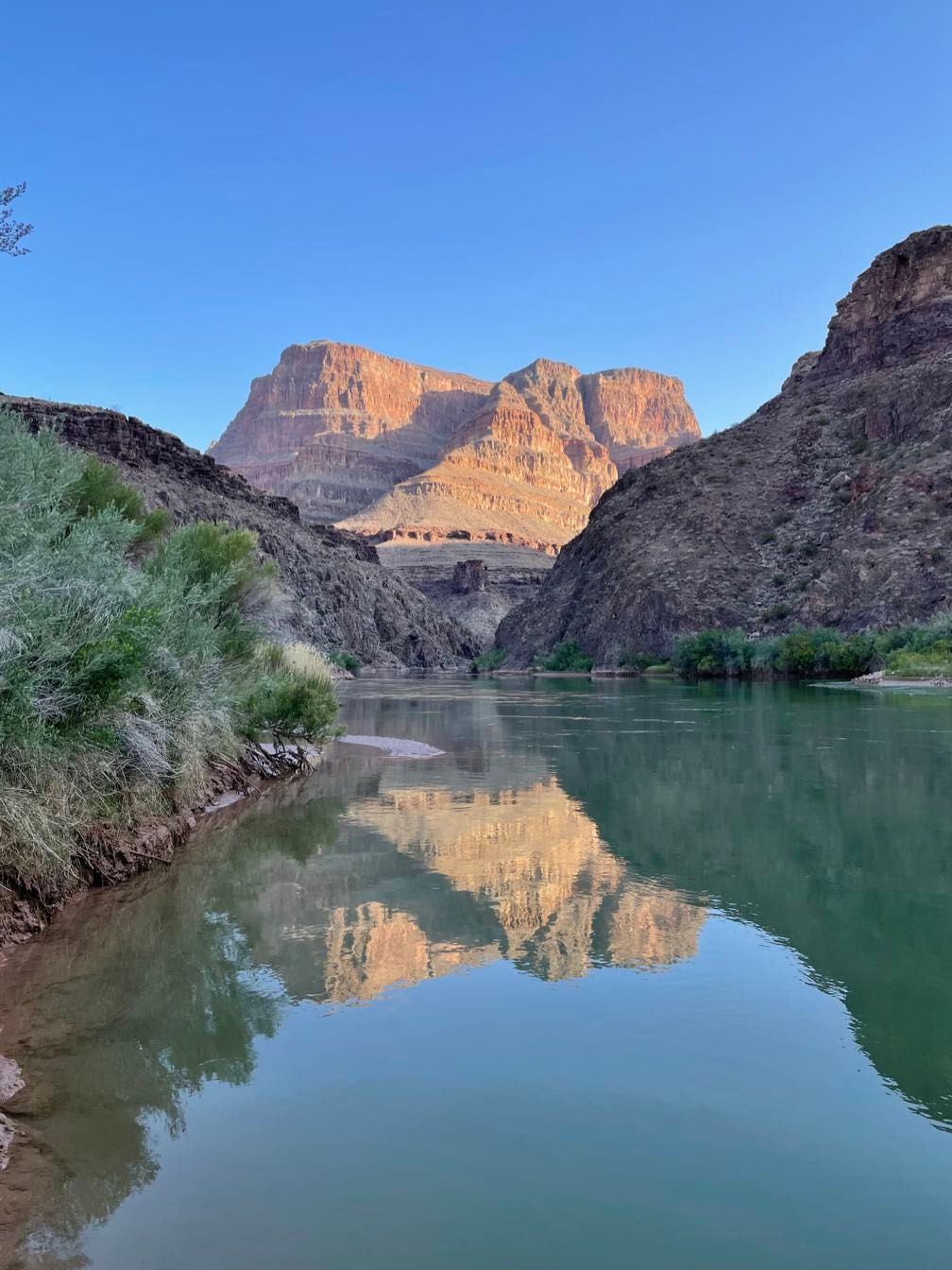 Reflections on the river
Reflections on the river
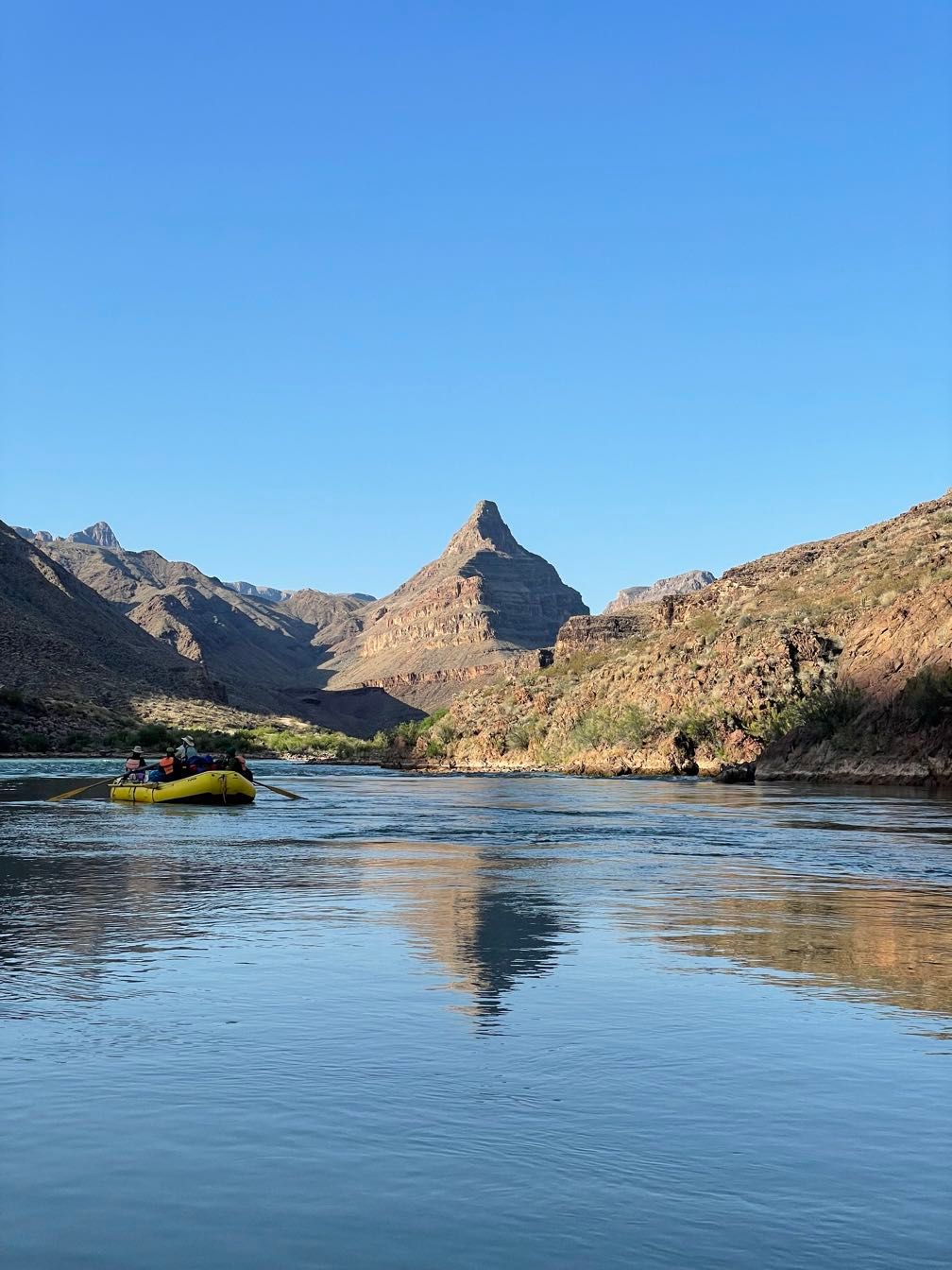 Diamond Peak
Diamond Peak
At Diamond Creek, we waited a bit on the beach just upstream before rafting over to the take-out point. Not only did we completely unload the boats, but we also derigged them, taking the frames out and carrying the empty boats onto the beach for deflating. This is a lot of work, but with everyone pitching in, we got it done.
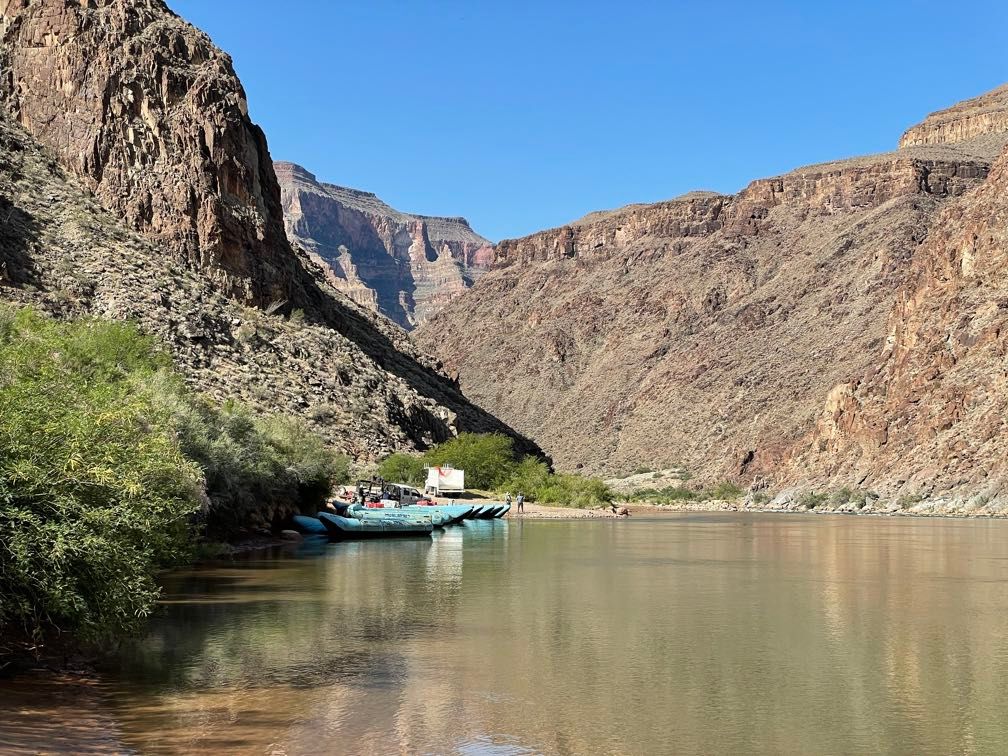 The takeout at Diamond Creek
The takeout at Diamond Creek
We had a nice lunch at the ramada there before loading up the bus for the trip out. The drive out was one of the bumpiest roads I’d ever been on, bouncing and rocking the bus dramatically. It took over an hour to make the seventeen-mile trip to Peach Springs. There we swapped onto another bus for the drive back to Flagstaff. First, though, there was a stop at Delgadillo’s Snow Cap in Seligman for ice cream.
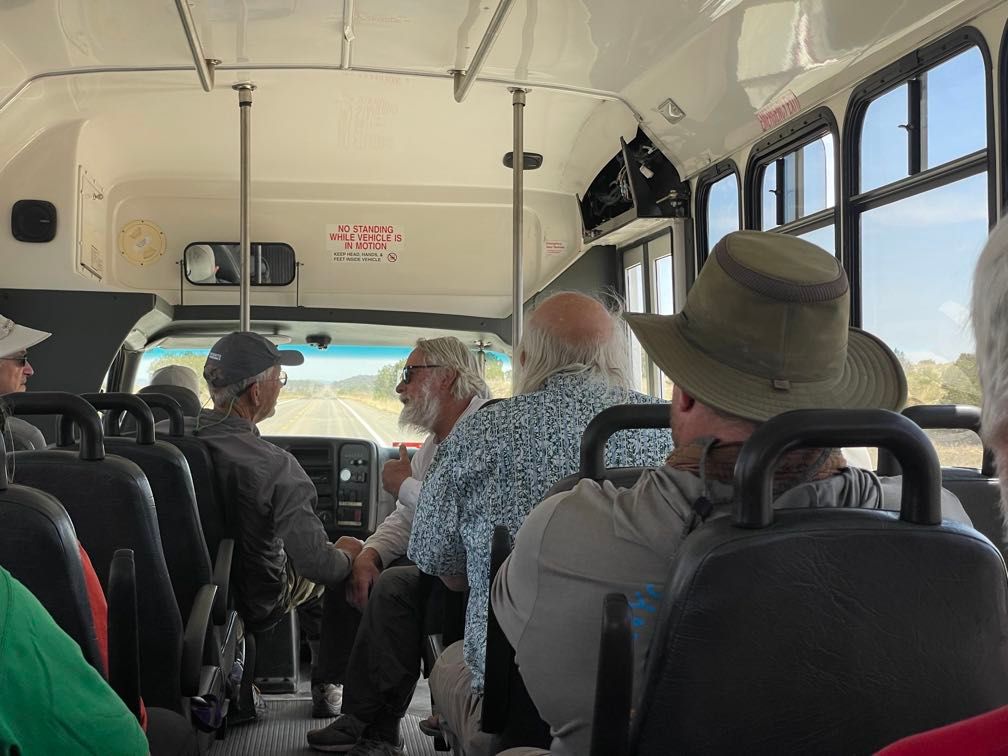 On the road
On the road
The bus dropped us off back at the hotel. We finally had our first opportunity for a shower and clean clothes in eighteen days. After getting some dinner, all the guests and most of the guides gathered in the hotel bar at around 7 pm for some drinks. We chatted about the trip, then said our goodbyes.
After the river
The next day, my parents drove me to Las Vegas and dropped me off at the airport. Thankfully, the flight back was less eventful than the flight out had been. I actually arrived home a little early.
Conclusion
This was an awesome trip. I’ve spent plenty of time in the Grand Canyon but going down the river let me see it in a whole new way. It also opened up parts of the canyon that I’d never been to before.
One of the best parts of the trip was getting to know the guides and the other guests. Everyone on the trip was great, and it was a pleasure to spend time with them.
I have to give a special shout-out to Gary, Dave, Amy, Leo, Sequoyah, Sherri, and Elise. They got us down the river safely, provided tons of great knowledge about the canyon’s geology, biology, inhabitants, and history, and were just all-around great folks. I’d happily take another trip with any of them. If you’re interested in a river trip, Grand Canyon Explorations/Expeditions puts on a great one.
You can also read about my lessons learned from this trip or how the trip led to a career change.
A Grand Obsession
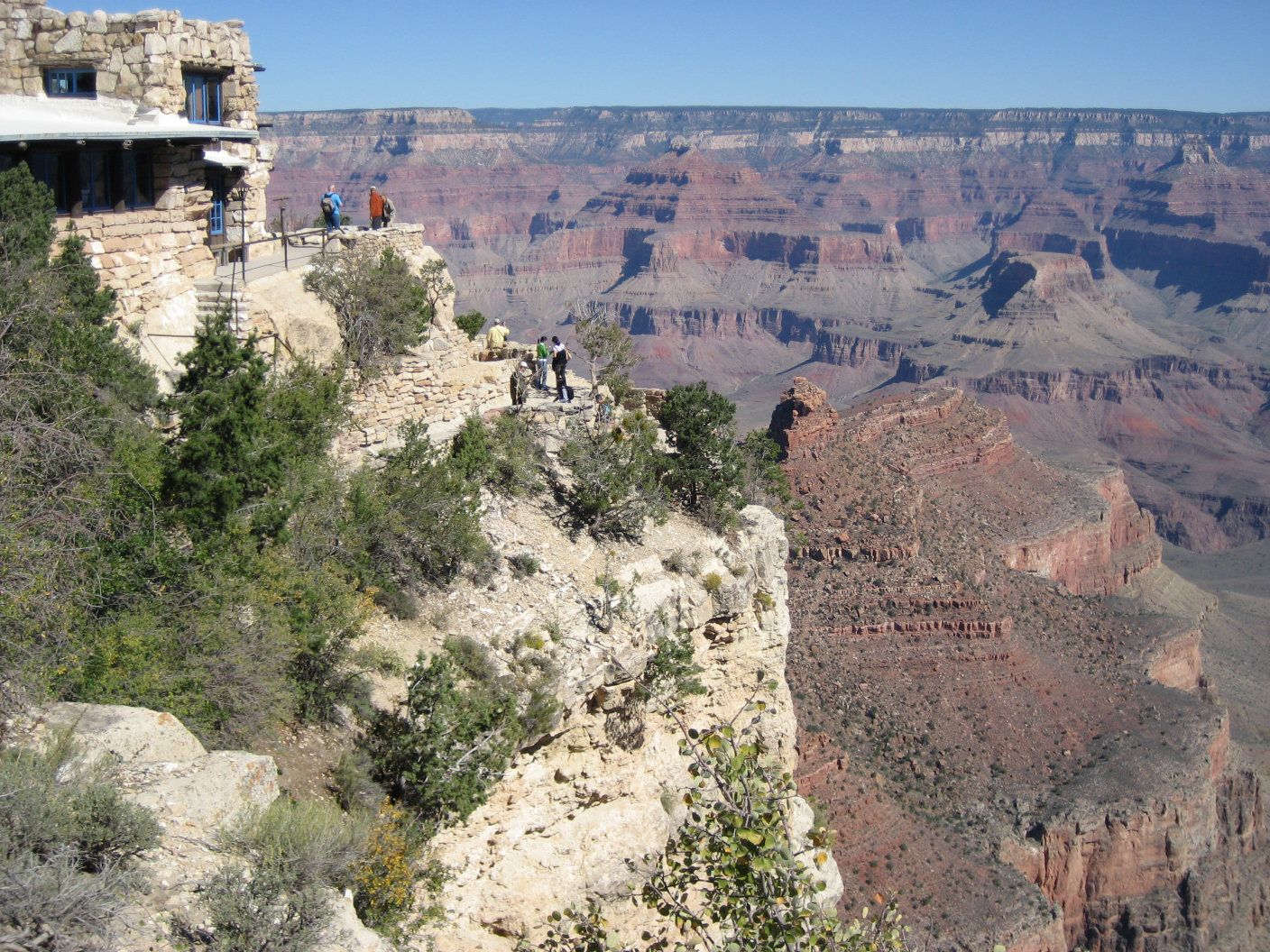 My love for the Grand Canyon started pretty early: my very first overnight backpacking trip was to Indian Gardens when I was seven years old. Since then, I’ve visited many times and hiked more than 300 miles in the canyon.
My love for the Grand Canyon started pretty early: my very first overnight backpacking trip was to Indian Gardens when I was seven years old. Since then, I’ve visited many times and hiked more than 300 miles in the canyon.
Even with that level of familiarity, I had a chance to experience the canyon in an entirely new way when I took an 18-day raft trip in April 2022. I was able to see parts of the canyon I’d never seen and experience familiar places from a new perspective. It was a “falling in love all over again” moment.
 While going down the Colorado in a raft gave me a new way to experience the canyon, I also found the rafting itself fascinating. The rapids can be a fun ride, of course, but it was a lot more than that. It was realizing that it’s all about finding the water that will take you where you want to go. It was the rhythm of life on the river. It was the opportunity the guides had to teach people about this place that I love.
While going down the Colorado in a raft gave me a new way to experience the canyon, I also found the rafting itself fascinating. The rapids can be a fun ride, of course, but it was a lot more than that. It was realizing that it’s all about finding the water that will take you where you want to go. It was the rhythm of life on the river. It was the opportunity the guides had to teach people about this place that I love.
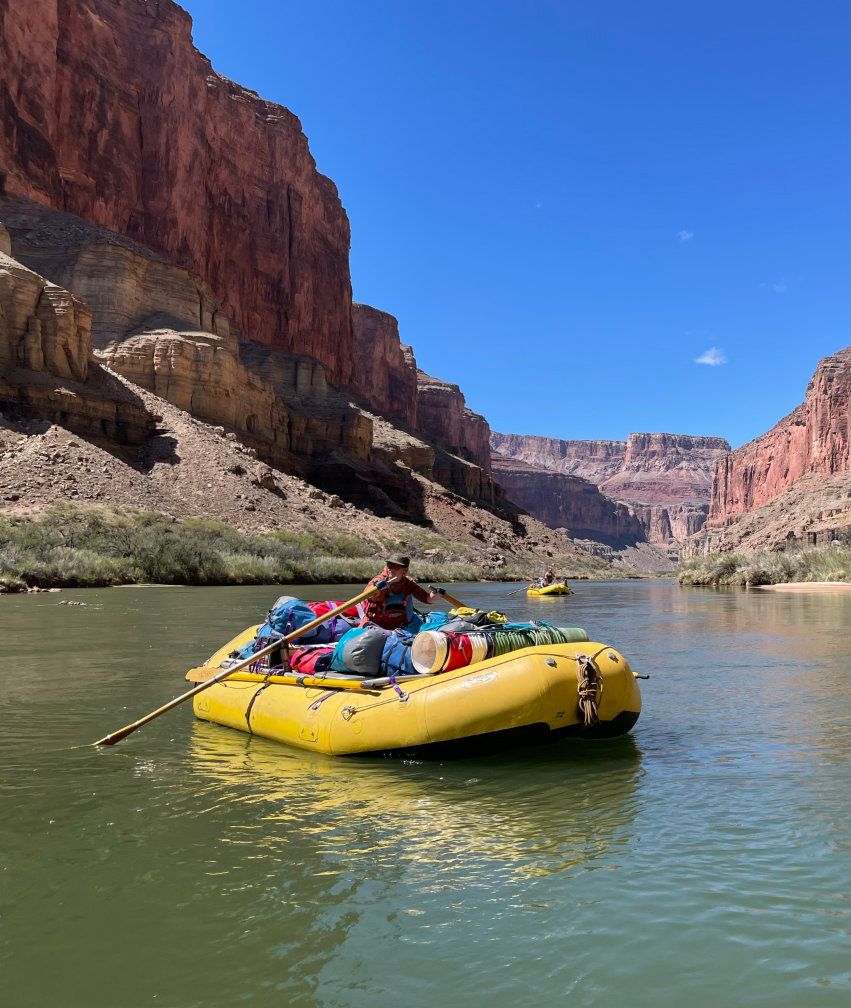 Most of the river guides on our trip were highly experienced. All had at least ten years rowing in Grand Canyon, some much more than that. This made them excellent guides, but it would have been hard to think about stepping into their shoes. The one exception was Sequoyah, who was rowing our baggage boat. It was her first trip down the canyon rowing her own boat (she did a fantastic job). Seeing someone at the start of their career as a river guide made the job much more relatable. She inspired me to make the leap to think, “this is something I could do.”
Most of the river guides on our trip were highly experienced. All had at least ten years rowing in Grand Canyon, some much more than that. This made them excellent guides, but it would have been hard to think about stepping into their shoes. The one exception was Sequoyah, who was rowing our baggage boat. It was her first trip down the canyon rowing her own boat (she did a fantastic job). Seeing someone at the start of their career as a river guide made the job much more relatable. She inspired me to make the leap to think, “this is something I could do.”
Once I started thinking that being a river guide was something I could do, it didn’t take long for that to turn into “this is something I want to do.” About halfway through the trip, I started asking all guides how they’d gotten into the business and what path they’d recommend for someone who was interested. Thankfully, they were very tolerant and helpful. They talked about river guide schools, necessary training and certifications, working on other rivers, picking up work as an assistant or rowing a baggage boat, etc.
 Dave and Leo, in particular, went beyond just answering my questions and offered me chances to row. I ended up rowing about 25 miles over the course of the trip. While I’m still very much a novice, it was enough to give me a sense of what it’s like. Definitely hard work, but not hard enough to dissuade me.
Dave and Leo, in particular, went beyond just answering my questions and offered me chances to row. I ended up rowing about 25 miles over the course of the trip. While I’m still very much a novice, it was enough to give me a sense of what it’s like. Definitely hard work, but not hard enough to dissuade me.
The canyon often casts a spell on people. I wouldn’t have been surprised if I’d lost interest in the idea after returning to the regular rhythms of daily life. If anything, my desire to get back on the river, to get back to the canyon, has only gotten stronger.
I think a big part of why being a river guide has stuck so soundly in my head is that it resonates with fundamental aspects of my personality. I enjoy being outdoors, especially out west. I enjoy learning new things, and being a Grand Canyon river guide would involve a lifelong process of learning all I can about the canyon. I enjoy teaching and passing that knowledge on to others like guides do with their guests.
Deciding on a career change like this is a pretty momentous decision. In the end, what it came down to is that I felt like I would regret not giving it a try.
In the next month and a half, I’ll be taking a ten-day river guide training, a Wilderness First Responder course, and a swiftwater rescue course. After that, I’ll be wrapping up a few things with my current job while I look for work as a river guide.
Whatever happens, it will be a grand adventure.